2023/2024 FR/EU reviews:
The Extirminating Angel in Paris (March 17, 2024)
Simon Boccanegrar in Paris (March 19, 2024)
Pique Damein Lyon (March 16, 2024)
La fanciulla del Westin Lyon (March 15, 2024)
La traviata in Marseille (February 15, 2024)
Adriana Lecouvreur at the Opéra Basstille (February 7, 2024)
Giulio Cesare at the Palais Garnier (February 8, 2024)
Beatrice di Tenda at Opéra Bastille (February 9, 2024)
Die Frau ohne Schatten in Toulouse (January 31, 2024)
La bohème at FIFOE (September 1, 2023)
Carmen at FIFOE (September 2, 2023)
The Greek Passion at the Salzburg Festival (August 22, 2023)
Falstaff at the Salzburg Festival (August 23, 2023)
Macbeth at the Salzburg Festival (August 24, 2023)
Parsifal at Bayreuth (August 19, 2023)
Nabucco in Verona (August 17, 2023)
Adelaide di Borgogna in Pesaro (August 16, 2023)
Aureliano di Palmira in Pesaro (August 15, 2023)
Edoardo e Cristina in Pesaro (August 14, 2023)
Wozzeck at the Aix Festival (July 18, 2023)
Cosi fan tutte at the Aix Festival (July 17, 2023)
Le Prophèt at the Aix Festival (July 15, 2023)
Picture a Day Like This at the Aix Festival (July 15, 2023)
Ballets Russes at the Aix Festival (July 10, 2023)
The Three Penny Opera at the Aix Festival (July 7, 2023)
Hamlet in Paris (March 21, 2023)
Tristan und Isolde in Toulouse (March 1, 2023)
Carmen in Marseille (February 21, 2023)
Cloria in Cagliari (February 15, 2023)
Peter Grimes at the Palais Garnier (January 29, 2023)
Carmen at the Opéra Bastille (January 28, 2023)
Le Trouvère at the Opéra Bastille (January 27, 2023)
Tristan und Isolde at the Opéra Bastille (January 26, 2023)
The Exterminating Angel at the Bastille
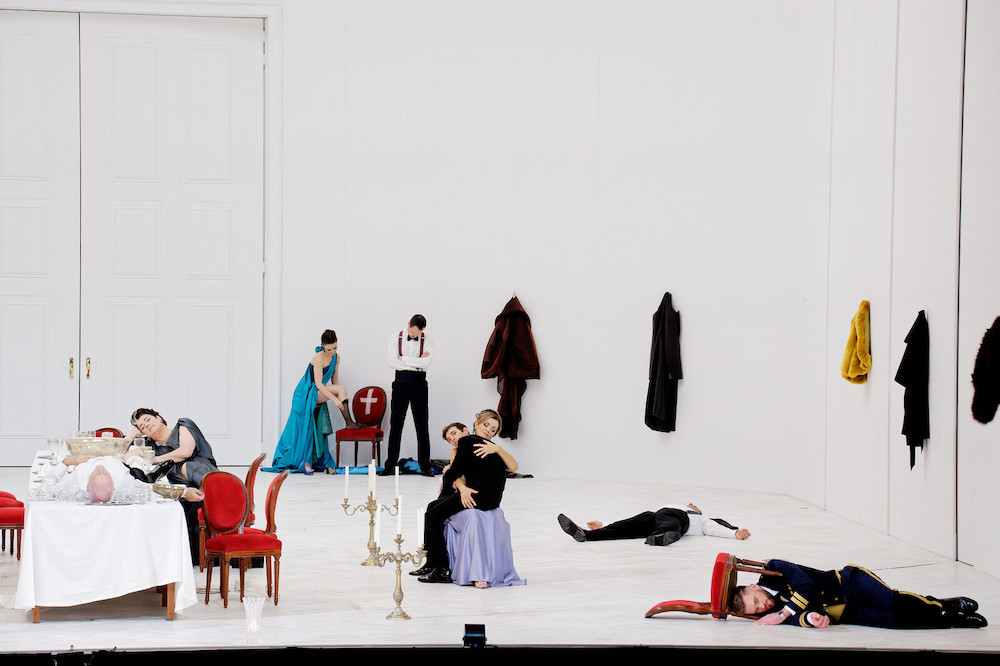
Staged by the famed (for many) or infamous (for others) Spanish stage director Calixto Bieito.
Both this Adès Exterminating Angel and Simon Boccanegra bore this stage director’s signature touches — a complex, abstract design metaphor to anchor the action, and lavish use of scatalogical and other visceral imagery that shocks your mind and offends your sensibilities. Actors are placed in high relief, with the daunting challenge of creating this stage director’s vibrant characters.
Great theater and pointed, powerful opera result.
Thomas Adès’ 2016 opera The Exterminating Angel is based on the 1962 film of the same name by famed filmmaker Luis Buñuel. The opera was commissioned by the Salzburg Festival, thus the film’s absurdist parody of the haute bourgeoisie attending a dinner after an opera took on even greater absurdity, given the haute bourgeoisie status of the Salzburg Festival.
Just now, a few years later, the opera finds itself in Paris — the city of existentialist Jean Paul Sartre. It is a new production by one of the world’s edgiest stage directors. Though composer Adès conducted the first few performances, the performance I attended was subject to the high strung temperament of English/Danish conductor Robert Houssart. It was electric indeed.
The design metaphor for The Exterminating Angel was a huge, empty, white, round room of solid walls, no windows. There was a huge double door at the rear that never opened. Within the room there were a few chairs, a table, and a black grand piano. The room was soon peopled by 14 well-dressed people coming from an opera performance. Only at the very end of the opera did we learn that this interior room revolved, we saw its finished exterior walls sweep past us to reveal finally the huge double doors from the outside. They opened.

Holding firm to the existential tenet that existence is not essence (i.e. being) the twelve guests of the dinner’s hosts, Lucia and Edmundo de Nobile, discover that there is nowhere to hang their coats, that the maid, before fleeing, has dumped the dinner on the floor. Taking matters into their own hands they create a world, their world, which becomes, little by little, increasingly, bizarrely, destructively absurd.
Thus the guests find themselves unable to leave the de Nobile residence.
Unique to Bieito’s Paris production was a sense of the sharpness of intelligence of the cast, the sharpness and focus of the voices, and the confidence and quite abstract purposes of their movement. There was absolutely no doubt as to the urgent need of these brilliant singers to create a vibrant artistic existence.
There was the overwhelming sense of virtuosity of the composer, demanding the extraordinary virtuosity and musicianship of the singers, plus an immense directorial intelligence behind these two packed hours of this existential discovery.
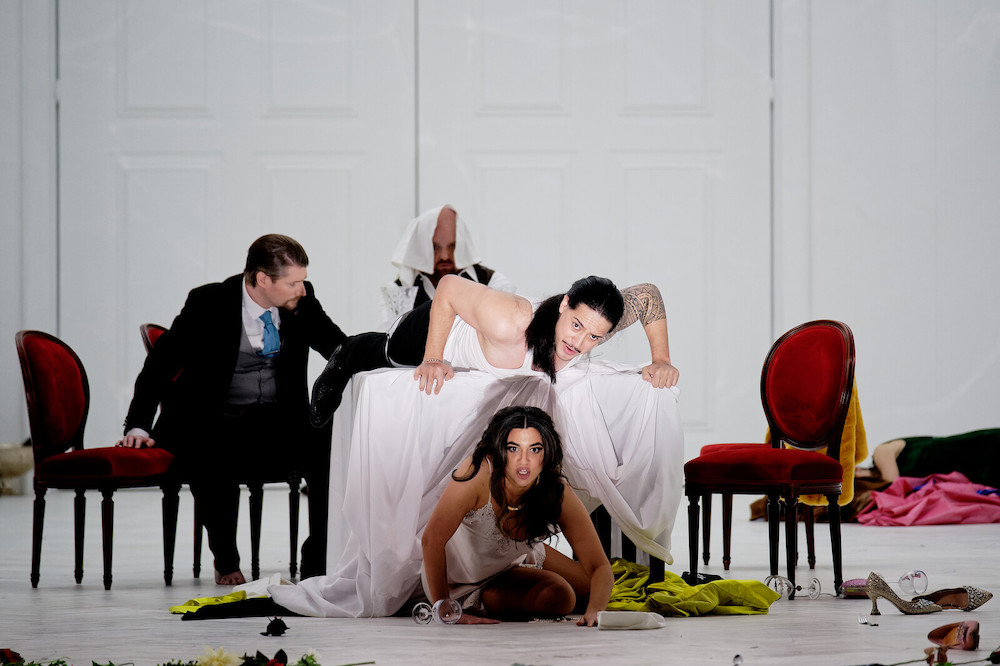
The young lovers: Filipe Manu and Amina Edris. Left is Frédéric Antoun as Comte Yemenis, Edmundo de Nobile holds a towel over his head.
Bieito signed the production with at least two proudly visceral moments. The first: the guest named Silvia wiped the sh*t off the exposed butt of her brother Francesco. The second, grandly grotesque (though undoubtedly there were more that I missed), was the slaughtering of a sheep to provide food for the self-imprisoned guests — conveniently the two affianced lovers, Beatrix and Eduardo had achieved a love-death, thus they became the meat of the feast.
Bieito encapsulated his telling of the Adès setting of Buñuel’s tale with a child holding a bouquet of sheep shaped balloons, the child bleating, upon occasion, the futility of mere existence.
Edmundo Nobile was sung by Scottish tenor, Nicky Spence, Lucia de Nobile was sung by American soprano Jacquelyn Stucker. The opera diva Leticia Mayer was sung by French/Romanian soprano Gloria Trowel, the conductor Alberto Roc was sung by French bass baritone Paul Gay, his pianist wife Blanca Delgado was sung by British mezzo soprano Christina Rice, the young lovers Beatrix and Eduardo were sung by Egyptian soprano Amina Edris and New Zealand tenor Filipe Manu. Francisco de Avila was sung by American counter-tenor Anthony Roth Costanzo, his sister Silvia de Avila was sung by Irish soprano Claudia Boyle. The Comte Raul Yemenis, an explorer was sung by Canadian tenor Frédéric Antoun, Colonel Alvaro Gomez was sung by American baritone Jarrett Ott, Señor Russel was sung by Canadian bass baritone Philippe Sly, Dr. Carlos Conde was sung by British bass Clive Bayley. The de Nobile butler Julio was sung by British bass Thomas Faulkner.
The costume designer for both Simon Boccanegra and The Exterminating Angel was frequent Bieito collaborator Ingo Krügler. Set design for The Exterminating Angel was by Anna-Sofia Kirsch, set design for Simon Boccanegra was by Susanne Gschwender. Also among the Bieito’s German collaborators were lighting designer Michael Bauer for Simon Boccanegra and Reinhard Traub for The Exterminating Angel. Swiss videographer Sarah Derendinger created the extensive Boccanegra videos.
Photos copyright Agathe Poupeney / OnP, courtesy of the Opéra national de Paris.
Opéra Bastille, Paris, France. March 17, 2024
Simon Boccanegra at the Bastille
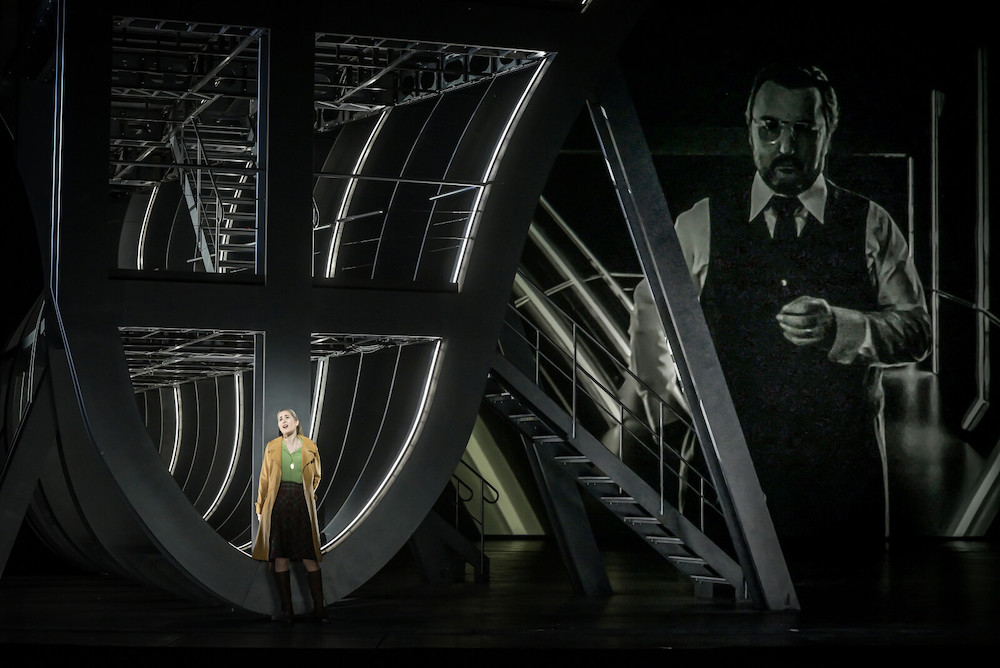
Staged by the famed (for many) or infamous (for others) Spanish stage director Calixto Bieito.
Both this Boccanegra and the Adès Exterminating Angel bore this stage director’s signature touches — a complex, abstract design metaphor to anchor the action, and lavish use of scatalogical and other visceral imagery that shocks your mind and offends your sensibilities. Actors are placed in high relief, with the daunting challenge of creating this stage director’s vibrant characters.
Great theater and pointed, powerful opera result.
The design metaphor for Verdi’s Simon Boccanegra was a ship, one that had the exposed wooden ribs of old ships as well as elements of an ugly, modern aquatic war machine. As the story unfolded these armored plates were stripped away to create the skeleton of a huge fish-like structure. It was placed off-center on a constantly revolving stage, revealing ever new, surprising perspectives through the use of video. (Lead photo is Nicole Car as Amelia and Lodovic Tézier as Boccanegra in video image. All Simon Boccanegra photos copyright Vincent Pontet / OnP, courtesy of the Opéra national de Paris).
The structure was huge, built so that as it turned an armored tower penetrated the massive. proscenium opening of the Opéra Bastille, swinging out over the pit, aggressively entering our space — 14th century Genoa was at constant war with Venice for the domination of Mediterranean trade routes.
For Simon Boccanegra Bieito obsessed on the Genoese corsair’s seduction of the Genoese patrician Jacopo Fiesco’s daughter Maria. Maria, then sequestered by her father within his palace, died of grief. A child had resulted from the liaison, though the child had been kidnapped. Fiesco, sung by fine Finnish bass Mika Karas, dragged his supplicating — though dead — daughter onto the stage where she remained, in ghostly, mute, guises though the action of the opera, though it was now 25 years later.
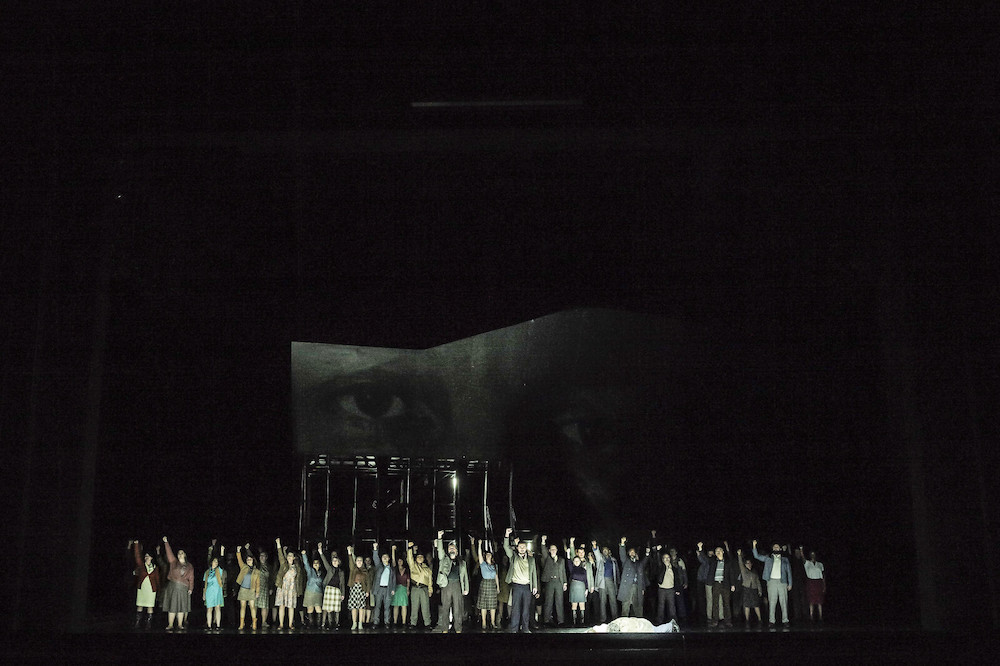
Upper right corner Lodovic Tézier as Boccanegra, his video image in center. Below left to right Charles Castronovo as Adorno, Alejandro Baliñas Vieites as Pietro, Mika Cares as Fiesco, Étienne Dupuis as Paolo
At the moment of his death, Boccanegra — sung by French Verdi baritone Ludovic Tézier in a consummate performance — heart wrenchingly reached out to Maria. Though now, at his end, she was no longer there.
To regain/restore his daughter Maria, Fiesco sought his daughter’s lost daughter — sung by Australian Mozartian soprano Nicole Car in newly found Verdian tones — now known by her adoptive name Amelia Grimaldi. In the end the two fathers, Fiesco and Boccanegra, reconcile, a deeply touching scene as rendered by Bieito, Fiesco embracing the dying Boccanegra, holding him upright.
The dramatic center of Bieito’s production was his imposition of a rape of Amelia by Boccanegra’s enemies. Now came classic Bieito images — blood running down Ameiia’s leg as she emerged from a vagina image within the ship’s guts. As well Amelia’s mother Maria appeared, battered and torn, bloody and ravaged. We then understood, and felt, Fiesco’s need for revenge.
Bieito established the sexual tensions he invented for Verdi’s opera as his central focus, not the political resolutions.
Adorno, Amelia’s intended, sung by American tenor Charles Castronovo and the spurned Paolo, sung by French baritone Étienne Dupuis, were very much on Bieito’s secondary plain, as were the revolutionary Genovese forces sung by the magnificent multitudes of the Opéra national de Paris chorus backing up Boccanegra’s (Tézier’s) truly magnificent cries for peace between Genoa and Venice.
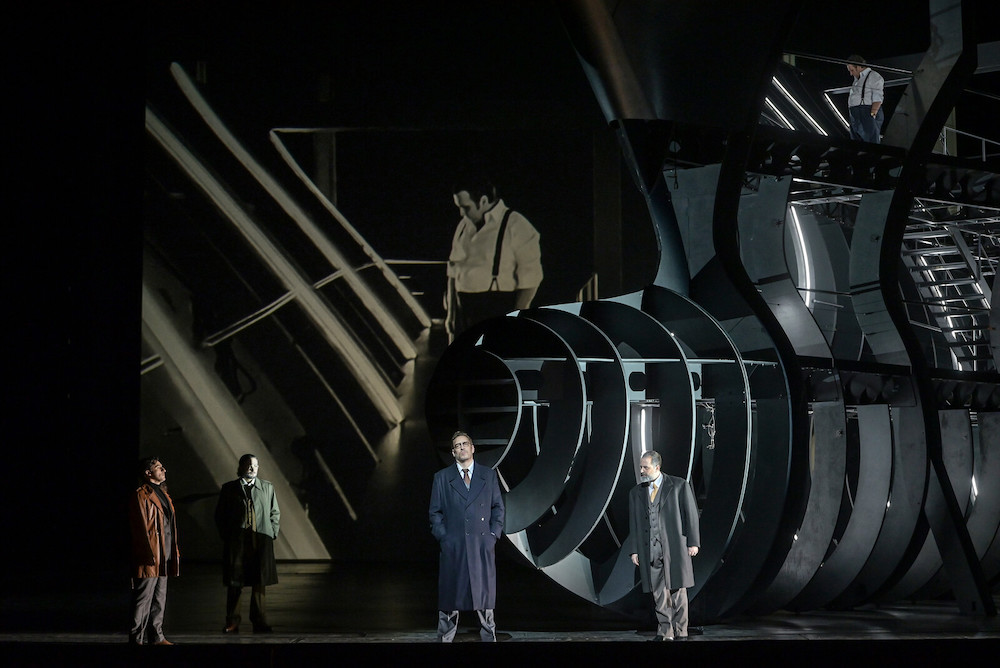
Of great interest was the musical realization of the Verdi score by German early music conductor Thomas Hengelbrock. Mo. Hengelbrock is a famed researcher of historical performance practice, thus we may assume that his slower and more relaxed tempos led to a heightened sense of lyricism — specifically with regard to the Mozartian voice of Mlle. Car. Mo. Hengelbrock did not pursue dramatic punctuation, allowing dramatic effect to slowly grow through crescendo reaching shattering volume — this specifically noted in the monumental finale that concludes Act II.
Opéra Bastille, Paris, France. March 19, 2024
La fanciulla del West in Lyon
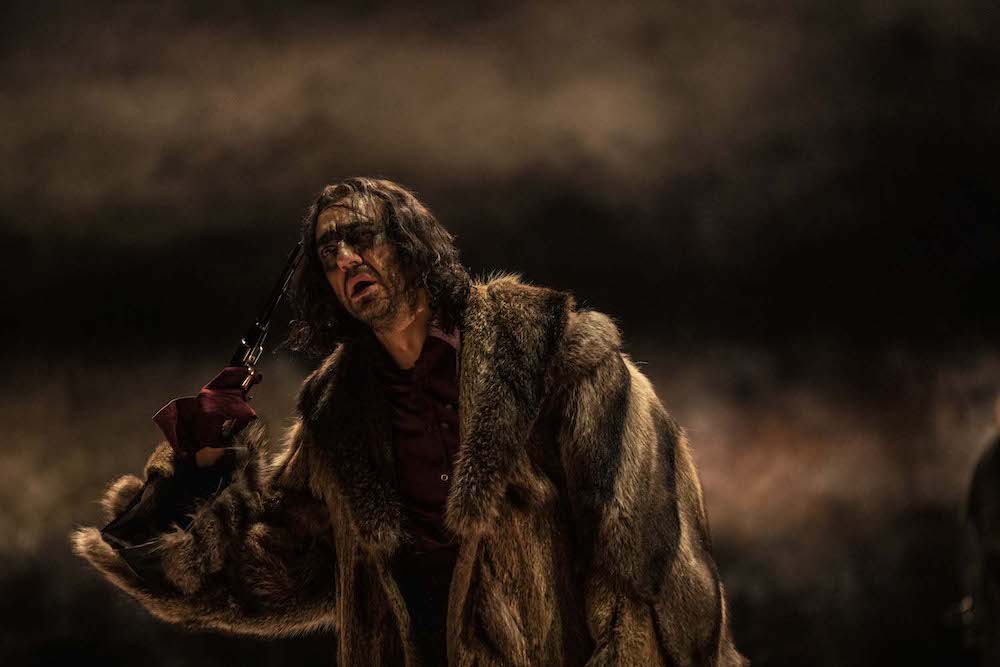
Forget the West of San Francisco born David Belasco’s The Girl of the Golden West (the source of Puccini’s opera), not to be confused with Peter Sellers’ The Girls of the Golden West. Think Westphalia maybe, or more philosophically, West Berlin.
The first offering of the Opera de Lyon’s prestigious Winter Festival. This year the festival is entitled “Rebattre les Cartes” — the heroines of the Festival’s three operas all reshuffle the cards, here it is Minnie who bets the life of her lover in a poker game.
German stage director Tatjana Gürbaca is a disciple of legendary stage director Ruth Berghaus and a Wagner specialist to boot. Thus Puccini’s 49ers became her Nibelungen, her sheriff Jack Rance took on an uncanny resemblance to Walkűre’s Hunding (see lead photo). Minnie and her rather simple boyfriend Mike Johnson escaped a California Valhalla that we might have relished watching it go up in flames, save for the lusty miners whom we came to know and love as refugees straight from Bertold Brecht’s Mahagony.
Suffice to say that the artistically mature Puccini of 1911 was a man of the European world, well aware of theatrical currents emanating from beyond the Alps, rather more than he was the raconteur of stories from the Sierras of American Old West. The Grübaca Europeanization of this American story fit far more comfortably within Puccini’s newly sophisticated, mid-career operatic endeavor than would a staging that attempted to evoke quaint American atmospheres.
La fanciulla del West was not a success at its world premiere at the Metropolitan Opera because it was neither vintage Puccini nor was it American.
In Lyon just now the conductor was Daniele Rustioni who stepped onto the podium and immediately established his intention to tell an urgent story, not to linger on the emotive moments of its protagonists, or only very briefly. The pit was Straussian — quadruple woodwinds, two harps, expanded percussion joined the strings to create a maelstrom of sounds that melded Italian lyricism with constant, pithy stage action.
The maestro drove it unfalteringly to its shattering ending. Minnie and Dick had destroyed sheriff Jack and may have escaped California, but the miners were left trapped in their lust for gold and their nostalgia for everything they had left behind.
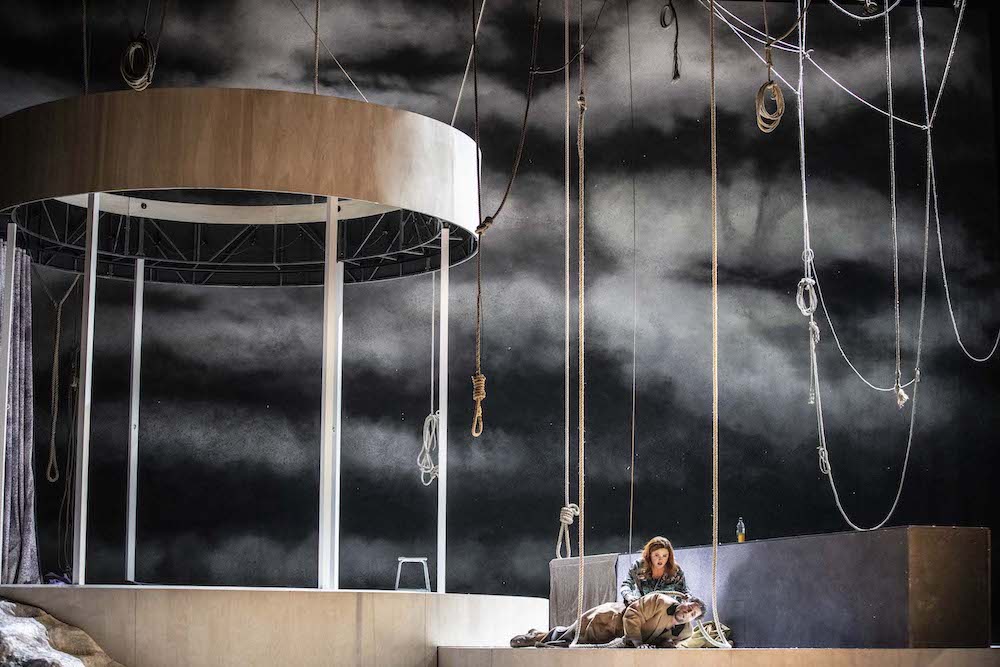
The end of the opera. Minnie and Dick walking out of California, Jack Rance with a gun to his head, Billy (in blue), the American Indian, the miners left behind
The set was a few Tristan-worthy geometrical shapes, bathed in a sort of dusty gold light, sheriff Jack Rance was enveloped in huge animal hide coat, the chaotic law and lust of a mythic California world. Saloon tycoon Minnie appeared in a shining gold robe, then removed her too tight, golden slippers, a clean cut Dick Johnson strode in, though his alter-persona, whom we never met, was the terrifying Mexican bandit Ramirez.
Dick and Minnie (Minnie, pointedly, now in comfortable shoes and pajamas) consummated their love during the second act snowstorm. A few snowflakes did actually fall from time to time within the brightly lighted geometry, in tribute to David Belasco’s naturalism, though the act’s primary image were the many nooses that descended across the stage, a couple of ropes used to hoist Mike (Minnie snapped the security buckle) into the fly space that served as the Belasco attic.

Act II, Chiara Isotton as Minnie, Riccardo Massi as Dick Johnson
From the beginning the miners, the Wells Fargo agent Ashby, Sonora, Sid, Happy, Bello etc., melded together as acolytes to the golden priestess Minnie, save the two native Americans (called Indians), Billy and Wowkle who knew only that life leads to death. In the end the miners were shown abjectly huddled together, Billy had been destroyed by the disheveled and distraught sheriff Jack Rance, who put a revolver to his own head in the final black out.
Epic theater indeed.
Minnie was sung by Italian soprano Chiara Isotton who belted out the high notes with the ease of a fine Elektra. Signorina Isotton does have a great Italian warmth in her midrange voice that served her well in Puccini’s frustratingly few moments of emotive expansion. She does not have the ease and confidence of diva movement (though clearly she is an arrived diva), an attribute that could possibly contribute to a cowgirl Minnie, but here did not find a sufficient Wagnerian philosophical dignity.
Dick Johnson was sung by Italian tenor Riccardo Massi who in addition to possessing a fine voice and ample technique, evidences excellent musicianship. With all the Italianate tenor resources in place he still found the qualities to convey the vocal innocence of a jugendlicher heldentenor, complementary to the epic theater intentions of the director.
Hunding aka Jack Rance was sung by Italian baritone Claudio Sgura. Sig. Sgura is of imposing figure, and of black voice, attributes that served him well to create a Wild West sheriff who was possessed of the honestly raw appetites of love and justice that prevail in the wilds of humanity. Mr. Sgura enacts Scarpia and Iago, as well as Jack Rance on the world’s major stages. There are no Wagnerian credits.
The world of the gold-possessed forty-niners were a lively bunch of polished performers that included the beautifully voiced male contingent of the Opera National de Lyon chorus.
Opéra Nouvel, Lyon, France. March 15, 2024
Pique Dame in Lyon

The Russian Avant-garde has attacked Lyon, Pique Dame is left in ruin!
Enfant terrible (now forty years old) Russian avant-gardiste stage director Timofeï Kouliabine fled Russia in protest of its invasion of Ukraine. He had been director of Novossibersk’s progressive Theater of the Red Flame, and surely he escaped with much of its fervent avant-gardism. Mr. Kouliabine took his opening night bow “en culottes” (the pants of the 18th century French aristocracy), though with bare, hairy calves showing — surely a protest of something, perhaps the civility of a French theatre.
His production team is firmly ensconced in current Russian theater. Dramaturg Ilia Kukharenko, a former editor of Vogue Russie and Madame Figaro Russie, is now a commissioner of the Golden Mask theater awards of Moscow’s Pushkin Fine Arts Museum. Set designer Oleg Golovko, a frequent collaborator of Mr. Kouliabine, is the recipient of many awards within the Saint Petersburg theater community. Costume designer Vlada Pomirkovanaya, a frequent Kouliabine collaborator as well, has a plenitude of design credits in Moscow and Perm. Lighting designer Oskars Paulinš works at Moscow’s Pushkin and Gogol theaters.
Never mind Tchaikovsky’s Pique Dame (1890), or Pushkin’s novella Pique Dame (1834) on which the opera is loosely based. Just now in 2024 Lyon Kouliabine and his collaborators had other fish to fry. Though I am not sure what all those other fish were.
They recast this nineteenth century document of Russian aristocratic depressive boredom onto a stage that sat on Lyon’s opera house stage (story within a story) where present day nasty things happen, though Tchaikovsky’s grandiose second act Polonaise was portrayed as a costume ball, rudely interrupted by an electricity outage. It was complicated.
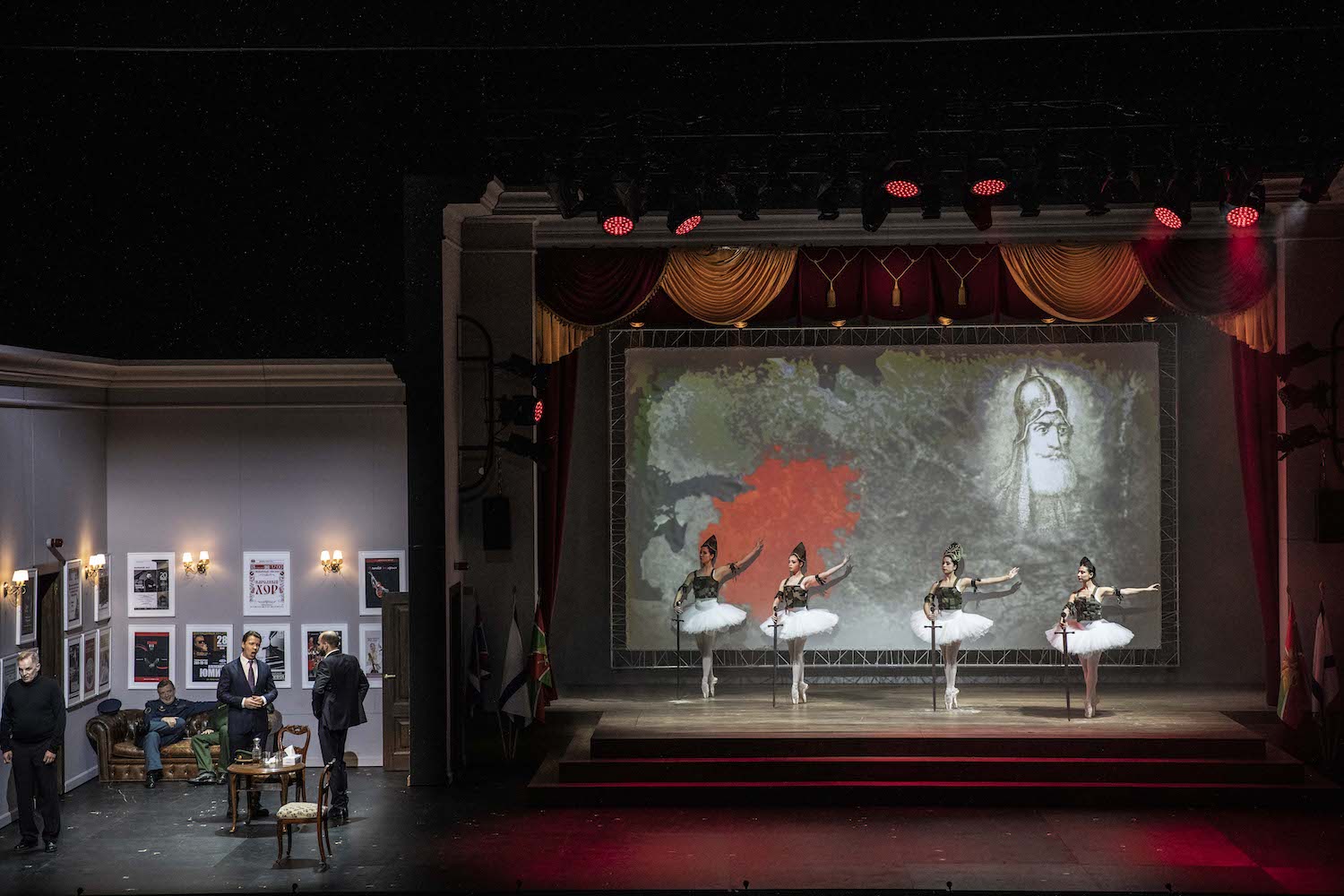
Act I
The first scene of the first act, Tchaikovsky’s Moscow park, was set in a tiny vestibule of this stage set theater. Its expansive stage however held act after act of Russian militarism — a war widows’ dirge, Swan Lake ballerinas with Kalashnikovs, crippled veterans, etc. All this outrage grandly suffocated our getting acquainted with Hermann and his gambling obsession, off to the side.
At the end of the opera we returned to this obscure theatrical metaphor, though now the stage (on the stage) is in grandly distressed ruin (we sat in long silences for the intra act scene changes). We were anticipating the famed suspense of the card scene. The dissolute inhabitants were however in no condition to attempt any organized activity, much less able to find the mental acuity to gamble. Instead Hermann’s rival in love, the Prince Eletsky, presented himself, he then dressed himself as the Countess. Hermann shot him as the Pique Dame dead, escaping his own Pushkin/Tchaikovsky suicide.
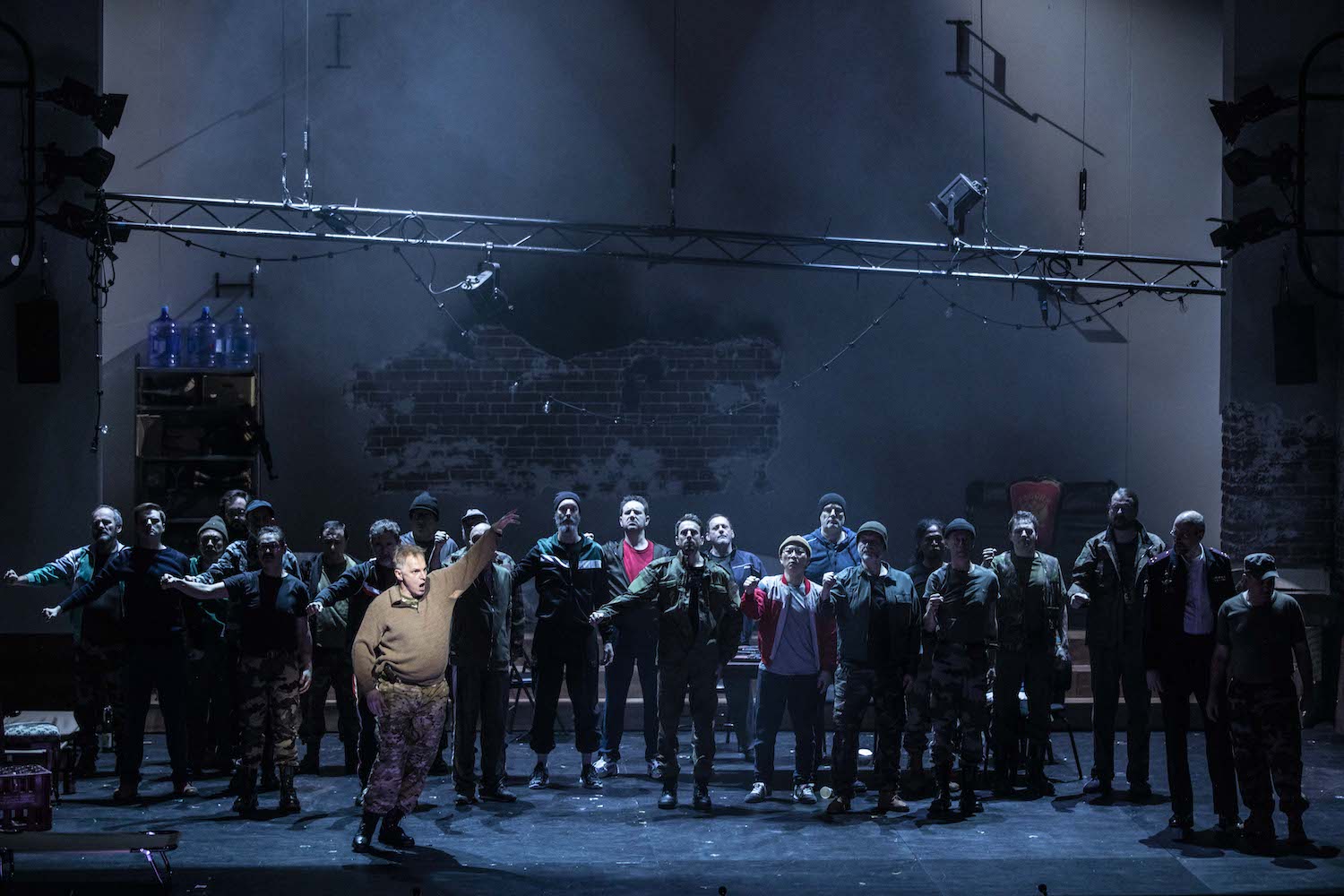
Final scene, card game (Act III), Dmitry Golovnin as Hermann
Go figure.
Lisa’s magnificently bleak Tchaikovsky suicide was subverted as well. She sat in a gloomy train station together with various contemporary, societal victims. At the scene’s climax, rather than throwing herself in front of a train or bus, she gathered a mother and child and fled, presumably to a waiting train.
It is possible that this willful destruction of an operatic masterpiece was a selfish celebration of Mr. Koullabine’s escape from Russia, or maybe it was the deliberate destruction of an operatic masterpiece mimicking Russia’s willful destruction of Ukraine. Whatever, it seemed and was very Russian.
The Hermann was Russian tenor Dmitry Golovnin. He is a character singer, missing the voice and presence of a leading tenor. Mr. Goloynin is a fine singer indeed, holding forth forcefully and magnificently (he is a former trumpeter) through each of the opera’s seven scenes, though not in a voice that can be termed as beautiful. Perhaps his role was intended to be understood as Everyman, not merely that of a besotted opera singer who could summon our participation (cartharsis) through the vocal magnificence of his situation. (See lead photo from Act III, train station.)
Lisa was sung by Russian soprano Elena Guseva. Mme. Guseva is very able performer, singing Russian heroines on many of Europe’s important stages — as well she was a recent Lyon Tosca. Just now in the Kouliabine Pique Dame she was required to go histrionically well outside the vocal formalities of the role, robbing her of any empathy we might feel for the young heroine she was asked to portray. Vocally it was a fine performance, though we did not feel her participation in Mr. Koullabine’s storytelling, whatever it was. (See lead photo, Act III, train station.)
The Countess, Lisa’s grandmother, the “Pique Dame” was sung by Russian mezzo soprano Elena Zaremba. The role was enacted to perfection. Russian baritone Pavel Yankovsky sang the Count Tomski. Former member of the young artist program at the Bolshoi Opera Konstantin Shushakov was the beautifully voiced Prince Eletski. Ukrainian mezzo soprano Olga Syniakova was the beautifully voiced Pauline.
The final prayer as sung by the male voices of the Opéra national de Lyon was of exceptional beauty.
Conductor Daniele Rustioni seemed to embrace Mr. Koullabine’s production, but never found a musical center for it.
Opéra Nouvel, Lyon, France. March 16, 2024
La traviata in Marseille
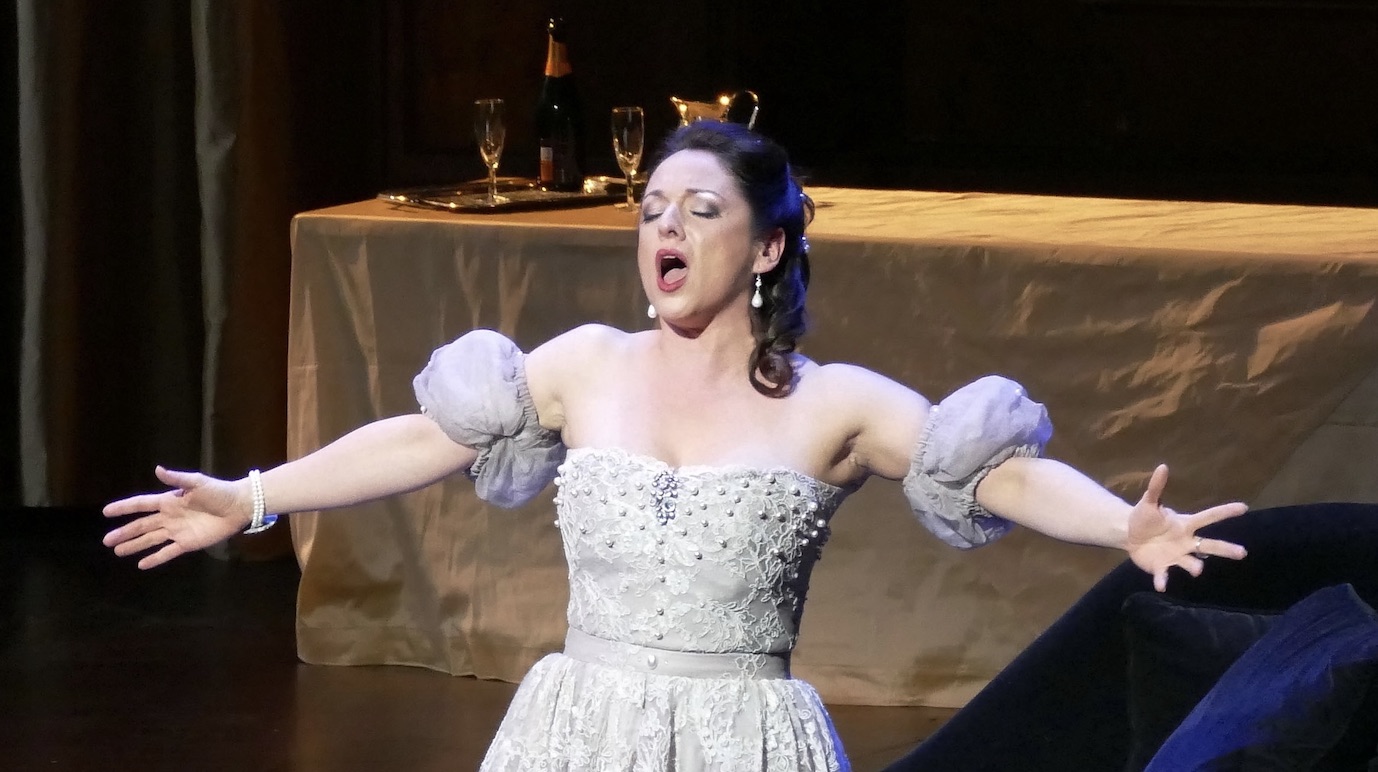
Three fine singers saved Marseille Opéra’s recent 5 performance run of La traviata. Marred by a bizarre pit and weird staging conceits, Verdi’s middle period masterwork emerged, in spite of it all, in its indestructible, awesome, bel canto glory.
Spanish soprano Ruth Iniesta brought a bright, silvery sound to Violetta, finding surprising musical and vocal detail in exposing the heroine’s complex emotions. This formidable artist is in mid career — Verdi’s Violetta is one of her signature roles, others are Puccini’s Liu and Bizet’s Micaela. Hers is a Violetta who projects youthful innocence, not the weariness of a worldly courtesan. “Sempre libera” offered Mme. Iniesta the opportunity to find joyous pleasure in her roulades, and to indulge in an immature boast with the famed high E-flat interpolation squarely, forcefully hit, then held a trifle too long (see lead photo). Her mid and lower voice have great warmth, endowing her Violetta to capitulate to Germont and finally to die with frank, girlish innocence.
French tenor Julien Dran brought well-studied stylistic pizazz to his performance as Alfredo. He read as a boyish, immature Alfredo just finding his way into the Parisian beau monde, rather than as a jaded ladies’ man finding his way out of it. Mr. Dran has a quite beautiful, lyric voice, often assigned secondary roles on many European stages while continuing to shine in principal roles in Marseille.
Germont was sung by French baritone Jérôme Boutillier. Mr. Boutillier boasts a fine and powerful voice of golden color. It is well focused and very present giving his Germont a youthful sound that belies the mature gravity that is normally associated with the role. Thus he rendered his scenes with Violetta and Alfredo as a singer making beautiful sounds rather than as a concerned father. While this certainly distracted from Verdi’s storytelling, it did meld musically with the innocence of the voices of Violetta and Alfredo, creating Verdi’s bel canto world, if not his theatrical world.
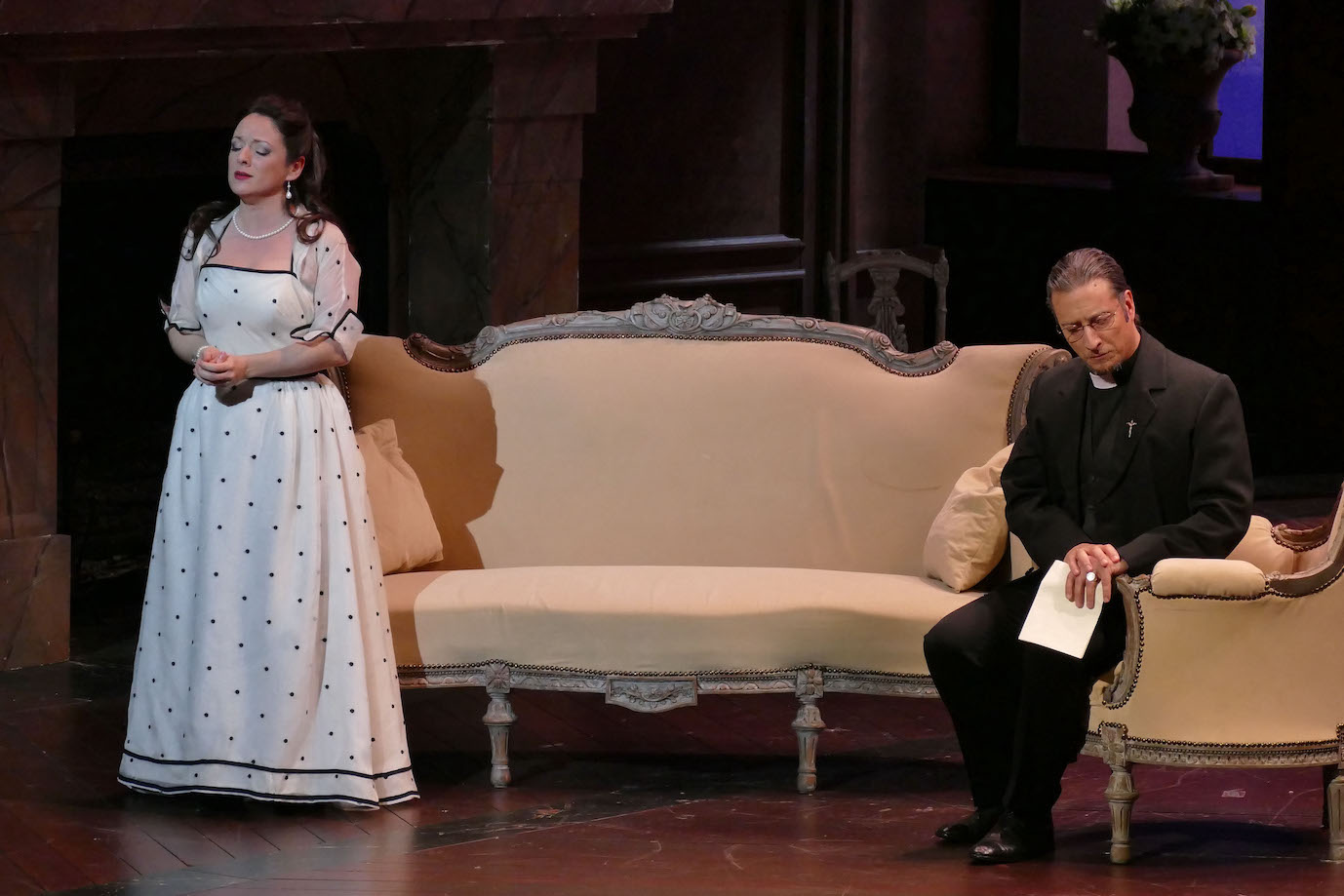
Act II. Ruth Iniesta as Violetta, Jérôme Boutillier as Germont
For the 2014 premiere of this mise en scène by Renée Auphan, Opéra de Marseille’s general director Maurice Xiberras engaged a young female conductor, Eun Sun Kim. This Korean maestra has since become the music director of San Francisco Opera. Please see my review of this splendid Marseille opera performance: https://www.michaelmilenski.com/review-archives.html#Traviata_Marseille
Just now Mr. Xiberras entrusted the assistant conductor of the Opéra de Marseille’s orchestra, Naples born maestra Clelia Cafiero to preside musically over the production. This young maestra imposed erratic, changing tempos that prevented Verdi’s longer periods from finding shape. She imposed disturbing and silly rhetorical interruptions to mark brief musical moments she chose to elaborate, naively ignoring the larger dramatic impetus of a scene. As well she confused leading her singers with following her singers, and then in softened accompaniment. The maestra’s conducting thus eviscerated the powerful dramatic thrust that marks Verdi’s middle period operas.
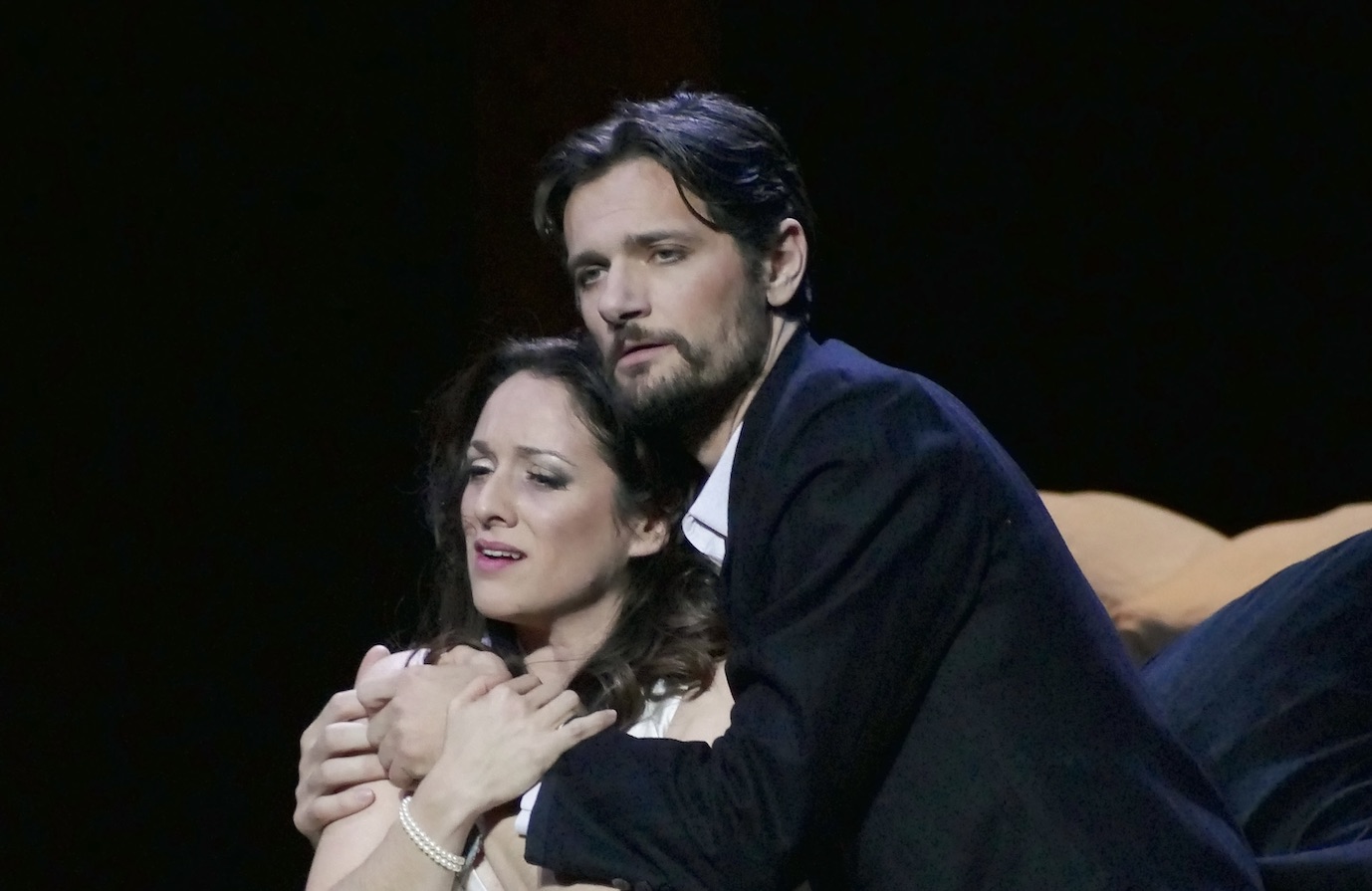
Ruth Iniesta as Violetta, Lawrence Janot as Alfredo
This 2014 Opéra de Marseille production was re-staged just now by Yves Coudray, straying from Renée Auphan;s original intensions that were based on a close reading of the Alexander Dumas fils novel La Dame aux camélias. Mr. Coudray’s staging was instead very straight forward, eliminating Mme. Auphan’s Annina elaboration as a lesbian companion to Violetta, and portraying Flora as an older, former prostitute, the two primary examples. The notable clumsiness of stage movement was perhaps exacerbated by the lack of musical thrust from the pit.
There were two strange episodes of pit silence when voices on-stage were left unaccompanied while off-stage revelry was accompanied by a backstage orchestra. The sound seemed to be, however, a strangely muffled recording rather than real instruments.
Mr. Coudray’s third act Flora recreated an amusing take-off of La Bohème’s second act Musetta shoe episode. There was suggestive interplay between Flora and the Marchese d’Obigny, sung by Frédéric Cornille. If was apparent that the production’s Flora, performed by Laurence Janot, was cast as a shapely dancer rather than as a singer. Alfredo’s friend Gastone was sung by Carl Ghazarossian, a man of many greater years than Alfredo. Alfredo’s rival, the Baron Douphol was sung by a rough voiced Jean-Marie Delpas.
The settings for this 2014 mise en scène were designed by Christine Marist. It is a unit set of three walls, a back wall with three large openings that were plugged differently for each act while the stage right wall had a monumental fireplace that remained in place for all four acts. With the studied lighting of the 2014 staging the set well served the richness of Mme. Auphan’s staging. Lacking that richness these four set elements were a cumbersome reminder that economies may become noticeably heavy-handed. The perfunctory period costumes were designed by Katia Duflot.
Opéra de Marseille, Marseille, France, February 15, 2024. All photos copyright Christian Dresse, courtesy of the Opéra de Marseille.
Adriana Lecouvreur at the Opéra Bastille
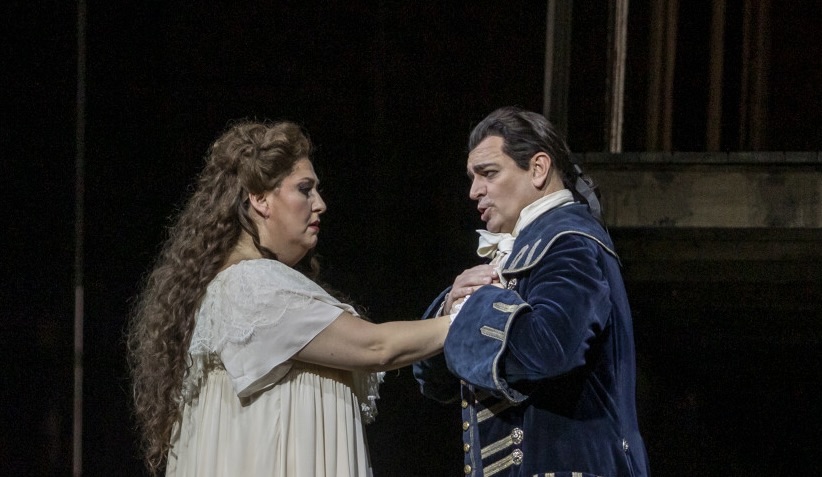
The one by Francesco Cilea. There are several others by forgotten composers. This one sits uneasily in the verismo category given its hyper contrived plot and its historical setting.
Leading ladies have long been a theatrical topos. Victorien Sardou’s play Tosca premiered in 1887 with famed French actress Sarah Bernhardt as Tosca. The great Italian actress Eleanora Duse ended her romantic relationship with Italian poet and tragedian Gabriele D’Annunzio in 1898 when he gave the leading role in his La Città Morta to Sarah Bernhardt (la “Duse,” as Eleanora was called, had had a relationship with Arrigo Boito [Verdi’s librettist] as well — FYI).
Famed French dramatist Eugène Scribe indulged himself in the diva topos with his 1849 play Adrienne Lecouvreur, the source of Cilea’s opera. Both Scribe and Sardou were proponents of “well-made” plays, these had simple, compelling narratives with quick resolution. Voilà! Such is, in principle, Cilea’s 1902 Adriana Lecouvreur, though its operatic narrative became hopelessly complicated.
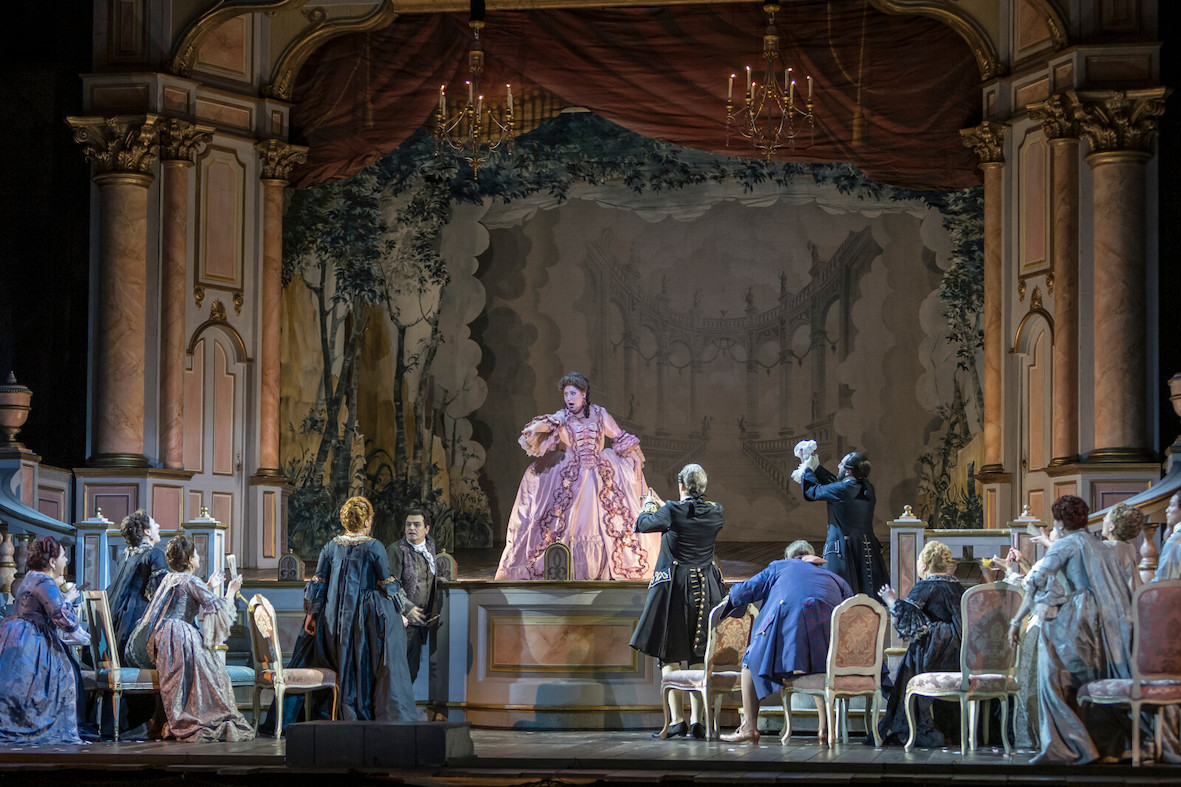
Adriana, having recited (spoken) a scene from Racine's Phaedre, accuses the Princess of Bouillon of adultery.
There was once a real Adrienne Lecouvreur, an actress of great fame in the Comédie-Francaise troupe. She died in 1730, rumored to have been poisoned, victim of a nasty amorous intrigue, by the Countess of Bouillon. Scribe’s play and Cilea’s opera imagine this intrigue replete with a dose of backstage lore and hints of obscure, early 18th century politics.
Tragedian D’Annunzio loved Cilea’s Adriana Lecouvreur, and wanted Cilea to make an opera of his 1901 tragedy Francesca da Rimini [Francesca was murdered by her husband]. The original champion of operatic verismo, publisher Edoardo Sonzogno however owned the rights to D’Annunzio’s play, and insisted that Riccardo Zandonai render it operatically. Bereft of this drama, perfectly matched to his style, Cilea has but two operas in the repertory, L’arlesiana and Adriana Lecouvreur.
Divas, seemingly, are considered essential to Cilea’s Adriana Lecouvreur. London’s Royal Opera engaged Romanian diva Angela Gheorghiu for its 2010 production, directed by David McVicar, designed by Charles Edwards. The production then came to the Opéra Bastille in 2015, again with Mme. Gheorghiu. The production moved to Vienna in 2017 and then on to New York’s Met in 2018, both with Russian diva Anna Netrebko. Just now it was mounted once again in Paris for seven performances, again with Mme. Netrebko, though she sang but the first four. Her real-life husband, Azerbaïdjanian tenor Yusuf Eyvazov was Adriana’s erstwhile lover Maurizio (illegitimate son of the king of Poland).
The final three performances were sung by Italian soprano Anna Pirozzi, long on the world’s major stages, and splendid Italian tenor Giorgio Berrugi. I attended the final performance. (See lead photo).
Sopranos with mature careers like Cilea’s Adriana role because it does not lie too high, and offers myriad opportunity to be a diva, vocally and histrionically. Its three arias are blockbusters, there are three intense duets, plus two nasty show-downs. The death scene is drawn out, with grandly ironic, quite histrionic pathos. Tenors like Maurizio because he offers them great opportunity to show off their spinto voices in its three blockbuster, though mercifully brief arias. Maurizio too has three intense duets.
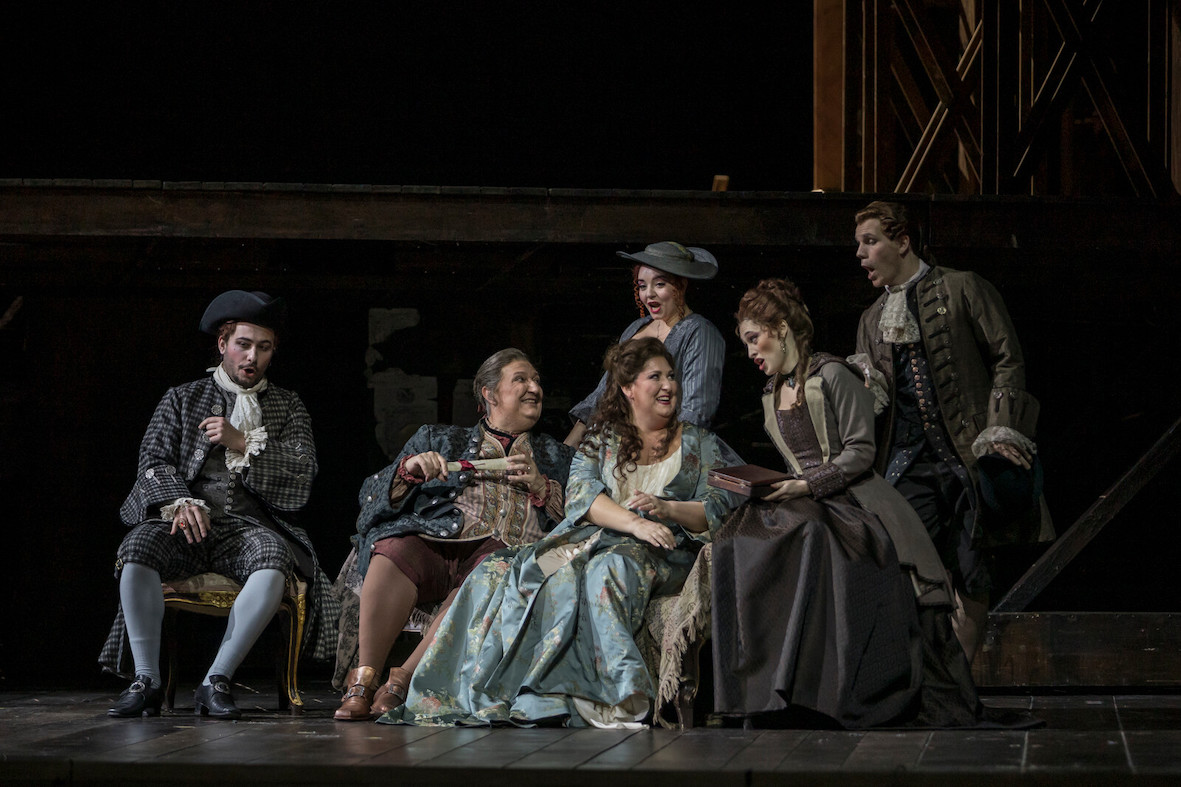
Clémentine Margaine as the Princess of Bouillon, with members of the Opéra national de Paris chorus
Not to mention the Princess of Bouillon, Adriana’s rival for the affections of Maurizio, who has the spectacular second act aria “Acerba voluttà…O vagabonda stella” plus two dramatic shouting matches with Adriana.
Well-made plays made into well-made opera librettos have the advantage of finding immediate placement for emotive elaboration. Such is Adriana Lecouvreur’s libretto. The opera is essentially a numbers opera, i.e. a succession of set pieces — the emotive elaborations are far more important than a coherent story-line. That of Adriana Lecouvreur is famously obtuse, allowing its multitude of showcase pieces.
The David McVicar production is conceived for the world’s biggest opera houses. Charles Edwards, a frequent McVicar collaborator, obliges with a massive set that is essentially the recreation of an elaborate 18th century, Rococo theater stage and backstage. McVicar, well known for his stagings of operas with heavily political overtones, wishes to evoke the political and social failures of the epoch in this Adriana, failures that he believes emerge succinctly through, and because of the lavish elegance of the period set and costumes of this production.
Be that as it may.
Perhaps someday there will emerge a production of Adriana Lecouvreur that reveals its roots in the basic, simple tenets of the verismo that flourished in Italy in the waning years of the 19th century. A production that, refreshingly, does not succumb to the opera’s diva worship status, with the complementary grand opera trappings that divas are perceived to require. A production that reveals the emotionally frank, naturalistic world that this unfortunate-in-love, 18th century revolutionary actress deserves.
Adriana Lecouvreur: Anna Pirozzi; Maurizio: Giorgio Berrugi; Princess of Bouillon: Clémentine Margaine; Michonnet: Ambrogio Maestri; Prince of Bouillon: Sava Vemić; L’abate di Chazeuil: Leonardo Cortellazzi. Orchestra and chorus of the Opéra national de Paris. Conductor: Jader Bignamini; Mise en scène: David McVicar; Stage Director: Justin Way; Set Design: Charle Edwards; Costumes: Brigitte Reiffenstuel; Lighting: Adam Silverman. Opéra Bastille, Paris France, February 7, 2024. All photos copyright Sébastien Mathé / Opéra national de Paris.
Giulio Cesare at the Palais Garnier
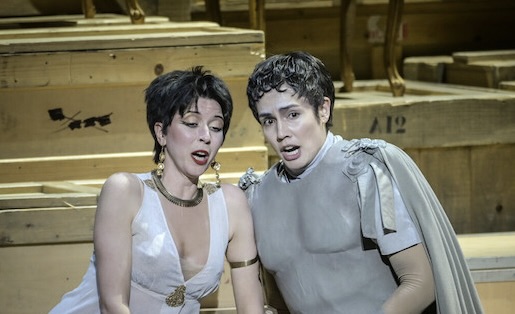
This Laurent Pelly production of Handel’s Giulio Cesare is wily indeed, enriching Handel’s estimation of antiquity’s most famous female with supreme wit. Were it pure Baroque opera seria these current Parisian audiences would surely have turned to stone.
The Pelly production was first seen in 2011 with Nathalie Dessay as its Cleopatra. Just now it was Lisette Oropesa’s Cleopatra who dazzled mezzo-soprano Gaelle Arquez’s eager Caesar. (See lead photo).
In 2011 it was the Lille based Concert d’Astrée performing on Baroque period instruments, now in 2024 it was the Orchestre de l’Opéra national de Paris playing modern instruments. Thus the horns that crown the final scenes did not crack and break Handel’s gorgeous lines as did these grand, old instruments of Les Musicians du Prince in Monaco’s recent Giulio Cesare. Instead Paris’ modern horns produced the smooth musical lines that are the glory of Handel’s famed score.
British harpsichordist and conductor Harry Bicket of London’s The English Concert [music director of The Santa Fe Opera as well] pulled every subtle sigh, smile, wile, frown, groan, sob, etc., from his singers, while encouraging the same from the pairs of flutes, oboes and bassoons that joined strings (8/8/5/4/2). All together they created the seduction, desperation and triumphs of love, sorrow, despair, hate, deception and revenge that the 44 numbers of Handel’s most performed Italian opera could conjure up. There are 31 arias, 2 duets, 2 small choruses [only to begin and end the opera] plus myriad recitatives and ariosos to introduce the arias. The program booklet credits the Bärenreiter HHA edition, my count is surely close.
It is usual in performances of Handel operas that there are quite a few empty seats by the third act. Those who braved the first act and returned for the second were treated to an amazing coup de théâtre. Eight beautiful maidens in matching white, high Baroque gowns come onto the stage with instruments (including a harp) to accompany (without score) Cleopatra’s scorchingly sensual (though she is impersonating Virtue) “V’adoro pupille.” Pelly’s Parnussus scene takes place within a huge, empty painting frame surrounded by these lovely, musical muses. The frame becomes an actual Fragonard painting as it moves upstage.
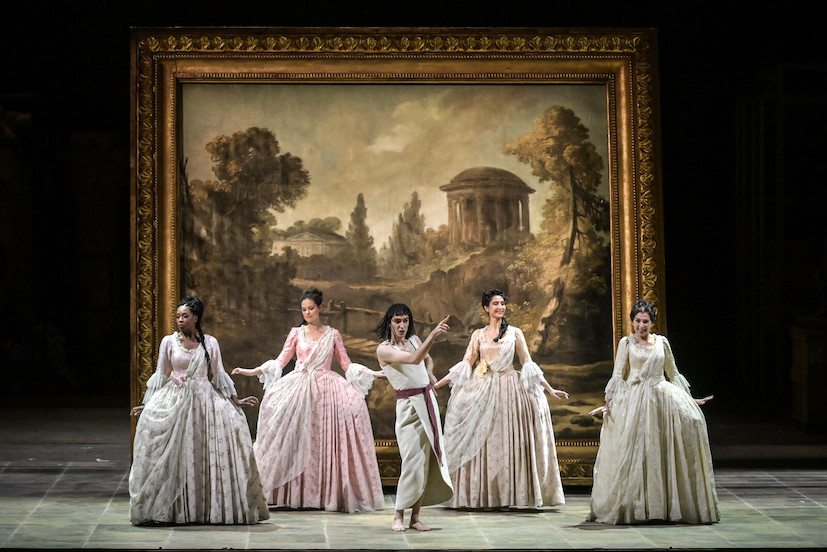
Rémy Bres as Cleopatra's confidant Nireno, with four decorative supernumeraries (these in addition to the eight muses, not pictured).
The second act is Laurent Pelly’s eighteenth century act. During the act a series of paintings (of not easily perceived reference) were ferried across the stage by the warehouse hands of a major museum’s storage facility, one assumes the Louvre with its massive collections of paintings and Egyptian sculptures.
Pelly’s first act obviously takes place in the museum’s antiquities storage area. A phalanx of Roman busts mouthed the words of the opening chorus [!], eliciting the animation of the Handel’s spirits of antiquity. Cleopatra arrived atop a massive representation of an unidentifiable Egyptian deity, pulled onto the stage by warehouse hands. She was lightly draped in a white, filmy gown, covering everything, more or less, except one bare breast. The warehouse hands could not be caught looking, we were less discreet.
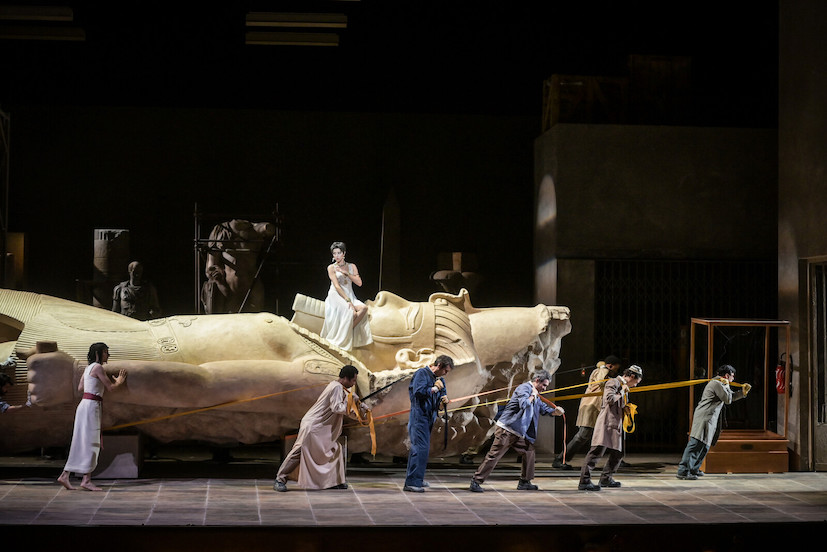
The third act takes place in the museum’s antique Persian rug storage area. Pelly deployed several middle-Eastern men sitting crosslegged, restoring old, worn rugs, while across the stage warehouse hands were spreading out and rolling up rugs. In this final act Cleopatra is held captive in the confines of her brother’s harem, Caesar is off in battle, the warehouse hands became the soldiers.
The Pelly sight gags are heavy handed indeed, but fly lightly because they are so very witty. This surely served to excite our sensibilities, helping us feel the powerful, dramatic crescendo of the succession of arias. Those of us who remained for the third act were tightly in the grip of a number of personal dramas — Sesto’s desire to avenge the death of his father Ptolemy; his mother Cornelia’s need to rebuff the advances of Tolomeo and Achilla; Cleopatra’s war with her brother, and her love of Caesar who she now believes to be dead.
Caesar’s ship (literally) came in. Back in the warehouse a huge statue of a Roman hero was rolled on. Caesar and Cleopatra were at last reunited and finally alone on the stage. A custodian illuminated a “ghost lamp,” the single lightbulb that darkly illuminates the ghosts of a theater’s stage.
Handel’s world was vibrantly alive with excellent performances by Lisette Oropesa’s Cleopatra and Gaële Arquez’s Giulio Cesare. Louisiana (USA) born Mlle. Oropesa is quite shapely, easily embodying the arrogant and calculating sirene of myth. As Handel’s heroine she is also a sincere lover, ready to die as her brother’s prisoner. As defeated as she was in her heartbreaking “Piangero la sorte mia,” we were smitten by its sincerity. An estimable technician of beautiful voice she wove the florid lines of her multiple arias into a convincing whole.
Though Handel created the role of Julius Caesar for the famed castrato Senesino, in this third edition of the Pelly production it was sung by French mezzo-soprano Gaële Arquez. A formidable technician of beautiful voice as well, she embodied the love-stricken Caesar with great conviction. The timbre of the female mezzo soprano voice, arriving finally at her tender “Aure, deh, per pieta spirate nel petto mio,” melded perfectly into the intense lyricism instilled by maestro Bicket.
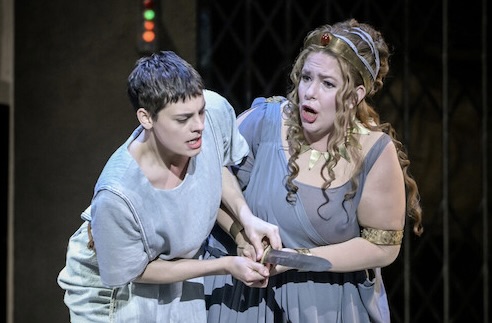
Emily D'Angelo as Sesto, Wiebke Lehmkuhl as Cornelia
Complementary to this lyricism were the voices and characters of German contralto Wiebke Lehmkuhl as Cornelia, wife of Pompey, and their son Sesto, sung by Canadian mezzo soprano Emily D’Angelo. Their duet, “Son nata a lagrimar” that closes Act I, was of sublime beauty.
Of note was the casting of Italian bass-baritone Luca Pisaroni as Achilla. This formidable performer well outshone his boss, Cleopatra’s brother Tolomeo (Ptolemy) performed by British counter-tenor Iestyn Davies. Nireno, Cleopatra’s trusted confidant, was sung by French counter-tenor Rémy Bres in the spirit of legendary French counter-tenor Dominique Visse, its original 2011 player.
The Pelly production (sets and costumes) was designed by Chantal Thomas and lighted by Joël Adam, both long-time Pelly collaborators. This revival was staged by Laurie Feldman.
Palais Garnier, Paris, France, February 8, 2024. All photos copyright Vincent Pontet / OnP, courtesy of the Opéra national de Paris.
Beatrice di Tenda at the Opéra Bastille
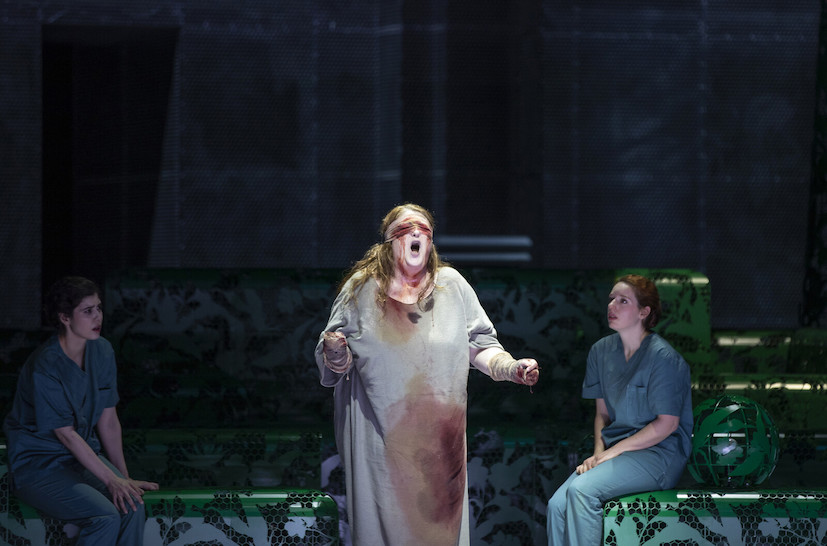
Bellini’s second to last opera, Beatrice di Tenda, was not a success at its 1833 Venice premiere, though subsequent performances are said to have overcome the opera’s macabre horrors through the brilliant performances of Giuditta Pasta, the bel canto diva-of-the-day, as Beatrice.
Much the same can be said of the Peter Sellars / George Tsypin production of Beatrice di Tenda that opened last night at the Opéra Bastille. The horrors of the opera were made very present — the villain was truly vile, the love intrigue was equally vile. The production’s redemption was the performance of the American diva Tamara Wilson as Beatrice. (see lead photo)
As the voice of Giuditta Pasta was described by famed early nineteenth century opera aficionado novelist Stendhal, la Wilson too is a perfect soprano sfogato (aka soprano assoluto), in other words a heroic soprano with extended upper and lower ranges, able to negotiate complex fioratura with grace and ease. Mme. Wilson sings both Turandot and Isolde, and now Beatrice. Unlike la Pasta, la Wilson does not strain to nail and extend a high D, nor does her voice assume different timbres in different ranges. It remains full and warm throughout, with a plenitude of colors, and an unerring sense of pitch in the dramatic leaps Beatrice executes in her most extreme moments. In equally intense, reflective moments she smoothly negotiates Bellini’s soaring lines, embellished with clearly executed, perfect trills. Bel canto indeed.
Beatrice, just now in director Sellars' Paris, unfortunately champions progressive political causes. It worked out well with her first husband, but he died young. She had the power to elevate a rising young politician to a position of great power, and he became her husband, later becoming corrupt. She then championed a young, progressive reformer who unfortunately fell in love with her. Unfortunately Agnese, a beautiful young woman, is in love with Orombello, the progressive reformer, though Filippo, Beatrice’s corrupt husband is madly in love with Agnese. German mezzo-soprano Theresa Kronthaler sang the role. She too qualifies as a soprano sfogato, plus she boasts a voice of truly magical beauty, well able to bewitch Filippo, if not Oronbello. Mlle. Kronthaler’s roles include Sieglinde.
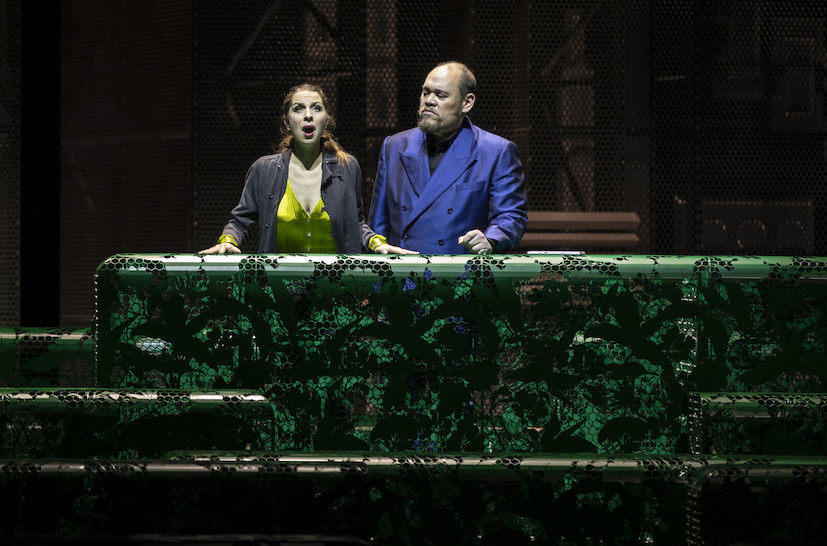
Theresa Kronthaler as Agnese, Quinn Kelsey as Filippo Visconti
San Francisco finished, New Zealand Māori tenor Pene Pati sang Orombello. Mr. Pati excels brilliantly in the bel canto repertory, though he sings the Duke of Mantua and Rodolfo as well. His bows are indeed florid. Famed American baritone Quinn Kelsey sang the villain Filippo with much the same élan that he brings to his signature role, Rigoletto.
Peter Sellars’ production politicizes Bellini’s setting of a moment of early fifteenth century history (history according to opera — not exactly fact), bringing it into our contemporary experience. Sellars emphasized the brutality of Filippo, his corrupt nature and the self indulgences of a dictator encouraged by his attendant sycophants (the 40 or so male voices of the chorus). At other times these male chorus voices are joined by the 45 or so female voices to become the populous abused by Filippo, the corrupt dictator. The populace makes a mighty noise, a real threat to the dictator’s power. The finale choruses are sung from the theater’s upper reaches, thereby including us seated in the theater among their commenting force.
Mr. Sellars adds yet more from his arsenal of theatrical devices. Filippo has a few henchmen armed with Uzi guns or maybe ak47’s, a universal symbol of the brutality of the state. There are two performers of exotic provenance (diversity) — Mäori tenor Pene Pati is joined by his brother, San Francisco finished tenor Amitai Pati as Anichino, here rendered as a brother (not the Bellini friend) to Pene Pati’s Orombello. Amitai Pati is a fine tenor — Toulouse’s Alfredo, ENO’s Ferrando. Certainly the outsized chorus was complimentary to Mr. Sellars concept as well.
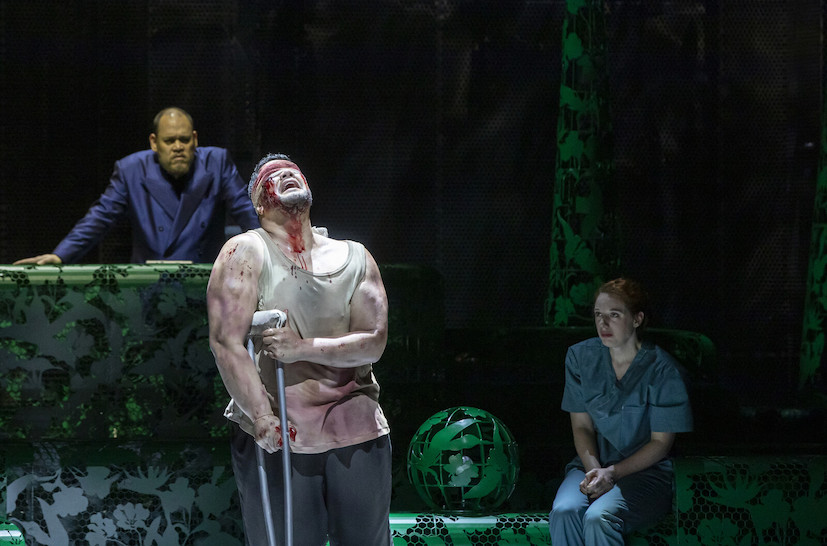
Pene Pati as Orombello
In the end Sellars displayed Beatrice and Orombello’s dying prayers with blood and guts spilled on the stage, Orombello and Beatrice in hideous, physical states, bel canto be damned. Filippo effected his revenge, Mr. Kelsey oscillating between remorse and ferocity, breaking free of the beauty of bel canto to crush those who challenged and betrayed him. The execution by six Uzi bearing thugs was aimed directly at the audience, Beatrice, having forgiven Agnese, begs us not to pray for her, Beatrice, but to pray for Filippo. We, mankind, felt redeemed. All of us.
Peter Sellars again evidenced himself as a potent theatrical mind.
All this bloodshed took place within a huge, complex piece of sculpture that transformed from transparent bright green to transparent bright red, fading to a gray. The huge structure was a mesh back wall with evolving textures. Side walls were reflective to destroy all boundaries. The floor was a manicured French topiary garden, a maze that told us we were in a highly regulated if arcanely governed world. Gardeners toiled to keep it so, and then these gardeners polished the reflective walls as Filippo briefly thought he might have a bit of compassion. Kazakhstan born, American finished designer George Tsypin created this massive piece of art that did not overwhelm Bellini’s small scale opera, though its sickly, luminous, quite important world was well beyond this incidental moment of opera history.
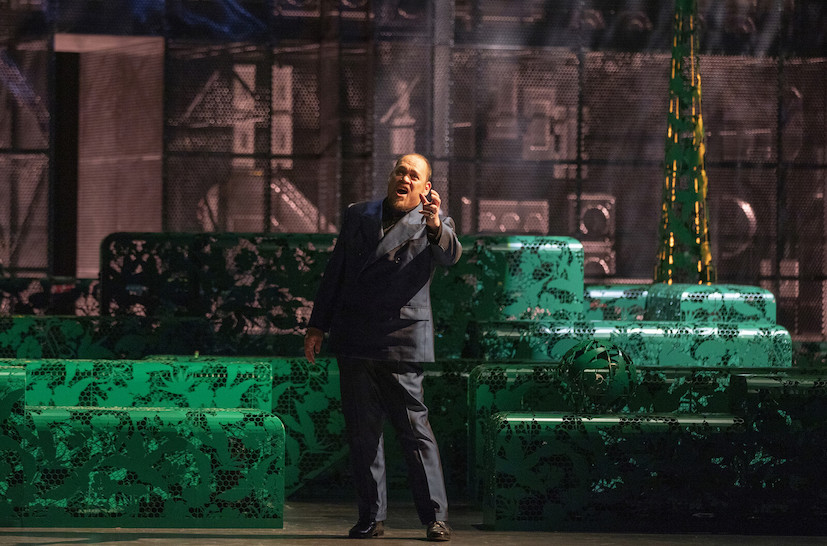
Quinn Kelsey as Filippo Visconti, with a small portion of the set visible.
The pit of the Opéra Bastille is a lively place, Bellini’s orchestral sounds pealing forth in political exuberance. British conductor Mark Wigglesworth participated whole heartedly in the Sellars concept. Much of the evening was not devoted to Bellini’s bel canto as much as it was devoted to a rhetorical delivery of text. The recitative moments were deliberately paced, indeed becoming oppressive as the evening progressed — we were being told and told some more. Much use was made of silences to emphasize the political points director Sellars wished to make, interrupting the inbred flow that is the glory of bel canto. Mr. Wigglesworth did provide very effective, informed musical support for the arias, and certainly for the massive choruses, and especially for the final prayers.
It was, of course, a splendid evening, albeit trivial in effect, if not for the spectacular singing of la Wilson.
The costumes were designed by Camille Assad, lighting design was by James F Ingalls, both longtime collaborators of Mr. Sellars. Rizzardo del Maino (Filippo’s confidant) was sung by Taesung Lee.
Opéra Bastille, Paris, France. February 9, 2024. All photos copyright Franck Ferville_OnP, courtesy of the Opéra national de ParisDie Frau ohne Schatten in Toulouse
The fifth opera in the Richard Strauss canon — the one that is truly gigantic — staged just now at Toulouse’s acoustically famed 1150 seat Theatre du Capitole in the splendid 2006 production by the late Nicholas Joel and his designer, the late Ezio Frigerio.
Very much alive in Toulouse was the electric presence of German conductor Frank Beermann and the Orchestre national du Capitole, replete with all players needed to realize Strauss’ massive score, effecting the astonishing fortes of the earthquake and, in the end, the magnificent, sonic triumph of humanity. The flutes and oboes instilled the disturbing dissonances of the falcon’s wailing call, a bassoon lamented the intimacies of sorrow, and a cello quartet warmed the hut's heart, all this against the Elektra-like maelstrom that tormented the souls of the opera’s protagonists.
It is indeed Strauss’ richest score, Hofmannsthal’s sprawling, symbolist libretto awarding the composer myriad opportunity to musically explore the lowly human condition as it extends into its most basic spiritual extensions. The story is essentially the same as The Magic Flute, with the inscrutable symbolist mysteries of Pelleas et Melisande thrown in. Wagnerian philosophical myth is never far away, and the scent of the nascent National Socialism is maybe just a bit perceptible.
Sophie Koch as the Nurse, Issachah Savage as the Emperor
The design metaphor was minimalist geometry — the lighted planes and grids of the suspended spirit world, the dark circles and holes of the human world. Myriad stairs connect these two worlds within a huge, complex stage apparatus that glided effortlessly and magically from one world to the other, exactly timed to the orchestral intrusions that bind the scenes. The stage apron itself was the visual key — its reflective surface a constant reminder that we were in a surreal, symbolic world.
The Dyer's hut (note the reflections on the stage apron)
Equally minimalist in its storytelling was the Nicholas Joel staging, realized by stage director Stephen Taylor. The nurse remained always the pivotal force, a very magical presence that clearly provoked all action, motivated by her distaste of the lower, human world. The dyer’s wife was forever petulant and flighty, the dyer himself was warm and accepting of anything, almost. The emperor was lost in the woods somewhere, searching for his falcon, not sure how he found himself in an opera. The empress, possessed by love, was the passive observer of her nurse’s machinations until she was made to feel the warmth of real, honest human emotion. She then banished her nurse and proclaimed — spoken, not sung — “ich bin nicht” in a shattering, very un-Straussian, highly theatrical orchestral silence.
Minimalist imagery defined the two worlds of the opera. The warmth of dyer’s world was present in the three fires that inhabited his hut, enabling his toil, indeed his life. The intimacy of opera’s extended monologues were directly expressed to us by the upper-world protagonists standing on the reflective stage apron. The magic of the fish children being fried, the earthquake and the fountain of life were assigned not to scenic effects but left to the magic of the Strauss score in abstract sonic metaphors.
The greatest glory of the production was, then, the Strauss score that illuminated Hofmannsthal’s strange, retro exploration of 18th and 19th century European social thinking. Conductor Beermann left no musical stone unturned. It was a brash, immediate rendering of the musical tenets of post Romanticism, with grandiose overtones of expressionism forcefully implied. The orchestra of the Théâtre du Capitole is a virtuoso ensemble that rose to magnificent volumes when not whispering under the quite beautiful moments of solo violin and solo cello.
Die Frau ohne Schatten is infamous for its requirement of five heroic singers. The Théâtre du Capitole assembled a cast of great interest. Of foremost effect was the Nurse, sung by French mezzo-soprano Sophie Koch (also Toulouse’s Isolde, Sieglinde and Kundry). With minimal body language she created an other-worldly presence that never faltered as she ruthlessly manipulated the Empress, the Dyer and the dyer’s wife. Mme. Koch was in fine voice, well able to ascend to the upper reaches of the role in beautiful tone, and finally to accept her banishment in heart-rending motions of defeat.
American baritone Brian Mulligan made a huge impression as Barak, the dyer. Mr. Mulligan possesses a voice of warmth and beauty that brought extraordinary prominence to this role, allowing his character to soar musically, investing this Strauss role with a seldom discovered lyricism. The Barak persona is complex, Mr. Mulligan embraced his character's opposing forces — a supposed brutish personality that embodies enormous sympathy. See lead photo.
Barak’s wife was sung by German soprano Ricarda Merbeth. The Dyer’s Wife is known as a treacherous role, requiring considerable force and size to rise over the Straussian maelstrom that defines her tormented character. She is obviously highly neurotic, making her a heroine nearly equivalent to Elektra. Mme. Merbeth found a brutish petulance for the role that never faltered, vocally strident as needed, coyly contrite when she needed to be, with conflicting emotions always superimposed. Mme. Merbeth well met the role’s formidable challenges. See lead photo.
Elisabeth Teige as the Empress, Sophie Koch as the Nurse. Costumes designed by Franca Squarciapino.
The Empress was sung by Norwegian soprano Elisabeth Teige, the Emperor was sung by American tenor Issachah Savage. Both artists are of golden colored, forcefully heroic voices that served to place their characters apart from, and above the characters of the lower world. The Empress managed her Act I coloratura with apparent ease, and had the stratospheric reserve needed to surmount her huge, Act III confrontation with her unseen (or heard) father. Mr. Savage had all needed forces to surmount the extreme tessitura of his magnificent Act II monologue.
Of particular note was the role of the king (Kiekobad) of the spirits’ messenger beautifully sung by French bass-baritone Thomas Dolié, as were Barak’s brash and lively brothers, sung by Aleksei Isaev, Dominic Barberi and Damien Bigourdan.
Nicholas Joel was the artistic director of the Théâtre du Capitole from 1991 through 2008. Aside from the administration of the theater he bequeathed Toulouse a sizable legacy of productions that continue to be staged (in recent years I have seen his Die Walküre and Tristan und Isolde). Among his contributions to the Théâtre du Capitole was the refitting of its stage housing in 2004, making it possible to mount productions as complex as this 2006 La Femme sans Ombre.
Ezio Frigerio designed the sets for Giorgio Strehler’s famed production of Le nozze di Figaro that held the stages of Versailles, the Garnier and finally the Bastille from 1973 until 2011. Frigerio’s wife, Franca Squarciapino designed the costumes for the Strehler Nozze, as well as all the later Frigerio productions.
Théâtre du Capitole, Toulouse, France, January 31, 2024. All photos copyright Mirco Magliocca, courtesy of the Théâtre du Capitole.
Carmen and La bohème at the Festival International Film d'Opéra d'Entrecasteaux
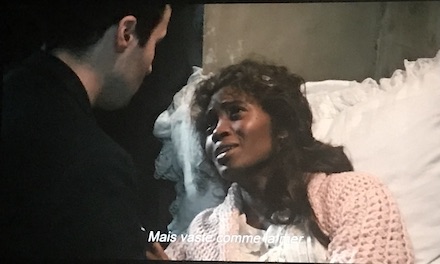
That’s Festival International Film d’Opéra d’Entrecasteaux (a tiny village in Provence). The two films of this inaugural year were Francesco Rosi’s 1984 Carmen and Luigi Comencini’s 1988 La boheme (lead photo).
The surprisingly large audiences spread out their picnics on the town’s old wheat field to watch the films, making it a live, and lively event.
Why such films were made is unknown, film director Francisco Rosi (1922-2015) said that he was offered the job of making a Carmen movie, thus it was not a film director realizing his dream of directing an opera.
It is of interest to note that the wildly successful American film, Otto Preminger’s 1954 Carmen Jones was released in France only in 1981, twenty-five years after it was made, as French intellectual property law prohibits transformative use of original material. The injunction was finally rescinded [see François Truffaut’s « Les héritiers de Bizet contre Carmen (Jones) »].
Carmen Jones, featuring an all black cast, its story set during WWII in a jazz version of the Bizet score, was a film of the moment in the U.S., the civil rights movement festering, then bursting when the U.S. Supreme Court ruled in 1956 that segregation on Montgomery Alabama buses was unconstitutional. Francesco Rosi was an Italian filmmaker known for highly politicized films, thus, may I speculate, tempting the producers of a post 1981 French/Italian Carmen film to hope for an edgy take on gypsy life.
This was hardly the result. Filmmaker Rosi painstakingly evoked the land and townscapes of 1875 Spain, ignoring the dust and the heat and the poverty, finding only the stark and arid beauty of the Andalusian landscape. And the basically good natures of its inhabitants, Zuniga was simply tied to a chair at the end of Act II, not beaten to a pulp — the world awaited the dark, ugly 1970 sides of the Spanish soul that came to light in Spanish opera director Calixto Bieito's nasty 2014 Bilbao Carmen (greatly sanitized in his Paris and San Francisco versions).
Rosi very carefully curated his locations in Spain’s towns of Ronda and Carmona as well as in the Seville of 40 years ago. The views are perfectly framed. The costumes are specific to 1875, the year of Carmen’s premiere, beautifully pressed. There is maybe a tiny hint of social commentary when we see the toreador Escamillo sitting in a fancy salon with Spanish Grandees. Though this Image may have been present in some magazine illustrations of Spain that were published in 1873. Rosi used these old illustrations as his visual models, assuming this was exactly what Bizet had pictured in his mind, given that he, Bizet, had never set foot in Spain.
The brutal drama that is normally present in an operatic Carmen is heavily veiled by the perfection of the visual frames, by the the use of Bizet’s music as background for visual transitions and crowds, by the silences the filmmaker imposes from time to time, by the clatter of shodden horse hoofs, the shouting of street urchins. Further distance from the operatic drama is created by using actors’ voices, not the singers’ voices, for the dialogues, words they breathed onto the soundtrack, quite unlike the singers’ mouthing their words to a pre-recorded soundtrack.
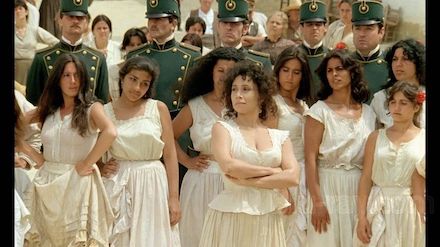
Julia Migenes-Johnson as Carmen in the Francesco Rosi Carmen
Rosi’s Carmen is primarily a visually poetic evocation of Spain’s Andalusia of 1875. But, cherry-atop-the-cake, it is also a star-turn. The Rosi Carmen, the gypsy girl herself, is Julia Migenes-Johnson, simply the most real, animal Carmen imaginable. The Rosi film is important for no other reason than to have recorded such a remarkable performance.
But in Rosi’s film this amazingly cinematic Carmen is confronted by three opera singers. A middle aged Placido Domingo as Jose, an approaching middle age Faith Esham as Micaela, and a flashy, very Italianate, middle aged Ruggiero Raimondi as Escamillo. These formidable, though mis-cast artists, the high art of opera singing, plus Rosi's colorful, touristic 1875 Spain created an insurmountable distance to a real, cinematic telling of the Carmen tale.
Not to mention the high art of pretentious filmmaking intruding onto one of opera’a most directly emotional works.
The Rosi Carmen was very well received in its time, nominated as best foreign film by the Golden Globes, BAFTA, and César Awards. Forty years later I found the film to be hopelessly boring.
Film director Luigi Comencini (1916-2007) made his opera movie La bohème in 1987, very soon after the Rosi Carmen. Boheme’s producers, may I speculate, wished to catch onto the coattails of the Rosi Carmen’s huge success.
Comencini therefore had the benefit of knowing Rosi’s film. He made very interesting, and wise artistic choices. He too used one of opera’s top tenors, casting the then 42 year-old José Carreras as Rodolfo. Carreras was in great vocal form in 1987, though he had been stricken with leukemia and would be unable to participate in the filming. Unfazed, Comencini cast Italian actor Luca Canonici as a young, very real, bohemian Rodolfo, to the recorded voice of Carreras.
Originally a tenor leggiero, Carreras took on vocally heavier roles as his career advanced, assuming ultimately the attributes of a tenorissimo — a magnificent virtuoso sound above all else! By 1987 he had added a spinto character to his voice that colored his Rodolfo with a dark, quite beautiful tone that he infused with urgent, passionate delivery. It was this voice and this delivery that took center stage in this filmed opera, though its singer and the physicality of vocal production were unseen.
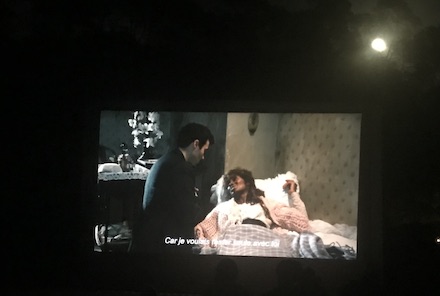
Luca Canonici as Rodolfo, Barbara Hendricks as Mimi on the screen erected on the Entrecasteaux wheat field. Note the harvest moon.
Actor Luca Canonici did not attempt to assume the physical postures or breathing required for this spectacular vocal delivery, allowing his emotions to be remain hidden, but obviously the unseen emotions were still very real. Enacting such intensity would simply not have been possible within the intimacy of the film medium (in opera the singer is the emotion). Actor Canonici’s Rodolfo was both deadpan and hugely felt. It was cinematically real, if nothing else.
Comencini cast Black American soprano Barbara Hendricks as Mimi. Mme. Hendricks was 39 years-old when the film was made, of slight figure. Like tenor Carreras she began her career as a light lyric soprano, taking on full lyric roles as her career advanced, of which this Rome filmed Mimi was the first of these heavier roles. To our contemporary ears Mme. Hendricks does not possess a Puccini voice, but she does indeed project a Mimi presence, enhanced in the Comencini Boheme by the light and pure tones of her voice. While the soundtrack was pre-recorded there was the sense that she was in fact actually singing her words.
Though the opera may be titled La bohème it is emotionally not about Mimi, Puccini reserving his operatic fireworks for Rodolfo.
All the principal roles were cast with opera singers of appropriate age and character. The then 32 year-old Gino Quilico was a charming Marcello, the then 31 year-old Angela Maria Blasi was the consummately vivacious Musetta.
The settings were built at Rome’s Cinecittà to be an elaboration of the storybook rooms and streets of Paris where the opera takes place. Thus the action could move inside and out, here and there with simple film cuts in this greatly expanded operatic world.
There was a sizable garret space for the antics of the starving artists, a very feminine garret room for Mimi, and a stairwell connecting these garrets. The Cafe Momu was a big indoor bistro, and there was a separate street outside where a huge marching band passed by. Marcello and Rodolfo’s Act IV duet was sung in a public square, an elegant open carriage pausing for its passengers to observe momentarily the beautifully sung lament.
Comencini never forgot that opera is opera. His La bohème is an opera, a real opera on film. It packed a wallop.
Entrecasteaux, France, September 1 and 2, 2023
Falstaff and Macbeth in Salzburg
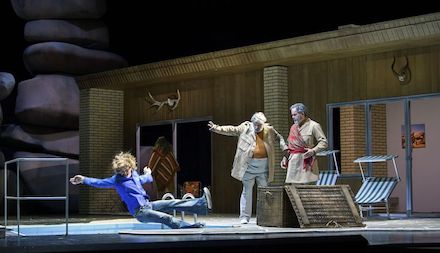
Falstaff at the hands of old-guard avant-gardistes Christof Marthaler and Anna Viebrock. Set on a sound stage somewhere (certainly Hollywood) where Orson Wells is acting or directing his three Falstaff movies.
Not that those films had much of anything to do with Verdi’s Falstaff that was also on the stage. It took some time to catch on that Orson Wells was only an innocent bystander, as were the twenty or so non-singing film crew. There was some amusing movie making, and there was a lot more very lively opera making.
Meanwhile in the pit avant-gardiste conductor Ingo Metzmacher took his turn. He turned the Vienna Philharmonic players loose, each to his own. The maestro gave his Falstaff orchestra the ride of its life. It was mighty and infectious.
Thus simultaneously there was Orson Wells himself (German actor Marc Bodner) and Orson Wells movies (that we didn’t know or need to know), there were the nine singers of Verdi’s Falstaff (whom we all know fairly well) and there was an orchestra having great fun in the pit. Sometimes it was all together, and sometimes it was not. Nobody seemed to care too much. We all had a lot of goofy fun watching the opera climb on top of a movie while trying to keep up with the pit. (See lead photo, Falstaff [Orson Wells] and Falstaff [Gerald Finley] with actor Joaquin Abella as the First Assistant Director.)
Christof Marthaler knows that Verdi’s opera plays itself, that Shakespeare’s plays were on a bare stage. He knew that Orson Wells is textbook Falstaffian, and that movie making is organized chaos. A veteran of many opera productions (he was a favored director of Gerard Mortier, a visionary opera impresario [in Brussels, Paris and Madrid] of fairly recent times), he knows that orchestra players are happiest when they are the busiest — there is no score busier than Falstaff.
And voilà! The Salzburg Falstaff!
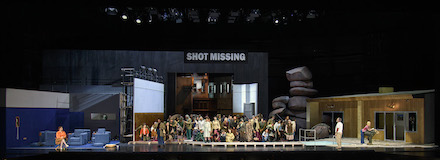
All Falstaff photos copyright Ruth Walz, courtesy of the Salzburg Festival
Anna Viebrock’s set was three juxtaposed spaces — a cozy projection room next to a sound stage, and a Southern California pool deck. The sound stage loading doors opened to reveal a classic Italian city-scape movie set reminding us there was an elsewhere in Verdi’s opera (though certainly no black oak tree).
All the Marthaler shenanigans miraculously added up in the finales. At the end of the first part it was Orson Wells who got dumped into the pool. At the end of the opera we were informed that there was a missing shot (a movie scene, see above photo), so we missed out on the surprise Nanette/Fenton marriage (they did not even stand together for the famous fugue). The final coup de théâtre was Sir John Falstaff (Orson Wells) wandering tiredly across the stage in full, knightly regalia. He took off his helmet and sang [!] the final line of the opera, “Ma ride ben chi ride La risata final,” with little conviction.
The Salzburg high concept productions are cast with great care. Canadian bass-baritone Gerald Finley was the unlikely Falstaff (his program credits listed no such credit). Of reasonable body dimension he often played with a prosthetic fat suit, always treating his character with an amused aloofness (after all he always had the real Falstaff [Orson Wells] nearby). He was well able and willing to do the physical comedy antics, including rolling across the sound stage entwined with an acrobat and a dummy at his tryst with Alice Ford. He possesses a voice of power and beauty, attributes used to preserve a stable presence as the Falstaff double.
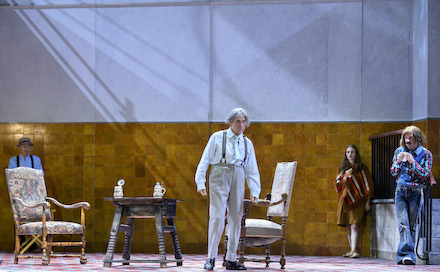
Simon Keenlyside as Ford
British baritone Simon Keenlyside was the unlikely Ford (no program credit listed for this role), given that Ford was played with silent film comedy exaggeration, together with which he managed some fairly extreme physical comedy. Unlike Gerald Finley’s Falstaff, he was not aloof from his role, but right there to make us realize that we were on a movie set, a place where yet another idea of high art reigns.
Perfectly cast as well were Ukrainian tenor Bogdan Volkov as Fenton and Italian soprano Giulia Semenzato as Nanetta. The two lovers snuggled among the chair pillows of the projection room, entwining themselves in ribbons of cine film, Fenton’s lovely “Dal labbro il canto” was sung on the empty sound stage, Nanetta’s lovely “Sul fil d'un soffio etesio” was sung from scaffolding high above the sound stage, an old fashioned stage light at her shoulder illuminating the as yet empty sound stage floor way below.
Alice Ford was sung by Russian soprano Elena Stikhina in grand voice and presence, Dame Quickly was sung by German mezzo soprano Tanja Ariane Baumgartner and Meg Page by Italian soprano Cecilia Molinari. Always exuding delighted playfulness the three women were joined by Nanetta in the swimming pool for their big Act 1 quartet — clothed, their heads peaking over the edge.
Swimming pools are normally not found next to sound stages, but Falstaff does call for a river. Though there was no water in the pool, the First Assistant Director (actor Joaquin Abella) dove into it repeatedly during the first finale, when not trying to fit himself into various baskets and hampers. (see lead photo)
Completing the cast were tenor Thomas Ebenstein as Dr. Cajus, tenor Michael Colvin as Bardolfo, and bass Jens Larsen as Pistola.
And there was Macbeth at the hands of the very latest operatic avant-gardistes, Krzysztof Warlikowski and Malgorzata Szczęśniak, set in a huge waiting room, information screens high above and on one side an intruding jetway.
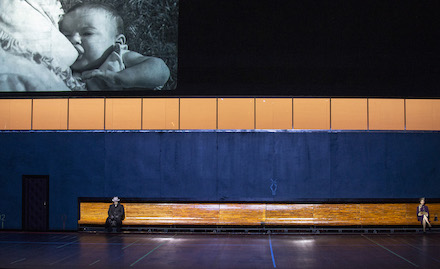
All Macbeth photos copyright Bernd Uhlig, courtesy of the Salzburg Festival
The setting was a vista. waiting with us for the opera to begin were a man sitting at one end of a very long bench, and a woman at the other end, very far away. The overture emerged in loud, sharp, unfamiliar tonalities, there were images of mothers nursing babies on the informational screens.
An additional waiting room, stuffed with women (like in European train stations), slid onto the stage to sing the famed prophecies, strings of little girls formed circles wherein Macbeth and Banquo, both heroic warriors and heroic singers, learned their fates — Macbeth will be king, Banquo will be the father of future kings.
We learn that Lady Macbeth is barren (there was a visit to a gynecologist on the information screen), we know that both she and Macbeth are terrified of Malcom (the late King Duncan’s son and his legitimate heir) and we know that Macbeth is terrified of all Banquo’s sons. We know the Macbeths together became a serial killer team with the slaughter of Macduff’s wife, sons and daughters. And we learn that MacDuff was not born, but torn from a womb.
A waiting room is a womb, it is an image of infinite depth, here mercilessly exploited by Mr. Warlikowski and Mme. Szczęśniak (husband and wife in real life) in this shattering vision of the Macbeth tragedy now surrounded by children — the children that Macbeth and Lady Macbeth so fear.
We see and hear that the players are not singers of Italian opera, but are singers and players in the Warlikowski/Szczęśniak opera cycle of dysfunctional families (Hamlet in Paris, A Quiet Place in Paris, Elektra in Salzburg). But in their telling of this Salzburg Macbeth there is no Macbeth family, and what other families there were are summarily destroyed at their hands — those of Duncan, Banquo and Macduff.
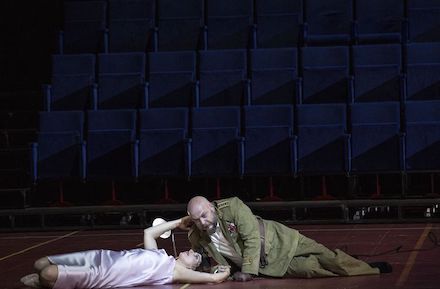
Macbeth himself was played by Belarusian baritone Vladislav Sulimsky who oozed power and ambition, physically and vocally, making his emotional and physical disintegration the more appalling. Lady Macbeth was played by Asmik Grigorian, a singer of immense vocal accomplishment that she normally displays in her famed Strauss roles, now brought to bear on Lady Macbeth. Her crystalline tones exposed the strength and determination of Lady Macbeth, and her brazen showmanship, while Mme. Grigorian’s immense histrionic skills made her madness remote, and quietly affecting, hardly the dramatic focus of the opera. It was strangely touching when she caressed the head of her emotionally destroyed husband.
Verdi famously wished for a Lady Macbeth without a beautiful voice. In Salzburg just now, however, it was in fact a quite beautiful voice. But it is a voice that is now accepted to portray the neurotic heroines in the slavic and germanic repertory, of which there are few in the Italian repertory. Mme. Grigorian is not an Italianate singer.
Conductor Philippe Jordan had no trouble coaxing the Vienna Philharmonic into finding the ugliness Verdi was intent on inserting into his score. In keeping with the Warlikowski/Szczęśniak vision the maestro held the orchestra at intense volume and in maximum excitement, with a bombastic sharpness of tone.
The savior of Scotland in this eleventh century bit of history according to Shakespeare (a bit changed by Verdi and now enriched by Warlikowski), is Macduff who leads Duncan’s son Malcom’s armies to victory.
The oppressed people exposed on the information screens of the production’s waiting room were middle eastern nursing mothers, living primitively in caves with their husbands and children — maybe this was some gratuitous Israeli/Palestinian commentary. The hundred or so singers of the Concert Choir of the Vienna State Opera Chorus appeared in concert blacks on the side stage aprons to lament their oppression and demand deliverance.
American tenor Jonathan Tetelman sang the heroic Macduff with the exaggerated voice he probably generates for Cavaradossi’s big moments, though there were some very beautifully sung and felt moments in his Act IV “Ah, la paterna mano” in which he lamented the death of his children in rich, tenor tones.
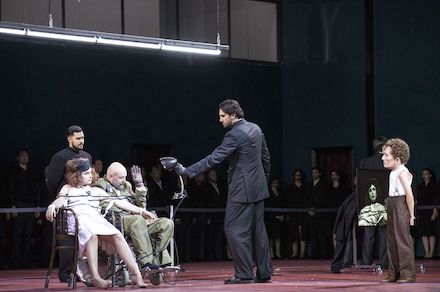
Lady Macbeth and Macbeth in the final moments of the opera with servant (Grisha Martirosyan)
and child with Banquo head
American tenor Evan Leroy Johnson sang Malcolm, Kuwaiti born, German raised bass Tareq Nazmi sang Banquo, both roles delivered with plenty of artistic heft. Mezzo soprano Caterina Piva sang the brief role of Lady Macbeth’s chambermaid. Two young boys had brief singing roles during Macbeths hallucinations. Not identified by name they were from the Saint Florian’s Boys’ Choir that has existed since 1071.
Additional production credits include Felice Ross, the usual Warlikowski lighting designer, with the videos credited to Denis Guéguin and Kamal Palak, also long time collaborators. Claude Bardouil has long been associated with Warlikowski as his movement director and choreographer.
Grosses Festspielhaus, Salzburg, Austria, August 23 and 24, 2023
The Greek Passion in Salzburg
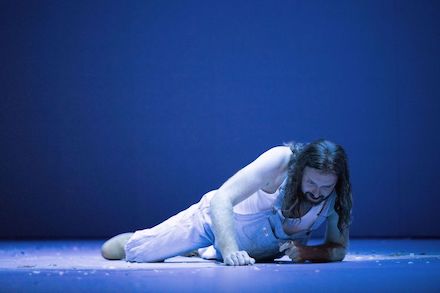
Czech composer Bohuslav Martinů was a WWII refugee to the U.S. who returned to Europe (Switzerland) in his last years (d. 1959) where he turned Greek novelist Nikos Kazantzakis’ Christ Recrucified (1948) into an opera (Kazantzakis is the author of Zorba the Greek).
In recent years the Salzburg Festival has embarked on a quest to recognize significant operatic works from the mid years of the 20th century. With the added edge of producing them in the paddock of Salzburg Castle’s old riding school, now a huge platform in front of which sits an orchestra, usually, and in this case as well, the Vienna Philharmonic. It has become the world’s most exciting opera stage.
Just now it has also become one of the world’s most interesting forums for the discussion of the European and American immigrant crises.
If we leave aside the intricacies of sophisticated mid-twentieth century musical style, Martinů’s The Greek Passion is a very simple opera. A band of desperate immigrants arrive in a village, seeking help. They are met with hostility, except by one man and one woman (a Christ figure and a Mary Magdalene figure). The village authority, the priest Grigoris, stokes the villager’s fear of “the other,” insisting that compassion be ignored, that its preachers be stopped. The townsfolk, in turn, crucify the Christ figure.
Entering the Feldenreitschule (the old riding school) there was but the huge, blank stage, the galleries of the riding school completely covered. It was quite unlike all recent Simon Stone productions (Aix, Paris and Salzburg) where there has been a stage of highly detailed architectural realism. This barren, minimalism was the work of British designer Lizzie Clachan. Though it was not barren for long. With the arrival of the multitude of townsfolk (countless choristers) onto the platform bells rang to celebrate Easter, and petals rained down, covering the stage, only to soon be cleaned up, swept into a large square that opened on the floor.
It was not long until the multitude of refugees (countless choristers and children) arrived, unlike the mono-colored townsfolk, they were individually dressed, dragging their colorful survival gear with them. Costuming was designed by frequent Simon Stone collaborator Mel Page, with the intention of abstracting the rigidity of attitude of the townsfolk into a single pale shade, contrasting to the mutable colors of the needs of the refugees. The townsfolk soon threw all these survival possessions into the same square hole in the floor that the petals were swept into.
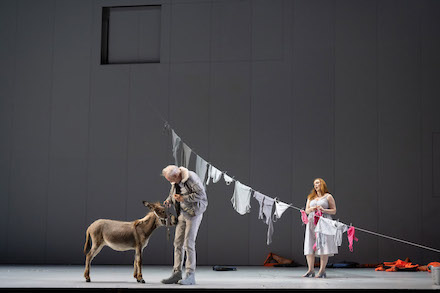
Charles Workman as Yannakos, Sara Jakubiak as Katerina.
Of course there were villagers who sympathized with the refugees, not surprisingly those chosen to be the actors of the village’s annual Easter passion play. As well there were philosophical tensions to be resolved. Manolios (Christ) and Katerina (Mary Magdalene) came to grips with their worldly desires. This they did to dramatic scenic effects — a fountain of water fell from the heavens (the theater’s fly loft), jets of steam spewed up through the stage floor). An old villager, Yannakos, came to grips with human greed while leading a real burro across the stage [though the burro refused to leave the stage and had to be pushed off].
It was a compelling, focused, tightly wrought, excellent libretto, made from the Kazantakis novel by the composer himself.
It is exciting music, here conducted by Maxine Pascal of Frances famed contemporary music ensemble Le Balcon, the Vienna Philharmonique conquering Martinů’s constant use of syncopated rhythm with full throated ease. The orchestra was urged to massive climaxes with the choral multitudes through the heroic embodiment of such complexity by the maestro — Mo. Pascal was indeed a significant added visual attraction to what was happening on the stage. [Conducting the highly syncopated music may have required such physical exertions.]
Composer Martinů’s score makes use of many twentieth century musical currents, notably folk music (in his case Czech and Moravian and in this case, Greek). Particularly Martinů admired Stravinsky (also living in the U.S.), American jazz and Aaron Copland — Martinů was very present in the American musical world. There is often pleasing consonance within the Martinů sound though he never shirks from descending into harmonic chaos, pre-spectral in effect.
German tenor Sebastian Kohlhepp performed the role of Manolios, Mr. Kohlhepp well met its Mozartian vocal demands, and enacted both spiritual confusion and spirituality with equal sensitivity. Stage director Simon Stone played upon this sensitivity to stage a very brutal “crucifixion” — a swarm of villagers fell upon him with their knives, though one sprang from the pile, Paneas, who had refused to play Judas in the village’s passion play. He knelt, facing away from the Christ (see photo below).
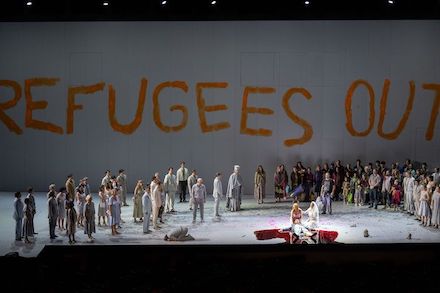
Manolios was left lying center stage, his blood slowly spreading into a cruciform pool, his head cradled by Katerina, the Mary Magdalene, joined then by his spurned fiancée Lenio [sic], to make a emotionally shattering final tableau. With the Judas figure nearby it achieved genuine, classical pieta status.
There were many interesting and significant voices among the villagers and refugees. Foremost certainly was the Katerina, sung by American soprano Sara Jakubiak who brought strongly voiced strength of tone to the complex psychologies of the Mary Magdalene role. The warm voice and presence of Polish baritone Lukasz Goliński cast as Fotis, priest and leader of the refugees, played heavily on our sympathies. Hungarian bass Gábor Bretz made the anti-refugee case with stern, evangelistic conviction.
German soprano Christina Gnash brought a beautiful, silvery bright voice to Lenio, Manolios’ spurned fiancée, confusing our sympathies. Venerable Arkansas (U.S.) born tenor Charles Workman enacted the character role of Yannakos, humoring his burro with palpable affection.
In 2017 Simon Stone staged the Reimann Lear on this same stage, and in much the same style. The directness of his minimalist style is far more effective/affective than the cinematic realism of his recent opera productions, including the Saariaho Innocence that started at the Aix Festival and is traveling to many of the world’s major stages.
Additional casting: Adonis: Matteo Ivan Rasic; Michelis: Matthäus Schmidlechner; Kostandis: Alejandro Balinas Vieites; Panais: Julian Hubbard; Nikolio: Alijoscha Lennert; Eine Frau: Helena Rasker; Patriarcheas: Luke Stoker; Ladas: Robert Dölle; Ein Mann: Scott Wilde; Despinio: Teona Todua; Villagers and Refugees: The concert Choir of the Vienna State Opera with the Children’s Choir of the Salzburg Festival.
Felsenreitschule, Salzburg, August 22, 2023. All The Greek Passion photos copyright Monika Rittershaus, courtesy of the Salzburg Festival.
Parsifal in Bayreuth
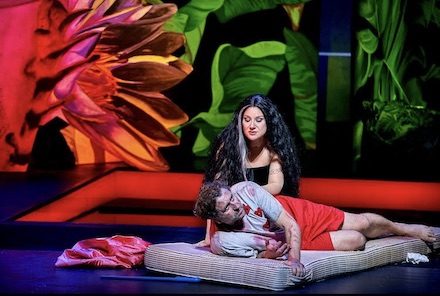
There are intractable conventions at Bayreuth. There are no supertitles. Parsifal is done every year (though it was not during WWII due to ideological incompatibility). There is no applause after the first act — except we did anyway.
Here’s more news of the new, 2023 Parsifal.
Spanish conductor Pablo Heras-Casado imposed an atmosphere of ethereal mysticism that took us into the very soul of Wagner’s Bayreuth Festspielhaus, for which the work was composed (and where the Wagner heirs sequestered it for many years). Though the Festspielhaus orchestra is hidden it has a huge presence in the hall, and the acoustic is magical. The maestro captured both the majesty and the intimacy of the famed sound.
He achieved massive volumes when the Act I grail was unveiled, yet the solo oboe of Amfortas’ Act III death plea was huge in its intimacy. The maestro found an animal energy in the Act II pleasure garden, and then elevated the Parsifal Kundry confrontation — desire versus renunciation — to a heroic collision of colossal forces.
The monologues were very carefully paced, the words given ample time to sound, the phrases to unfold musically, the orchestral motives to sing out, the orchestral tensions to find celestial release. The tempos were quite deliberate until the underlying musical forces took flight and the Wagner’s text became pure, musical poetry.
Note that Pablo Heras-Casado trained as an actor before turning to music.
Be it Catholic, Schopenhaurian, Nietzscheian in intent, the performance was the undeniable Wagnerian musical experience of release, and finally deliverance.
The production was that of American stage director Jay Scheib, who previously had sought dragons he imagined might be lurking in the corridors of the Bayreuth Festspielhaus in a theater piece he created called Sei Siegfried. He was experimenting with artificial reality, known as AR as opposed to virtual reality, or VR. Evidently Sei Siegfried got him the Parsifal job.
AR is quite like the short-lived fad of 3-D movies in the 1950’s. Only now the 3-D glasses are attached to a digital feed that allows the space between you and the stage — that you can see, visually compromised — to be filled with floating rattlesnakes, skulls, trees, plastic bits that resemble blood, more trees, etc., etc., that flow and/or soar in real time to the music. Yes, it was as bad as it sounds, with the bonus of the glasses becoming quite hot.
The production was everything a swanky American production could be. The AR and video were created by Joshua Higgason who teaches interactive technologies at prestigious MIT (Massachusetts Institute of Technology) where Mr. Scheib teaches as well. The scenery was designed by Mimi Lien, recipient of a MacArthur Award (the US’s so-called “genius” awards). Thus it was all so very intellectually hip (cool).
That of course does not deprive it of sensitivity and merit. Like all artistic monuments Parsifal assumes different meanings for every generation. In the final moments of the Scheib telling of the Wagner masterpiece Parsifal holds the finally revealed grail on high, then drops it. It shatters, spilling the blood. He then lays the holy spear across its broken bits and steps into the purifying waters of Amfortas’ Act I lake, followed by the now freed-from-sin Kundry. The Parsifal and Kundry doubles (nearly always present, though never obtrusive) now stand together at the lake’s edge, but a step away from redemption.
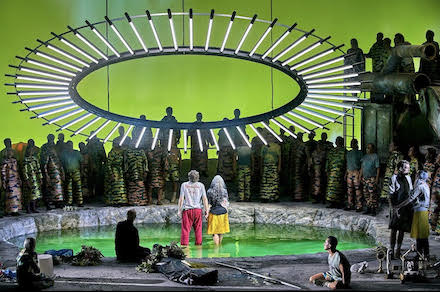 Parsifal and Kundry in lake, Parsifal and Kundry double extreme right
Parsifal and Kundry in lake, Parsifal and Kundry double extreme right
A conclusion richly endowed, poetically and intellectually.
The singers’ performances were powerful, the orchestra overwhelming, the AR an obtrusive presence, thus I abandoned the AR in Gurnemanz’ Act I soliloquy. A critic from a French opera magazine sitting next to me braved the AR through until the third act, with tales to tell.
Set designer Mimi Lien often collaborated with Mr. Higgason’s video, allowing huge, real time images of characters supine on the stage apron to appear hugely enlarged on her neutral backdrop — not ineffective. She provided him with two smaller screens onto which the real time faces of the Parsifal Kundry confrontation appeared close up, adding effective intensity. Mlle. Lien’s design sense was more evident in the vivid floral slashes she created for Klingsor’s garden, and in the ruined, rusty post-industrial contraption she created to be Gurnemanz’ Act III hut.
Chic German collaborators completed the production team. Costume designer Meentje Nielsen had worked with Jay Scheib for his 2017 theater piece Bat Out of Hell. At first she clad the Parsifal grail knights in abstract yellow skirts, though some knights were in camouflage garb from time to time (as warriors). As the knightly order declined over the centuries some arrived in contemporary street clothes. Kundry took on the yellow skirt for her redemption. The flower maidens were abstractly and elaborately decorated in lurid colors and breast plates.
The costumes, like the sets and video added obvious, intrusive commentary into the storytelling.
The lighting designer was Rainer Casper, a frequent collaborator of Frank Castorf (reference the infamous 2013 Bayreuth Ring) who somehow managed good and proper atmospheric lighting without interfering with the clarity of Mr. Higgason’s extensive video displays.
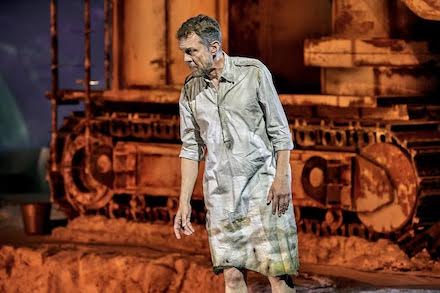 Georg Zeppenfeld as Gurnemanz, Act III
Georg Zeppenfeld as Gurnemanz, Act III
The singers were heroically voiced to a man. Gurnemanz was sung by German bass Georg Zeppenfeld who endowed the venerable, old knight with a great dignity, expounding the brotherhood’s mysteries in a voice that often melted into a celestial beauty. Australian bass Derek Walton’s voice is of a brilliantly black tone, rendering the sufferings of Amfortas into tortured expressions of hopelessness.
Austrian helden tenor Andreas Schafer as Parsifal is of heroic voice indeed, finding a super human strength of voice and figure to persevere in his quest to redeem mankind. He was not a Christ figure, he was Hercules! Moscow born mezzo soprano Ekaterina Gubanova rose to new vocal and dramatic heights as Kundry, having only very recently added this complex personage to her roles. She met Parsifal’s strength with equal force, never sacrificing a super-human dignity even in her repentance. (See lead photo — Parsifal and Kundry in Act II).
Hawaiian baritone Jordan Shanahan embodied Klingsor with appropriate vocal brutality. Titurel, sung by German bass Tobias Kehrer, was appropriately d’outre-tombe.
Additional casting: Flower Maidens: Evelin Novak, Camille Schnoor, Margaret Plummer, Julia Grüter, Betsy Horne, Marie Henriette Reinhold; Knappe: Betsy Horne, Margaret Plummer, Jorge Rodriguez-Norton, Garrie Davislim; Gralsritter: Siyabonga Maqungo, Jens-Erik Aasbo.
Bayreuth, Germany, August 19, 20223. All photos copyright Enrico Nawrath, courtesy of the Bayreuth Festival
Nabucco in Verona
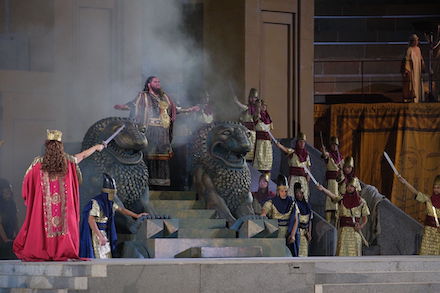
The Arena di Verona has just hosted its 100th year of summer opera. Long ago the Arena had places for 30,000 Romans, now, with one-third of the monumental structure as an immense stage, it can — and often does — seat 15,000 spectators for opera.
Opera in the Arena di Verona is simply one of the wonders of the modern world.
This 2023 festival has seen 44 performances of 8 operas! It began with a new production of Verdi’s Aida by Italian stage director and choreographer/set, costume and lighting designer Stefano Poda (yes, he did it all ), reminding us that the very first opera mounted in the Arena was Aida, and that was in 1913, one hundred ten years ago (war and plague have interrupted continuity). There have been 749 more performances of Aida (though rain did stop 41 of them). Since 1980 each Festival season has included Verdi’s triumphal opera.
Legend has it that Veronese tenor Giovanni Zenatello (Pinkerton at the 1904 Butterfly world premiere) sometime in the early moments of the 20th century belted a few tones in the Arena, revealing its amazing, absolutely uncanny acoustic. Thus the Arena di Verona Aida was born! Veronese architect Ettore Fagiuoli (1884-1961) designed the sets for this first, 1913 Aida, setting a benchmark that has maybe been equaled, hardly surpassed!
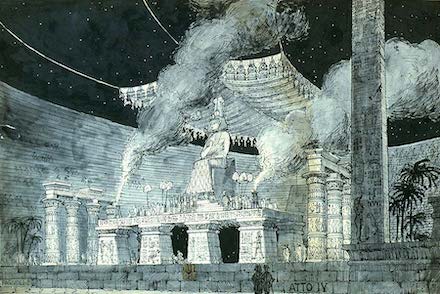 Architect sketch of the 1913 Arena di Verona Aida
Architect sketch of the 1913 Arena di Verona Aida
In 1982 stage director/film director Gianfranco de Bosio (1924-2022) — superintendent of the Opera Festival di Verona from time to time in the 1980’s and 90’s, and set designer/architect Rinaldo Olivieri (1931-1998) — director of scenic installations at the Festival during some of these times, recreated the original 1913 Aida, a production that was last staged at the Arena in 2016.
The 1913 production boasts horses, but none of the usual elephants — Franco Zeffirelli (born in 1923 [!], died in 2019), famed for his lavish productions at the Arena (and elsewhere) famously replaced the horses and elephants of later Arena di Verona times with a ballet in his 2010 Aida.
 La Pyramide in Abidjan, Ivory Coast, by architect Rinaldo Olivieri.
La Pyramide in Abidjan, Ivory Coast, by architect Rinaldo Olivieri.
As a filmmaker Gianfranco de Bosio is remembered for his 1963 Il terrorista, of interest because it lays bare the disparate elements of the Italian antifascist resistance. As an architect Rinaldo Olivieri is remembered for his famed Ivory Coast (Abidjan) brutalist building La Pyramide, now dilapidated and uninhabited. Both men had very distinguished careers at the Arena di Verona.
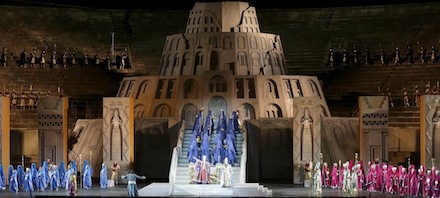 Nabucco, Act III
Nabucco, Act III
Verdi’s Nabucco (1841) established its composer as a major force in Italian opera. In Gianfranco de Bosio and Rinaldo Olivieri’s 1991 production Nabucco has now become the third most produced opera at the Arena di Verona, and this is precisely because Rinaldo Olivieri created a set of such massive dimension that the spectacle of the sets and its transformations are, in a word, absolutely awesome.
The Babylonian captivity attains a truly alive presence in their production (hundreds of Israelis standing and kneeling in front of the Babylonian gardens), making a portrayal of enslavement profoundly felt on an unprecedented scale. Its famed prayer of deliverance, “Va pensiero sull’ali donate” is softly sung, though massive in sound, in a profound stillness that palpably reverberates deeply in the hearts and souls of the 15,000 spectators who always join in for the immediate reprise of the prayer.
The program sheets, and massive annual catalogue of productions, credit the technicians of the theater right along with the Orchestra and Chorus of the Fondazione Arena di Verona. The transformation of the huge set pieces between the acts is a huge part of the show. For the Nabucco there are 20 or 30 set components that go together in very clever ways, seemingly magical as you watch an army of stage hands slowly moving them to new positions, then attaching them. Solomon’s temple, his Palace, the Hanging Gardens of Babylon not so suddenly, but indeed miraculously come together.
A first in my experiences at the Arena di Verona were the bright yellow hard hats atop the stagehands, adding great visual excitement to the set changes.
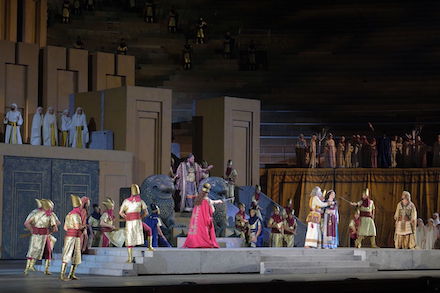 Luca Salsi as Nabucco, to the left of Maria José Sire as Abigaille (center in red), Rafal Siwek as Zaccaria (white), Vasilisa Berzhanskaya as Fenena (blue, and Ricardo Rados as Ismaele (far right).
Luca Salsi as Nabucco, to the left of Maria José Sire as Abigaille (center in red), Rafal Siwek as Zaccaria (white), Vasilisa Berzhanskaya as Fenena (blue, and Ricardo Rados as Ismaele (far right).
Every famous singer of the Italian repertory passes through the Arena di Verona, as does nearly every famous conductor. The musical level is high. Productions are staged so that little or no rehearsal is needed to exchange performers. In Nabucco (the opera I attended) over the four performances that were spaced days and weeks apart there were three different Nabuccos (lead photo is Luca Salsi as Nabucco), some of the other roles were taken for a single night only, and there were last minute substitutions of the originally announced cast.
As well as the star names that pop up throughout the season, there are myriad opportunities for the legions of fine singers who are the backbone of opera throughout the world. The level of singing is usually quite acceptable.
It is a given that some nights at the Arena are better than other nights. The performance I attended (August 17) vocally was not one of the better nights, though there were some fine performances.
Nabucco: Luca Salsi; Ismaele: Riccardo Rados; Zaccaria: Rafal Siwek; Abigaille: Maria José Sire; Fenena: Vasilisa Berzhanskaya. Il Grań Sacerdote: Gianfranco Montresor; Abdallo: Carlo Bosi; Anna: Elisabetta Zizzo. Orchestra, Coro and Tecnici della Fondazione Arena di Verona. Conductor: Alvise Casellati; Stage Director: Gianfranco de Bosio; Scenery: Rinaldo Olivieri.
Arena di Verona, August 17, 2023. Arena di Verona photos copyright EnneviFoto.
Adelaide di Borgogna in Pesaro
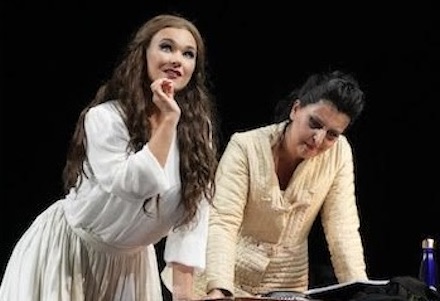
Adelaide di Borgogna was the wife of Lothario, king of Italy, who was assassinated in the year 950 A.D. Rossini set the eponymous dramma per musica by one Giovanni Schmidt for Rome’s Teatro Argentina in 1817. One assumes that this theater’s orchestra was endowed with very skilled wind players as Rossini’s score makes a greatly expanded use of wind colors (horns, piccolos, english horn, clarinet, and trombone) — plus drums, to embellish the obsessions, ambitions, intrigues, battles, seductions, and pageantry of this bit of history according to opera.
The Orchestra Sinfonica Nazionale RAI (Torino) gave a tour de force performance of the Rossini score to the baton of Enrico Lombardi, the assistant to conductor Francesco Lanzillota who was unable to take the podium — he had crashed his motorcycle the day before, breaking a foot and some vertebras.
Meanwhile French stage director Arnaud Bernard had already taken the easy way out by setting his production of the opera as a rehearsal on an empty stage. Though the stage was hardly empty with all sorts of set pieces and props introduced from time to time, as well there was an improvised dressing room for the diva, a director’s table, a rehearsal fortepiano and pianist. The chorus and chorus master entered from time to time, as well as a children’s chorus, not to mention stage technicians, seven principals plus the director and his assistant. Bedlam.
And too, Mr. Bernard staged the overture, setting up some nasty relationships between the principals, in general adding emotional mess to the unfolding rehearsal turmoil.
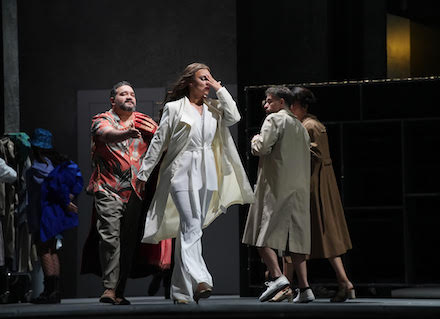 Olga Peretyatko as Adelaide, Varduhi Abrahamyan as Otto the Great with the supernumerary stage director.
Olga Peretyatko as Adelaide, Varduhi Abrahamyan as Otto the Great with the supernumerary stage director.
So, even if the hackneyed metaphor elicited our groans it offered some relief from the tales of medieval power struggles and attendant troubadour-like love affairs. It also sharpened our responses to human situations (the soprano apparently had something going with the tenor, though in the opera tale she abhorred him, and in the end she solved all the Rossini problems by marrying the Holy Roman emperor — a pants role, reminding us that gender fluidity is hardly news for Rossinians).
There were quite a few realities in play. Let’s mention that the tenor was not leading-man- handsome, that the villain’s father, a bass, was leading-man-handsome and younger by far than his son — opera is about voices, fathers are basses, sons are tenors. As well opera is about divas — Russians are divas by nature, therefore famed Russian coloratura soprano Olga Peretyatko was the evening’s diva.
Like Rossini’s score in the pit, there was a massive amount of wit in play on the stage, confusing life with the theater of life, confusing art with artifice, all focused on making a silly old tale a very real human moment.
Showing herself as a consummate comedian, soprano Peretyatko made Rossini and stage director Bernard’s Adelaide a full-scale diva. Divas seem to run the risk of being a bit past their prime, such is the case of Mme. Peretyatko whose mid-voice no longer has its fine focus, though her high voice remains solid. She does indeed know how to make Rossini’s fioratura truly exciting, and how to deliver a big performance.
Armenian mezzo soprano Varduhi Abrahamyan as the Holy Roman emperor Ottone (actually Otto I, “the great”) had stiff competition in the other pants artists of this year’s festival — the famed Daniela Barcellona and the brilliant young mezzo Raffaella Lupinacci. Mme. Abrahamyan brought rich sound and mature travesty art to her role. Stage director Bernard kept Ottone a bit aloof from the fraught energy of his rehearsal, allowing Ottone to bring everything together at the evening’s conclusion when he discards his crown and mantle to embody the true love that has conquered all the adversities.
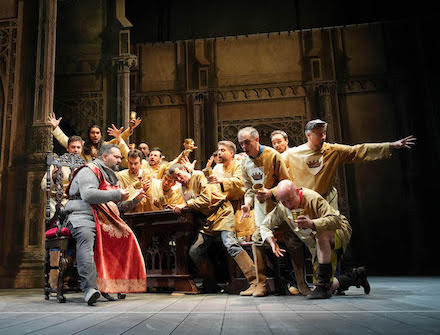 René Barbera as Adelberto, with members of the Teatro Ventidio Basso chorus in a staged scene.
René Barbera as Adelberto, with members of the Teatro Ventidio Basso chorus in a staged scene.
Though without a leading man figure at this mid-career point, tenor René Barbera (from Texas) was in leading man voice. As Adelberto, the son Lothario illegitimate successor, he was however an antagonist, albeit a romantically suffering soul (in the previous version of Adelaide di Borgogna in Pesaro we were rooting for him, as Ottone was a bit of a pathetic figure). But just now Adelberto had to heroically renounce his undying love for Adelaide, and content himself with filial loyalty.
Young bass Riccardo Fassi cut a fine figure as Berengario (the usurper), Adelberto’s father, and, as is basses’ want, sang nicely, in beautiful, youthful voice. Adelberto had a mother as well, Berengario’s wife Eunice who had, early on, made a quick, business like (no drama) entrance into the rehearsal, given that later she saved the day (allowing Adelaide to escape the clutches of Adelberto). Rossini awarded her a brief aria that we dutifully applauded.
The fine chorus of Ascoli Piceno’s Teatro Ventidio Basso (the name of an illustrious local citizen) served as oppressed peoples, present usually in impromptu musical rehearsals at the side of the stage, and especially as rowdy soldiers when Mr. Bernard got around to showing us a couple of actually staged numbers.
When it was all over, last minute conductor Mo. Lombardi gracefully accepted his huge applause for effecting this superb Rossini evening.
All photos copyright Amati Bacciardi, courtesy of the Rossini Opera Festival
Aureliano in Palmira in Pesaro
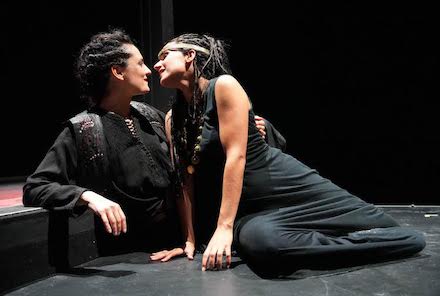
The year is 1813, Rossini is 22 years old. He has had two huge successes in Venice — L’italiana in Algeri, his first big comedy (there were seven smaller ones before), and Tancredi, his first big serious opera (there was two previous smaller ones). But on December 26 his next opera seria, Aureliano in Palmira was a flop at La Scala. [These are reminders for Rossinians.]
The libretto of Aureliano in Palmira is by La Scala’s librettist Felice Romani. This prolific librettist provided the librettos for all three Rossini La Scala commissions [the other two are Il Turco in Italia (1814) and Bianca e Falliero (1819)]. Romani is best known and appreciated for his many librettos for Donizetti and Bellini.
Most Romani librettos were set by multiple composers, though the three Rossini librettos were set only by Rossini. The turco in Italia libretto is dramatically quite complex. The libretto for Aureliano in Palmira is no less complicated, compacting three or more major battles and their motivations and aftermath into two confusing acts.
The Aureliano in Palmira libretto was famously the cause of the failure of the opera. Romani felt the need to defend his work, saying that he was never “discostato un momento dal verosimile” meaning that his story at least always seemed real, or that it could have been real. It was up to Rossini, then, to make it real. The contemporary perception was that he did not, the fault of the singers, said Rossini. But it was a big job — they had to deal with the undying love of the Prince of Persia and the Queen of Syria (lead photo is Raffaella Lupinacci as the Prince and Sara Blanch as the Queen) thwarted again and again by the might of the Roman Empire led by the Emperor Aureliano who lusted relentlessly after the Syrian Queen while never wavering from his military objectives.
It is hard to fault the quality of the music of Aureliano in Palmira because Rossini simply recycled much of it two years later into Il barbiere di Siviglia which was a flop too. But only at first. So Rossini was right, there was nothing wrong with the music.
In 2014 the Rossini Festival entrusted the production of this sprawling opera to director Mario Martone who couldn’t quite fit it onto the stage of the festival’s small, 19th century Teatro Rossini, clumsily spilling a Roman column and a throne out over the orchestra pit. Gratuitously some entrances onto the stage were made through from the audience, plus the chorus was often spread out onto the stage apron and left there, exceeding the boundaries of imagination imposed by the proscenium.
The clumsy staging was compounded by academic conducting, a tenor who did not have Aureliano’s high notes, a soprano who preferred to be a statue, the pants role sung by a mezzo who would have preferred to be somewhere else.
Not having greatly appreciated the performance in 2014, I looked forward to this re-mounting with some trepidation.
But just now Rossini’s second major attempt at opera seria was soundly vindicated! Greek conductor George Petrou, a Baroque specialist, illuminated intense periods of amorous passion, passionate rejection, heart breaking sorrow, vivid denunciation, etc. He securely directed the opera towards a more mature Rossinian opera seria style, though the opera still lacks the magnificent finales of the later Neapolitan tragedies, Rossini contenting himself here with a final trio and chorus (though stage director Martoni did line up his six principals across the front of the stage to make a visual sextet).
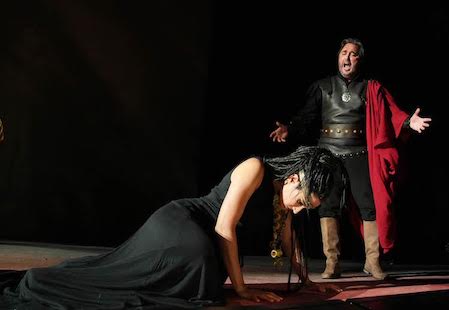 Sara Blanch as Zenobia, Alexey Tatarintsev as Aureliano
Sara Blanch as Zenobia, Alexey Tatarintsev as Aureliano
The Russian general, tenorino Alexey Tatarintsev, now had ringing high C’s aplenty, regaling us as well with a secure high D in a moment of supreme duress. Though amply able to execute Rossini’s complicated ornamental lines he never lost the heroic focus of voice for a Roman general.
Young Spanish soprano Sara Blanch brought tireless, full tone voice to a beautifully enacted Zenobia, Queen of Syria. Young Italian mezzo Raffaella Lupinacci brought fresh mezzo sound to the pants role Arsace, prince of Persia, the two singers creating gorgeous declarations of love, and glorious declarations of fulfillment as only Rossini can conceive and vocally decorate.
The Teatro Rossini is closed for the repair of earthquake damage, thus the production was enlarged to fill the far larger Arena Vitrifrigo theater. Though now missing the Roman artifacts there were still the same filmy panels of various sizes that flew in and out to make mazes, tents, battlefields, palaces, and mountains. Plus there was again an elevated walkway hidden behind the brown backdrop that from time to time revealed soldiers, refugees, etc., trudging to and fro. That was it.
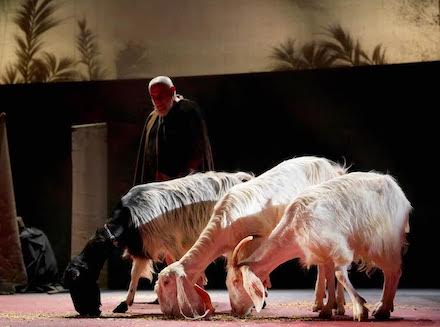
Except for the three live goats that wandered onto the stage during a lovely chorus (though Syria may have been in flames its peasants were rejoicing in the freedom of their fields) — there had been four goats in the much smaller Teatro Rossini.
While Pesaro’s Orchestra Sinfonica G. Rossini and Fano’s Coro del Teatro Della Fortuna (Fano is a small town a few kilometers south of Pesaro) have well served productions in the small Teatro Rossini, neither ensemble has sufficient presence to inhabit the much larger space of the Vitrifrigo Arena theater.
All photos copyright Amati Bacciardi, courtesy of the Rossini Opera Festival
Edoardo e Cristina in Pesaro
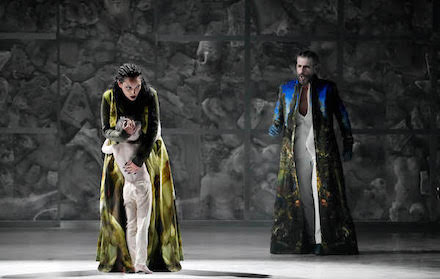
Rossini’s twenty-eighth opera in a new critical edition by the Fondazione Rossini — no actual Rossini autograph exists — in a new production by Italian stage director Stefano Poda.
A superb cast, the famed Daniella Barcellona as the heroic general Eduardo, Anastasia Bartoli as his clandestine wife Cristina, Enea Scala as her neurotic father, Carlo, king of Sweden. Eduardo’s confidant Atlei, sung by Matteo Roma, and Cristina suitor Giacomo, sung by Russian bass Gregory Shkarupa completed the quintet of principals. There were no huge finales with all principals in concert, not to say however that there were not huge, stupendous, climatic finales.
There were however six protagonists counting Gustavo, Cristina and Eduardo’s infant son who had a very physical if non vocal presence. Lead photo is Anastasia Bartoli as Cristina and Enea Scala as Carlo, with child Gustavo, a dancer.
Detroit Symphony (USA) music director (and once a clarinetist at the Rossini Festival), Jader Bignamini brought an appropriate studied elegance to this rare Rossini oeuvre that is but a compendium of the most popular pieces of his recent operas (Ermione, Adelaide di Borgogna, Mosé in Egitto, etc.).
Though reviled in its time the second hand libretto by one T.S.B. [sic], just now in the Stefano Poda production, seemed to be one of the richer Rossini stories, with more focused personages who, at Rossini’s deft hand, deeply felt their predicaments. And who would not? — a father learns his daughter has an illegitimate child, and refuses to accept marriage to a reasonable suitor. Meanwhile the father’s realm has been delivered from the Russians [who else] only to be again threatened (he released captured Russian soldiers in a moment of quite ironic compassionate leniency). His savior, once again, is the father of his grandchild.
Stefano Poda signs the staging and the choreography, and the design as well (scenery, costumes and lighting), a prodigious task that results, obviously, in a totally unified vision. Barcelona’s newspaper La Vanguardia terms Poda’s style to be “Decadentismo Trágico” (Poda has worked extensively in Spain).
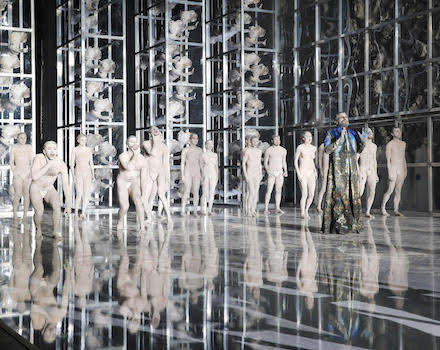
Dancers, with Enea Scala as Carlo, king of Sweden
The setting is at once an abstracted battlefield and a museum of classical sculpture inhabited by eighteen, often naked dancers who are in constant movement as live sculptures. All stage movement is choreographed, the dancers physically enacting Rossini’s kinetic sound sculptures to the voices of his brilliantly clad actors who pose, classically, beside, when not climbing inside abstracted museum display cases, their voices vibrantly embellishing the visual and auditory structures alive on the stage, the chorus melting into the light and dark tones of the surround.
Yes, it was stunningly effective in its excess. Intermission chatter has it that this formula has worked well for Sig. Poda at the Arena di Verona (Aida), at Toulouse’s Théâtre du Capitole (Faust), and elsewhere around the world over the years.
Conductor Bignamini held all this together with a firm hand, building Rossini’s soundscapes with the care and control awarded to bringing new life to proven Rossinian art, relishing in the huge percussion effects unique to this Rossini score (the opera’s initial theater, Venice’s long disappeared San Benedetto, possessed a huge drum that would dramatically illustrate the canons of the final battle).
Torino’s fine Orchestra Sinfonica Nazionale RAI found the high wit and elegance of Rossini’s pizzicato strings in the overture, and the beauty of the clarinet duets with the voices in them arias, rising to graceful, beautifully toned forte’s in the orchestral interludes that gave grand shape to the dynamism of Sig. Poda’s dancers.
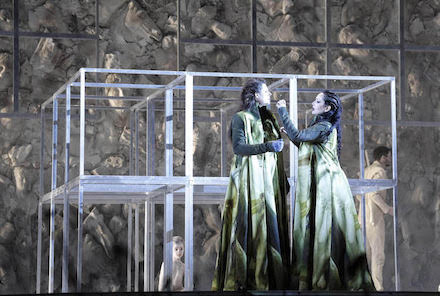
Daniela Barcellona as Eduardo, Anastasia Bartoli as Cristina
Besides the monumental finales, the opera was grounded by the substantial, indeed monumental arias of the protagonists. Carlo, king of Sweden, is in the throes of despair at his daughter’s refusal to reveal the father of her child, her punishment is death, and the death of her child to boot. Tenor Enea Scala achieved a spectacular intensity of frustration in this scene, testing our credulity in such reaction. Though it was all vindicated in the final seconds of the opera when, on the opposite side of the stage from the reunited family (father, mother, son) he strangled his grandchild Gustavo (a double), and cast him to the stage floor as the curtain fell.
Rossini tragic heroines suffer heroically, begging death to quickly come. Cristina, imprisoned, dreams that she is watching the death blow to her child — “Arresta quel colpo!” Awakened, she touchingly laments the imagined deaths of her son and her husband in hushed, broken lines. Soprano Anastasia Bartoli (the daughter of Cecilia Gasdia) possesses a voice of high definition, clear and sharply focused in her refusal to identify Gustavo’s father, silvery in her intimacy with Eduardo, and finally, finding a softer voice, in these tones of resignation.
Eduardo prays to the heavens — “O ciel! prendine cura, salvali” — in the broad and smooth mezzo tones of the travesty military hero, lover and father. Daniela Barcellona, now 54 years old and in excellent voice, brought all of her consummate technique to bear in this fiery, impassioned plea that though he, Eduardo, may die, his wife and child may live. Note that Rossini gave one brief aria to Giacomo (the rejected suitor), dutifully delivered by bass Grigory Shkarupa.
The Rossini genius, manifest in this production, takes us directly to the energies of his protagonists’ suffering, and into the depths of their souls. It takes us to the ultimate expressive achievement of the human voice, and the human intelligence that creates and created such art.
Never mind that all this great music was created for other operas.
All photos copyright Amati Bacciardi, courtesy of the Rossini Opera Festival
Wozzeck at the Aix Festival
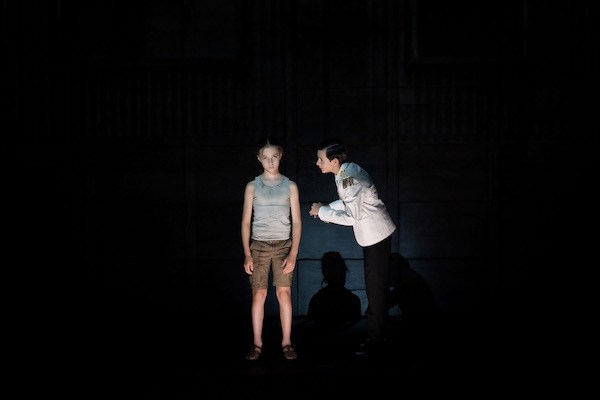
All photos copyright Monika Ritterhaus, courtesy of the Festival d'Aix
Finally! Cancelled in 2003 by a strike, postponed in 2020 by Covid, Alban Berg’s expressionist masterpiece Wozzeck has just been given 5 performances at Aix’s Grand Théâtre de Provence — though the clear skies and brilliant sunshine of Provence made dark, middle European depressive thinking seem irrelevant.
Wozzeck is only the fourth opera ever staged by famed British theater director Simon McBurney, all four at the invitation of Pierre Audi, now head of the Aix Festival — both The Magic Flute and The Rake’s Progress originated in Amsterdam, then traveled to the Aix Festival in 2014 and 2017 respectively. Heart of a Dog, from Amsterdam as well, came to the nearby Opéra de Lyon in 2014.
Famed Canadian designer Michael Levine created the quite brilliant settings for the first three operas.
This McBurney Wozzeck originates in Aix, and will surely travel to theaters around the world. There is however a new designer, German born, London based Miriam Beuther who brings an appropriate darkness to the oppressive bleakness of the Georg Büchner play as deepened by Alban Berg. It was a huge dark brown box in which sat a very small doorframe that moved here and there on a revolving floor. All this minimalism, with copious use of theatrical fog, created the one, single atmosphere for the 15 scenes of the Berg opera.
Wozzeck is a sung play, its words immeshed in a complex musical scheme that invites scrupulous analysis while demanding a fully persuasive actualization. Famed conductor Simon Rattle joined Mr. McBurney to create these Aix performances. Rattle first approached the work in a 1988 production at Los Angeles Opera noted for the passion and clarity of its musical realization. Just now in Aix, 35 years later, he brought Romantic sweep and grandiose gesture to the formidable presence of the London Symphony Orchestra. In his sweep to the famed B natural crescendo that marks Wozzeck’s murder of Marie, Rattle overrode Berg’s careful, precise compositional structures. The monotone B rose to a volume never before achieved in any opera house or concert hall anywhere on earth.
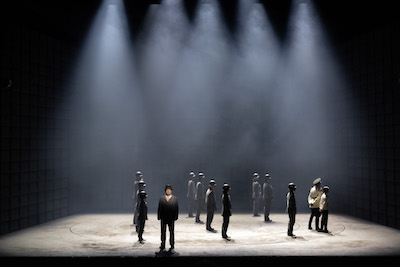
Wozzeck (lighted), the Hauptmann and miniature Hauptmann on right, in white.
McBurney landed on a single gesture to define Wozzeck’s world. The first scene of the opera was no longer Wozzeck shaving the captain, instead it was platoon of soldiers in a strict formation from which Wozzeck had been pulled. The captain jabbed at Wozzeck with his finger while ranting about the private’s moral failures, the captain’s same jabbing motions were echoed by an identically dressed, miniature captain, a boy the same age (9 or so) as Wozzeck’s soon to be revealed bastard son.
In the end, the famous “hop, hop” was sung by the miniature captain boy, jabbing now at Wozzeck’s son who was silently, blankly standing where Wozzeck had silently and blankly stood in the opening scene. See lead photo.
Slick theater indeed.
Wozzeck had been the brunt of the doctor’s tortures, his common law wife’s humiliations, the drum major’s innate prowess and the revelers’ indifference. There was no respite, the captain and the doctor did note that someone was maybe drowning just as Wozzeck was sinking, theatrically, through the floor of the stage. It was the rapid, inexorable and final destiny of a common man.
Berg was nowhere to be found, the famed musical elaborations of the interludes were lost in the a vista musical sweep of the production. The extended, purely musical moments when Berg and the spectator were offered participation were obliterated in the creators’ enthusiasm for making compelling theater.
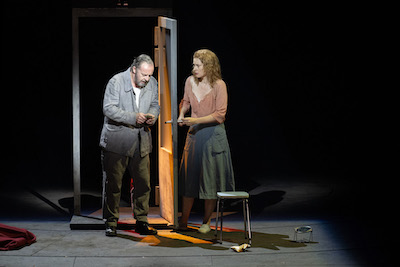
Christian Gerhaher as Wozzeck, Malin Byström as Marie
As is the norm at the Aix Festival the casting perfectly supported the specific musical and theatrical aspirations of this Simon Rattle / Simon McBurney production. Wozzeck was sung by famed German lieder singer Christian Gerhaher, Marie was sung by Swedish soprano Malin Byström, the Hauptmann was sung by Welsh baritone Peter Hoare, the doctor by British bass Brindley Sherratt, the Drum major was sung by Belgian tenor Thomas Blondelle.
Andres was sung by Welsh tenor Robert Louis, a member of the Opera Studio of the Opéra de Lyon. Margret was sung by French mezzo Héloise Mas, the Opéra de Marseille’s recent Carmen. The Estonian Philharmonic Chamber Choir served as the chorus, the Maîtrise des Bouches du Rhône was the children’s chorus.
The complex production required a large number of non-singing roles and a lively on-stage banda to make the second act tavern scenes slickly theatrical. There were, of course, huge video images projected onto the walls of the stage box that were gratuitous. Lighting was designed by Paul Anderson, costumes were designed by Christina Cunningham, both frequent Simon McBurney collaborators, whose brother Gerald served as the Wozzeck dramaturge.
Grand Théâtre de Provence, Aix-en-Provence, France, July 18, 2023
Cosi fan tutte at the Aix Festival
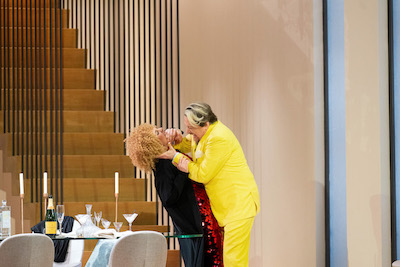
All photos copyright Monika Ritterhaus, courtesy of the Festival d'Aix
The Aix Festival was founded 75 summers ago as an altar to the operas of Wolfgang Amadeus Mozart (in French it is pronounced Mose-art). This year Cosi is up again as the annual sacrificial victim (the 2008 Cosi was staged by an Iranian film director, in 2016 two adolescent Italian girls found themselves in WWII Eritrea [Africa]).
Now, in 2023 it is two couples of advanced middle age who find themselves as guests in a spiffy home of some sort somewhere, though it may be an Airbnb. Be that as it may the hosts are a sadistic couple — Despina spits a mouthful of liquor in Don Alfonso’s face in the silent, sadomasochistic moment that was the performance prologue. Perhaps it was going to be just another of many such evenings. See lead photo.
The production is signed by 53 year-old Russian opera stage director Dmitri Tcherniakov [for the record he lives in Germany and has publicly denounced the Ukraine invasion], who evidently has sought psychotherapeutic help in recent years, therapy that he documented first in his 2017 Aix Festival Carmen production where Carmen was the therapist. Now it is Despina who is the therapist. Of a nastiest sort abetted by an even nastier Don Alfonso.
One can only surmise what Dmitri’s problems may be.
It is of course Tcherniakov’s intention to disorient the Aix audience. He succeeds, with the very significant help of conductor Thomas Hengelbroch and his Balthasar Neumann Orchestra whose period instrument sounds are quite different from the modern symphonic sound we are accustomed to in our Mozart. This old sound is harsher in the strings, more guttural in the winds and less resonate in the percussion. The horns have some difficulty moving from one tone to the next.
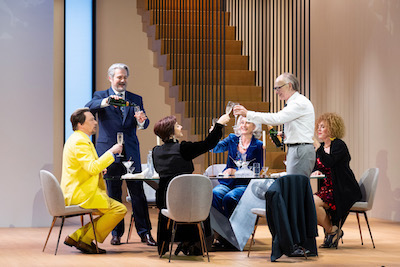
Nonetheless this orchestra has a very polished sound, allowing the maestro to sometimes take tempos that are faster than we are used to, and sometimes encouraging him to take much slower tempos, indulging himself, and us, in these precious, old sounds.
To this add the aged voices in various states of repair of the two couples and we didn’t know where we were, or why, or what we were seeing or hearing. The super titles only confused us more. Though at the same time it was just another, all too familiar Cosi.
The ensemble of singers sat around a dinner table presided over by Don Alfonso at one end in a yellow suit with yellow suspenders he sometimes expansively stretched, musically echoed in the Mozart score, at the other end was the hostess Despina (a housekeeper of some sort) in a sparkling red sequined dress and a fright wig. A lot of liquor was consumed while the guys concocted a parlor game, with the therapeutic goal of arriving at greater self knowledge and awareness.
The gals got a bit drunk, The guys leave, the gals don’t know what to think, Despina goes upstairs. Dorabella sang her “Smanie implacabili” in a wobbly voice, her voice (she sings Salome’s Herodias in Stuttgart), tearing off bits of clothing and jewelry and hurling them around the room, Fiordiligi searches for her spectacles to check her phone, and sings “Dove sono.”
“Soave sia Il vento” found a truly sublime beauty.
A huge, heavy black curtain crashed onto the stage from time to time. Those who couldn’t take it any longer left the theater during these blackouts.
That’s just the beginning. The guys returned, masques went on and off. While the program lists no dramaturge one assumes that somehow the famed Da Ponte libretto was made to make perfect sense. It was beyond my comprehension.
Act II began with a group-therapy session, led by Despina and Don Alfonso, who demonstrated, at last, carnal pleasures. In the best of times Act II is an arduous journey, here the arias were slowly and bravely delivered. It was made quite obvious that the sublimity of the Mozart lyric genius can be fulfilled only by young, supple voices.
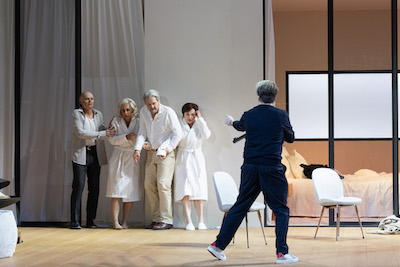
The Act II finale was a splendid display of pacing, the two couples cowering against a wall, in the sights of a shotgun wielded by Don Alfonso, singing their despair in a meltingly beautiful quartet, and finding themselves lying parallel on the floor, center stage, singing the final, strepitoso sextet face down into the floor.
Make no mistake. This was theater on its most sophisticated level, it was music making of the highest order.
The casting of the lovers was exquisite, all veterans of their roles: Swedish soprano Agneta Eichenholz as Fiordiligi, German mezzo-soprano Claudia Mahnke as Dorabella, German tenor Rainer Frost as Ferrando, and Canadian baritone Russel Braun as Guglielmo. Austrian baritone Georg Nigl made Don Alfonso the requisite brash, strident, mean, manipulative. twisted character that director Tcherniakov intended, American soprano Nicole Chevalier made Despina terminally bored, world weary but not too weary to enjoy inflicting additional cruel and mean punishment.
While this Cosi fan tutte was not about singing, it was about music. Conductor Hengelbrock maintained a solid musical concentration for the duration. The six singers, alone on the stage — the Balthasar Neumann Choir did its part from the pit — relished unflinchingly in the brutality of the Tcherniakov concept.
The costumes were designed by Elena Zaytseva, the lighting designed by Gleb Filshtinsky, both with Saint Petersburg origins.
FYI Balthasar Neumann was an architect of great refinement in the German Baroque.
Le Prophèt and Picture a Day Like This at the Aix Festival
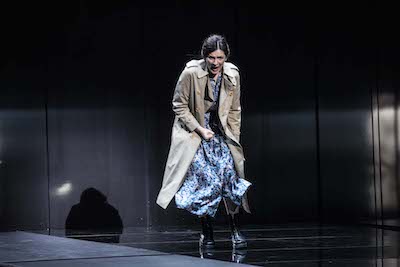
All Picture a Day Like photos copyright Jean-Luis Fernandez, courtesy of the Festival d'Aix
Giacomo Meyerbeer was born near Berlin as Jacob Beer. Early in his professional life he joined his maternal grandfather’s given name, Meyer, to his father’s family name, taking on the “Giacomo” handle during his Italian period. He then moved to Paris to partake of the world’s most intense operatic action.
He is almost the exact contemporary of Gioacchino Rossini.
Though Rossini wrote only one grand opera for Paris (Guillaume Tell, 1829), Meyerbeer wrote four, of which Le Prophète (1849) is the third — Les Huguenots is the second, L’Africaine is the fourth and final grand opera — local lore reports that the Marseille Opéra became engulfed in flames right after a L’Africaine dress rehearsal in 1919.
French author Eugene Scribe created the librettos for all four of the Meyerbeer grand operas. This prolific librettist is famed for establishing a “science des planches,” a libretto style famously decried by Richard Wagner in operas that find effect without cause. More precisely these libretti begin with small, seemingly unimportant events that lead to great musical and scenic effects via gripping, musically pregnant situations.
To wit in Le Prophete: Jean saves Berthe from drowning, and falls in love with her, but gives her up to save his mother, Fidès. Jean becomes the prophet the Anabaptists are searching for, he soon becomes a tyrant, though he is always conflicted. He denounces his mother to hold onto his power. Jean visits his mother in prison who reforms him. Berthe arrives, hating the tyrant. She kills herself. Jean and Fidès set the Münster Castle aflame, incinerating both the Anabaptist and Imperial forces. And themselves.
Not to forget the ballets! There are two: the first is the ice skaters on the frozen pond by the Anabaptist military encampment — they are bringing nourishment to the Anabaptist troops, the second is the crowning of Jean as the Anabaptist sovereign in the Münster cathedral. [The Anabaptists later denounced the Münster massacre and became known as Mennonites.]
Speaking of small causes leading to great effects, Picture a Day Like This British composer George Benjamin’s librettist is Martin Crimp (b. 1956). Mr. Crimp has created the librettos for all four of George Benjamin’s operas, of which the third is Written on Skin, premiered at the Aix Festival in 2012. Mr. Crimp has had a huge presence at the Aix Festival as a dramaturge.
Like the lip service Scribe and Meyerbeer paid to the religious currents of their mid-nineteenth century day, Crimp and Benjamin pay tribute to the hypocritical anti-materialistic sentiments that are floating around in our current, materialistic society, with its emphasis on personal success, not to mention the fear that sexual promiscuity is replacing love itself, and that machines are replacing people.
To wit in Picture a Day Like This: A mother (lead photo) refuses to accept the death of her infant child. Magical women advise her that if she can bring them the button from the sleeve of someone truly happy before the day is over the child will return to life. She approaches a set of lovers, though the male is not faithful; an artisan who makes buttons but is an anachronism and he needs the drugs to die; a composer who is beset by fear of becoming a mere footnote; and then a collector who cannot share.
Finally the frantic mother enters a magical garden with a magical keeper who is, in fact, happy. But she is not real, nor is her garden that is created to grand effect by spectacular video projections onto a succession of screens that simulate a huge depth and plants that magically grow to spectacular, threatening size. The keeper, Zabelle, who has lost absolutely everything important to her, gives the mother a button that shines brightly in her open hand. The end.
“Science des planches” indeed. Note as well the self referential composer scene. The esteemed British newspaper the Guardian dubbed Benjamin’s Written on Skin as only the second best work of the 21st century so far — no wonder the witty footnote about fear.
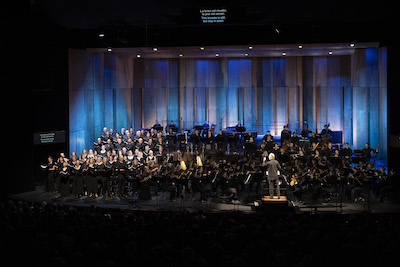
The London Symphony Orchestra and the splendid Opéra de Lyon Chorus
Photo copyright Vincent Beaume, courtesy of the Festival d'Aix
Grand operas are rarely produced. Le Prophète in Aix was given as a one performance concert opera in the 1400 seat Grand Thèâtre de Provence. A full scale production of 4 1/2 hours length with huge chorus scenes, two ballets, a sizable banda (on-stage musicians), a children’s chorus, spectacular scenic effects, an orchestra of triple winds, quadruple brass, two harps, expanded percussion and strings plus six principle singers is not feasible for an opera audience hooked on the more reasonable forces of the Mozart, Wagner and Verdi masterpieces.
The George Benjamin Picture a Day Like This on the other hand is just over an hour in length with a chamber orchestra of 23 players, 5 principal voices (no chorus), an empty stage box of reflective walls and the above mentioned projections. Thus it was fully produced, but in the Festival’s 450 seat Théâtre du Jeu de Paume.
Both operas are works of exceptional musicality. George Benjamin was a student of Olivier Messiaen, thus is some ways he is an acolyte of the French tradition of spectral music (the timbres of sounds are the foreground of music), that he uses in a sort of Webern-like pointillism. There is no harmonic association in the orchestral maelstrom that underlies the text, the timbres of sound colluding in abstract association to achieve a spacial musical meaning (i.e. there are no vertical or horizontal relationships, i.e. intervalic or stepwise).
It is splendid music.
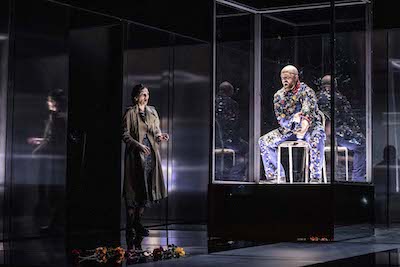
In Picture a Day Like This there was a dramatic exception. The two lovers, in their loving moments, moved in flowing lines, the voices melding together in lovely thirds and sixths — thus the male was written for countertenor, matching the register of the female (as in Baroque opera). As well, when other times a character imparts a mere statement it too can assume an intervalic flow. Otherwise, as in the spectacular vocalism of the emotional meltdown of the mother when she understands that she will not find a happy being on earth, the words connect via sometimes violent intervals, like the tritone (half split octave) and other, always obtuse intervals.
In his early years Giacomo Meyerbeer composed operas in Italian, works that have not found their way into the repertory in spite of premieres in Italy’s major theaters. In the Italian style the melodies would have been the predictable, often soaring cantilena of the time, the smooth, cantabile lines created by Bellini and Donizetti as examples. In the Scribe libretti however the motivations for lyrical expansion become far more complex, even quite tumultuous at times. Meyerbeer responds with larger and longer musical thoughts created by stringing together numerous lyrical fragments that become extended scenes, almost through composed acts, and in the smaller moments as well, as his arias.
Such is the meltdown of Jean’s mother Fidès after Jean refuses to recognize her as his mother. This is her fifth act “Ô prêtres de Baal” where she is tormented by her feelings of love for her son and her hate of his pious tyranny, before she breaks into a Rossini like cavatina “Ô toi qui m’abandonnes” where she forgives him. The melodic fragments are strung together, free form against various woodwind — spectral — timbres, breaking finally into grand chords on the harps. But not before Fidès suffers a melismatic cadenza of pure exasperation (as had her son Jean earlier on). It was not a display of vocal virtuosity à la Rossini, it was singing in full service to emotion.
French grand opera makes great use of the mezzo-soprano voice, reveling in the timbre of the lower female voice to elicit great suffering, tormented by the beautiful, lyric voice of a tenor. The soprano is that of sweetly voiced innocence. In Aix it was a trio of American/American trained singers who triumphed in these three grand opera, tour de force roles.
Pennsylvania born mezzo soprano Elizabeth DeShong is of powerful voice, there is a great depth to her chest tones, urgency in her mid voice and a glowing ease in achieving the upper most reaches of the mezzo register. Moreover she projects a musical intelligence that made her performance as Fidès compellingly real and intensely felt.
Iowa born tenor John Osborn has traversed a career that echoes those of Rossini and Meyerbeer, his initial professional steps in the Rossini roles, moving now in later career to grand opera roles (traversing meanwhile, obviously, Werther and Hoffmann). Appreciated in his performance as Jean was the the clear projection of pianos and pianissimos, greatly enriching the softness and vulnerability of his character, his fortes and fortissimos never losing the beauty of tone that elevated him to the divine status of the prophet.
Armenian born, Houston Opera finished soprano Mané Galoyan brought a dazzling sweetness of tone to Berthe’s character in the expression of love and gratitude she feels for Jean and his mother in the opening scenes, a tonal quality that defined her through her many travails in the opera (a second drowning), and finally her rage at the tyrant Jean leading to her suicide.
All of the opera’s intensely felt suffering was played against almost cardboard antagonists, lightly drawn by Edwin Crossley-Mercer as the willful Count D’Oberthal, tenor Valerio Contaldo as the very demonstrative Anabaptist Jonas (the Count’s previous cellar master), bass James Platt as the Anabaptist Zacharie who argues with the Anabaptist Mathisen, played by bass-baritone Guilhem Worms, then agrees to attack Münster against the wishes of the Prophet. The Anabaptists later decide to sell Jean to the Holy Roman Emperor (unseen). Equally played a bit tongue-in-cheek were the very small roles of the three soldiers, tenor Maxime Melnik, bass baritone Hugo Santos and bass David Sanchez.
As in all concert opera the orchestra assumes far greater relief sitting on the stage than when it resides in a pit. Here is was the London Symphony Orchestra, one of the world’s fine ensembles that succeeded in projecting great joy in realizing this tantalizing score, offering unbridled enthusiasm in depicting the skating ballet and sincere pomp in the coronation. This orchestral effervescence was presided over by distinguished British conductor, Sir Mark Elder, at seventy-six years of age.
In the pit at the Théâtre du Jeu de Paume was the Mahler Chamber Orchestra, an ensemble that has no permanent base but a huge presence in many European cities. In Aix the Benjamin score required 23 of its 45 player contingent. Larger than the pit ensembles that play for the usual Baroque or contemporary operas in this intimate Italian theater, these players had huge presence as solo players colorfully punctuating the happenings on stage in avalanches of sound. The composer himself was at the helm, giving us certainty that the score was performed exactly as he wished it to be.
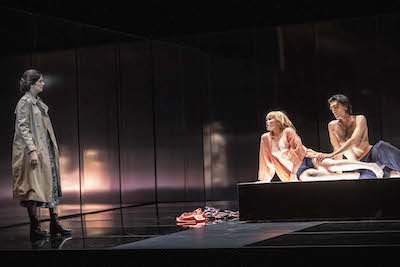
The singers’ performances were astonishing. The mother was played by French mezzo-soprano Marianne Crebassa who commanded the stage for the duration in a tour de force of voice and acting, negotiating the discordant intervals of text delivery with indefatigable and absolute precision. Her disarming musical confidence set the tone for her comrades, especially the brutal confidence of the button maker (above photo) and the beseeching supplications of the collector, roles played by American baritone John Brancy. Norwegian soprano Beate Mordal had the vocal pleasure to sing the beautiful lines of female lover, and the honor to be the ambitious composer, while Canadian countertenor Cameron Shahbazi sang the composer’s efficient assistant and sensuously acted and sang the role of the male lover. Berlin formed soprano Anna Prohaska commanded the virtuoso lines of the garden keeper Zabelle with the required aplomb.
The opera was very effectively staged (designed and directed) by Strasbourg National Théâtre formed Daniel Jeanneteau, in slick and intelligent, Asian influenced minimalist terms. The staging credit was shared with Marseille born Marie-Christine Soma who lighted the production as well as served as its dramaturge. The effective costumes were designed by Marie la Rocca, the garden video was created by Hicham Berrada.
Ballets Russes at the Aix Festival
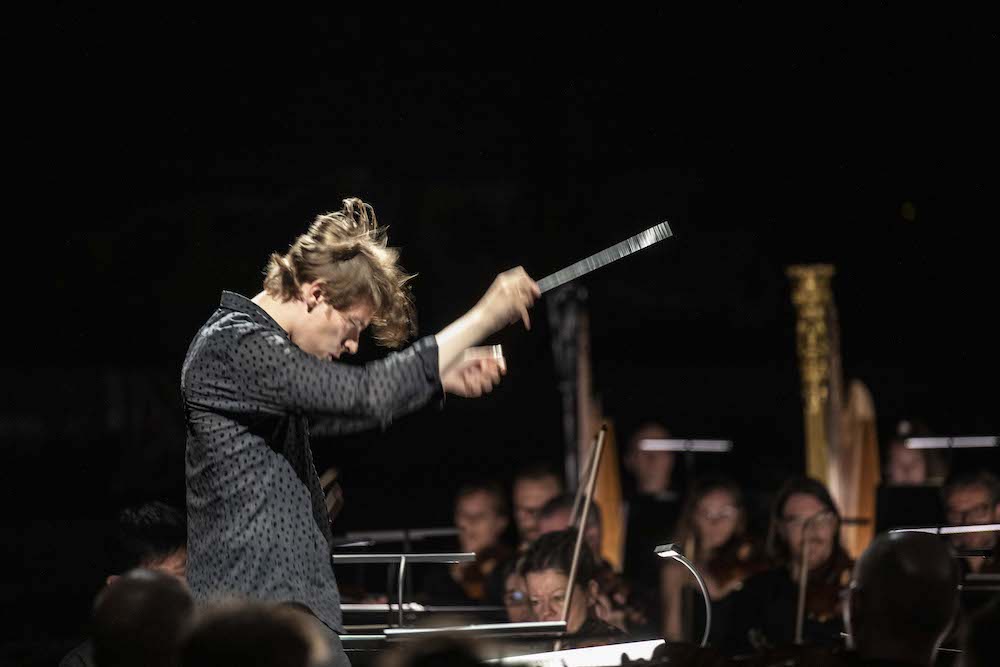
All photos copyright Jean-Luis Fernandez, courtesy of the Festival d'Aix
Not to be confused with Sergei Diaghilev's Ballets Russes or Wassily de Basil’s Ballet Russe de Monte Carlo, it was Igor Stravinsky’s trilogy of ballet scores created for Paris based, Russian choreographer Diaghilev in a concert performance by Klaus Mäkelä and his Orchestre de Paris.
That is but the tip of the iceberg. The concerts (four performances) are at the Aix Festival’s recently purloined venue, the Stadium de Vitrolles, an abandoned, 5000 seat handball stadium sitting, forlornly, atop the residue of a bauxite mine twelve or so miles from Aix. The stadium opened in 1994, suffered in political battles fought with the right wing Front National (FN), and closed definitively four years later, in 1998.
Closed that is until Pierre Audi took on artistic leadership of the Festival d’Aix. Mr. Audi is as well artistic director of New York City’s massive Park Avenue Armory (opened 1880), home of the Seventh New York Militia Regiment, now a space for the alternative arts as well — think huge theatrical installations. Arguably maybe not quite as huge as the Festival’s inaugural use, last year, of the Stadium de Vitrolles for Romeo Castellucci’s monumental staging of Mahler’s Resurrection Symphony — performed as well by the Orchestre de Paris and its chorus, conducted by Esa-Pekka Salonen.
Both maestros are Finnish, Esa-Pekka Salonen debuted at the Los Angeles Philharmonic at age 26, becoming its music director soon after, Klaus Mäkelä became the music director of the Orchestre de Paris in 2022, when he was age 26.
At the Stadium de Vitrolles the audience sits upon a huge, 1000 or so seat bleacher (though the graffiti decorated stadium is a covered concrete block), the orchestra is seated in a huge pit at the base of the bleacher. The space allotted to the orchestra is enormous, the winds and percussion are on rising platforms behind the strings, all of this resting on a huge platform under which are the dressing rooms for the orchestra.
This pit platform acts as a massive sounding board, clearly projecting the smallest sounds into the cavernous space as well as creating full ensemble volumes that reach monumental decibel levels, never losing a clarity and transparency of tone that boasts requisite, never overly obtrusive reverberation. Suffice it to say that the Aix Festival is in possession of an acoustical miracle.
The steep stadium bleacher seating, like sports stadium seating, allows the audience a huge visual field on which the orchestra sits, the three works of the young, Russian Stravinsky — student of Rimsky-Korsakov, steeped in the folklore of his homeland — achieving a visual spectacle that rivals a football match between the Olympique de Marseille and Paris Saint-Germain! Well, sort of, maybe.
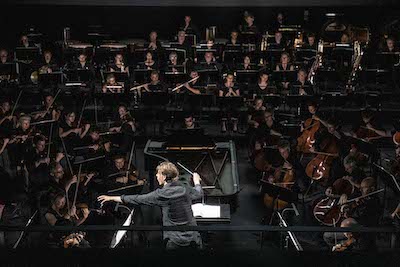
The star of the show was conductor Mäkelä, brightly lighted, who elicited the clean, skillful playing that you expect from one of the world’s great orchestras. That there were any personal insights into these works was lost in the sheer rhythmic power and brilliant colors this maestro drove home in these, by-now, solely concert pieces — even at their premieres they were recognized as stand alone music. The maestro’s tempos were staid, color was paramount, meaning was irrelevant.
The Firebird, Petrushka and The Rite of Spring were here made into polished monuments to twentieth century modernism performed by a prestigious twenty-first century orchestra. While The Firebird requires three harps, celeste, piano, quadruple winds plus Wagner tenor and bass tubas, tympani and a bevy of percussion, and strings (here 16/14/12/10/8), Petrushka requires but two harps, though the role of the piano is greatly expanded. The Rite of Spring requires quintuple winds and brass, though eight horns and two sets of tympani, etc.
That these forces once fit (the second decade of the previous century) into the pits of the Palais Garnier, the Théâtre Chatalet and the Théâtre des Champs-Elysées respectively is indeed a mystery.
The orchestral field of the Stadium de Vitrolles occupied two thirds of the total visual field, the upper third was a movie screen approximately 80 feet wide on which three separate film makers competed with Stravinsky for our attention. All the films held some vague or very vague references to the original story lines of the ballets, but told other oblique, modern dress, sophisticated tales, sometimes with reference to the musical happenings in the pit, but mostly seemingly oblivious to the Stravinsky primal soundscapes.
French film maker Rebecca Zlotowski created The Firebird (L’Oiseau de Feu), a tale of two, early 20th century, same sex couples finding themselves, the final image was the firebird character drinking from a champagne bottle held high. The personae of the story were rendered highly personal by the frequent closeups of their faces, unlike the abstract, folkloristic story telling of the ballets.
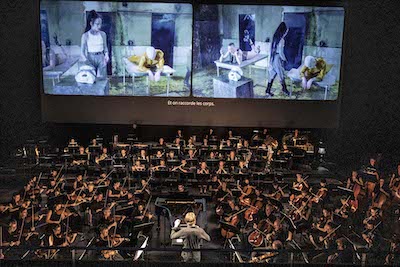
Petrushka film
French film maker Bertrand Mandico created the Petrushka (Petrouchka) film, far more successful than the Firebird film as it abstracted characters, often juxtaposing the same images side by side at slightly offset moments adding some rhythmic complexity. Though Mr. Mandico deployed a war like backstory against which models and mannequins of the 1970’s fashion avant garde moved in cruel ways, there was a definite tongue-in-cheek feeling somewhat relevant to Stravinsky rather whimsical score.
Greek born, French formed filmmaker Evangelia Kranioti created The Rite of Spring. Finding the first two films irrelevant to the orchestral spectacle I allowed my attention to focus entirely on the Stravinsky orchestra and the dynamism of this young conductor, thus I did not watch The Rite of Spring film.
The Orchestre de Paris’ performance of Le Sacre du Printemps was mind blowing in its sonic magnitude, understandable as the catalyst for the most significant (meaningful) riots, possibly, seen in Paris since the French Revolution.
The Three Penny Opera at the Aix Festival
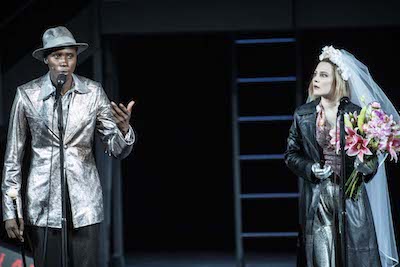
All photos copyright Jean-Luis Fernandez, courtesy of the Festival d'Aix
That’s The Three Penny Opera. While four “sous” wouldn’t get you in the door, the price of admission was far less than the usual offering at this lofty altar to operatic art. And for good reason. It was not opera.
Famously characterized as “the weightiest possible lowbrow opera for highbrows, and the most full-blooded highbrow musical for lowbrows,” this staging by Thomas Ostermeier, artistic director of Berlin’s Schaubühne and very frequent guest director at Paris’ Comédie Française was an unabashed, full-blooded musical, i.e. a string of songs connected by gratuitous text, that paid no attention London’s low life or Berlin’s bourgeoisie — or to the expectations of an actual opera audience — but paid much attention to the art of its actors.
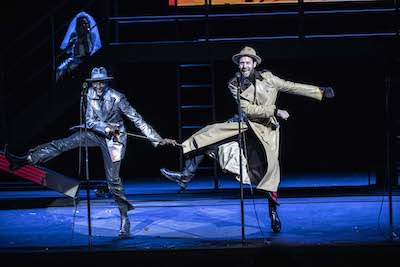
Birane Ba as Mack the Knife, Benjamin Lavernhe as Tiger Brown
It is a joint production of the Comédie Francaise and the Aix Festival, constructed in Paris, performed by the troupe of actors that is the Comédie Française, buttressed by a couple of real opera artistic collaborators — scenography by Magda Willi and lighting by Urs Schönebaum. To be sure the entire artistic staff (costumes, choreography, dramaturgy, video) boasts extensive Berlin credits.
The performance edition was envisioned by Paris’ well known (in contemporary music circles) art collective, Le Balcon, founded in 2008 by a conductor, Maxime Pascal and a sound engineer, Florent Derex, plus some composers and musicians. Le Balcon has had the occasional participation of Alexander Pateau for translations of song lyrics from German to French.
Mr. Pateau has now made this new French translation of Die Dreigroschenoper that, one assumes, was in consultation with Mr. Ostermeier, the dialogue straying significantly from textbook editions of the original Brecht piece, the songs flowing in quite smooth French. One assumes that the four songs famously plagiarized by Brecht from French poet François Villon were rendered in their original French.
Maestro Pascal conducted a pit band of ten players, one assumes in an orchestration made especially for this production. The sounds from the pit were exactly what was needed for the production’s display of choreographed numbers — precise, clean and colorful. The orchestra was highly amplified.
It can be no surprise, then, that the basic scenographic/staging concept was four microphone stands across center stage where all of the characters presented themselves initially, then on and off throughout the uninterrupted, 2 1/2 hour display of their highly amplified voices. Though there was a platform unit that flowed on after the famed "Mack the Knife Ballad" (sung by the actress who was to become Lucy — Mack’s other wife, played by black actress Claïna Clavaron). A large square and a small, sharply pointed triangle flew in over the platform on which were projected ever changing, decorative images more or less companionable with the text.
It was slick minimalism, in support of a humble, cabaret style Berlin nightclub (lots of red light), or a Berlin varieté theater of yore (lots of blue light), though of course on a huge scale to befit the 1500 seat Théâtre de l’Archevêche.
The single musically satisfying moment of the production was Polly’s famed "Pirate Queen Ballad" when, instead of the usual slick and sometimes inane choreography, Polly, sung by actress and chanteuse Marie Oppert, simply sat upstage on a high stool and rendered the ballad, microphone in hand, à la classical cabaret style.
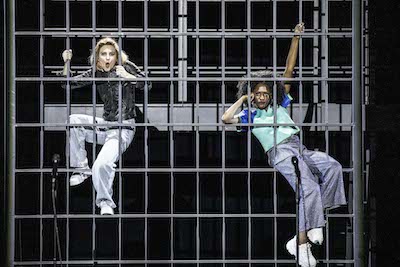
Marie Oppert as Polly, Claïna Clavaron as Lucy in the Jealousy Duet
A parody of opera à la Handel in its original version as The Beggars Opera, this Bertolt Brecht/Kurt Weill 1928 adaptation of the 1728 John Gay piece came one year after Ernst Krenek’s 1927 box office smash hit Jonny Spielt Auf. Krenek's Jonny is a black, happy-go-lucky minstrel type fiddler who becomes entangled in the intrigues of high brow musicians. It is indeed coincidental that Thomas Ostermeier’s Mack the Knife is the black, happy-go-lucky hero of The Three Penny Opera. Happily not in the usual blackface common to the period (and even in France today), in Aix Mack was black Comédie Française actor Birane Ba, costumed in a sleek silver lamé blazer.
It began to rain, rather a few sprinkles were felt during Mack’s final ballad, “Grave Inscription” (it’s an open air theater). I’m sure I wasn’t the only one who wished it had begun to rain, heavily, much earlier in the evening, thus curtailing the performance.
The one, fleetingly felt moment of the evening was created by the prostitute Jenny, played by tall, blond actress Elsa Lapoivre, who lamented that she had turned Mack in to Scotland Yard, and that Mack later had appeared beneath her window wanting to lie in her arms, and make her forget the wrong she had done him.
There were indeed impressive performances by these gifted actors — Mr. and Mrs. Peacham, played by Christian Hecq and Véronique Vella, the Tiger Brown broadly, very broadly played by Benjamin Lavernhe. The deadpan constable Smith was played by Nicolas Lormeau. Mack’s gang had their big moment at Mack and Polly’s wedding, slipping and sliding in the mess of pies they had smashed into each other’s faces, an homage to the slapstick antics of the silent film era.
It must be said that there is no shame in a failed production of The Three Penny Opera, as many great directors have given it their best shot, only to be shot down. It may be enough that this miniature masterpiece of words and music exists solely on paper.
Thèâtre de l'Archevêché, Aix en Provence, July 7, 2023. All photos copyright Jean-Louis Fernandez, courtesy of the Aix Festival.
Hamlet at the Opéra Bastille
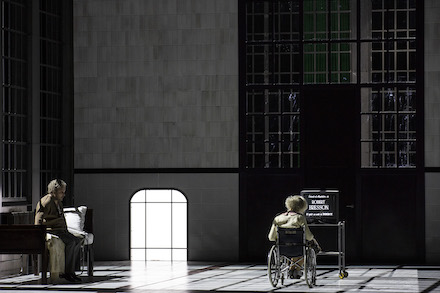
Hamlet with his mother Gertrude
Photo copyright Bernd Uhlig
Versions of Shakespeare’s famed Hamlet have amused Parisian audiences for 250 years or so, though just now at the Opéra Bastille we were as amused as we were confused. Polish stage director Krzysztof Warlikowski deconstructed Ambroise Thomas’ 1868 grand opera version.
Warlikowski had already placed a much purer, intensely lyric version of the play before French audiences at the Avignon festival in 2001. That was his production for Warsaw’s Nowy Teatr (in Polish) of the play, Hamlet’s haircut a cockscomb, Ophelia’s drowning delivered to a suspended, melting block of ice — unforgettable images.
The grand opera version just now was far more distilled, its actors voicing the words created by the esteemed librettists Jules Barbier and Michel Carré (the creators of Gounod’s Faust and Offenbach’s The Tales of Hoffman) that cast Alexander Dumas père’s French translation / version of the Shakespeare play into the emotive blocks that build an opera.
Warlikowski has again based his grand opera Hamlet on lines from Shakespeare’s Hamlet, telling us that when the cock crows all the night planets do not collide, witches do not charm, fairies do not dance., that night is a wholesome, hallowed time. It is intense dramatic irony that this blatant Warlikowski Oedipal tragedy unfolds within the purified light of such a night.
Grand opera is spectacle, Warlikowski and his wife/designer Malgorzata Szczęsniak use a huge projected black and white moon to overwhelm the old folks home / insane asylum — a huge cage — where the aged Hamlet’s very old, decrepit mother Gertrude sits in front of a black and white TV, Ophelia and her brother Laërte sit, gleefully playing cards with a couple of other inmates.
When Act II begins we are told it is twenty years earlier, then only to be confronted by Hamlet as a troubled young boy many years before that, nervously zapping his red, toy car around the stage, refusing to call his uncle his father. The famed saxophone solo of the Ambrose Thomas’ play within the play is played on the stage, the murder enacted grotesquely by a band of minstrels — though real blacks, not blackface.
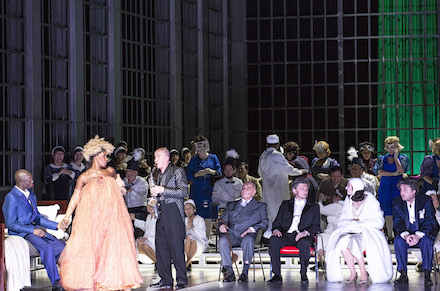
Two of the three actors in the opera's play, Polonius, Claudius, Gertrude, Hamlet (all seated)
Photo copyright Bernd Uhlig
We know that Hamlet’s father was poisoned in his sleep, thus there is always a bed on the stage, where Hamlet attempts to kill his mother, where he attempts to kill Ophelia’s brother Laërte. We know that Ophelia drowned herself, thus there was a bathtub (a powerful French image) into which she immersed herself. We know that grand opera has a ballet to open its fourth act. A single, tutu-ed ballerina — a neurotic, sharp elbowed dying swan — added the sharp sounds of her frantic sous-sus-ing to Thomas’ lovely, delicate ballet, as the famed Shakespearean gravediggers added the sharp clicks of an antique typewriter to their macabre speeches over a corpse (it was not, we soon learned, Warlikowski’s Ophelia).
At the end of the opera, the last note sounded, we were left in silence, confronted again by this huge moon, only this moon in an extended visual fermata. No sound, no story, no song, only the timeless, empty light of the night.
The virtuoso performances of Hamlet by Ludovic Tézier, Ophélie by Lisette Oropesa and the Gertrude by Ève-Maud Hubeaux were the through-line, Aristotelian story tellers amongst the Warlikowski avalanche of images and manipulations of time and history.
Hamlet is a tour de force for baritone, an unrelenting torrent of words for the duration, his only respite Ophelia’s extended mad scene. French baritone Ludovic Tézier is 54 years old, at the height of his career. Though composer Thomas conceived his Hamlet for tenor, casting considerations at that original moment persuaded him to transform the role into baritone. Tézier’s voice is of a pure, bright color, and supple, giving him the youthful, sympathetic tonalities of a Marcello and Posa, with the power and stamina to sustain Hamlet’s ruminations, ravings and explosions. A consummate singing actor Tézier traversed the aged Hamlet, the child and the adolescent, the drunk — “Ô vin, dissipe la tristesse qui pése sur mon cœur!”, the philosopher — “Être ou ne pas être”, and the bitter, repentant lover — “Comme une pâle fleur", with maximal tenorial aplomb.
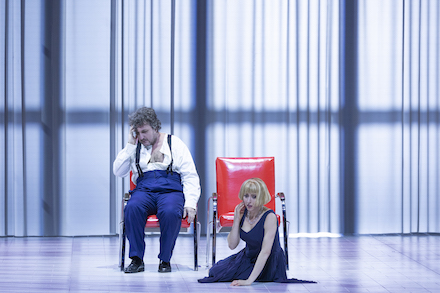
Hamlet has told Ophelia he does not love her
Photo copyright Elisa Haberer
Ophelia’s complex mad scene is a welcome island of repose amidst the agonies of marital betrayal, fratricide, and Oedipal vengeance. Warlikowski’s Ophelia presents herself as a ghostly, flighty nocturnal creature, simply dressed with a very plain wig of blond hair describing the wasted life that she foretells in her splendid second act aria "Adieu, dit-il, ayez-foi!”. Thomas’ Ophélie was beautifully sung, and acted with uncanny poise by American soprano Lisette Oropesa. Mme. Oropesa’s upper voice shone magnificently throughout the evening, and of course particularly in the intricacies of the mad scene. For this famed episode her plain blond wig was changed into a splendid, platinum Cleopatra like wig, and among its myriad sections she danced a waltz with a sharply elegant, black clad danseur.
Hamlet’s mother Gertrude, French mezzo soprano Ève-Maud Hubeaux, cuts an imposing figure, her initial appearance as an aged, wheelchair bound crone morphed into the towering, colorful complexities of a an adultress, a widow, a queen and a mother, complete with a headdress that recalled a hen’s plume. Thomas’ Gertrude has one of the opera’s finer arias “Je croyais près de vous trouver mon fils” (Act II), though she mostly shares hugely tense scenes with both Ophelia and Hamlet in a richly focused voice that was both frightened and confident, then demanding and suppliant. Her husband, Hamlet’s uncle Claudius, sung by fine French bass Jean Teitgen revealed his guilt and remorse for his murder of Hamlet’s father in his one aria, “Je t'implore, ô mon frère!”. If forgiven he would be in a state of grace, I.e. saved from his damnation, thus Hamlet knows he must be killed in a drunken state, the final scene.
At the appropriate moments these dark machinations are recorded by a tall man knitting at the side of the stage, recalling as well the women who knitted tranquilly while watching the executions during the French Revolution. At the end the demented Hamlet appears, white faced, like the moon, as well the black players reappear, now in white face. Ophelia dressed in the white of her madness lies dead on the stage apron. And then there was only the moon.
No stranger to history’s great tragedies, Warlikowski staged a famed Elektra at the Salzburg Festival, where this summer he stages Verdi’s Macbeth.
The brilliance of the production and the excellence of the performances elevated the musical importance of the Thomas Hamlet score. Young French conductor Pierre Dumoussaud brought quite magnificent life to this difficult opera, where recitative, arioso and aria flow into one musical, rarely interrupted continuum. He gave a charged emphasis to the massive grand opera off-stage brass choirs and the massive on-stage choruses that composer Thomas imposed onto the pseudo profundities of the narrative.
The supporting roles were appropriately cast, notably the spectre of the dead king, darkly intoned by British bass Clive Baylee and Ophelia’s brother Laërte, brightly intoned by French tenor Julien Behr. Horatio and Marcellus were enacted by Frédéric Caton and Julien Henric, the gravediggers by Alejandro Baliñas Vieites and Maciej Kwasnikowski, and the brief Polonius (father of Ophelia’s and Laërte) intervention by Philippe Rouillon.
Krzysztof Warlikowski’s creative team includes Malgorzata Szczęsniak for the costumes and architecture, Felice Ross for the sophisticated lighting requirements, Claude Bardouil for choreography and movement, and Denis Guéguin for Warlikowski’s increasing use of video for huge visual effects.
Opéra Bastille, Paris, France, March 21, 2023. All photos courtesy of the Opéra national de Paris.
Tristan et Isolde in Toulouse
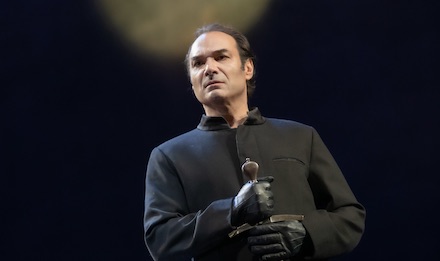
Well beyond all Tristan basics the Opéra de Toulouse boasted two ravishing singers and an electrifying conductor in this revival of its excellent 2007 Nicolas Joël production.
Austrian tenor Nikolai Schukoff and French mezzo soprano Sophie Koch, both in their role debuts, brought radical physical presence to Tristan and Isolde, a presence that amplified the power of the words they spoke. Wagner’s poem of the doomed medieval lovers thus assumed vibrant new colors that were passionately extolled by German conductor Frank Beermann in an equally radical approach to the orchestral realization of Wagner’s poem.
The Joel production reads the poem as an intense dramatic action, Brangäne is a powerful player, who alternates with Isolde's raging on the tip of the stage floor that juts out over the Theatre du Capitole’s orchestra pit to boldly rationalize Tristan’s gift of Isolde to Marke. Enacted by French mezzo soprano Anaïk Morel (a sometime Carmen), she is of powerful voice, embodying both maternal power and its blind love. Her second act warnings are anxious interventions, her third act confession is conspicuously contrite.
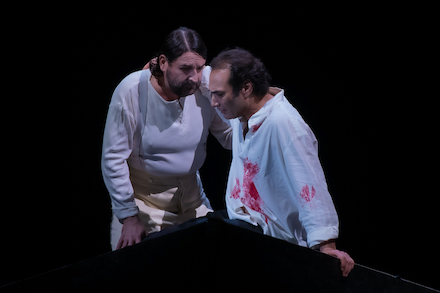
Pierre-Yves Pruvot as Kurvenal, Nikolai Schukoff as Tristan
Kurvenal, sung by French baritone Pierre-Yves Pruvot (a sometime Iago), is Tristan’s sharp voiced, high spirited squire who sets off the fireworks of the tense first act Isolde Tristan confrontation. He anxiously hovers over Tristan in the third act, negotiating forcefully with the brusque, on-stage shepherd as to the tones of the shepherd’s pipe, comforting the distraught Tristan with touching, almost paternal intimacy.
The Joel telling of the poem interchanges these very realistic physical intimacies with highly choreographed action movement, and with symbolic statements — Morold has been killed by sword, Isolde’s revenge is by sword, the act two lantern is a lighted sword, Merlot wounds Tristan by sword, Kurvenal kills Merlot by sword and dies by self inflicted sword. These swords, symbolizing both love and death, are abstractly present and highly dramatic, though they are only presented, never used.
Marke, sung by venerable German baritone Matthias Goerne (once a Kurvenal himself), expounded his second act distress as an intimate, riveting art song. Significantly he was not on the tip of the thrusting stage floor for this magisterial delivery, but up-stage from where he could alternately gaze at both Tristan and Isolde, now far apart downstage, creating the tragic triangle of love, loyalty and betrayal.
Conductor Beermann established the poem’s inexorable day/night, love/death tension from the first moments of Wagner’s famed overture, urging the disturbing harmonies, and the astringent oboe tones to clash with the warmth of the clarinet, and the lushness of the strings. His tempos allowed the words ample space, all tensions created in the tonal relationships. The orchestra of the Theatre du Capitole was to become a major player in the exposition of Wagner’s poem, its myriad Wagnerian colors completely unveiled in the clarity of this theater’s famed acoustic. If the on-stage performances were vivid, the pit was equally vivid.
The leitmotifs rang out to reinforce the poem’s themes, and the fortes were gigantic in the delirium of the recognitions of the fateful love on stage, Tristan and Isolde finding levels of volume only made possible by a love so towering and tortured that it was impossible. The performances by Schukoff and Koch were over the top, Mme. Koch finding mighty tones to express her fury at Tristan, surmounting the extremes of the dramatic soprano range with complete confidence, Mr. Schukoff never losing the colored, clarion timbre and control of his voice even in the moments of surpassing ecstasy.
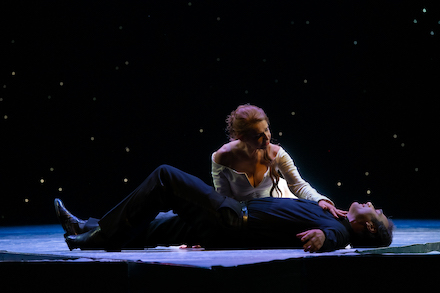
Consumate actors, Mme. Koch found the carelessness of blind love at the beginning of the second act, equaled by Mr. Schukoff when he arrived for the tryst. A scene of tender, physical intimacy ensued with a disarming naturalness. As their declarations became evermore impassioned they were, however, driven apart dramatically to voice individually the sublime raptures of love. Thus apart they were positioned at the moment of climax, but it was the entrance of Mark, not the consumption of love.
The third act began with the stage shrouded by a black drape, disappearing to reveal the wounded Tristan hanging dangerously over the platform that thrust over the pit. When the shepherd’s piping began it was from the heights of the balconies, the piping sounds continued even after the initial solo, this plaintive voice accompanying Tristan’s extended confession from a vast, abstract distance. It was an amazing and powerful acoustical coup de théâtre.
Tristan’s delirium was portrayed in very intimate terms, its tortures wrenchingly enacted by Mr. Schukoff, its climaxes were ecstatic visions indeed. The Tristan death is not a huge musical moment, but a quiet passage. When Isolde recognized that he was no longer of this world, she knelt behind his body where she too found passage to the place, death, of eternal love. Mme. Koch thus assumed a supernatural stillness, though she arose finally to sing her Liebestod, alone on the thrusting tip of the stage. At the final tones of her prayer she froze with outstretched arms, a position she held, transcended, until the curtain fell.
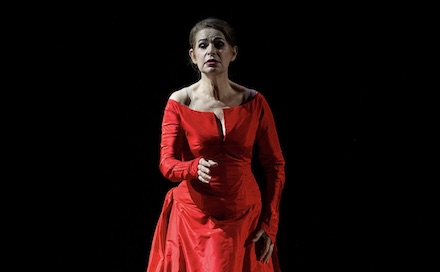
The Nicolas Joel production was designed by Andreas Reinhardt who died in 2007, the year of this production. Mr. Reinhardt came originally from the Berliner Ensemble. His set for the Joel production is nothing more than a floor and a back wall. The floor was sentient, with changing colorations, its three platforms able to change positions, even to move in sympathy with the poem. The back wall was a starry sky for the second act, Venus shining brightly as needed, Mars and other symbolic stars brightening as well from time to time. Mr. Reinhardt’s costumes were in primary shapes and colors, Isolde in a white gown with bright red stockings, though for the Liebestod the white gown transcended into bright red, Tristan in a black, loose fitting shirt that allowed Mr. Schukoff’s virile, heroic physique ample visibility.
Melot was sung by Damien Gasti, tenor Valentin Thill made a big impression as the Shepherd as well as the voice of the sailor that begins the opera. The splendid English horn solos were performed by Gabrielle Zaneboni who took her bows along side the principals.
Fittingly the Orchestre national du Capitole moved in mass from the pit to the stage to take its well earned solo bow.
The program sheet provided by the Opéra national Capitole Toulouse does not provide credits for those who realized this staging of the Nicholas Joël production — Mr. Joël died in 2020. It was a huge accomplishment to integrate these extraordinary artists assembled by the Opéra national Capitole Toulouse into this production, fulfilling, certainly, an ideal that Nicolas Joel may have only imagined.
Théâtre du Capitole, Toulouse, France, March 1, 2023. Photo credit: Mirco Magliocca.
Carmen in Marseille
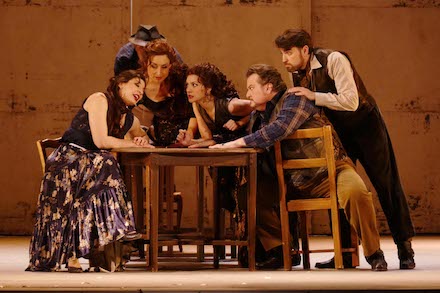
A proven production of real interest, beautifully conducted with an excellent cast just now at the Opéra de Marseille.
This Jean-Louis Grinda production originated at the Opera de Toulouse in 2018, the Carmen was Clémentine Margaine, Jose was the American Charles Castronovo. The production was to move to Marseille in spring 2020 with Georgian mezzo Ketevan Kemoklidze and Jean-François Borras but plague intervened. Brazenly, it did however find its way to Monaco later that same, dark year with Aude Extrémo and Mr. Borras performing. Maskless.
Now, winter 2023, it has arrived finally, maskless, at Marseille’s grand old opera house (the peristyle [the columned classical porch] is from 1787 though the rest is early 20th century). The theater boasts a magnificent acoustic — voices sail across the pit from where pianos and fortes arise in pristine clarity. I mention this because this current Marseille Carmen edition actually boasts an all francophone cast, thus the words of the famed libretto were so very clearly formed and heard that the opera became — almost — a play!
And this was certainly the intent of the Grinda production, every detail of the libretto was articulated by an action on the stage. An unexpected depth to the Bizet score was thereby revealed in its myriad details, the composer’s use of rhythm and color — so famously exploited in Carmen’s arias — judiciously articulated by conductor Victorien Vanoosten at every single moment towards the opera’s brutal, fatal denouement.
Grinda staged the overture. It was a flashback of the murder, the fate theme blared, Jose was then arrested by a soldier who seemed to offer a moment comfort and condolence (it is heard in the music!) before throwing him to the floor.

Pierre-Yves Pruvot as Kurvenal, Nikolai Schukoff as Tristan
The stage box was brick walls with huge warehouse doors at the back and on the sides, there were two small curved rolling walls on the stage floor (maybe abstracted bull horns) that a vista stage hands moved to isolate staging moments (the murder as example) or to reveal the opera’s huge public spaces. These walls did an extended solo dance (no sound from the pit) to open the final act, bullfight crowd noise blaring forth from within the walls, director Grinda’s revenge surely for Bizet’s lovely flute pastorale that opens the preceding act, though staged with huge crates gracefully descending from the fly loft into the warehouse.
Significantly Grinda adds a solo female flamenco dancer to his staging who finds her way into each of the four acts. She is brazen and dangerous, her arms and head moving sharply, her snapping castanets and stamping heels threaten loudly. She is Carmen, the misogynistic femme fatale. Grinda’s intention is surely to free his real Carmen from this burden, allowing her to be very young and very human, to be capricious with her love, to fear death, and to reluctantly challenge her death to her very last breath (it is in the music!).
This was the Carmen of the Marseille edition, Héloise Mas. Mlle. Mas has appeared previously at the Opéra de Marseille as Boulotte in Offenbach’s Barbe-Bleue, and as Pericole in Offenbach’s La Pericole, roles that are a far cry from opera’s most notoriously difficult heroine Carmen. Mlle. Mas brought all the charm of these delightful operetta ingenues to her Carmen, finding as well a sexuality that is more innocent than overtly provocative. Director Grinda staged the third act card trio as a lively Frasquita/Mercedes duet on one side of the stage, Carmen alone, upstage on the other side, isolated as she unveiled her tragic fate. Mlle. Mas found a darkness of spirit and of voice for this that contrasted startlingly with her brightly, amply intoned first two acts when we actually came to feel that her love for Jose was sincere and serious.
Jose was sung by Franco-Tunisian tenor Amadi Lagha who possesses a voice of true Mediterranean character. It is cleanly lyrical though thoroughly capable of the passionate outbursts that portray and define this simple, young peasant soldier. Director Grinda motivated Jose’s beautiful second act Flower Song with Jose, in a moment of rage, throttling Carmen. He then offers her this contrite and moving confession, softly and simply sung. He again throttled her in the third act, before accomplishing her death by strangulation in his brutal, final outburst, and then gave his last, anguished cries.
Micaëla was sung by Alexandra Marcellier, of petite stature but endowed with a rich voice that has made her a Butterfly at other times. Bringing the vocal traits of what is soon to become verismo in Italy, she portrayed a simple, young peasant girl in highly emotional terms — her “Je dis” was an anguished prayer that tore at our hearts. Escamillo was sung by French-Canadian baritone Jean-François Lapointe. He was a strong, lyrically voiced toreador, a symbol of male strength and stature rather than an attempt at creating the flash and theatrical bravado of a bull fighter.
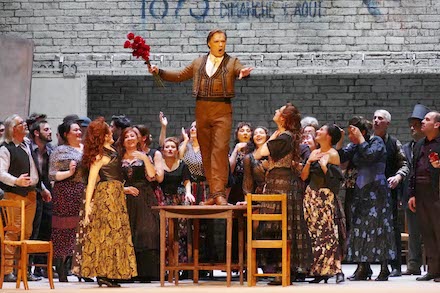
Jean-François Lapoint as Escamillo>
The supporting roles were cast with accomplished artists, notably the gypsies Frasquita (Charlotte Despaux), Mercedes (Marie Kalinine), Remendado (Marc Larcher) and Dancaīro (Olivier Grand), each projecting a mature, individual and very real personage, underscoring yet again the importance of these characters to impose the exotic atmospheres needed to color the second and third acts. Director Grinda staged the infamously difficult second act quintet (with Carmen) with far more than usual choreography, carefully defining the piece musically and dramatically. [See lead photo, left to right Mercedes, Frasquita, Carmen, Dancaīro, Remendato, hovering behind is Lilas Pastia.]
The Morales (Jean-Gabriel Saint-Martin) established himself in the first act as an imposing figure vocally thus establishing the high vocal standard that prevailed throughout the evening. The Zuniga (Gilen Goicoechea) was carefully delineated as a figure who expected but did not command deference. He was then summarily defied, not wounded or killed, by Jose. The non singing role Lilas Pastia (Frank Thézan) was much present, but spoke only in the brief dialogue scene at the beginning of the second act — the sole reference to Carmen’s origin as an opéra comique.
Conductor Vanoosten respected the director Grinda’s careful, detailed staging with tempos that allowed the words to be clearly articulated while musically stated. His pacing of the extended chorus scenes was masterful, the musical structures of these scenes left absolutely apparent, the tension held by the larger rhythm of the entire act.
There was uncanny synergy between pit and stage.
Jean-Louis Grinda and his long time collaborator, designer Rudy Sabounghi have created a staging overflowing with excellent ideas and successful solutions to the opera’s many challenges. Cherry atop the cake was the excited reaction of the crowd milling about on the stage for the quadrille des toreros (the procession into the bull ring of the matadors). This was a real paseillo into a real bull ring somewhere that was projected, hugely, onto the back wall of the stage box.
All said and done this excellent staging was an undisciplined sum of its parts. It did not find the refinement and the elegance of a finished production.
Opéra de Marseille, France, February 21, 2023.
Cilea's Gloria in Sardinia
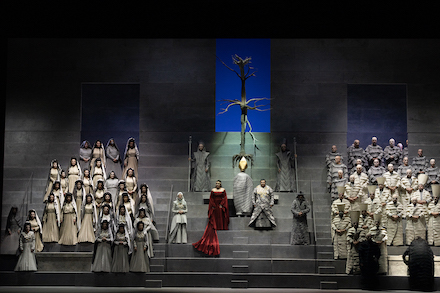
Beyond its emerald waters, white sands and pecorino cheese, Sardinia is an opera destination! Just now it was Francesco Cilea’s fifth and last opera, Gloria, at the Teatro Lirico di Cagliari. This fine, late 20th century opera house is famed for its revivals of rare and forgotten operas.
Voilà Gloria, adding, possibly, an additional work to the very brief Cilea operatic canon — L’Arlesiana (1897) and Adriana Lecouvreur (1902). Gloria had its premiere at La Scala in 1907, the same year Strauss’ Salome first appeared at La Scala. Both works derive from the Parisian theater of the mid and late 19th century — think blood and thunder. Oscar Wilde’s French language play Salome premiered in Paris in 1893, Cilea's opera Gloria derives from the Sardou 1874 play L'Haine (The Hate), his previous opera Adriana Lecouvreur was based on an 1849 Scribe play of the same name.
Scribe and Sardou are both famous as creators and purveyors of the science des planches (the planks of a theater stage), in other words the “well made play.” This means that they somehow fabricated sort-of plausible stories that always smoothly created opportunities for exaggerated emotional release (Tosca was a Sardou play, as an example).
Enter Edoardo Sonzogno and Gabriele D’Annunzio. Sonzogno, of the famed eponymous publishing house, instituted a famous one act opera competition won by Mascagni, thereby founding Italian operatic verismo. As well Sonzogno nourished the careers of other promising Italian composers. Cilea, rather than pursuing the emerging, strictly Italian verismo, looked oltre alpi — beyond the mountains that separate Italy from the rest of Europe — to the innovations of Debussy and Wagner, as well as to French theater, much as the poet/dramatist/fighter pilot D’Annunzio looked to enrich Italian letters and life with access to a larger, modern world.
Sonzogno recognized Cilea as a brilliant musician and supremely talented composer, a reputation that is well upheld by this Cagliari production. D’Annunzio, a major figure in Italian literature, loved the opera Adriana Lecouvreur, Cilea’s masterpiece. Cilea then sought D’Annunzio’s play Francesca da Rimini as the basis for his next opera. Verdi’s publisher Ricordi however owned the rights, extending them to Riccardo Zandonai whose resulting opera is now a part of the established international repertory.
Cilea’s substitute choice, Gloria, evokes all these intriguing and intricate histories of this fascinating, fecund moment in the history of opera. It also awakens, as performed just now in Cagliari, the deep regret that Cilea could not have rendered D’Annunzio’s play as an opera — after all there are three additional operatic versions of Adriana Lecouvreur.
Francesca da Rimini debuted in 1901 with the famed Italian actress Eleanora Duse (a Sarah Bernhardt rival as well as D’Annunzio’s mistress). Francesca and her lover Paolo. immortalized in Dante’s Divine Comedy, are murdered by Francesca’s ugly husband Gianciotto when he discovers them at a tryst, though it is a far more complicated tale.
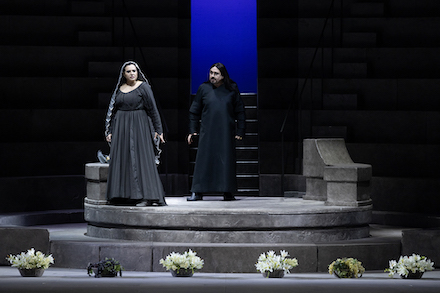
Act III wedding, Gloria in red dress, Lionetto on her right. Lead photo is Act 1, with fountain. All photos copyright Priamo Tolu, courtesy of the Teatro Lirico di Cagliari.
Note that the libretto is almost a duplicate of the Romeo and Juliet story as told by Bellini, whom Cilea greatly admired.
Thus Gloria herself arrives among the more imposing theatrical heroines, like Tosca, Eleanora Duse’s Francesca da Rimini, Sarah Bernhardt’s la dame aux camélias [i.e. La traviata], and of course the actress Adriana Lecouvreur. Librettist Colautti with his well made opera plot, and composer Cilea do not disappoint with two splendid arias for Gloria in the first act, a huge aria followed by a lovely prayer in the second act, and a heart breaking duet with Lionetto in the third act — all quite spellbinding in Cagliari.
Not to be outdone by Gloria, Lionetto has a quite extended aria in the first act, a ardent duet of declaration of love in the second act, the gut wrenching duet with Gloria in the third act, as well as fiery, heroic and dramatic encounters with absolutely everyone, including Gloria. Every opera demands a baritone, in Gloria it is her brother Bardo who has his share of glory in a first act aria, a huge and lively second act duet with his sister, and of course he caps the opera with the third act murder.
The Cilea sound is unique in its melodic sensuality, and its passion that often dissolves into rapture. It is harmonically sophisticated, and structurally highly complex, though remaining always tonal. It is greatly pleasurable and satisfying to the ear.
Clearly it is an opera in the Italian tradition, though with musical incursions from beyond the alps that result in thematic references that recall leitmotifs, and orchestral colors that resonate with natural phenomena, most notably the Act 1 activation of the fountain of peace, describing the waters as they begin to flow, as they mount, and then find a glorious climactic expulsion — it is orchestration that finds all of the not-so-hidden sexuality and extravagance of D’Annunzio’s prose and verse. Not to forget the descriptive musical extravagance of Cilea's unseen battles.
Conductor Francesco Cilluffo made the most of Cilea’s colorful score, abetted by the willing orchestra of the Teatro Lirico di Cagliari.
Cherry atop the well-made-opera cake was the Act I finale, when all four protagonists (the pater familia Acquilante de’Bardi will be killed in an off stage battle) lined up across the front of the stage to share their individual thoughts with us, a quartet that rivals the famed fourth act Rigoletto quartet. Though here, in Cilea’s compositional extravagance, there is also the chorus of nobles, of the populace and finally of women alone bemoaning the fountain of peace having become a fountain of blood (Lionetto has stabbed Bardo).
Though musically magical, Cilea’s Gloria, as staged in Cagliari, was unable to rise above its genesis as an opera created according to formula.
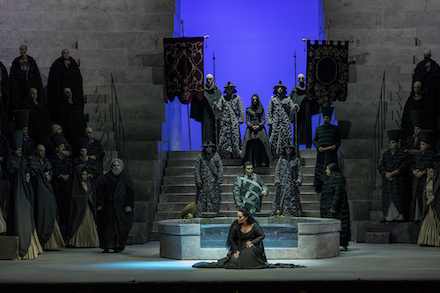
Act II. Gloria with her brother Bardo>
The cast assembled by the Teatro Lirico di Cagliari well met the huge challenges of executing these monumental roles. I saw the fourth of eight performances when the announced Gloria, Anastasia Bartoli, was indisposed, thus the role was sung to fine effect by the Gloria of the alternate cast, Romanian soprano Valentina Boi. Stalwart Italian tenor Carlo Ventre was everything you need to be for Lionetto, I.e. heroically voiced. Bardo was sung by Franco Vassello, a baritone of considerable accomplishment who confidently voiced the vindictive brother. Georgian bass Ramaz Chikviladze sang Aquilante de’Bardii, his personage dispatched after the first act. The cameo role of a Sienese woman who encourages Gloria to succumb to Lionetto’s love was sung by Elena Schirru, a native Cagliarian.
The creators of the mise en scène, stage director Antonio Albanese, set designer Leila Fleet, and costume designer Carola Fenocchio mistook Cilea’s dramma lirico for a bona fide tragedy, choosing to place its acts in variations of a generic Greek theater and not in medieval Siena where there might have been an actual, monumental fountain. Costuming was highly abstract, Gloria’s wedding dress was in a remarkably spectacular, very red bird like form that bespoke blood, and the generous, indeed satisfying violence of the plot.
Teatro Lirico di Cagliari, Sardinia, February 15, 2023.
Peter Grimes at the Palais Garnier
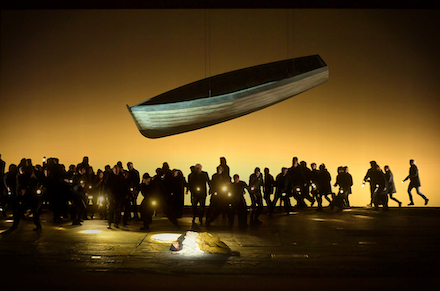
That the Four Sea Interludes and the Passacaglia from Peter Grimes have become orchestral showpieces attests to the opera’s musical might, manifest just now at the Palais Garnier by British conductor Alexander Soddy.
Benjamin Britten’s orchestral score sang out with ferocity, revealing the opera’s musical details in utmost clarity. And its details are myriad, as we learned, the many sea motifs most clearly articulated, the polytonalities astringently apparent, the structures meticulously defined. It was awesome music, in fact technically astounding.
What this maestro’s reading of the score did not fathom was the poetry of the score — the mesmerizing seascapes, the solitudes, the loneliness and the hopelessness. He did find the crowd scenes exciting, the storms memorable, he caricatured the local personages delightfully and made the little songs sprightly, all this at a very brisk pace.
This production of Peter Grimes is new to Paris, premiering in Madrid in 2021 then continuing to London in 2022, and always with British tenor Allan Clayton as Grimes and Swedish-born, German-formed soprano Maria Bengtsson as Ellen Oxford. Mr. Clayton (also the recent Grimes at the Metropolitan Opera) is not a heroically voiced Grimes, as was Jon Vickers in Peter Grimes’ previous (1981) incarnation at the Paris Opera. Nor is he a light lyric voice as Peter Pears, the original Peter Grimes. Not at all unsuitably for Grimes Mr. Clayton possesses a character voice, and a character physique that render him, seemingly, a very realistic, outcast fisherman. Miss Bengtsson is a lyric soprano of righteous voice that serves her well for the Mozart heroines. Not at all the often matronly Ellen, she reads as a liberal activist of pure voiced, earnest intention.
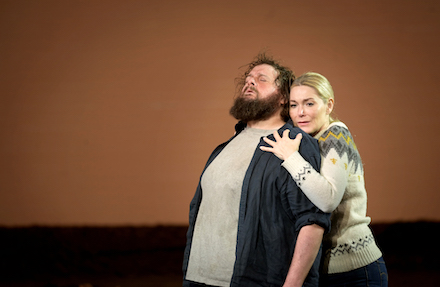
Allan Clayton as Peter Grimes, Maria Bengtsson as Ellen Oxford
Surely these were the attributes sought by the production’s stage director, Deborah Warner. She updates the story from the time of its premiere (1945, when it was a contemporary setting — forget its 18th source), to a more recent time, undefined, when there were brightly colored plastic crates and brightly colored baseball caps, and cool sneakers (though there were no cell phones apparent). She evidently wished to strip the opera of reference to and perspective of another, or any time period, rendering Britten’s first operatic masterpiece simply as the personal story of a downtrodden, troubled man who recognized that there was perhaps salvation, but understood, finally, that salvation was not his fate.
Grimes was haunted by the recent death of his apprentice (unnamed) who appears in Grimes’ dream (the prologue — see lead photo) in a feat of spectacular flymanship — the suspended apprentice enacts a slow-motion drowning in an imaginary sea that is the void above the stage floor. It is this loss that haunts Grimes and enflames suspicion among the villagers.
With Ellen’s help, he takes on a new apprentice. This apprentice, who we know is doomed as well, was cast not as an adolescent of sufficient strength to actually be of help on a fishing boat, or as a youth whose violent death we might mourn, but as a seven or eight-year-old child who, we would come to understand, was, or rather had been Grimes himself. It was the child’s innocence, and Grimes’ innocence that was sacrificed in the child’s fall from the cliff.
The one man among the opera’s villagers who felt and understood the primal meaning of oceans was the sea captain Balstrode. It was he who tells Grimes to disappear into the sea. This role, played in Paris by English baritone Simon Keenlyside (perfectly embodying the well-intentioned liberal activist — from my American perspective), triggered the very powerful moment of catharsis that Britten — and director Warner — created. It was classical tragedy in its purest form.
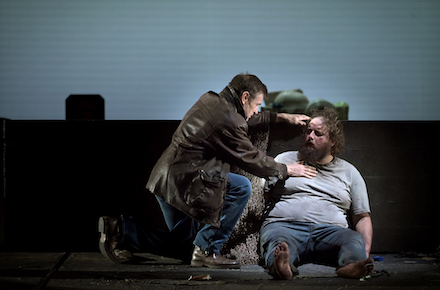
Simon Keenlyside as Balstrode, Alan Clayton as Grimes
The setting for the Warner production was created by the distinguished Canadian-born designer Michael Levine. It was in the abstract minimalism that has come to define the works by this brilliant designer. The dream prologue was on a blank stage, the village was a black floor, low walls and a bank of askew, boarded up old, multicolored low buildings. The inn was a sunken floor allowing us to see actors from the waist up (like a bar or tables), a door and hanging lamps that flickered. Grimes’ hut was a steep platform, a ladder climbing to its peak (the cliff from which the child falls). And finally there was a huge screen backdrop with tiny horizontal lines (waves) that actually wavered during the catharsis (or maybe this was my personal perception). Though minimalist in conception it was maximal in creating a poetic space, rather than a natural space for this human tragedy.
Grimes in the lost innocence of his childhood had been cast into a world in which he did not fit. This world was a village of colorful characters that challenged Benjamin Britten to create very brilliant music to define its citizens, their world and their actions, a world that greatly aroused conductor Soddy. It is against this intrusive and abusive world, made mundane and even entertaining, that the tragedy of this or any misfit occurs. In the final scene, the villagers remain proudly ignorant of the Grimes tragedy, leaving the question — who would want to be a part of that world.
It was indeed a splendid Peter Grimes in Paris.
Cast and Production
Peter Grimes: Allan Clayton; Ellen Oxford Maria Bengtsson; Captain Balstrode: Simon Keenlyside; Auntie: Catherine Wyn-Rogers; First Niece: Anna-Sophie Neher; Second Niece: Hanah Lobel-Torres; Bob Boles: John Graham-Hall; Swallow: Clive Bayley; Mrs. Sedley: Rosie Aldridge; Reverend Horace Adams: James Gilchrist; Ned Keene: Jacques Imbrailo; Hobson: Stephen Richardson. Orchestre et Choeurs de l’Opéra national de Paris. Conductor: Alexander Soddy; Mise en Scène: Deborah Warner; Decors: Michael Levine; Costumes: Luis F. Carvalho; Lumières: Peter Mumford; Video: Justin Nardella. Palais Garnier, Paris, January 29, 2023. All photos copyright Vincent Pontet, courtesy of the Opéra de Paris.
Carmen at the Opéra Bastille
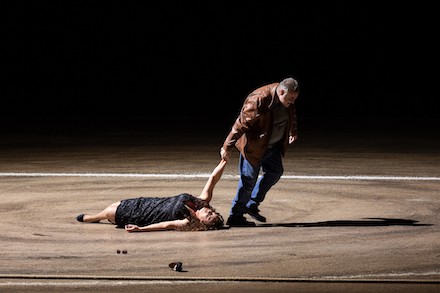
Among the most performed titles in the repertory, it was the 30th performance of Verdi’s Il trovatore in this 2016 production by Barcelona’s chic theater collective La Fura dels Baus, and the 57th performance of Bizet’s Carmen in this 2017 production by chic stage director, Calixto Bieito, originally of Barcelona’s Teatre Romea.
At the premiere of a production an opera company generally tries to assemble a cast that is integral to the production, and to itself, i.e. singers appropriate to the role as envisioned by the production, and singers of similar professional levels — though there are sometimes contretemps, and that’s a fun part of the opera game. Then come the revivals of productions when casting is less carefully curated, sometimes it is assembled around star singers, other times the casting may seem to be somewhat random in an opera company’s need to balance its programming with popular titles.
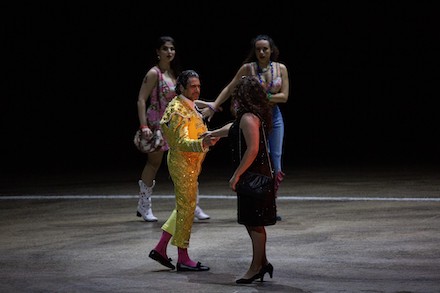
Idelbrando D'Arcangelo as Escamillo and Clémentine Margaine as Carmen (foreground), Andrea Cueva Molnar as Frasquita and Adèle Charvet as Mercedes (background).
All Carmen photos copyright Guergana Damianova, courtesy of the Opéra national de Paris.
Thus our interests in a revival production may be in the singers who find themselves cast, in the musical values imposed by a particular conductor, and how singers and conductor fit into the original concept of a production.
Director Bieito has had Carmen productions in European theaters since 1999. His take on Carmen is rather tame compared to his Barcelona Wozzeck, or his Basel From the House of the Dead, though in his 2014 Bilbao Carmen there was fellatio, pissing, nudity, gang rape, child abuse and unbridled brutality. Mercedes was Lilas Pastia’s middle-aged wife, and yes, Don Jose was really annoyed by an insistent Micaëla who sang her pretty song and then gave Carmen the “up-yours.”
Mr. Bieito is now artistic director of the Bilbao opera.
The 2016 edition for San Francisco was sanitized in much the same way as this 2017 Paris edition as performed last week at the Opéra Bastille. There was none of the above. It can be noted as well that in Paris there were six older cars that pulled on stage to create the gritty Act III gypsy camp, in San Francisco there were three grand, vintage Mercedes, while in Bilbao there were eight delightfully dilapidated, grand old wrecks.
What all three editions did share, however, was the circle image made on an otherwise bare stage. In Act I a circle was delimited by a semi-nude soldier circling the stage for much of the act, jogging, punishingly, until he dropped from exhaustion. In Act IV Lilas Pastia laid a broad chalk circle that we knew was a bull ring. Thus, at the end, Jose drags the slain Carmen from this ring, as the dead bull is dragged out of the corrida. Note lead photo.
It was oh so brutal in Bilbao where there is real corrida, so much less so in San Francisco and Paris.
Given that the Bieito production is little more than a bare stage with some circles and a few old cars, its effect relies largely on its actors. Back in Bilbao the first Carmen withdrew because of illness, the second Carmen could do all the performances except the one I saw when Carmen was the understudy/cover, and distinctly not a Carmen. The Jose was plausible, The Escamillo was long past being able to jump onto the roof of a car for his knife fight with Jose, though he did anyway, somehow. The Micaela, and the gypsies were superbly cast as true characters who fortunately could sing fairly well. They made the show.
San Francisco Opera cast fresh voiced, innocent young singers, though more or less age appropriate to the characters of the Merimée tragedy on which Bizet’s opera is based. These excellent, upwardly mobile young artists had spent their formative years struggling in voice lessons and coaching sessions and not groveling in gypsy camps. It was indeed a great pleasure to see and hear such well-prepared young artists. The Bieito production however needed so much more.
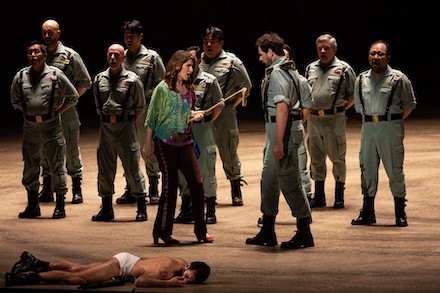
Nicole Car as Micaëla, Tomasz Kumiega as Morales with Act 1 jogger
Which brings us to Paris just now. Clearly none of the artists had passed much of their lives in gypsy camps, though the Carmen, French mezzo-soprano Clémentine Margaine, surely has spent some time on the streets getting from her Carmen debut in 2012 at the Detaches Open Berlin, to her celebrated Carmens at the Opéra de Paris and at the New York’s Met both in 2017. Endowed with a sizable, well-used, rich voice she exemplified just now nearly any adjective attributable to the Carmen ideal — sexy, dangerous, seductive, calculating, fiery, hot, cold, etc.
With this major Carmen figure a Jose of vocal stature was unavoidable. For this winter series of performances it has been veteran Maltese tenor Joseph Calleja. While able to negotiate the vocal treacheries of the role, Mr. Calleja does not have the temperament nor a freshness of voice to create a real Jose — though he did muster sufficient bravura to hold the stage with Mlle. Margin’s bonafide Bieito personage. Barely. He too was well past the point of gracefully jumping onto the hood of a car for his knife fight with Escamillo, though he did manage to get upon it, somehow.
Of artistic merit were the Micaela of Australian soprano Nicole Car and the Escamillo of Italian bass Ildebrando D’Arcangelo. Both artists are quintessentially Mozartian, neither with the histrionic range to confront a true Bieito personage. They gave us cleanly sung, exemplary vocal performances, and great pleasure indeed, Mlle. Car a model of virtue, purity and innocence, Mr. D’Arcangelo, agile, virile and smugly smooth.
True to expectations at a major theater this Carmen arrived at a musical perfection, conductor Fabien Gabel imposing strict and brisk tempos. That the excellent children’s chorus stayed exactly on the maestro’s quick beat during the staging complexities of the huge act one chorus scene was the triumph of the evening.
Opéra Bastille, Paris, France. January 28, 2023
Le Trouvère at the Opéra Bastille
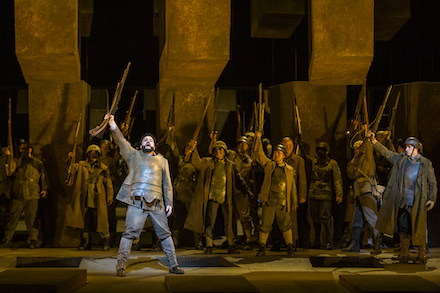
Yusif Eyvazov as Manrico in "Di quellq pira" All Le Trouvère photos copyright Sébastien Mathé, courtesy of the Opera national de Paris.
Though the Opéra national de Paris billed Verdi’s Il trovatore as Le Trouvère just now, it was not Verdi’s French version of the opera at the Opéra Bastille — there was no ballet. It had been, however, Le Trouvère (in French) that debuted this Verdi opera at the Opéra de Paris back in 1857 — with ballet.
Il trovatore, with Rigoletto and La traviata are the stalwart pillars of the Verdi canon, and the foundation of any opera company’s repertory. Of this triumvirate, Trovatore is the most difficult to pull off. Given the absurd implausibility of its story and its flow of magnificent set piece after magnificent set piece, it demands major singers and a determined Verdi conductor. The production itself never seems to matter all that much though a bit of color is always welcome.
This Paris production is by the stage director Alex Ollé tied together with La Fura dels Baus though it is unclear what the Barcelona theater collective has had to do with it, other than that the set and costume designers both have tenuous ties to the collective according to their program bios.
La Fura dels Baus is famed for its staging of the opening of the 1998 Barcelona Olympic Games, for street theater, and operatically for the creation and use of unusual settings — in my experience there has been a huge, nude woman crouching on all fours for a 2008 production of Le Grand Macabre at English National Opera, and a massive wall of plastic water bottles for a 2014 production of Le Siège de Corinthe) at the Rossini Opera Festival in Pesaro.
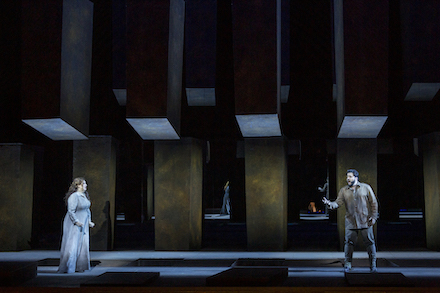
Anna Pirozzi as Leonora, Yusif Eyvazov as Manrico
In Paris (though first it was in Amsterdam) the set is a grid of massive brown square pillars multiplied by a mirrored backdrop. They rose and descended in and out of squares cut into the brown floor, like pistons, though these pillars were pulled, threateningly, way up into the stage void by steel cables from time to time. One can greatly admire the precision of the installation of such a stage machine. The pillars when submerged had crosses placed on them from time to time to indicate tombs of war dead, given the costumes recalled World War I, including gas masks. At other times those square holes in the floor became that war’s infamous, but now chorister inhabited, trenches.
Stage director Ollé’s apology in the program booklet likens the set to Berlin’s Holocaust Memorial in the grids of stelae they share, though he says that there is no intended correspondence, the connection only that war in general has innocent victims.
Be that as it may we were left with the singers, the generic, quite responsible conducting of Carlo Rizzi, and this indeed impressive, huge war machine on the stage.
The Ferrando was sung by Italian bel canto bass Roberto Tagliavini. He had the opera’s first blockbuster aria “Di due figli vivea padre beato.” He delivered it in true bel canto style, executing its florid lines with exciting precision, the hiccuping opening lines, then the repeated, descending scales, awakened our anticipation for Azucena’s equally florid, equally exotic song “Stride la vamps” that was soon to come. This famed gypsy was sung by Romanian mezzo Judit Kutasi, but she missed the dramatic punch of her opening aria — the horror of her mother’s death and the sacrifice of her child — not yet having found her voice. She did pull through her tense scene with Manrico with certain vocal aplomb, though she never embodied the tragic stature of this tormented woman.
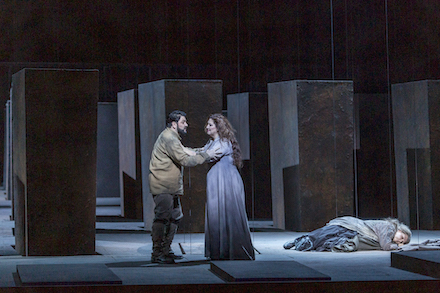
Manrico and Leonora with Judit Kutasi as Azucena in the prison
Italian soprano Anna Pirozzi was the Leonora. While she once may have had fame as Lady Macbeth and Abagail (Nabucco) she brought neither resplendent voice to Leonora, nor a dramatic urgency to this innocent, love-smitten young woman. Her opening piece “Tacea la notte placida” was dry voiced, abandoning all possibility of displaying the raptures of love in its soaring lines. The villain of the opera, though his only crime is his infatuation with Leonora, is the Count de Luna, an early example of the Verdi baritone — a voice of heroic color, imposing volume and the stamina to traverse an upwardly extended register. This role was taken by Canadian baritone Étienne Dupuis who had no difficulty at all singing the role, missing however was the vocal heft and noble color to make this quintessential Verdi villain a dramatic force in Verdi's opera.
The cast was dominated by Manrico — the trouvère, Leonora’s lover, the counts brother, and the adopted son of Azucena. The role was sung by Azerbaijan born, Italian formed tenor Yusif Eyvazov, the only true Verdian of the evening. Often paired with soprano Anna Netrebko in major dramatic roles around the world, it was revealing to encounter him solo, not part of this imposing team. A tenor voice of pleasurable heft if not distinct color he has assumed the persona of a primo tenore assoluto, and this alone added a needed excitement to his stylistically well-informed performance. Mr. Eyvazov’s third act “Ah sì, ben mio, coll’essere" was resplendent, the following magnificent cabaletta “Di quella pira l'orrendo foco” with its high C’s brought the house down. Mr. Eyvazov is a singer, not an actor.
The eighty singers of the mighty Opéra national de Paris chorus made a huge impression when all together. When in the smaller ensembles that occur throughout the opera they were amusingly manipulated by the reflective surround of the Fura dels Baus set, making it hard to know who and what was where when. Or why.
Opéra Bastille, Paris, France. January 27, 2023
Tristan et Isolde at the Opéra Bastille
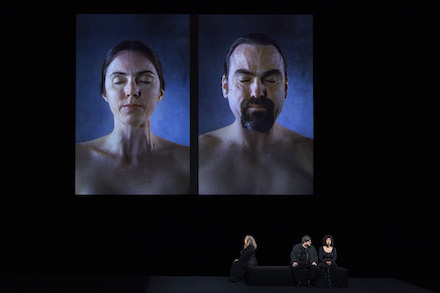
A few weeks ago it was one act per night in Los Angeles, in Paris just now it is all three acts at once, as it had been back in 2005, the original year of this awesome production in Paris (its premiere in Los Angeles was in 2004). The production has since been seen also in Toronto and Madrid
It is nothing more than a blank stage, an ottoman, a massive screen for video projection, plus a huge orchestra that was on the Disney Hall stage in LA, but in the Opéra Bastille pit in Paris.
The creation of by-now legendary artistic forces, stage director Peter Sellars and video artist Bill Viola, plus the Los Angeles Philharmonic’s super star conductor Gustavo Dudamel (back in 2005 the conductor was the LA Phil’s Esa-Pekka Salonen), it was an integration of diverse forces that achieved a balanced perfection — costumed actors in few but decisive movements and positions, a video stream comprised of few, always transforming images, and the score of Wagner’s great masterpiece held in the sway of its few, dominant moods.
The opera’s overture, left un-staged, was performed as a concert piece, conductor Dudamel provoking a static tension that resolved into the overture’s shattering climaxes. This process began again in Act I, though it grew into a cataclysmic confrontation of the opera’s philosophic forces. The Act II prelude established a primal, relentless minimalist beat that endured through the negotiations of light and night, the aspirational coupling, and then through the agonized outpourings of the deceived patriarch. Act III’s monologue was again in stasis, with sudden, nervous eruptions that Dudamel magically transformed into the opera’s ultimate, magnificent transfiguration, a musical feat that dwarfed Isolde’s Liebestod prayer.
Say what you may about the Opéra Bastille [seating is only slightly more comfortable than Bayreuth’s benches], its acoustic is superb. The wide stage offers a wide pit, it’s ample depth easily accommodated the 92 players of the production’s excellent orchestra. This full scale Wagnerian ensemble achieved a breath of tone that enveloped the theater’s 2745 spectators in sonic grandeur.
Stage director Peter Sellars exploited this acoustical immediacy by positioning the back stage Act I sailors chorus somewhere in a nearby public area so that they would fill the theater with loud, immediate and threatening sound. At the act’s conclusion Sellars illuminated the auditorium itself where we soon discovered King Marke standing in an aisle among us. We were indeed smack in the midst of the complexities confronting Tristan and Isolde. It was compounded in Act II with the hunting horns (fourteen brass players) again in a public area summoning us to return to our seats (à la Bayreuth), and then Brangäne’s lovely prayer was sung from the high balconies. Act III’s shepherd’s voice and horn, again arose from the far reaches of the balconies, fully enveloping us in the darkness of Tristan’s delirium.
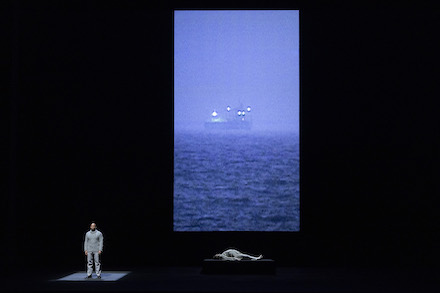
Act III. Ryan Speedo Green as Kurwenal, Michael Weinius as Tristan
Sellars staged his actors in formal, often frozen positions, sometimes in an area defined by a square of color, notably Kurwenal’s Act III entreaties. Movement was formalistic, notably Isolde’s Act I sharp-armed, feigned assassination of Tristan. It was wrenching to witness Marke, supine on the floor at Tristan’s feet, recount the complexities of the Tristan betrayal.
Sellars’ specific storytelling was at floor level, beneath a very large but not overwhelming screen on which appeared the ever evolving video images created by Bill Viola, based on his reading of Wagner’s poem. This visual storytelling interfaced loosely both with Sellars own storytelling, and with Dudamel’s exposition of Wagner’s musical flow, completing the elements of this canny, savvy post modern take on Wagner’s Gesamtkunstwerk (unifying all forms of art via theater).
The Bill Viola œuvre in general explores nature’s basic elements — fire, water, wilderness (candles, oceans, forests) — in both threatening and restorative guises, in rhythms and transformations that slow, stop and sometimes reverse time. These are brought to bear, easily and quite naturally, onto the Wagner masterpiece. As well Bill Viola contemplates the human form in his video art, reveling in the motions of a sculptural plasticity. In Act II, notably, heroic figures appear as surrogates of Tristan and Isolde, though here there was not the idealization of form as in classical sculpture, instead the male and female forms were shown in a photographic detail that revealed them as a man and a woman (note lead photo).
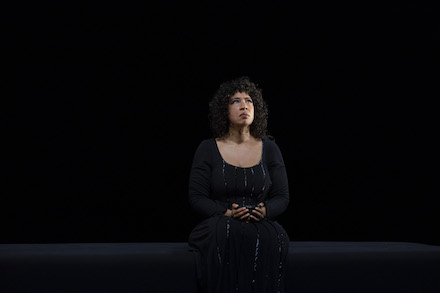
Mary Elizabeth Williams as Isolde
This humanity manifested itself in the very specific casting, especially in choosing a raw voiced Isolde, a voice that would not/could not adapt itself to that of an idealized, mythological Irish princess, though possessed of a basic musicality that made her a very special post modern Wagnerian heroine. In Isolde’s most triumphant moment, her Liebestod, this simply clad singer stood beneath the huge screen and sang her prayer with convincing sincerity. On the screen a female form in white diaphanous drapery rose magically and majestically through oceans of water to disappear, finally, into the maestro’s eternity of love.
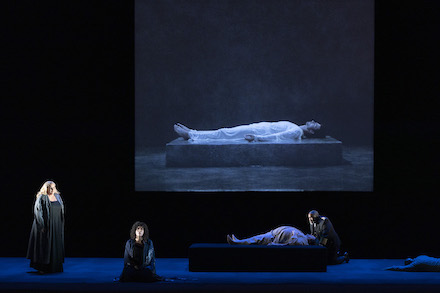
The Liebestod. Okka von der Damerau as Brangäne, Mary Elizabeth Williams as Isolde, Michael Weinius as Tristan, Eric Owen as Marke
At the Act I bows (the surprising act bows recalled the production’s original three night format in LA), the Isolde, Mary Elizabeth Williams, was met with loud booing. As the evening progressed we did come to understand that Mlle. Williams was quite possessed by Isolde, that she was in fact Isolde. A very determined Isolde. At the final bows — and she had the final solo bow! — she was greeted with a huge ovation.
Tristan was beautifully rendered in fully heroic operatic terms by Swedish heldentenor Michael Weinius, fulfilling as well the broad humanity of director Sellars’ casting ethos. The same may be said of the beautifully voiced, heroic Brangäne of German dramatic soprano Okka von der Damerau. Of heroic physique and voice was the Kurwenal of American bass baritone Ryan Speedo Green (Jake in the Metropolitan Opera’s Porgy and Bess), whose urgings to Tristan took on, in the new-age humanity of this production, the unlikely tone of berating him. American bass Eric Owen (Porgy in the Met’s Porgy and Bess) was a King Marke of remarkably beautiful voice. Wounded by Tristan’s actions his soliloquy poured out as a heartbreaking lament.
The cast was completed by the Merlot of British tenor Neal Cooper, a facilitator of the story rather than one of its actors, and the fine voices of its helmsman sung by Tomasz Kumiega and shepherd sung by Maciej Kwaśnikowski.
Costumes were designed by Martin Pakledinax, the lighting design was by James F. Ingalls, a longtime Sellars collaborator.
All photos copyright Elisa Harberer, courtesy of the Opéra national de Paris
Les Vêpres Siciliennes in Palermo
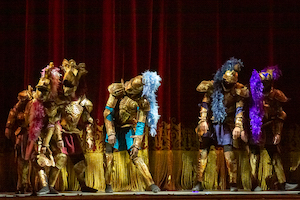
Puppet soldieers
Ossia I Vespri Siciliani takes its name from the evening prayer to which the faithful are called by the ringing of bells. Specifically the bells of Verdi’s Sicilian vespers signal the Sicilians that it is time to massacre the French.
This was many years ago, about 750 years ago actually. Just now Palermo’s Teatro Massimo has mounted Verdi’s original 1855, grand opera version in commemoration, after thirty years, of another Sicilian massacre. Judges Giuseppe Falcone and Paolo Borsellino were famously blown-up in 1992 (many others were murdered less spectacularly), the result of turncoat Mafiosi testimony.
Trying to reconcile this recent Mafia history with that long ago history of a French occupation as told by Verdi’s famed librettist, Eugène Scribe is not so easy. But it is easy to be critical of the Scribe libretto. In fact Verdi’s mistress Giuseppina Strapponi (later his wife) advised him to back out of his contract with Paris’ Opéra, given the second hand libretto was of such doubtful quality. Verdi thought however that he might be able to make some really impressive grand opera music. And that he did.
Besides impressive spectacle, grand opera likes flashy, virtuoso singing, it likes pretty little hummable songs, nifty quartets and trios, emotional duets, and lots and lots of great big choruses. And maybe and above all French grand opera likes ballets. The Scribe libretto provided all these opportunities for Verdi. Never mind that grand opera had been out of fashion for about twenty years.
Palermo born stage director Emma Dante (of impressive credential indeed) summarized the pre-history of the opera by dumping five ballerino French soldiers gaudily costumed as puppets onto the stage apron who twitched like bewitched marionettes throughout Verdi’s clumsy overture. The first act introduced Hélène, the murder of whose brother, the Duke of Alba, was unavenged, with an aria virtually impossible to sing. We met Montfort, the sympathetic baritone French governor who later will splendidly deliver one of the opera’s loveliest airs once he learns that the Sicilian tenor Henri (who maybe will get it together vocally for his big Act IV aria) is actually his son.
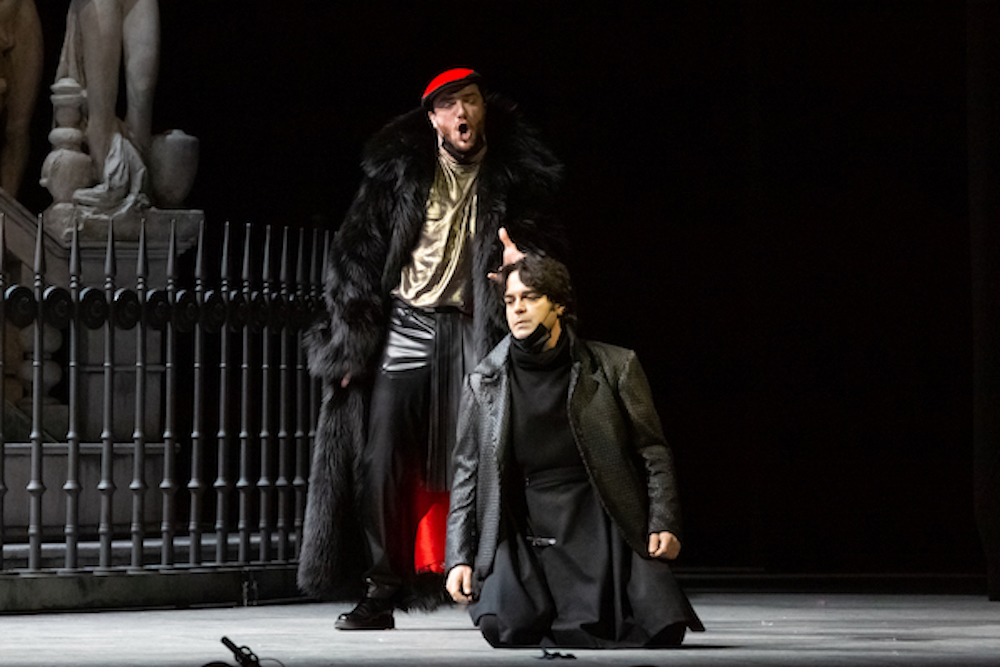
Mattea Olivieri as Guy de Montfort, Leonardo Caimi as Henri
The brilliance of Hélène’s aria stirred up a grand chorus of revolt, the Palermitani clash with French soldiers, 15 or so banners appeared with photos of the victims of the 1992 massacre. A ballet of revolt followed. Three Klezmer style musicians walked on stage — a violin, clarinet and accordion — to provide a very stylish, and personable reduction of Verdi’s very extended, musically pallid ballet score. Palermo may lack good restaurants but it has a terrific clarinet player and a plentitude of truly excellent dancers who responded with boundless energy and refined technique to Palermo born choreographer Manuela Lo Sicco’s rich, chic and witty choreography — she is a frequent Emma Dante collaborator.
This first act encounter of Montfort with his as yet unrecognized son Henri does not go well — Henri refuses to become an accomplice to the French. Plus of course he loves Hélène. Meanwhile an angry spectacle erupts. Palermo is sacked by the French who threw huge piles of furniture etcetera onto the stage, the Palermitani meanwhile sack the palace, dumping box after box of papers from the palace onto the stage (did I get this right?). The spectacle did continue on, and for quite a while after the music had stopped.
Voilà grand opera!
The curtain fell on Act I. There was a lot to clean up onstage. It was a long intermission. With great trepidation we embarked onto the second of the five acts.
Procida, a bass voiced Sicilian rabble rouser, has returned from exile. He is standing in a suspended boat, sort of like it was an airplane. He sang the air “Et toi, Palerme” in gorgeous tone, the Palermitani were entranced (as was I) as he extolled the beauty of Palermo, “queen of cities!”
Et voici! The four principal singers that la Dante does not mess with, leaving them mostly downstage and on the stage apron to render the plentitude of quartets (some a cappella), trios, duets and arias that are the glories of Verdi’s Les vêpres Siciliennes. The opera comes just after the Verdi's middle period masterpieces, Traviata, Rigoletto and Trovatore. While offering in Paris homage to the French styles of songs and ensembles there is the sense as well that Verdi has moved into a new sphere, a new exploration of the emotional depths of his later personages.
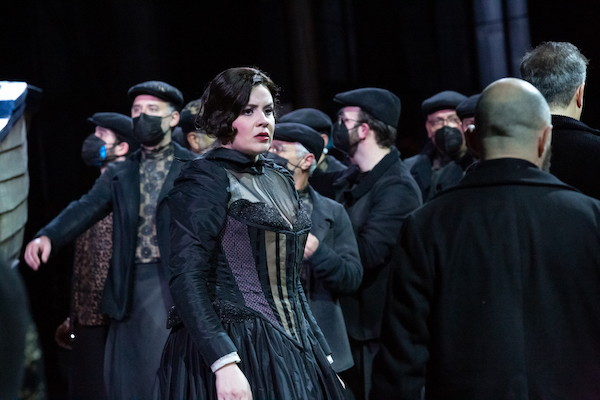
Seline Zanetti
Yes, tenor Leonardo Caimi got it together vocally, barely, for his big fourth act aria “O jour de peine et de souffrance!” — he had betrayed Hélène and Procida by revealing to his father the plans for insurrection. Baritone Mattea Olivieri’s third act aria “Au sein de la puissance” was delivered the joyous emotion of a new father. Beside his enchanting “Et toi Palerme” Luca Tittoto smoothly anchored all of the grandiose quartets and trios. Soprano Selene Zanetti negotiated her difficult first act aria “Au seins des mers” with cautionary aplomb and let her final aria “Sorte fatale” rip with its spectacular glissandos.
It was an all Italian cast, to my ears at odds with the French language, basic Italian flair and flash always just below the surface. Conductor Order Meir Wellber (Teatro Massimo’s music director) held the Teatro Massimo orchestra in check in the quirky acoustic of its auditorium, allowing the public scenes the necessary volume, pulling back to work closely with the singers in their personal moments. There is the suspicion that it was Mo. Wellber’s idea to assign the first act ballet to Klezmer-like treatment.
And no, Emma Dante’s staging shenanigans never let up, nor did the glories of Mme. Lo Sicco’s choreography (or the energy of her dancers). Well, we were all waiting, let me say dreading the massacre. The production travels to Naples, Bologna and Madrid. I won’t be the spoiler.
But maybe someone can tell me what happened to Henri in the end.
Cast and Production
La duchesse Hélène: Selene Zanetti; Ninetta: Carlotta Vichi; Henri: Leonardo Caimi; Guy de Montfort: Mattia Olivieri; Jean Procida: Luca Tittoto; Thibault: Matteo Mezzaro; Danieli: Francesco Pittari; Mainfroid: Pietro Luppina; Robert: Alessio Verna; Le sire de Béthune: Ugo Guagliardo; Le comte de Vaudemont: Gabriele Sagona. Orchestra, Chorus and Ballet of the Teatro Massimo. Conductor: Omer Meir Wellber; Stage Director: Emma Dante; Scenery: Carmine Maringola; Costumes: Vanessa Sannino; Choreography: Manuela Lo Sicco; Lighting: Cristian Zucaro. Teatro Massimo, Palermo, July 23, 2022. All photos courtesy of the Teatro Palermo, copyright Rosellina Garbo.
Kat'a Kabanova at the Rome Opera
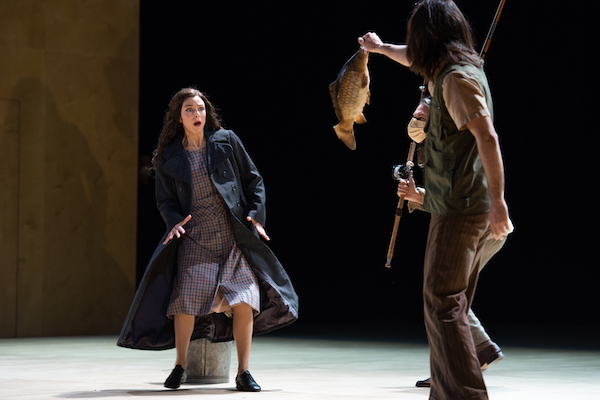
Corinne Winters as Kat'a
The Opera di Roma marks the centenary of Janacek’s intimate domestic tragedy Kat’a Kabanova with a new cast for Richard Jones’ prize winning, 2019 Covent Garden production. Reportedly spell binding in London, in Rome, though some faults were apparent, its effect was certainly no less overwhelming.
That is because it is the Janacek of the gritty real, finding immeasurable beauty in the ugly. These scores, Kát’a Kabanová and From the House of the Dead in particular, take you to emotional planes you would not endure without the cloak of art — absolute hopelessness and absolute alienation. You may revel in the pristine clarity of such feeling, knowing it is art.
Janacek scores usually thrive on the minimal, the simplest of surrounding, anything more detracts from the tracery of emotional movement that Janacek so carefully and specifically etches. In Rome American born, London schooled conductor David Robertson masterfully delineated the detailed Janacek score.
British stage director Richard Jones teased minimalism in this staging. The elaborate abstractions of his set — a huge brown wooden box; the spare interior and exterior of a house; a bus stop shelter; a street light — alone drowned the orchestral continuum. All this was in concert with sharply geometric lighting shapes imposed on these elements (that went awry in the performance I saw compromising Kát’a’s Act I monologue — the germ of director Jones’ concept).
Mr. Jones revises, with the justification of Kát’a’s monologue, the libretto’s inherent intent that societal and commercial pressures crush basic human instincts. Kat’a is a victim. Jones elaborates, reading Kát’a in the Act I monologue as an unstable personality, whose descent into a depressive madness is the thread we will follow. In the end she is the victim of her isolation and of her madness.
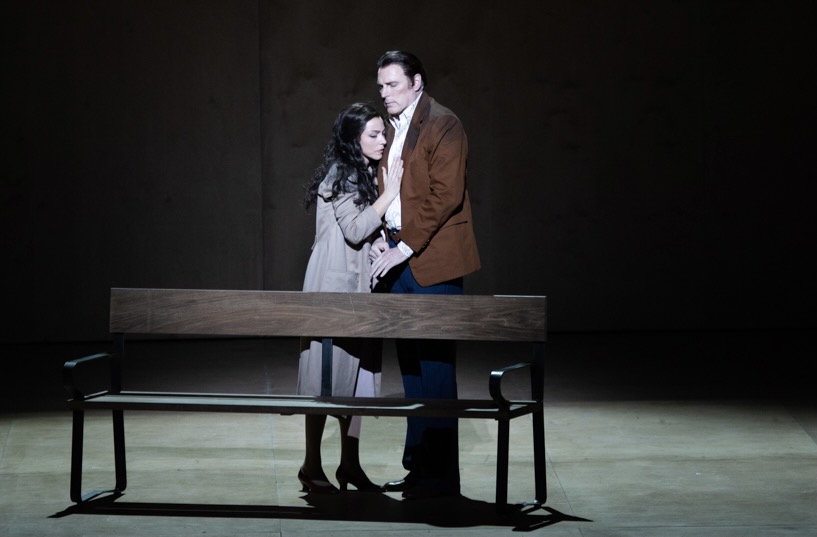
Corinne Winters as Kát'a and Charles Workman as Boris in Act II
American soprano Corinne Winters brilliantly fulfilled director Jones’ reading of the libretto, initially convincing us in the first act that she is a lost soul, her words themselves lacked precise enunciation. Precision was indeed present in the beautifully sung role of Varvara, Kát’a’s nemesis — a free spirit able to break free away from familial and social fetters, enacted with infectious abandon by Canadian soprano Carolyn Sproule.
Conductor Robertson’s Act II precisely teased the ecstasies of love, its fulfillment hinted but seldom achieved. Varvara and her equally free spirited, if wise boyfriend Vaña Kudrjáš — sung by British tenor Sam Furness — indulged in fleeting lovers spats underpinned by soaring, joyous offstage utterances by Káty’a and her equally doomed lover Boris. American Heldon tenor Charles Workman offered an exquisitely passive portrayal as Kát’a’s lover.
Often director Jones’ staging indulged in superfluous illustration of Janacek’s inner emotional states. A confusing example was the apparition of a 1960’s Mercedes sedan with Kat’à’s internal musical confusion marked by her repeated attempts to climb in, thwarted by her husband Tichon Kabanov — sung by British tenor Julian Hubbard. Conversely a quite powerful example of Jones’ staging was at Kát’a’s final encounter with her lover when she attempted to lift Boris’ flaccid arms into an embrace.
Of surprise, and indeed fine effect was Jones’ totally abstract river Volga, nothing more than the disappearance of all scenic paraphernalia leaving black voids, the river becoming the void of the auditorium, and the revealed void of a blackened upstage creating the Act III bridge. In a heavy handed directorial flourish Mr. Jones had fishermen pull a fish from its waters in Act I, the dead fish image becoming Kát’a in Act III. Director Jones’ point was made, and the story was thereby told.

Kát'a pulled from Volga river, with Susan Bickley as Kabanicha and villagers
The opera’s final image, Kát’a’s stepmother — ably performed by British character mezzo Susan Bickley — is rejected by her son, Kát’a’s bereaved, drunken husband. This last scene, sometimes made into an important pronouncement (i.e. that Kát’a was crushed by what these two figure represent), for director Jones was but a somewhat insignificant postlude, and definitely beside the point.
Finally, maybe this Richard Jones production, with this superb cast, did again earn that prize.
Cast and Production
Kát’a: Corinne Winters; Boris: Charles Workman; Tichon: Jullian Hubbard; Vana: Sam Furness; Varvara: Carolyn Sproule; Kabanicha: Susan Bickley; Dikoj: Stephen Richardson; Kuligin: Lukas Zeman. Orchestra and Chorus of the Rome Opera. Conductor: David Robertson; Stage director: Richard Jones; Costumes and Sets: Anthony McDonald; Lighting: Lucy Carter. Teatro Costanzi of the Teatro dell’Opera di Roma, January 21, 2022.
g src="images/Dante_Aix3.jpg" width="440" border="0" />Shades in Paradise being suctioned towards the light of God
Rusalka at Madrid’s Teatro Real
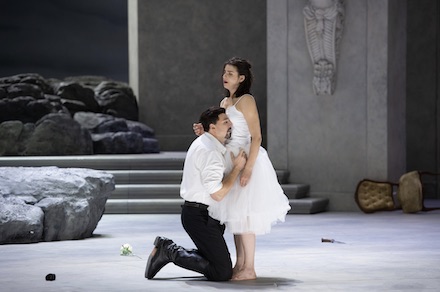
Eric Cutler as the Prince, Asmik Grigorian as Rusalka
All photos copyright Monica Rittershaus, courtesy of the Teatro Real
For this opera critic sheltered in San Francisco the next best thing to actually being at an opera house is tuning into an actual, real-time performance, digitally. Thus the 7:30 PM downbeat for the Madrid Rusalka occurred at 10:30 AM in my darkened living room.
It was the new, long awaited Christof Loy Rusalka finally on stage at the Teatro Real with Lithuanian soprano Asmik Grigorian, the famed Salzburg Salome, as Dvorak’s water nymph. All this while Covid rages in Spain. If safety protocols are your thing check out the Associated Press account of pandemic opera at the Teatro Real The Show Goes On . . ..
But wait, there’s more than mere plague! The night before the dress rehearsal American tenor, Eric Cutler, Dvorak’s Prince, ruptured his Achilles tendon. A serious injury that might have required replacing him, forsaking the two month rehearsal period he had endured.
But it was a blessing in disguise, serving to enrich stage director Christof Loy’s wounded lover concept. Eric Cutler’s Prince now arrives onto the Teatro Real’s stage on real forearm crutches, seemingly having just stepped in from the Plaza de España, the epicenter of Madrid’s nightly passeggiata.
In Dvorak’s water world the nymphs dance in a magical trance, except the nymph Rusalka who has fallen in love with a human — the Prince. In Christof Loy’s conception, enveloped in post modern neoclassical mythology, this renders Rusalka crippled — the ballerina Rusalka has injured her left foot and cannot join her white crinoline-ed tutu-ed, swan lake-like sisters gracefully sus-sous-ing across the stage.
In Mr. Loy’s mythical world the witch Ježibaba, a maternal, all knowing floozy, and the water sprite Vodnik, a formally suited male paternal figure together inhabit a neoclassical room where we see as well the injured ballerina Rusalka’s bed, and lava-like intrusions of a stony shore.
It comes to pass (you know the story) that when Rusalka joins the human world she will no longer be able to speak. This of course awakens in Mr. Loy the world of silent film, wittily inserted into this world of high operatic theater. Thus the set includes a box office, sometimes inhabited by Mme. Ježibaba selling tickets to all this art.
No surprise then, to our great delight, that we see Charlie Chapman with his famed ladder at the top of Act II. Dvorak’s gamekeeper and the kitchen boy do their kitchen antics à la slapstick. Mr. Loy’s demonstrably boundless wit exploits the opera metaphor by introducing the current diva of all divas, Karita Matilla as Rusalka’s competition, the Foreign Princess, in a pure Busby Berkeley moment. Let me add that Mme. Matilla was in good voice and fine figure, divissima in fact, the outlines of an opera house apparent through the center stage arch.
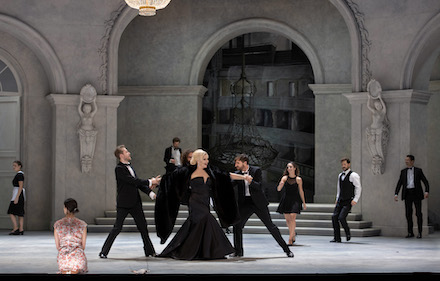
Karita Matilla as the Foreign Princess, with dancers.
The Prince’s fatal Act I hunt is guided by Dvorak’s Huntsman, in Mr. Loy’s post modern vision it is a commedia dell’arte, white-faced Pierrot, yet another reference to a world of mute theater, here a character of silent understanding in search of his Colombine, and as well as the sad clown face of existential despair.
But the crippled Prince too, like Rusalka to her dancing sisters, no longer belongs to the frenetic world just outside the theater walls. Doomed, in the end, by Rusalka’s kiss he drops his forearm crutches a few feet before he falls. Freed now from the fetters of this world he consecrates his love for Rusalka by his death. The Teatro Real does not offer a photo of this sublime moment.
Had I been inside the Teatro Real I would have reveled in the glories of Dvorak’s richly Romantic score surely exploited by conductor Ivor Bolton and the obviously full throated Orquestra Sinfónia de Madrid. As it was there were many, many hints of orchestral magnificence, resonances well beyond the capabilities of my salon audio resources.
Nonetheless I was captivated by the concept and by the performers. I had only known soprano Asmik Grigorian as Salome from my seat at a recent Salzburg Festival from which vantage point I responded to her as a 16 year-old prodigiously endowed with Straussian vocal resources in the context of the Castelucci production. Mme. Grigorian’s voice and body were one as Strauss’s adolescent. Thus it was a revelation to encounter this unique artist in her actual late thirties, maybe 40, in a television production where faces are more important than bodies.
Mme. Grigorian’s voice is pure and silvery, and naturally young. Its production is so secure that it issues forth, even mightily, with seemingly natural ease. Up close we could note aspects of the remarkable technique that underlies such deception. La Grigorian melds body and voice effecting a complex, operatically realized character that is rarely achieved by singers — and exceedingly affective.
In the Christof Loy Rusalka Mme. Grigorian is a ballerina as well as a singer! En point! Not surprisingly, her dance movements were accomplished with evident balletic technique.
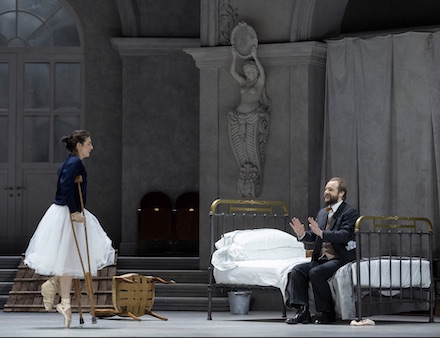
Asmik Grigorian as Rusalka en point, Maxime Kuzmin-Karavaev as Volnik
Eric Cutler in his role debut exhibited secure, powerful singing though the size and scope of the voice cannot be known in a video performance where levels are adjustable. The Act I hunt scene with Mr. Loy’s Pierrot and following aria were hugely effective. Mr. Cutler’s death, in street clothes, his forearm crutches abandoned, found all the pathos of the Dvorak score and at the same time amplified the brilliance of the Christof Loy concept.
Madrid’s Teatro Real is one of Europe’s major theaters, thus casting is informed and appropriate. Swedish mezzo soprano Katarina Dalyman sang Jezibaba, Russian bass Maxime Kuzmin-Karavaev sang Volnik, Spanish baritone Sebastià Peris created the spooky Pierrot Huntsman. Catalan baritone Manel Esteve created the convincing silent screen Charlie Chaplin Gamekeeper together with French soprano Juliette Mars as the Kitchen Boy. Armenian soprano Julietta Aleksanyan, Irish mezzo soprano Rachel Kelly and Russian mezzo soprano Alyona Abramova were the three nymphs.
The video production was well done, offering sufficient full stage shots to instill a larger scenic context while focusing on the changing dramatic circumstances, very occasionally moving to full frame faces. It was filmed for MezzoTV (www.mezzo.tv, available in Canada and Europe, and offered to medici.tv subscribers worldwide at www.medici.tv/en/operas/dvorak-rusalka/. Both MezzoTV and MediciTV will stream the production for a limited time.
Production information
Chorus, Ballet and Orchestra of the Teatro Real conducted by Ivor Bolton. Stage Direction: Christof Loy; Set Design: Johannes Leiacker; Costumes: Ursula Renzenbrink; Lighting: Bernd Purkrabek. Teatro Real, Madrid, November 25.
Three Chamber Operas at the Aix Festival
Along with the celestial Mozart Requiem, a doomed Tosca and a gloriously witty Mahagonny the Aix Festival’s new artistic director Pierre Audi regaled us with three chamber operas — the premiere of a brilliant Les Mille Endormis, the technically playful Blank Out (on a turgid subject), and a heavy-duty Jakob Lenz.
Les Milles Endormis

Gan-ya Beb-gur Akseldrod as Nurit
photo copyright Patrick Berger / Artcompress
Les Milles Endormis is a brilliant piece of real opera by Israeli composer Adam Maor and it was brilliantly staged by its librettist, Israeli poet Yonatan Levy. Four singers and eight instrumentalists (Luxembourg's United Instruments of Lucilin) made a mighty noise — though insufficient to wake up the thousand imprisoned Palestinian hunger strikers the Israeli Prime Minister and his security chief had put to sleep not knowing what else to do with them.
We saw only about thirty of them laid out quite comfortably on the stage only they weren’t asleep as they were actually audience members, like us, watching the show (maybe the only seats they could get for this, the hit show of the Festival).

Tomasz Kumiega as the Prime Minister, Gan-ya Beb-gur Akseldrod as Nurit (extreme right)
photo copyright Patrick Berger / Artcompress
The U.S. president phoned the insomniac (with the rest of Israel) PM to say that he had not vetoed the UN resolution denying rainfall on Israel. Meanwhile Israeli children in the north were having epileptic seizures that left them speaking Arabic.
This provided occasion for the reading of a lengthly newspaper article describing the stricken toddlers. Though it wasn’t read. It was recited in an astonishing Hebrew prose aria by a Cantor wearing a crown of with faceted mirror fragments that ricocheted points of light among us adding even more magic to the Arabic infused musical lines.
The PM’s chronic nightmares are determined to be psychic tunnels dug into Jewish dreams by the sleeping terrorists. The Security Chief takes over, sending in a sleeper agent, the PM’s assistant, Nurit whom he hypnotises in a magical, mystical monologue. In an extended dream aria embellished with Arabic musical gestures, Nurit standing among us on a platform over the orchestra pit in the now lighted hall tells of the spiritual homeland the thousand sleeping souls have founded. It is one soul connecting to another.
This is but the surface of this brilliant, perfect bel canto libretto. The Prime Minister and his adjuncts create quite a mess, thus the PM has much to rage about. The Cantor, the Security Chief and the PM’s assistant Nurit are left to sing their way out of it. Though the subject of the opera may not be bel canto’s classical conflicts, the Mille Endormis’s conflict is indeed a current torment in our minds and hearts.
Like the Brecht/Weill Rise and Fall of the City of Mahagonny, Les Mille Endormis is heavy political satire. But unlike the Brecht/Weill piece it is first and foremost opera as revealed in its profoundly human, emotional resolution that eclipses its conflict.
Composer Maor’s orchestral score includes considerable use of recorded electronically produced sounds, created by the Centre Pompidou’s Ircam (an electro-acoustical music laboratory). The basic musical language is sonic gesture created, with the Ircam component, in the beautifully colored sounds of traditional orchestral instruments — a string trio with added bass viol plus a clarinet. Add to this an accordion and percussion, plus an electronic keyboard. The vocal lines are melodic (moving in steps rather than leaps). The lines are based on normal speech patterns embellished with the Arabic vocal gestures.
Holding all of this together musically was Swiss-Australian conductor Elena Schwarz. It was a conducting tour de force accomplished with visible precision and total command of the deceptively minuscule forces that may as well been those of a Bruckner symphony.
Polish baritone Tomasz Kumiega gave an over the top performance as the Prime Minister, finding his rage, his passiveness, his helplessness and his humanity. American bass David Salsbery Fry displayed a strange and surreal humanity in the black tones of magical incantation hypnotizing Nurit. French tenor Benjamin Alunni accomplished a monumental feat in delivering the huge newspaper account of the stricken children babbling in Arabic with detached cantorial aplomb. Israeli soprano Gan-ya Beb-gur Akselrod intoned the mesmerizing dream of the Israeli who joined the sleeping Palestinians in a world beyond hunger where there is no homeland.
The opera was performed in the small, horseshoe Théâtre du Jeu de Paume on Aix's Rue de l'Opéra.
Blank Out
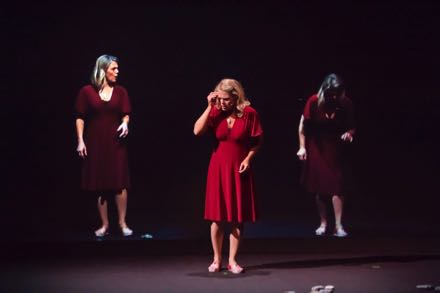
Miah Persson as the young mother in Michel van der Aa's Blank Out
photo copyright Priska Ketterer - Lucerne Festival
The hour long opera Blank Out was created by Dutch composer Michel van der Aa. It was first performed in 2015 under the auspices Pierre Audi’s Dutch National Opera who commissioned the piece. Among other stops before finding its way into the recital hall of Aix's Darius Milhaud Conservatoire it was seen at Mr. Audi’s Park Avenue Armory in Manhattan.
Mr. van der Aa plays with electronic technology in his compositions for the stage (Blank Out is his fifth opera) which are both visual and auditory creations. Blank Out is scored for one live soprano and one recorded baritone on an accompanying van der Aa made video. The video is in 3D thus we were provided with the necessary glasses.
The opera’s gimmick is the presentation of a horrific domestic tragedy — the live-on-stage mother tells of watching her seven-year-old son drown, and later the filmed baritone re-experiences the drowning death of his mother. The artistic intent of Mr. van der Aa’s opera is not so much to operatically create such a shocking, mirrored tragedy as it is to demonstrate how current audiovisual creation and reproduction technology can be harnessed to tell stories. We were first wowed by the doubling of the live soprano on the 3D recorded video screen to make a duet with herself, then we were amazed by the quality of the recorded voice that fully matched the live soprano. And, voilà, it became a trio with herself!
The fully electronic recorded score provided soundscapes where the mother moved to the side of the stage to manipulate a model of a house, the 3D film documenting her re-configurations of the model. It was this model house that we see become as well the real house of the baritone’s mother located on a barren, bleak stretch of sea land reclaimed by a Dutch dike. The video alternates between the recorded image of an actual (real) house and the recorded manipulations of the house model by the live soprano.
With all this going on in vivid, high definition color I struggled in vain to feel anything other than passing interest in the cleverly mirrored domestic tragedies. I did admire the technology, and the solid, if stolid storytelling.
The live soprano was sung by Swedish soprano Miah Persson, the same singer who created the opera’s premiere a few years ago (thus no need to make a new film). Mlle. Persson is a musician of high order, evidenced in the extended, pitch perfect a cappella singing that began the opera. Her pure sounds perfectly embodied the tentative emotions of this young mother, sounds that have made her a Mozart heroine on major stages. British baritone Roderick Williams was the recorded son, well portraying a mature male recalling and then again grieving the death of his mother.
Eight
The Aix Festival partnered with a nearby winery cum architectural art installations, Château La Coste to exhibit Michel van der Aa’s 15 minute virtual reality piece Eight. As Blank Out its narrative is a gimmick. A virtual old woman traces her life in virtual physical re-creations backwards to her eighth year. Note that the shape 8 is a symbol of infinity and that once inside the 20-foot square paddock, capped with headset and earphones, we configured the shape of 8 with our footsteps as we followed our virtual guide, the age inverting female.
The sound tract is the recorded singing of poems and texts compiled by Mr. van der Aa and Australian pop songwriter-singer Kate Miller-Heidke who sings the texts in a weak and breathy, new-age-music voice to electronic accompaniment. The soundscape includes manipulated voices of the Netherlands Chamber Choir.
Virtual reality provided astonishing, infinite vistas, hurling boulders, and finally an intimate, low tent I dutifully squatted to enter where I watched and listened to a virtual eight-year-old girl earnestly telling me something or the other. Standing again I put my hand out to use a wall to steady myself. It was, however, virtual. As was the artistic experience.
Jakob Lenz
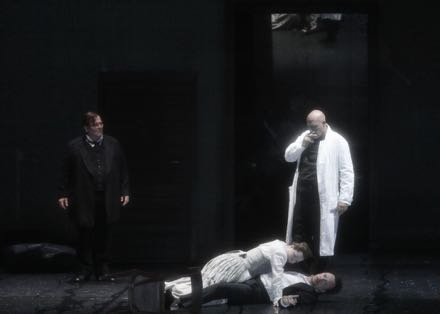
Wolfgang Bankl as Oberlin and John Daszak as Kaufmann (both standing)
Georg Nigl as Lenz (on floor) with doll Friederike
photo copyright Patrick Berger / Artcompress
German composer Wolfgang Rihm’s 1978 one-hour-fifteen-minute chamber Jakob Lenz was given three performances in Aix’s Grand Théâtre de Provence in a major, i.e. great big 2014 production from the Stuttgart Opera.
This Rihm opera completes a trilogy of operas based on the literary works of the German Romantic expressionist Georg Bûchner— Alban Berg’s 1925 Wozzeck, Gottfried von Einem’s 1947 Dantons Tod (The Death of Danton), and the 1978 Rihm Jakob Lenz. Dantons Tod had a major revival at the Vienna State Opera last year. This 2014 production of Jakob Lenz evidently stimulated a revival of interest in composer Rihm, now 67 years-old, as the Salzburg Festival revived his The Conquest of Mexico a year later in a splendid production of rich metaphor by Peter Konwitschny.
Though Bûchner’s Lenz is a novella based on Jakob Lenz’s diary, the Rihm Jakob Lenz librettist, Michael Fröhling configured it à la Wozzeck as 13 short scenes wherein Goethe’s friend, the schizophrenic, strum und drang poet Jakob Lenz is found, half drowned by the parson Oberlin. He takes Lenz to the parsonage with him. Lenz has visions of his beloved Friederike and engages with his friend Kaufmann in a discussion about art. Lenz hears voices that tell him Friederike is going to die, he searches for her only to find an infant on a bed whom he sees as Friederike. He tells her to rise. She doesn’t. He hears voices that tell him to suicide. Oberlin and Kaufmann are powerless to help Lenz. The place him in a straight-jacket. Left alone on the stage he repeats the word ”logical.”
Composed when Rihm was twenty-six years old Jakob Lenz is a neo-expressionist statement, very much in the mold of Wozzeck though without its dramatic and musical interest. The Stuttgart production by venerable German theater director Andrea Breth is in the stratospheric teutonic theatrical mannerisms of unvarnished, ugly reality that typify the German long-ago avantgarde. Here in Aix they read as naive, a language befitting a retro staging of Wozzeck.
The opera Jakob Lenz’s opening image was the poet Lenz falling from the stage loft onto the stage floor (enacted by a acrobat double). It was spectacular, but we were then held captive for the monochromatic duration of the opera. Austrian baritone Georg Nigl sang Lenz, Austrian baritone Wolfgang Bankl sang Parson Oberlin and English tenor John Daszak sang Kaufmann. German conductor Ingo Metzmacher conducted eleven members of Frankfurt’s Ensemble Modern.
The Rise and Fall of the City of Mahagonny at the Aix Festival
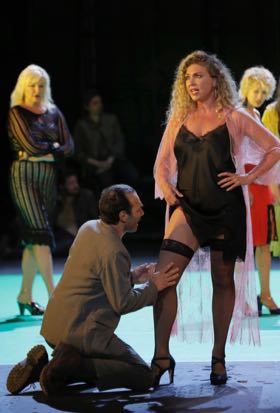
Nikolai Schukoff was Jim Mahoney, Annette Dasch as Jenny
All photos copyright Pascal Victor / Artcompress
Make no mistake, this is about you! Jim laid-out dead on the stage floor, conductor Esa-Pekka Salonen brought his very loud orchestra (London’s Philharmonia) to an abrupt halt. Black out. The maestro then turned his spotlighted face to confront us and he held his stare. There was no mistake, the music was about us.
Stage director Ivo van Hove worked on a wide open, bare sound stage. This was not opera. It was no-where. That was exactly the point, and that is where Fatty, Moses and the widow Begbick built their city Mahagonny to satisfy their greed and our lust.
All this greed and lust were in-your-face — this the orchestra insisted. The maestro gave a loud, very loud, clinical and chiselled reading of the Kurt Weill score from the get-go, making it very clear that it is highly sophisticated, brilliant music, and that it is confrontational.
Mr. van Hove’s staging was confrontational, On the bare stage was a projection screen serving as the glass plate of a microscope under which we would study the faces and the souls of the hordes of men who came to Mahagonny to forget their dreary lives and to indulge their vices and their pleasures. Then came the whores from Alabama and four lumberjacks from Alaska, a bit lost in the visual cacophony of the teeming world.
It was a chaotic stage, but the videographer singled out the faces of our a few of the arrivals while Kurt Weill singled out their voices — Jenny the whore, Jim Mahoney the sensitive, soul searching lumberjack who goes a bit crazy, and his three buddies, Jack the glutton, Joe the boxer and Bill the miser. If their voices were at first nearly lost in the melee, that’s because they were in fact in a melee.
Little by little their projected faces bared their souls to us as their voices grew stronger. The maestro did not indulge the easy rhythms of the Kurt Weill’s jazz, rag time and folk influences. It was musically obvious there was a lot of tough stuff to come.
Jim, the lumberjack, got a bit maudlin and then he got bored. There came a hurricane (three giant fans and a wounded citizen suffering melodramatically on the screen), and Jim had his revelation, and the hordes (well, the thirty men of the Pygmalion Chorus and fifteen supernumeraries) shouted it in our faces. Black out.
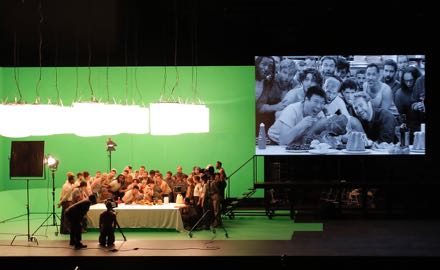
The stage and the screen. Peixin Chen as Joe, Sean Panikkar as Jack (head down),
Thomas Oliemans as Bill at the all-you-can-eat table, with the Pygmalion Chorus
The lid was off — total liberty to totally satisfy any of your cravings, and to get whatever you want. If you can pay for it. A stage was needed to play out the demises of Jack the glutton and Joe the boxer, so one was constructed stage right. There was simulated humping against its back wall, and at the same time we saw very graphic humping projected on the screen, the whore ’s face directly in our face.
Austrian tenor Nikolai Schukoff was Jim Mahoney, the ring leader of it all. Mr. Schukoff is a very charismatic performer, easily projecting a sexuality to be satisfied, but willing to show a softer side and maybe yearn for a better, truer life. Tenor Schukoff is a big performer and easily found the force needed to bust things wide open in Mahagonny (Mr. Schukoff is both a Don Jose and a Siegmund on major stages).
The Rise and Fall of the City of Mahagonny is the epitome of didactic, Epic Theater. These days social commentary wears thin on the opera (or any) stage. As the citizens of Mahagonny were wearying of its corruption we too were wearying. Bertold Brecht maybe was as well, so he added a bit of witty, heavy irony— the Mahagonny inhabitants dream of a new, better city, Bénarès, better known these days as Varanasi, the Hindu city of death. Director van Hove obliged by projecting onto the screen hazy, smokey images of this city of ritualistic cremation as seen from the Ganges.
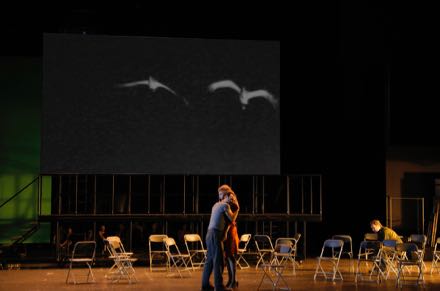
Nikolai Schukoff as Jim, Anette Dasch as Jenny in the final duet.
Jim's friend Bill (Thomas Oliemans) is at the far right.
In the penultimate scene van Hove brought, finally, our total focus and our held back sympathy onto Jim Mahoney when Jim delays his death as long as he can in a long, moving and hopeless monologue, and then makes his farewell to Jenny in a beautiful, tender duet. Here there were no screen projections, there was no microscope. Here was, finally, real human emotion to for us to feel, not to judge.
The Fall of the City of Mahagonny was of the scenic magnitude to equal the gigantic musical efforts emanating from the pit. There was smoke and fire, there was thunder and lightning, more smoke and fire raged from the pit. It was the destruction of Valhalla you have always wanted to see but never got. You have had to settle for Wagner’s pale by comparison account of such cataclysmic destruction.
It was no-holds-barred casting: Karita Mattila as the widow Begbick, Sir Willard White as Moses, Alan Oke as Fatty. The Jenny was German soprano Annette Dasch (a Donna Elvira on major stages) though in this staging Jenny was not given a dominant presence, nor did the staging on the wide open stage provide an acoustic shell to project her voice. The three lumberjacks were of consummate charm and fine voice: Sean Panikkar as Jack, Thomas Allemans as Bill, and Peixin Chen as Joe.
The six prostitutes were gutsy and lusty, very willing to play their parts: Kristina Bitenc, Cathy-Di Zhang, Thembinkosi Magagula, Maria Novella Malfatti, Leonie Van Rheden and Veerle Sanders.
I saw the second of four performances on July 9, 2019.
Production information:
The Philharmonia Orchestra and the Pygmalion Chorus. Conductor: Esa-Pekka Salonen, Mese en scène Ivo van Hove, Scenery and lighting: Jan Versweyveld, Costumes: An d’Huga; Video: Tai Yarden
Tosca at the Aix Festival
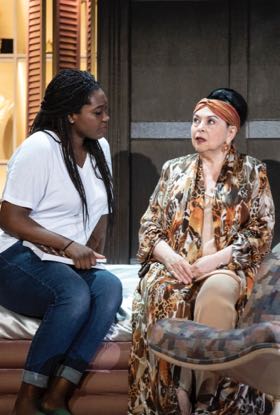
Angel Blue as Tosca, Catherine Malfitano as the old diva
All photos copyright Louis Fernandez
From the sublime — the Mozart Requiem — to the ridiculous, namely stage director Christophe Honoré's Tosca. A ridiculous waste of operatic resources.
Christophe Honoré is a high-profile French film maker and playwright who is a prominent gay activist in this time of a long overdue updating of human rights. This places Mr. Honoré in prime position to become a part of France’s progressive opera world, namely the Aix Festival where he directed the 2016 Ethiopian Cosi fan tutte and the Opéra de Lyon where he directed the 2017 Don Carlos wrapped in stage curtains (until the auto da fé which was stuffed into the galleries of an Elizabethan theater).
Thus it is no surprise that he should be back on the front lines of French avant-garde opera, again at the Aix Festival with a Tosca than he has set in New York City’s Manhattan, or maybe in the far less sophisticated Bronx. It is not Tosca the opera, it is an unsettling tale of the demise of a Tosca diva, Puccini’s magnificent score reduced to a troubling piece of prosaic theater.
Mr. Honoré states in the program booklet that the big question in Tosca is if an artist’s art can protect the artist from life — Tosca’s does not, Cavaradossi’s does not. It would seem that the question need not be asked, since the great, even gigantic gesture in Puccini’s Tosca is release from life. The opera Tosca is an artistic ritual of liberation that can be infinitely repeated. It is not an “impermanent” (descriptive term used by director Honoré) work of art waiting to be used.
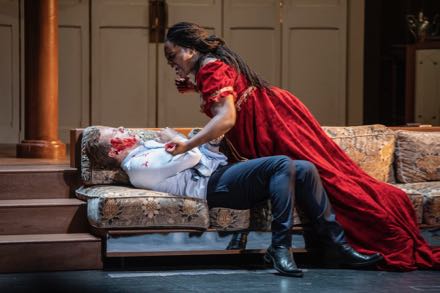
Angel Blue as Tosca in the copy of the dress worn by the Tosca of Maria Callas,
Alexey Markov as Scarpia.
And abused. Abused by the giant screen film adaptations (movies) of real performances that occurred in the past few weeks in Aix cinemas. Or abused by re-writing the story to make the first act the rehearsal for a concert to honor an aged diva, the second act to illustrate psycho-sexual implications of gay diva worship, and the third act to be the concert where the diva is the victim of her art, taking her own life at the conclusion of the concert.
A reading of The Rise and Fall of Gay Culture might suggest that the gay men of the second act vicariously execute the diva to rid themselves of their arch competitor for the seduction of desired males (Cavaradossi, for example).
Then there was the abuse of the audience, making us wait while the orchestra was moved to the stage (no easy process), thus repeating the wait-abuse Mr. Honoré perpetrated on the Lyon Don Carlos audience. And the abuse of the audience by two videographers stalking the stage to capture faces to be continuously projected on giant screens above the stage floor, images of disembodied voices that Mr. Honoré ordains as images of the real (as opposed to the operatic).
The revelation of the evening was the very present, vibrant sound of the Archeveché theater pit evidenced by the huge presence of the excellent orchestra of the Opéra de Lyon. Conductor Daniele Rustioni, music director of the Opéra de Lyon, offered an idiomatically correct reading of the Puccini score, allowing its subtleties to shine forth. The orchestral sound was forceful indeed, though it never competed with the stage for presence. Once on-stage the orchestral sound was nearly magnificent, an unexpected acoustic miracle.
The aged diva of the Christophe Honoré’s Tosca was Catherine Malfitano, once an internationally recognized Tosca. La Malfitano is now seventy-one years old, and retains the remarkable presence that marked her long and distinguished career. She bravely fought her way through this ordeal of uselessness, bravely enduring the ravages of time on the body and voice in this savage vision of artistic demise.
The ingenue Tosca diva was American soprano Angel Blue, already a Mimi on major stages she may yet become a new age Tosca. Maltese tenor Joseph Calleja sang Cavaradossi, his rôle fétishe. His recent Cavaradossi at the Met boasted secure high notes that did not find their way to Aix, the intimacy of the Archeveché theater did not favor his blatant, high-horsepower delivery.
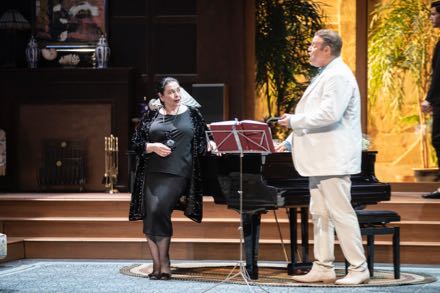
Catherine Malfitano as the Diva, Joseph Calleja as Cavaradossi
Russian bass baritone Alexey Markov provided a trim figured, vocally dark and focused Scarpia. The cluttered, frenetic happenings (lots of gay sex stage-right) on the stage eclipsed his great moments. It was unclear how he fit into the picture. Tosca brutally stabbed him in the face, meanwhile the aged Tosca diva payed a Cavaradossi double for sex. There was so much extra-opera stuff going on I wasn’t sure where to look to discover the essentials. If there were any.
Cast and production information:
La Prima Donna: Catherine Malfitano; Floria Tosca: Angel Blue; Mario Cavaradossi: Joseph Calleja; Il barone Scarpia: Alexey Markov: Cesare Angelotti: Simon Shibambu; Il sagrestano: Leonardo Galeazzi; Sciarrone: Jean-Gabriel Saint Martin; Spoletta: Michael Smallwood; Un Carceriere: Virgile Ancely; Le Majordome: Jean-Frédéric Lemoues; Pompier: Frank Daumas. Orchestre et Choeur de l’Opéra de Lyon; Maîtrise de l’Opéra de Lyon. Conductor: Daniele Rustioni; Mise en scène: Christophe Honoré; Scénographie: Alban Ho Van; Costumes: Olivier Bériot; Lumière: Dominique Bruguière. Théâtre de l’Archeveché, Aix-en-Provence, France, July 6, 2019.
The Mozart Requiem at the Aix Festival
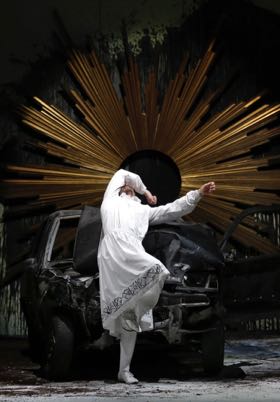
All photos copyright Pascal Victor / Artcompress
Pierre Audi, now the directeur général of the Festival d’Aix as well as the artistic director of New York City’s Park Avenue Armory opens a new era for this distinguished opera festival in the south of France with a new work by the Festival’s signature composer, Wolfgang Amadeus Mozart.
It is, namely, Mozart’s last work, a Requiem Mass left unfinished at his death in 1791, later finished —based on Mozart’s notes and sketches by his student Franz Saver Süssmayr. In this Aix edition it has been reconfigured and expanded by French musical visionary Raphaël Pichon, a conductor well-known at the Aix Festival, and by Italian theater visionary Romeo Castelucci in a belated, long awaited Aix debut.
But this “Mozart” Requiem is now a theater piece somewhat beyond, actually well beyond Mozart’s setting of the Catholic death mass liturgy. His widow Constanza pretended he composed his own requiem, and in Aix it was indeed just that — Mozart’s moment of life long vanished, conceptually the “Aix” Requiem insists that Mozart’s Requiem Mass will vanish as well.
Discovering this existential tragedy made the Castelucci Aix debut well worth the wait. In his Brussels Parsifal, his Lyon Jeanne d’Arc au Bûcher and his Salzburg Salome Sig. Castelucci is fettered by narrative, and imposed philosophical concept and psychological involvement. But in this Aix Requeim, like in his Tragedia Endogonidia cycle, he freely traverses ephemeral human atmospheres filled with unanswered questions that are met with spontaneous reactions. It is rare access to the most hidden theatrical realms of the human psyche.
Like the non-verbal, purely intuitive communicative process of music Castelucci’s language is the non-verbal communicative power of essential theater. There is no intelligence and there is no interpretation, there is but momentary recognitions of an intuited physical reality.
From its first moment in this Aix Requiem, a lone, older woman is perhaps at her death, the requiem passes through her four, simultaneous existences in identically dressed embodiments — a child, a virgin, a mother, and this old woman. The Aix Requiem ends with their issue — a baby alone on the silent stage. A male.
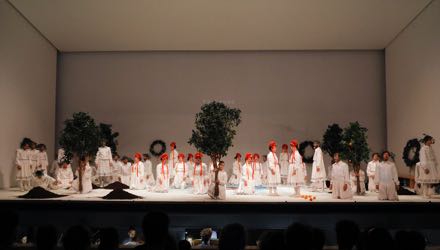
Musically the Requiem begins with the disembodied voice of a male child (soprano) intoning an anonymous Gradual (a response refrain normally sung between recitation of psalms): “Christus factus est.” It insists that the will of God be imposed on man. It is sung in the purest sounds of male innocence.
The usual requiem liturgies of praise and pain continue though interspersed by conductor Pichon with other Mozartian moments — a Masonic hymn, a Psalm setting, the reuse of a piece from his incidental music to Thamos Roi d’Egypte, a solfeggio (sung by the boy), an Amen, the parody of a Serenade, a church song. The Aix Mozart Requiem ends with again the lone voice of the boy intoning an anonymous “In Paradisum” (sung at the moment the body exits the church) — the will of God fulfilled.
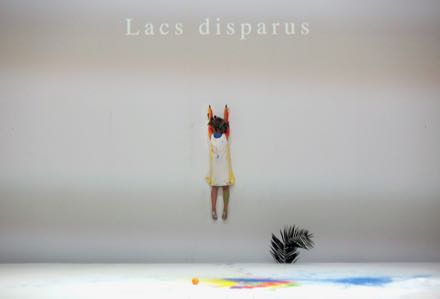
There passed before our eyes an abstracted cruxifiction (the young girl), a forest, a maypole, a wrecked car, the Pygmalion chorus and four soloists of purest voices (soprano, alto, tenor, bass) intoning the liturgies first in the clothes they wore to the theater (a heat-wave in Aix), transforming themselves in courtly white unisex dresses, then in celebratory courtly crimson unisex robes, finally in muslin tunics for the "Agnus Dei" before decaying into a chiaroscuro mass of naked bodies. The complex choruses issued forth while the singers created the structures of the music in abstracted movement, often dance, impeccably carving the interlocking phrases of Mozart’s fugues to construct the technical grandeur of mankind’s accomplishment.
The coup de théâtre was the cataclysm that occurred in the "Communion" of the requiem liturgy, the souls becoming one with God shouting their jubilation, tearing down the white walls of the world. The floor of the stage slowly rose, becoming vertical, the debris of the wall and black dirt of the world randomly sliding down to reveal, finally, a blank, white wall. Death. Silence.
From beginning of the Requiem to its end continuous words streamed across the stage box, naming the now vanished accomplishments of man and nature. The final words, incised, were July 5, 2019 — the day I saw the Aix Requiem.
With, then, the lone male child — the creator — alone on the stage we were left with the finality of death, and the image of creation. There was no comfort in rebirth.
The stage was the music, and the music was the stage. Maestro Pichon’s Pygmalion orchestra of period instruments was the voice and the world of man, the solo winds of purest sound, of psychological innocence, the solfeggio violin duet with the boy soprano giving corpus to nature. The eloquence of the requiem liturgies ceaselessly emerged from the pit in crystal clear phrasing that created profound, truly human embodiment for this mass of death.
This Mozart / Pichon / Castelucci Requiem occurred in the most minimal terms. The chorus sang without score, the stage was but a white box. It was sublime music made alive in pure theater.
Cast and production information:
Conductor: Raphaël Pichon; Mise en scène, scénographie, costumes, lumière: Romeo Castellucci; Collaboratrice à la mise en scène et aux costumes: Silvia Costa; Dramaturgie: Piersandra di Matteo. Chorus and Orchestra: Pygmalion. Soprano: Siobhan Stagg; Alto: Sara Mingardo; Ténor: Martin Mitterrutzner; Basse: Luca Tittoto; Enfant chanteur: Elias Pariente. Théâtre de l’Archeveché, Aix-en-Provence, July 5, 2019.
Barbe-Bleue at the Opéra de Lyon
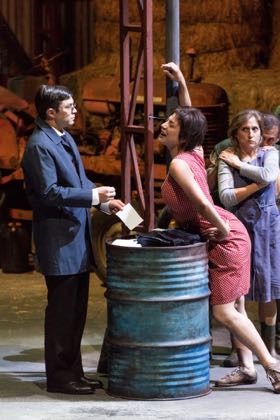
Christophe Gay as Popolani, Héloise Mas as Boulotte
All photos copyright Stofleth
Stage director Laurent Pelly is famed for his Offenbach stagings, above all others his masterful rendering of Les Contes d’Hoffmann as a nightmare. Mr. Pelly has staged eleven of Offenbach’s ninety-nine operettas over the years (coincidently this production of Barbe-Bleue is Mr. Pelly’s ninety-eighth opera staging).
Unlike Mr. Pelly’s straight forward, very charming Peruvian fantasy, La Perichole that I saw at the Marseille Opera in 2002, or his parody of The Barber of Seville (sung on top of sheets of musical score paper) seen at the Marseille Opera in 2018 (boasting the hyper personalities of Stephanie d’Oustrac as Rosina and Florian Sempey as Figaro), here Mr. Pelly’s Barbe-Bleue is set on a farm near Paris and in a grand salon in the Élysée Palace, with actors of limited personality.
The real Barbe-Bleue is the 1619 folk fairy tale by Charles Perrault which Offenbach parodies à la Second Empire. But Mr. Pelly’s stretches the parody to include a parody of his own — that of opera stagings which imitate the criminal underworld (Bluebeard is dressed and acts like a mobster) and a parody of mindless operettas (King Bobeche is a pompous fairy tale king with a silly fairy tale court).
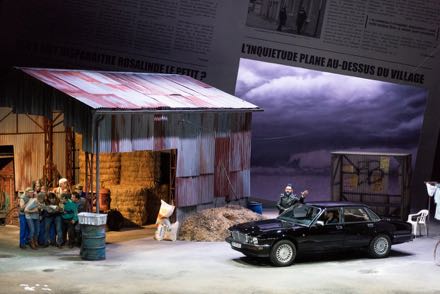
The Farm
The time is now or maybe not-so-long-ago. We see a backdrop that is a latest edition newspaper, two front page articles discuss the strange murders. There is a tractor and chicken sounds and some bales of straw to convince us that all this is somehow what real is. Then we see a huge shelf of weekly revues (magazines), those that thrive on news of lurid allure, maybe true and maybe not. It is a side wall of the grand salon in which such tales of the rich and powerful evidently take place.
All this operetta scenery did not add up to a convincing stage for Offenbach’s amusing serial murders, particularly when we saw the refrigerated lockers of a morgue where Bluebeard’s victims are stored. We do know that "bluebearding" women (serial murder of women) is a real, recognized syndrome, but Mr. Pelly and his long-time designer Chantal Thomas only confused us about what may be real and what may not be.
From copious accounts we know that Offenbach’s muse during his very productive years at the Théâtre des Variétés was mezzo-soprano Hortense Schneider. We read of the very great charm of her performances but, alas, we have no digital records of them. Plus what was charming in the Parisian 1860’s may not charm us these days.
It is however the charm, whatever it may be, of an Offenbach heroine that wins our attention and ushers us into his music. The Lyon Boulotte (the Hortense Schneider role) was bravely undertaken by Héloise Mas who can indeed boast Boulotte’s “Rubenesque” body. Mlle. Mas was directed to be a bratty, tomboy rustic — maybe Mr. Pelly’s idea of real — forgetting that first of all Offenbach’s Boulotte must be a comic diva.
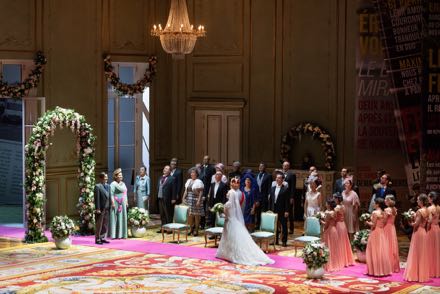
The Palace
Bluebeard himself, played by tenor Yann Beuron, was directed to be oily, dangerous and thoroughly unsavory. Though not the usual mild-mannered, reclusive murderer we read about in actual newspaper accounts of such murders, perhaps Mr. Beuron’s Bluebeard fulfilled Mr. Pelly’s idea of a real murderer.
If the two protagonists of the Lyon Barbe-Bleue were meant to be real, the balance of the cast was rendered quite irreale. Prince Saphir played by Carl Ghazarossian and Popolani played by Christophe Gay were physically willowy, and both had an annoying lock of hair that fell across their faces. Count Oscar was willowy as well. The three men exuded a similar maximal energy in executing their roles while avoiding any distinguishing personality or character.
Fleurette, played by soprano Jennifer Courcier, King Bobeche played by Christophe Mortagne and Queen Clementine, played by Aline Martin were stock operetta characters. The thirty-six choristers were directed as if they were collectively one character — they made unison, abstractly choreographed movements.
Maybe a less slick reading of the score by conductor Michele Spotti and a less slick performance by the Opera de Lyon orchestra might have allowed a bit of Barbe-Bleue’s innate charm to slip through.
Cast and production information:
Barbe-Bleue: Yann Beuron; Le Prince Saphir: Carl Ghazarossian; Fleurette: Jennifer Courcier; Boulotte: Héloïse Mas; Popolani: Christophe Gay; Le roi Bobeche: Christophe Mortagne; Le Comte Oscar: Thibault de Damas; La reine Clémentine: Aline Martin. Orchestre et Chœurs de l'Opéra de Lyon. Conductor: Michele Spotti; Mise en scène et costumes: Laurent Pelly; Adaptation des dialogues: Agathe Mélinand; Décors: Chantal Thomas; Lumières: Joël Adam. Opéra Nouvel, Lyon, France, June 22, 2019
Don Giovanni at the Opéra Garnier, Paris
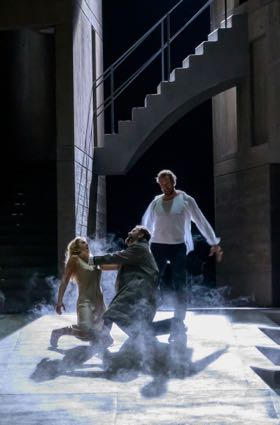
Jacquelyn Wagner as Donna Anna, Etienne Dupuis as Don Giovanni,
Ain Anger as Don Pedro (Donna Anna's father)
All photos copyright Charles Duprat
A brutalist Don Giovanni at the Palais Garnier, Belgian set designer Jan Versweyveld installed three huge, a vista raw cement towers that overwhelmed the Opéra Garnier’s Second Empire opulence. The eight principals faced off in a battle royale instigated by stage director Ivo van Hove. Conductor Philippe Jordan thrust the Mozart score into the depths of expressionistic conflict.
Et voilà, one of the great evenings in the theater. And yes, it was not subtle.
Conductor Jordan immediately pounced on the musical tensions that structure late eighteenth century music and did not let go. The ensuing, unrelenting drama from the pit creating the antagonism between Giovanni and Leporello, with Leporello cruelly rubbing in Giovanni’s sexual exploits to Elvira, Masetto angrily snapping at Zerlina, Giovanni coldly setting up the ambush of Leporello.
Don Ottavio took resolute charge of the vengeance to come, Giovanni brutally beat-up Masetto. Donna Anna, horrified at her aggressor, selfishly cruel to Don Ottavio. Elvira doggedly chased Giovanni, Giovanni focused full determination to seduce the perfect woman. Leporello, finally losing all patience with Giovanni, picked up the Commendatore’s dinner table and threw it across the room.
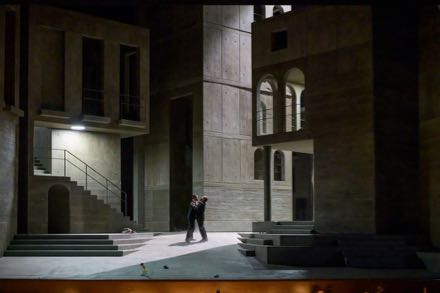
Don Giovanni and Leporello
Giovanni went straight into the seething hell that had been leaking steam through the stage floor from the downbeat of the overture.
And, by the way, Mozart wanted three orchestras on the stage for the Act I finale. There they were, no room for much else, the country dance and the waltz chiming in with the minuet to create a quite Classical idea of cacophony to match the mess on stage.
This Don Giovanni is a gloves off release for all your pent up Don Giovanni hostilities. No wimpy Don Ottavio, no Freudian Donna Anna. No bumbling Masetto or cute Zerlina, no heroic or lonely or debauched Giovanni.
It was pure Mozart, and it was pure Don Giovanni, no questions asked.
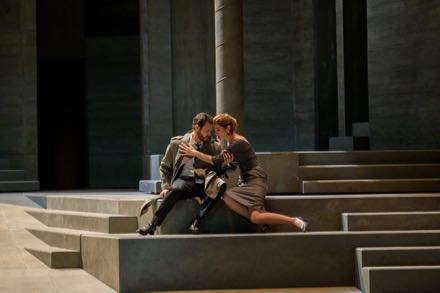
Philippe Sly as Leporello impersonating Don Giovanni, Nicole Car as Donna Elvira
To accomplish this musical and dramatic feat the Opéra de Paris assembled a very handsome cast indeed of fine, beautifully voiced young singers who confronted one another face to face when not nose to nose. Giovanni tall, slim and bearded, Leporello tall, slim and bearded (no Act II suspension of disbelief necessary), Donna Anna obviously very worthy prey, Masetto wiry, sharp witted and energetic, the Commendatore towering in presence and in voice.
Thus it is no understatement to say the the evening was an orgy of Mozartian phrasing, maestro Jordan’s orchestra sharply defining the musical parameters, carving out strategic dramatic plains against which the vocal lines etched themselves.
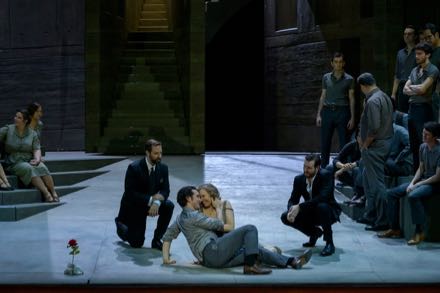
Étienne Dupuis as Don Giovanni, Mikhail Timoshenko as Masetto, Elsa Dreisig as Zerlina, Philippe Sly as Leporello<
The unique colors of each of the voices defined its character — the suavity of the Don’s Act II serenade, the sophistication of Leporello’s “Madamina,” the narcissism of Donna Anna’s “Non mi dir,” the voluptuous of Donna Elvira’s “Mi tradi,” the confidence of Don Ottavio’s “Il mio tesoro” (though sung partly in fetal position), the free and easy sexuality of Zerlina’s “Vedrai carino.”
With a virtuosity and sense of phrasing surely equal to the voices designer Jan Versweyveld lighted his concrete walls, pulling out components of its geometric shapes in light and dark grey based colors, save the saturated gold that flooded the stage for the masked trio “Protegga, il giusto cielo.” Designer Versweyveld served as well as the dramaturg of the production.
Stage director Ivo van Hove and conductor Philippe Jordan created a production that took Mozart’s masterpiece to its bare bones with a myriad of hidden sophistications. This Don Giovanni is a daring creation of great wit and profound sensitivity to Mozart’s masterpiece.
French bass-baritone Etienne Dupuis was Don Giovanni, Canadian bass-baritone Philippe Sly was Leporello. American soprano Jacuelyn Wagner was Donna Anna, Australian soprano Nicole Car was Elvira. French tenor Stanilas de Barbeyrac sang Don Ottavio. Russian Mikhail Timoshenko and Franco-Danish Elsa Dreisig were the Masetto and Zerlina. Estonian bass Ain Anger sang the Commendatore.
Opera and theater director Ivo van Hove directs Kurt Weill’s The Rise and Fall of the City of Mahagonny at the Aix Fesitival next month (July). Note that this Don Giovanni travels to the Metropolitan Opera next year. Conductor Philippe Jordan this summer again conducts the deconstructed Die Meistersinger at the Bayreuth Festival.
The understated, simple costuming for this production was created by An D’Huys, the impressive hell video was created by Christopher Ash.
I saw the fourth (June 21, 2019) of eleven performances.
The Enchantress (Tchaikowsky) in Lyon

Migran Agadzhanyan as the Prince's son, Elena Guseva as the Enchantresse
Photos copyright Stolteth, courtesy of the Opéra de Lyon]
Dido and Aeneas, Il ritorno d’Ulisse and Tchaikowsky’s L’Enchantresse, the three operas of the Opéra de Lyon’s annual late March festival all tease destiny. But far more striking than the thematic relationship that motivates this 2019 festival is the derivation of these three productions from the world of hyper-refined theater, far flung hyper-refined theater.
Of rich theatrical interest are the two new productions — Hungarian stage director David Marton’s Dido and Aeneas filtered though Berlin’s late, lamented Volksbühne, and Moscow-formed Ukrainian stage director and theatre theorist Andriy Zholdak’s The Enchantress filtered through the filmic lens of the 1950’s and 60’s (Fellini, Bergman). Of less interest but still of enormous pleasure was Monteverdi’s Il ritorno d’Ulisse, revived in the 1999 William Kentridge South African life-size puppet theater production, sung by members of the Opéra de Lyon young artist program.
Andriy Zholdak’s staging of Tchaikowsky’s The Enchantress is nothing less than monumental. The Enchantress is the ninth of Tchaikovsky’s eleven operas (Eugene Onegin is the fifth, Mazeppa the seventh, Pique-Dame and Iolanta the tenth and eleventh respectively). It is Tchaikovsky’s lengthiest work (just under four hours with one intermission) that only recently is finding its way into the repertory after a tepid reception back in 1887.
Mr. Zholdak makes a strong case that The Enchantress is one of opera’s great theatrical moments, or maybe it was conductor Daniele Rustioni who made the case. Working together the two artists kept their audience spellbound for the duration, the orchestra unflaggingly sustaining the unrelenting tension on the stage.

A bedroom juxtaposed to Prince's dining room, with faces of two adolescent girls
seated center back watching action, video projected
A priest, probably a surrogate Mr. Zholdak, extinguished candles in Lyon’s St. John the Baptist cathedral, climbed into a limousine to arrive at Lyon’s Opéra Nouvel (we watched this on video). Arriving onto the stage he contemplated a game of chess, a game that soon moved to the beautiful Nastasia’s humble inn where he engaged her in a game. Four hours later, a few chess boards and a card game later dressed in a green suit he batted tennis balls against the inn’s walls during the wrenching lament of the opera’s antagonist (who had just murdered his own son).
Early on the priest planted a camera in the eye of crucified Jesus then donned virtual reality goggles to watch and encourage things to go from bad to worse. The Prince’s son stopped by the inn briefly. At the mere sight of him Nastasia fell in love. The Prince stopped by a few minutes later and fell madly in love with Nastasia. Neither the Prince’s wife nor the Prince’s son could abide the Prince’s infatuation with Nastasia.
Like in a dream seemingly random images flowed hour after hour alongside, though of course they were related somehow. Location somehow shifted between Nastasia’s mean little wooden inn, the Prince’s towering, blinding white dining room, Nastasia’s boudoir, and a stone chapel with a huge, crucified Jesus. A catalogue of sexual desires were fulfilled, fantasy murders were enacted. A story was somehow told (the Prince’s wife poisons Nastasia, the son renounces his mother, the prince murders his son in a fit of jealous rage).
Tchaikovsky’s score turged on, magnificent arias, magnificent rages, ecstatic duets, huge choral climaxes (though we never actually saw the chorus). Alternative Images flowed unbound, uncontrolled by linear narrative. Zholdak’s world unfolded in an unparalleled display of theatrical craftsmanship, both artistic and technical. Tchaikovsky’s orchestral world spewed forth in unbridled emotion like no Tchaikovsky score you have heard before.

Three (of four) constantly moving scenic elements, crucified Jesus in white light
The Opéra de Lyon assembled an exemplary cast. Beautiful Russian soprano Elena Guseva inhabited the temptress role to perfection in beautiful, warmly Russian tone that never faltered through the punishing several hours of singing. Former Los Angeles Opera young artist, Russian tenor Migran Agadzhanyan gamely played with his teddy bear, soundly berated his mother and ardently declared his love for Nastasia in a total performance. Russian mezzo soprano Ksenia Vyaznikova was unrelentingly terrifying as the mother in music that explored the full mezzo vocal and histrionic range. Azerbaijan baritone Evez Abdulla reveled in splendidly baritonal self indulgent swagger as first the love sick prince then the tortured father.
Polish bass Piotr Micinski played the priest Mamyrov in an amazing display of body language and dramatic concentration in his constant, silent presence as the star of Zholdak’s and now Tchaikovsky’s dream. It was a performance of absolute virtuosity. Of note also was the physicality of the sorcerer Koudma sung by Siberian baritone Sergey Kaydlov. The myriad of secondary roles were sung in fearsome Russian both by Russian singers and by the French artists who appear regularly at the Opéra de Lyon.
Cast and productionThe Enchantresse Princesse Eupraxie Romanovna: Ksenia Vyaznikova; Mamyrov: Piotr Micinski; Prince Youri: Migran Agadzhanyan; Nenila, sa sœur: Mairam Sokolova; Ivan Jouran: Oleg Budaratskiy; Nastassia (surnommée Kouma): Elena Guseva; Loukach: Christophe Poncet de Solages; Kitchiga: Evgeny Solodovnikov; Païssi: Vasily Efimov; Koudma: Sergey Kaydalov; Foka: Simon Mechlinski; Polia: Clémence Poussin; Balakine: Daniel Kluge; Potap: Roman Hoza; Invité: Tigran Guiragosyan. Orchestre et Chœurs de l’Opéra de Lyon. Conductor: Daniele Rustioni; Mise en scène et décors: Andriy Zholdak; Lumières: Andriy Zholdak et les équipe lumières de l'Opéra de Lyon; Décors: Daniel Zholdak; Costumes: Simon Machabeli; Vidéo: Étienne Guiol. Opéra Nouvel, Lyon, France, March 24, 2019.
Dido and Aeneas in Lyon
Henry Purcell’s masterpiece Dido and Aeneas is of sufficient dramatic magnitude to command an evening in and of itself. However its brief, fifty minute duration does not fill an evening at the opera. It is an unsolvable problem.

Dido and Aeneas with chorus members
The Opéra de Lyon offered just now a novel solution — the immersion of Dido’s tragedy and Aeneas’ destiny into a larger piece of conceptual theater. Such theatrical exercise has had impressive precedent at Berlin’s Volksbühne with works like famed director Frank Castorf's dismembering of Dostoyevsky’s Insulted and Humiliated in a seven hour sitting, and Schumann’s setting of Goethe’s Faust Book II ignored in a seven hour sitting because the director decided he didn’t know what to do with it so they would simply stage something or the other on the set built for the opera, never mind that the actors had learned to sing its lines.
Volksbühne formed Hungarian stage director David Marton and his dramaturg Johanna Kobusch knew exactly what to do with Dido and Aeneas to make it into a two hour evening — they sank it into an archeological dig, building on the current scientific myth that time moves in circles. Thus you are where you have already been revealing the multiple civilizations present in Purcell's Dido and Aeneas.

Juno and Jupiter (lower left) video projected (note presence of videographer)
Cleverly Mr. Marton turned to Virgil to find lines for toga-attired Jupiter and Juno to speak while they dug in a covered dig finding artifacts of our tech age. Finnish composer Kalle Kalima created convincing noises and some fine new music from time to time to make much of the spoken episodes into a melodramma of sorts (speech with music). These spoken episodes related the adventures of Aeneas, amplifying the evening beyond the personal tragedy of the queen of Carthage to encompass a larger vision of humanity. Aeneas himself, sung by Guillaume Andrieux revealed himself not only a fine singer but also a high-style actor.
Purcell’s little tragedy did find its way into the melée from time to time, Belinda, sung by a matronly Claron McFaddon, offering sage advice over drinks to Dido, sung by soprano Alix le Saux, dressed for cocktails. A huge black period dress was provided to Mlle. le Saux for Dido’s, "When I am laid, am laid in earth," though this did not manage to support the lament which had little of the wrenching gravity that makes this aria one of opera's towering masterpieces.
There was a striking Volksbühne moment. The face of Icelandic actor, Thorbjörn Björnsson (a former Volksbühne actor), was painstakingly revealed as the dirt covering it (he was fully buried in the dirt of the excavation) was slowly brushed away by Juno (we watched this procedure on video close-up).

Face of buried Jupiter becoming apparent, brushed by Juno, video projected from excavation pit.
Swiss performance artist Erika Stucky (born in San Francisco) made all sorts of vocal noises pinch-hitting as Purcell’s witch plus scrunching cellophane, dragging a shovel, etc. These added bits of performance art were annoying to some of us. Many in the audience had had enough and exited the theater during her bits.
Of particular pleasure were Purcell’s madrigals, gracefully performed by members of the Opéra de Lyon chorus. These highly skilled singers articulated Purcell’s voice lines in ways that added a textural lightness through which new layers of meaning emerged. A sizable string orchestra comprised of members of the Opéra de Lyon orchestra gave a bright sound to what little Purcell we actually heard, as well as to the added intermezzos and their musical destruction by composer Kalle Kalima (dressed in a white suit, he sat with his electric guitar on a high platform in the orchestra pit). Conductor Pierre Bleuse obliged with all the necessary moods.
The production had the feel of a clique of artists who got together to do something they thought was cool. The audience at the performance I attended had little patience for it.
Cast and productionDido and Aeneas Didon: Alix Le Saux; Enée: Guillaume Andrieux; Belinda: Claron McFadden; Esprit / chant / interludes: Erika Stucky; Juno / comédienne: Marie Goyette; Jupiter / comédien: Thorbjörn Björnsson. Orchestre et Chœurs de l’Opéra de Lyon. Conductor: Pierre Bleuse: Concept et mise en scène: David Marton; Composer: Kalle Kalima; Décors: Christian Friedländer; Costumes: Pola Kardum; Lumières: Henning Streck; Vidéo: Adrien Lamande; Dramaturgie: Johanna Kobusch. Opéra Nouvel, Lyon, France, March 23, 2019.
Orfeo ed Euridice in Rome
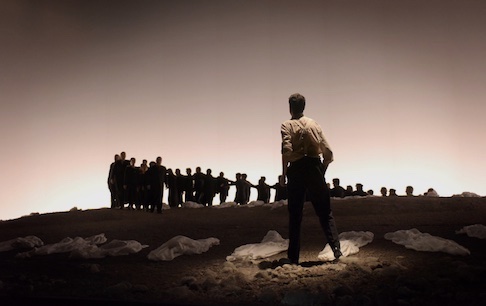
Carlo Vistoli as Orfeo, Mariangela Sicilia as Eurydice
All photos courtesy of the Teatro dell'Opera di Roma]
No wrecked motorcycle (director Harry Kupfer’s 1987 Berlin Orfeo), no wrecked Citroen and black hearse (David Alagna’s 2008 Montpellier Orfée [yes! tenorissimo Roberto Alagna was the Orfée]), no famed ballet company (the Joffrey Ballet) starring in L.A. Opera’s 2018 Orpheus and Eurydice).
In Rome there was but an excavated grave.
It was Canadian stage director Robert Carsen’s 2006 Lyric Opera of Chicago take on the ancient Orpheus legend as told by Virgil in his Georgics and then reimagined in 1762 Vienna by Christoph Willibald Ritter von Gluck — these days simply called Gluck — as a one and one half hour azione teatrale.
Mr. Carsen revived his production of Gluck’s azione teatrale last November (2018) in Paris with famed French counter-tenor Philippe Jaroussky and French soprano Patricia Petibon, and just now (March 21) he staged it again in Rome with an all-Italian cast and conductor. Note that when Gluck refashioned his opera in French for 1774 Paris it became a full-blown drame héroique, Orphée was now a non-controversial haute-contre (a naturally high tenor voice) rather than a contralto castrato (a voice once disliked by the French), and of course Gluck added airs, choruses and dances to make a lengthier evening.
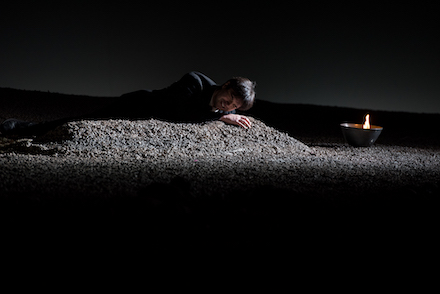
Carlo Vistoli as Orfeo with Act I mourners
Back in 1762 Vienna there were two brief dances in the drama — one by the infernal spirits, another by the Elysian spirits — and now in Rome (as well as Paris!) there were none. Robert Carsen’s stage was but a bed of pebbles, an excavated grave, a hand held bowl of fire and a sky. The black silhouettes of mourners bemoaning the death of Eurydice transformed themselves into barely visible, supine, white covered infernal spirits who slowly transformed themselves into black silhouetted blessed spirits, movement that sufficed to prolongate Gluck’s drama.
If there was actual dance in the Carsen Orfeo ed Euridice it was in the duet of Euridice’s escape from hell. Euridice, beautifully sung by Mariangela Sicilia, repeatedly implored Orfeo to place his loving gaze upon her, when he did not she turned away in dismay. Orfeo then faced the back of her head to beg her repeatedly to wait. She would not.
The emotional stillness of director Carsen’s bleak choral landscape was initially shattered by Orfeo’s thrice repeated,“Euridice” in a spine chilling cry by Italian counter-tenor Carlo Vistoli. Mr. Vistoli is the perfect swain — young, handsome, masculine, immaculately groomed musically, endowed with a beautiful contralto voice. Though Gluck’s arias for Orfeo were much simplified from the highly ornamented singing of the Baroque, Mr. Vistoli did not eschew adding the occasional appoggiatura. These chokes and sobs rendered his laments heart wrenching.
If conductor Gianluca Capuano normally conducts period instrument orchestras, in Rome he revelled in exploiting the resources of a modern symphonic ensemble (the Rome Opera orchestra) to create an immediacy that did not falter through the intermission-less duration. It was a close reading of Gluck’s score that left no emotive phrase unremarked, taking us to an emotional level that in fact betrayed Gluck’s intention to purge Baroque opera of its excesses.

The great tension of Baroque opera is love vs. duty. It is indeed this same tension that pervades Gluck’s reform opera. It is Orfeo’s duty to not look at Euridice, and finally it is his love for Euridice that forces him to forsake his pledge, his passion overwhelming the art that had so moved the infernal spirits.
By the time we arrived, with Orfeo, to his “Che faro senza Euridice” we were all in a state of utter despair, Gluck’s azione teatrale having become an expressionistic nightmare.
Fortunately Gluck’s Amore, sung by Hungarian born, Italian formed soprano Emöke Baráth, saved the day reuniting Orfeo and Eurydice through the power of love, thus averting Orfeo's suicide, indeed the mass suicide of all of us who, with Orfeo, had endured the tragedy of this splendid evening.
Cast and production
Orfeo: Carlo Vistoli; Euridice: Mariangela Sicilia; Amore: Emöke Baráth. Orchestra and chorus of the Teatro dell'Opera di Roma. Conductor: Gianluca Capuano; Production: Robert Carsen; Sets and Costumes: Tobias Hoheisel; Lights: Robert Carsen and Peter Van Praet. Teatro dell'Opera, Rome, Italy, March 21, 2019.
La Pieta in Rome

Michelangelo's Pietà in the Vatican [Wikipedia photo]
Say "La Pietà" and you think immediately of Michelangelo’s Rome Pietà. Just now Roman Oscar-winning film composer Nicola Piovani has asked us to contemplate two additional Pietà’s in Rome, a mother whose son is dead by overdose, and a mother whose son starved to death.
Composer Piovani’s La Pietà is subtitled a "Stabat Mater" per due voci femminili, voce recitante e orchestra. The work makes use of the 13th century poem/prayer “Stabat Mater Dolorosa,” probably by Jacopone da Todi, known to literary scholars not only as a poet who explored primitive vernacular Italian but also as a visionary of medieval liturgical theater.
Mr. Piovani’s Stabat Mater is theater only in so much as it is made of words and needs the immediacy of live performance to take flight. Mr. Piovani’s Pietà is opera only in so much as it uses voice with music (melodramma) and song (arias and duets). Maybe it can be called opera theater because there is are threads of narrative that unfold, and a conclusion is reached — the maternal contemplation of the fact of her child’s death.
The single performance, March 20, did take place in the Teatro Costanzi (Rome’s opera house) thus adding default spectacle. A performance platform sat in front of the covered proscenium (hiding the current Gluck Orfeo ed Euridice installation). Thrusting well into the audience this stage instilled a welcomed urgency into the performance.

Composer/conductor Nicola Piovani, Actor Giogi Proietti
All photos courtesy of the Teatro dell'Opera di Roma
Mr. Piovani composed this work in 1998 to verses by his friend Vincenzo Cerami (deceased in 2013), the screenwriter for Roberto Benigni’s Life is Beautiful, the film for which both Mr. Pioveni and Mr. Cerami received Oscars. Originally scored for 14 instruments at its premiere that same year the spoken role was taken by Mr. Piovani’s friend, actor Gigi Proietti, then 58 years old.
At the Teatro Costanzi just now 78 year-old Mr. Proietti was again the voce recitante. Mr. Proietti and Mr Piovani are now very well known and very respected figures in Italian film and theater thus Teatro Costanzi was filled to capacity with an enthusiastic and supportive audience.
To say that composer 72 year-old Piovani is prolific is an understatement. He has created the musical scores for 148 films and 49 plays and as well as has created 17 theater works (voices with music) plus a number of interesting chamber and orchestral works. Fortunately Nicola Piovani is a also very good composer.
For this performance of La Pietà Mr. Piovani expanded his chamber ensemble to symphonic proportions (the Rome Opera orchestra) — double winds with a full string complement (12/10/8/6/4), harp, two keyboards, expanded percussion plus a saxophone and batterie. The composer conducted.

Amii Stewart, soul singer, and Maria Rita Combattelli, soprano
The six movements of La Pietà / Stabat Mater interspersed orchestral intermezzi with spoken excerpts from Jacopone da Todi’s prayer (both translated and in medieval Latin), alternating with the histories, spoken and sung, of the lives of two young men. One was from an affluent Europe, the other from third world Africa. The European mother was sung by Maria Rita Combattelli, a high (stratospheric) soprano, amplified only because all voices were amplified, the African mother was sung by African soul singer Amil Stewart. Gigi Proietti brought expected high style theatrical delivery of the text.
Mr. Piovani is a master of descriptive music, and he is very adept at diverse styles ranging from soul and pop to symphonic styles ranging from easy listening to avant-garde minimalist structures. All the styles were beautifully expanded to symphonic proportions. The art of the evening was not in the workmanlike creation of these musical styles as much as it was in the lively juxtaposition of the styles in service to a complex, emotional text.
It was a beautifully performed and presented evening, greatly appreciated by its audience.
The Outcast in Hamburg

The Elbphilharmonie in Hamburg, Herzog & De Meuron architects
Photo copyright Thies Rätzke, all photos courtesy of the Hamburg Philharmonie
It is a “a musicstallation-theater with video” that had its world premiere at the Mannheim Opera in 2012, revived just now in a new version by Vienna’s ORF Radio-Symphonieorchester Wein for one performance at the Vienna Konzerthaus and one performance in Hamburg’s magnificent Elbphilharmonie (above). Olga Neuwirth’s The Outcast and this rich city are imperfect bedfellows!
Austrian composer Olga Neuwirth’s muse is injustice fuelled by discrimination and the abuse of power, themes that she welcomes in this retake on Herman Melville’s Moby Dick. The more sensational content of “the great American novel” is extracted and elaborated to make a sort of dramatic action supported by a musical score of great interest and indeed considerable appeal.
With the proliferation of our current “news and commentary” hungry culture Mme. Neuwirth’s expositions of contemporary evils are already the evils we well know. Thus at first glance the dramatic action of The Outcast is redundant elaboration of current sensibilities, overworked, everyday material that has lost edge through constant exposure. Our interest in Mme. Neuwirth’s installation is therefore focused on how she manipulates Melville and his great work.
To appreciate and to feel her music to its probable depths we needed to understand the text it embodies. I am not the first critic to say that an appreciation of The Outcast depends on an advance examination and consideration of its libretto. Without such warning we were left with only an approximate idea of its glories. Mme. Neuwirth’s The Outcast verges on hermeticism (art with difficulties that exclude a larger public).

Starbuck, Stubb, Ahab, Pip, Queequeg, Ishmaela. Photo copyright Claudia Höhne
Essentially the ship Pequod and its captain Ahab plunder the sea [reeking profits from their exploitation of the world’s resources], the Pequod’s crew at first idealistic whalers then give themselves to Ahab’s purposes [democracies that succumb to a strong, destructive leader]. Meanwhile in the libretto Ismael become Ismaela [self realization] among other strident themes. Neuwirth adds a spoken text (by Boston based Austrian author Anna Mitgutsch) for an “old” Melville. This text, read by an actor, questions power and helplessness, God, the act of writing, fate, cruelty and the beauty of nature.
Olga Neuwirth’s musical palette in The Outcast is a full symphony orchestra (double winds), plus a synthesizer, accordion and an electric guitar. There is no such thing as harmony (vertical structures of accord or discord), there are no scales (successive tones of internal attractions that have repetitive structure), and there is never any discernible beat or repetitive rhythm. Thus Mme. Neuwirth creates successive masses of symphonic sounds that are thrusts and plaines of complex colors (infinite shades) enhanced by amplification.
Vocal lines while linear and text friendly are not melodic. They certainly are not easy to sing. The concert format of the installation allows the presence of scores — a necessity given the arbitrary linear movement.
In her Outcast storytelling Mme. Neuwirth does use a sort of “concrete” music — the guitar for a folksong episode, the synthesizer fabricates a pipe organ for a New England church, the accordion a ship song, the traditional, recognizable (or maybe what we call real) musical structures soon dissolve into Mme. Neuwirth’s symphonic messes.
The Neuwirth musical poetic is fully developed and extremely effective. May it achieve its potential in her upcoming commission for the Vienna Staatsoper (this coming fall), an opera based on Virginia Woolf’s Orlando. Perhaps she will have the help of a dramaturg.
British designer/video artist Netia Jones created this installation. There were five screens of various sizes with sometimes bits of projected English language text that you were not meant to read, rather to accept as Moby Dick the book, other times there were still images of the open sea, and sometimes there were static, abstract vertical lines. The total look of the production was nothing less than spectacular, the eight costumed soloists (seven singers, one actor) in a line across the front of the orchestra platform, the male chorus single lined across the back behind the orchestra, the screens suspended above the chorus loft and the boys chorus eerily placed up there as well, and spookily lighted. The cast was quite able and did indeed bring Mme. Neuwirth’s The Outcast to vibrant life. The star of the show was the Munich Boys Chorus (Müncher Knabenchor) who stood without the slightest movement for the one and one half hour duration, singing the very difficult music that expressed the innocence of young boys who became sailors.
Israeli conductor Ilan Volkov, held all this together with no evidence of stress, adding to the overall impression of a beautifully produced evening.

Lighted area are the public areas of the Elbphilharmonie. Photo copyright Ralph Larmann
Hamburg is the epitome of a rich city. Rich enough to have a recent new opera house and rich enough to build this magnificent new concert hall designed by the star Swiss architecture firm Herzog & de Meuron. The structure, built over an old waterfront warehouse is a veritable Mount Parnussus of music — once inside the theater itself (it starts on the eighth elevator level of the building) you climb and climb through pure whiteness to the level (there are five) of your seats, spectacular, black-night city views are revealed from time to time. Note that the building holds also a hotel and 45 apartments.
The acoustical engineer was the famed Yasuhisa Toyota, responsible for the excellent acoustic of Los Angeles’ Disney Hall as well as other recent theaters throughout the world. Given the amplification of The Outcast forces it was not possible for me to assess the hall’s real sound.
That The Outcast is outrage directed at the capitalistic forces that could finance this $1,000,000,000 structure was the glaring irony that defined the evening.
Cast and production
Emily Hindrichs: Ishmaela; Omar Ebrahim: Ahab; Daniel Gloger: Queequeg; Georgette Dee: Bartleby, der Schreiber; Johan Leysen: Old Melville; Steve Karier: Father Mapple; Jan Petryka: Starbuck; Matthias Helm: Stubb; Joel Beer: Pip. ORF Radio-Symphonieorchester Wien, Company of Music Vokalensemble, Münchner Knabenchor Chor. Conductr: Ilan Volkov; Design and Video: Netia Jones; Sound Design: Gilbert Nouno Klangregie. Elbphilharmonie, Hamburg, Germany, March 4, 2019).
Der Fliegender Holländer and Tannhauser in Dresden

Georg Zeppenfeld (standing) as Daland, Senta child double (kneeling) and Dutchman (foreground)
All photos courtesy of Semperoper Dresden
To remind you that Wagner’s Dutchman had its premiere in Dresden’s Altes Hoftheater in 1843 and his Tannhauser premiered in this same theater in 1845 (not to forget that Rienzi premiered in this Saxon court theater in 1842).
The Altes Hoftheater, designed by Danish architect Gottfried Semper, had opened in 1841 but burned to the ground in 1869. It was rebuilt by Semper and his son only to be bombed in 1945. Painstakingly restored by the then East Germans it again opened in 1985. Somewhere along the line it became the Semperoper — as well as an homage to its architect the name has become a clever play on words.
The 1300 seat Italian style theater offers rare insight into what might have been the long ago sounds of these first two operas of Bayreuth’s “Wagner canon.” The Semperoper has a very present pit, and not a very large pit.
The colors of the winds that emerged from the Tannhäuser pit were quite pure and very distinct, volumes and intensities of sound were measurably calibrated resulting in specific musical atmospheres for Wagner’s leitmotifs. The strings found bite when needed, and most of all emitted a truly stringy tone that molded a sharply etched harmony. Brass was brilliant, tympani were thunderous, and, cherry atop the cake, the Tannhäuser pit harp sounded loudly, as if it were just by the Wartburg minnesingers on stage. The Semperoper sound is distinctly not the Bayreuth sound.

Stephan Gould as Hermann (far left), Ekaterina Gubanova (standing) as Venus
The Dresden Stadtskapell principal conductor, Israeli born, thirty-seven year old Omer Meir Wellber was in the pit for this seventy-first performance of the 1997 production by the famed German director Peter Konwitschny who was fifty-two years old at its premiere. The nineteenth century painting that was the show curtain disappeared during Mo. Wellber’s splendid account of Wagner’s famous overture to reveal a huge stage wide, tilted golden bowl into which a bevy of mythological Bacchantes joyously slid. We knew we were in for a good time.
When once again we were among the mortals of Wartburg director Konwitschny replaced the bowl with a huge, stage wide, acutely curved crescent shaped platform wittily reminding us that there were some slippery slopes ahead (Tannhäuser’s salvation). It can be mentioned that the high step up onto this soaring platform and ascending its slopes was challenging for some of the performers.
Of extraordinary pleasure were the male choruses, the theater’s immediate acoustic supporting the clarity of its uniquely beautiful tone, this acoustic as well permitting the voices of the protagonists to project clearly through even the most intense orchestral fortes. Though the actual words of Wagner’s poem were very present in our ears, and supertitles may have been superfluous, the Semperoper provides supertitles in German and in English (there are no supertitles at Bayreuth).

Ricarda Merbeth as Elisabeth
If the initial vocal and physical movements of American Heldon tenor Stephen Gould were clumsy, by the third act when we had arrived at his extended narration of his pilgrimage to Rome he redeemed himself, if unfortunately not spiritually certainly artistically, and we were genuinely moved by his torment and later by his death. German soprano Dorothea Röschmann delivered a solidly sung Elizabeth throughout, though she did not plumb the emotional depths of Wagner’s sublime prayer to the Virgin Mary. American baritone Christoph Pohl sang Wolfram in requisite beautiful voice and depth of feeling as Elizabeth’s rejected suitor.
Stage director Konwitschny pursuing his Berliner Ensemble roots made his few scenic elements into abstracted symbols of Wagnerian philosophical aspirations. Of special prominence were the outsized swords wielded first by Tannhäuser and the Baccantes, then by the knights of Wartburg and finally by Elisabeth as she crouched before Wolfram while he delivered his exquisitely sung hymn to the evening star. The sword became the Calvary cross born by Jesus in his sacrifice to save sinners, now borne by Elisabeth to save Tannhäuser’s soul — this a quite striking image.
The musical edition for this production seems to be a combination of Wagner’s 1860 Dresden version, his 1861 Paris version and his 1875 Vienna version. Though there was no Act I ballet, Venus did appear at the end of the opera tempting Tannhauser to return to her. And in this Konwitschny staging the rejected Venus does not disappear, but overcome, she caresses the dead Elisabeth while Tannhäuser whispers his final plea for salvation to Elisabeth, the offstage chorus of pilgrims extolling the infinite mercy of God.
Venus was sung by Russian mezzo Ekaterina Gubanova, a role that is perhaps wasted on this gifted artist of wide emotional range (cfr. her Paris Eboli). The Konwitschny production works in bold conceptual strokes, any subtleties in Mme. Gubanova’s discrete performance were invisible and superfluous.
Cast and production
Tannhauser Landgraf Hermann: Georg Zeppenfeld; Tannhäuser: Stephen Gould; Wolfram von Eschenbach: Christoph Pohl; Walther von der Vogelweide: Patrick Vogel; Biterolf: Jukka Rasilainen; Heinrich der Schreiber: Tom Martinsen; Reinmar von Zweter: Alexandros Stavrakakis; Elisabeth: Dorothea Röschmann; Venus: Ekaterina Gubanova; Ein junger Hirt: Tania Lorenzo. Sächsischer Staatsopernchor Dresden, Sinfoniechor Dresden, Staatskapelle Dresden. Conductor: Omer Meir Wellber; Staging: Peter Konwitschny; Set Design: Hartmut Meyer; Costume Design: Ines Hertel; Choir Jörn Hinnerk Andresen. Semperoper, Dresden, Germany, March 2, 2019.
Der Fliegender HolländerIf the Tannhäuser pit revelled in the acoustical glories of the Semperoper, the Holländer pit underscored the stylistic limbo of this first mature Wagnerian music drama. American conductor John Fiore favored a bright, Italianate sound, making no effort to explore the darker atmospheres that can make Wagner’s Dutchman a magical experience.

Act II: Senta's bedroom
This was the thirtieth performance of this 2013 production by German opera and theater director Florentine Klepper. Most striking was the doubling of Senta with a pre-adolescent girl who rescued a wounded vulture during the overture and caressed it during much of the first act. She is also cruelly ensnared in fishing net by raucous sailors in the joyous music the closes the first act.
The spinning chorus of the second act brings thirty or so, identically dressed, pregnant women onto the stage who proceed to give live births on the stage (my third experience with scenic live births this year), Senta’s friend Mary is the midwife. The third act opens as a sort of marriage festival, with Senta’s father Daland lying Freudianly dead on a bed downstage left.

Act III marriage
Said and done, the Dutchman exits stage left to board his ship, sacrificed forever to the sea, video projected vultures obsessively circling. Senta puts on a coat, picks up a suitcase and exits stage right.
As you can imagine we were on the edge of our seats struggling to make all this somehow make sense, and of course we heard Wagner’s music as never before. The Semperoper fielded a plausible cast and Mme. Klepper was vindicated. If not the masculine redemption Wagner intended, it was still high music drama indeed, Mme. Klepper making the case that the Wagner muse had set its sights well beyond the mid-nineteenth century to the moment when the feminine spirit was as redeemable as the masculine.
Senta was convincingly sung by German soprano Ricarda Merbeth, a role she performed last summer at Bayreuth. Korean born, Italian finished baritone Antonio Yang was the rich, youthfully voiced Holländer who projected a threateningly confident and finally a sympathetically complex character. Senta’s first love, Erik was sung by Croatian tenor Tomislav Mužek, also an alumnus of last summer’s Bayreuth Dutchman. Bass Georg Zeppenfeld of the original 2013 cast again sang Daland, Simeon Esper also from the 2013 cast sang the Steersman.
Cast and production
Der Fliegender Holländer Holländer: Antonio Yang; Senta: Ricarda Merbeth; Daland: Georg Zeppenfeld; Mary: Michal Doron; Erik: Tomislav Mužek. Steersman: Simeon Esper. Sächsischer Staatsopernchor Dresden, Staatskapelle Dresden. Conductor: John Fiore; Staging: Florentine Klepper; Set Design: Martina Segna; Costume Design: Anna Sofie Tuma; Lighting Design: Bernd Purkrabek; Video: Bastian Trieb. Semperoper, Dresden, Germany, March 1, 2019.
Faust in Marseille

Nicolas Courjal as Méphistophélès, Mean-Pierre Furlan as the old Faust
All photos copyright Christian Dresse, courtesy of the Opéra de Marseille
We sat, bewildered, all of us, watching (enduring) Gounod’s sweet little tear jerker as a nasty drug trip. Except for the Australian Marguerite it was an all French cast and they all gamely played along, the sophisticated verse of Offenbach’s librettists Jules Barbier and Michel Carré clearly sailing out over an abrasive pit.
It was a difficult evening at the Opéra de Marseille, a fine cast in service of a production from the Opéra Grand Avignon where stage director Nadine Duffaut has staged 14 productions over the years for her husband Raymond Duffaut, Avignon Opera’s guiding light since 1977 when he was appointed general director by his father, the then mayor of Avignon.
Opera in the south of France traditionally has been mired in politics, the complexities of which extend to the complicities of the Provençal opera houses. This 2017 Avignon Faust soon travels from Marseille to Nice for performances in May.
Mme. Duffaut is in fact an able metteur en scène. Her 2016 Opéra Grand Avignon production of Katja Kabanova which I saw at the Opéra de Toulon (45 miles from Avignon) proved her to be a meticulous storyteller, Janacek’s turgid tale of the intricacies of family and business coinciding with Mme. Duffaut’s obsession with detail. The Katja Kabanova unfolded in nothing more than a white box, Janacek’s motivic complexities directly objectified by Mme. Duffaut’s actors.
Such was not the case in this much reviled production as seen just now in Marseille. The simple bel canto like dramatic structure of Gounod’s naive story was amplified into a complex, bizarre nightmare that can only be deciphered by Mme. Duffaut. There were actually two Fausts, the old one and the young one. Siebel was not Gounod’s trouser role, instead he was sung by a crippled tenor. There was historical black and white film footage of Valentin’s war that was most likely the Franco-Algerian war. All this to make Gounod’s Faust real.

Nicole Car as Marguerite, Jean-Françoise Borras as the young Faust
The chorus however was an abstract mass of masked black and white movement, the Kermesse enlivened by three contortionist acrobats. Marguerite was at first a huge image projected on a full stage scrim, who later became real in a costume that shouted early 1960’s only to become a huge doll (20 feet or so), then to give birth realistically a vista, and finally to become a shaft of light for her salvation.
Mme. Duffaut’s long time collaborator, set designer Emmanuelle Favre provided a huge, architecturally detailed box, with a shadow box within the back wall covered by a painting of Jesus wearing a crown of abundant thorns (Bosch?) behind which the old Faust appeared from time to time (when he wasn’t writhing on the stage floor). There were occasional projections of leaves, branches and flowers. All in all it was not a pretty sight — what you could see of it through the bizarre lighting effected by Philippe Grosperrin.
77 year-old American conductor Lawrence Foster therefore took the opportunity to forgo exploiting the sweetness of Gounod’s trivial sentimentality in search of a deeper, desperate musical response to the nightmare Mme. Duffaut had erected on the stage. What resulted was a strident deconstruction of French Romanticism, revealing an emotionless musical skeleton. If nothing else this approach revealed the Gounod score to be technically daunting, engendering new respect for the often discounted genius of this composer.
Red shoed Nicolas Courjal was the Méphistophélès. This splendid bass reveled in the lighter banter of Gounod’s score, his words tumbling out into the house providing some moments of true delight in this otherwise lugubrious evening. As did vocal meanderings of the beautifully voiced and extremely well sung Faust of tenor Jean-François Borras, far more at home in French than in Italian as Boito’s Faust (Mefistofele) last summer in Orange. Nicole Car’s Marguerite was a vocal extravaganza indeed, but unlike Faust and the devil she did not find character. Étienne Dupuis as well did not find character in his beautifully sung Valentin, though in his case he was musically trounced by the conducting.
Tenor Kévin Amiel was the frustrating Siebel, frustrating because I really needed the mezzo vocal color. The old Faust, Jean-Pierre Furlan gave Faust’s "Rien! En vain j'interroge" in vocal shreds. Marthe, sung by Jeanne-Marie Lévy, sounded mature indeed. Strangely the student Wagner, played by Philippe Ermelier was about 50 years-old.
Bass Nicolas Courjal travels with the production to Nice. Marguerite there will be sung by Nathalie Manfrino of the original Avignon cast. Stefano Secco will be an Italianate Faust. Italian conductor Giuliano Carella (Toulon Opera’s music director) hopefully may provide a starkly different musical atmosphere though the production will remain hopeless.
Nice be warned.
Cast and production information:
Marguerite: Nicole Car; Marthe: Jeanne-Marie Levy; Faust: Jean-François Borras: Vieux Faust: Jean-Pierre Furlan; Méphistophélès: Nicolas Courjal; Valentin: Étienne Dupuis; Wagner: Philippe Ermelier; Siebel: Kévin Amiel. Orchestre et Chœur de l’Opéra de Marseille. Conductor: Lawrence Foster; Mise en scène: Nadine Duffaut; Décors: Emmanuelle Favre; Costumes: Gérard Audier; Lumières: Philippe Grosperrin. Opera de Marseille, Marseille, France, February 16, 2019.
Lucrezia Borgia in Toulouse
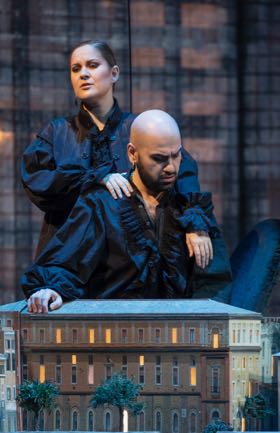
Mert Sùngù as Gennaro, Eléonore Pancrazi as Matteo Orsini
All photos copyright Patrice Nin, courtesy of the Opéra de Toulouse
This famed murderess worked her magic on Toulouse's Théâtre du Capitole stage, six dead including her beloved long lost son. It was Victor Hugo's carefully crafted 1833 thriller recrafted by Italian librettist Felice Romano for Donizetti's fragile Lucrezia Borgia.
With the tightness of a short story, Felice Romano reunites mother with son at a party in Venice only to have the mother inadvertently poison her son at a party in Ferrara when all she had wanted to do was poison his raucous friends. The plot is only slightly more complicated in that Lucrèce’s currently surviving husband Alphonse believes she is having an affair with her son, even though we know that possibly her son is having an affair with his best friend Maffeo Orsini.
It is a beautifully crafted opera, the story unfolding in highly structured musical numbers that encase the unstoppable series of obviously very tense situations. There are a lot of feelings to put on the table.
There is a delicate balance between ambience and emotion in bel canto, like there is a delicate balance between voice and pace — the emotions must flow but not rush nor may they falter. Italian conductor Giacomo Sagripanti created a plausible orchestral platform for bel canto, his more effective moments however were in his drives to the cadences that wrap up Donizetti’s emotive extensions. The maestro was obviously limited by the capabilities of his singers.
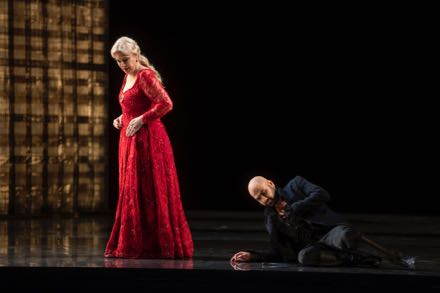
Annick Massis as Lucrezia Borgia, Mert Süngü as Gennaro
If Annick Massis, the sixty-one year old French bel canto diva, masterfully projected Lucrezia’s Borgia family pride and a towering pride of maternity, she could not effect a resolute tone of voice. Carefully placing her voice far back in her throat she avoided the wide, unfocused, indeed indeterminate tones that I heard in her 2015 Monaco Mathilde (Guillaume Tell). This new placement erased all authority of tone, her quite clean, careful coloratura had no sheen or pizazz, limiting its effect.
Turkish tenor Mert Süngü too physically created a convincing persona, that of a swashbuckling young warrior. Though a fine singer and a solid performer Mr. Süngü did not find the elegance of voice or line to establish the potentially sublime magic for the young warrior’s feelings for his mother and for his friend Matteo.
Frankfurt Opera bass Andreas Bauer Kanabas (the final Kanabas is his recently appended Bohemian maternal family name) took on the role of Alfonso d’Este. His dark hued voice serves him well for quite a variety of roles in Frankfurt and elsewhere, but his voice does not have the brightness that make raging bel canto lines fly off the page. French ingenue mezzo Eléonore Pancrazi brought little presence to the tenor’s best friend Matteo Orsini. This spirit of random casting extended to the myriad of smaller male roles required by this opera.
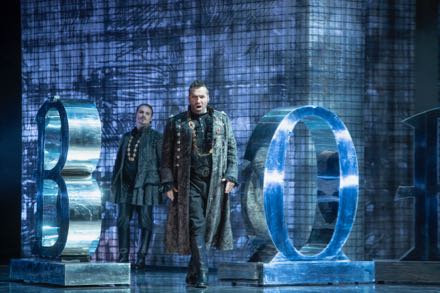
Andreas Bauer Kanabas as Alfonso d'Este, Thomas Bettinger as Rustighello (behind)
The 1917 production was from Valencia, Spain, by well-known (in California) Spanish director Emilio Sagi with his usual designers, Llorenç Corbella (sets) and Pepa Ojauguren (costumes). While Mr. Sagi moved his actors in easy accordance with the dramatic minimalism of Felice Romano’s libretto the physical production succumbed to an atmosphere of extravagant, abstract faux luxury. The result approached the questionable splendor of a sleek remake of a once grand, old hotel (ubiquitous metallic glints and lurid colors floating in chic blackness).
The legendary murderous excesses of Donizetti’s heroine Lucrezia Borgia universally seem to ignite hyper-active production imagination. Such response is at odds Felice Romano’s minimalism making Donizetti, finally, its the victim.
Cast and Production
Alfonso d’Este: Bauer Kanabas; Lucrezia Borgia: Annick Massis; Maffio Orsini: Eléonore Pancrazi; Gennaro: Mert Süngü; Liverotto: Galeano Salas; Vitellozzo: François Pardailhé; Gazella: Jérémie Brocard; Rustighello: Thomas Bettinger; Gubetta: Julien Veronèse; Ascanio: Rupert Grœssinger. Chorus and Orchestra of the Théâtre du Capitole. Conductor: Giacomo Sagripanti; Mise en scène: Emilio Sagi; Decors: Llorenç; Costumes: Pepa Ojanguren; Lights: Eduardo Bravo. Théâtre du Capitole, Toulouse, France, February 3, 2019.
De la Maison des Morts in Lyon
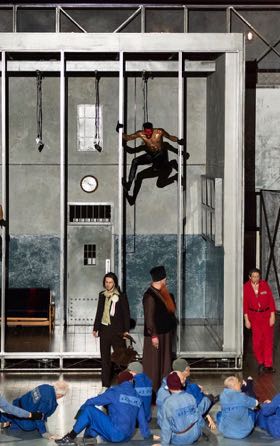
Karoly Szemeredy as the Orthodox Pope (later he is Shishkov),
Stefan Margita as Luka (far right in red)
All photos copyright Stolfeth, courtesy of the Opéra de Lyon
The obsessive Russian Dostoevsky’s novel cruelly objectified into music by Czech composer Leos Janacek brutalized into action by Polish director Krzysztof Warlikowski beatified by Argentine conductor Alejo Pérez.
These seven performances at the Opéra de Lyon wrap up the run of the Warlikowski production of From the House of the Dead that started last spring at London’s Covent Garden and continued in the fall at the Brussel’s Monnaie. Veteran bass Willard White has remained the prisoner Goriantchikov, Warlikowski’s protagonist for the full run as has Czech tenor Stefan Margita (San Francisco Opera’s Loge) as the prisoner Luka. Both artists are veterans of the 2007 Patrice Chéreau Aix Festival production also seen at the Metropolitan Opera in 2009.
Note that spellings of the Russian names have been Anglicized for this review.
It is ironic that black, “veteran” (the critical adjective for the past 20 years) bass White is both Chéreau and Warlikowski’s choice for the only prisoner to be freed from the horrors of modern penal servitude. For Chéreau it was a release from a physically detailed world of drudgery and degradation and suffering, for Warlikowski the prisoner’s release is a metaphorical death, the abandonment of a vibrant, intense, and principled world in which wounded human souls can truly soar. Warlikowski with conductor Pérez find, finally, the essence of Janacek’s most forgiving line “a divine spark (a soul) shines in every being” and it was an emotionally and intellectually thrilling, in fact mesmerizing conclusion to this evening of unrelenting brutality.
Warlikowski inaugurates his From the House of the Dead with a video of the late French philosopher Michel Foucault musing about justice and the police. He speaks over Janacek’s introductory music, the intense pace of concept and the inflection of the French is exponentially enlivened by Janacek’s already boiling motives. Janacek then drives a commanding musical climax to which the video expands the monumental gates of a soaring castle — and it is a prison!
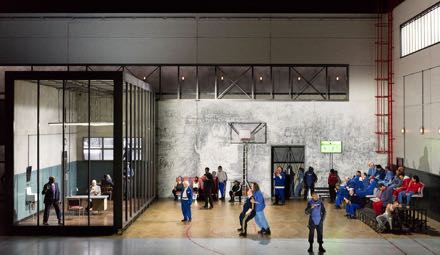
Willard White as Goryantchikov (far left), Nicky Spence as the Fat Prisonor
with Ladislav Elgr as Shuratov (center)
A basketball court is revealed, a black player (a “pro” equivalent) dribbles and shoots a basket, among the prisoners who enter are four break-dancing acrobats (of the various skin tones that populate Western prisons) who project an unbridled spirit of freedom in their movement and in their energy, a canny take on the wildness of the Janacek score. A fight breaks out, the basketball player is wounded. We understand that the basketball player is Dostoevsky’s taunted eagle as we know that an eagle is a visual epithet of freedom.
The player will remain in a wheelchair until the final moments of the opera when he stands, shoots the ball and misses, then he takes it to the rack. Blackout.
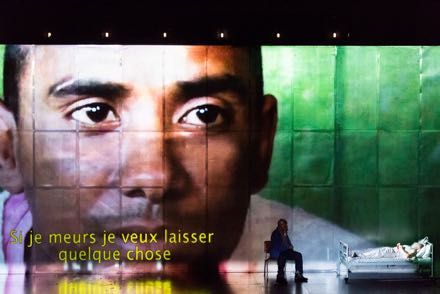
Unnamed South African gangster (video), Willard White as Goryantchikov,
Pascal Charbonneau as the wounded Alyeya
Warlikowski separates the acts of the opera with a video from American film director Teboho Edkins’ Gangster Backstage in which a black South African gangster (a real gangster) muses during the musical silences about death, knowing that he wishes a legacy and that legacy might be, he imagines, saving a small boy from danger. We know now why the prisoner Goriantchikov (Willard White) will teach the young prisoner Alyeya to read and write, his legacy and gift to the spirited, truly human world that he must leave. And why he is the opera’s protagonist though he has very little to say or sing.
Warlikowski’s frenetic intellectual and physical world is deeply embedded into the continuum of Janacek’s sonic world, a world in which stories are told — Luka who stabbed the abusive commander of his prison, Skuratov who shot the rich man his mistress married, Shapkin who robbed a rich man and was tortured, and finally Shishkov who murdered his wife because she dishonored him.
Finally, more than the merely recounted violence, Shishkov elevates Janacek’s narrative opera to action — Shishkov resolutely murders Luka who he has learned is the man who had falsely denounced his new wife as unchaste. Janacek’s continuum hammers Shishkov’s revenge and his remorse, and the bravado and regret of the other raconteurs. Shishkov’s action is finally release. Violence and brutality redeemed. And Janacek drives the pathos ever deeper in the Old Prisoner’s epithet of the dead Luka, “he too had a mother.”
That Warlikowski’s plays (Kedril and Don Juan and The Lovely Miller’s Wife) within Janacek’s play added gratuitous grotesquery and violence to his prison world can be attributed to blind, probably necessary adherence to the dictums of “regietheater.” Unfortunately these attributes also became boring, detracting from the honest, effective intellectualism of the Warlikowski concept.
Lyon’s Opéra Nouvel (named after it’s architect, Jean Nouvel) offers a very present, very bright acoustic. The Opéra de Lyon’s fine orchestra was well rehearsed and poised to deliver. Conductor Pérez, new to the production, was able to exploit (to the hilt) the quite detailed urgencies of the Janacek’s orchestral continuum, giving Warlikowski a musical force to well support the overwhelming physical and intellectual energy emanating from the stage.
From which there had been no escape. That final basket was deeply felt liberation.
Much of the sterling cast survives from the Covent Garden premiere, including the Luka of Stefan Margita and the Skuratov of Ladislav Elgr. Karoly Szemeredy was new to the production as a truly riveting Shishkov (he was Warlikowski’s Captain in last summer’s The Bassarids at Salzburg), as was the Shapkin of Dmitry Golovnin.
Cast and Production
Alexandre Petrovitch Goryantchikov: Sir Willard White; Alieïa: Pascal Charbonneau; Filka Morosov (Louka Kouzmitch): Stefan Margita; Le grand forçat (prisoner): Nicky Spence; Le petit forçat / Le forçat cuistot / Tchekounov: Ivan Ludlow; Le commandant: Alexander Vassiliev; Le vieux forçat: Graham Clark; Skouratov: Ladislav Elgr; Le Forçat ivre: Jeffrey Lloyd‑Roberts; Le forçat jouant: Don Juan et le Brahmane / Le forçat forgeron: Ales Jenis; Un jeune Forçat: Grégoire Mour; Une prostitiuée: Natascha Petrinsky; Kedril: John Graham-Hall; Chapkine: Dmitry Golovnin; Chichkov / Le pope: Karoly Szemeredy; Tcherevine / Une voix de la steppe: Alexander Gelah; Un garde: Brian Bruce; Un garde: Antoine Saint-Espès. Orchestre et Chœurs de l’Opéra de Lyon. Conductor: Alejo Pérez: Mise en scène: Krzysztof Warlikowski; Décors et costumes: Malgorzata Szczęśniak; Lumières: Felice Ross; Chorégraphie: Claude Bardouil; Vidéo: Denis Guéguin; Dramaturgie Christian Longchamp. Opéra Nouvel, Lyon, France, January 23, 2019.
Ricciardo e Zoraida at Rossini Festival, Pesaro

Juan Diego Flórez as Ricciardo, Sergey Romanovsky as Agorante
Photos by Studio Amati Bacciardi, courtesy of the Rossini Opera Festival, Pesaro
2018 may mark the 150th anniversary of Rossini’s death but of more interest is that it marks the 200th anniversary of the two operas he composed in 1818 — the one-act farce Adina, though not performed until 1826 in Lisbon (and rarely since) and the “dramma serio” Ricciardo e Zoraide, “a grotesque mixture of stupidities and improbabilities” according to a 1927 Rossini biographer.
A bit of a success in its time, Ricciardo e Zoraida soon disappeared to be resurrected only in 1990 by the Rossini Festival (that unquestioningly does all Rossini). Improbable as it may seem just now in Pesaro it attracted two major singers, Juan Diego Flórez as Ricciardo and South African soprano Pretty Yende as Zoraida, even though each has but one aria the entire evening.
The story is a generic, old style chivalric tale — exotic tyrant wishes to marry a damsel loved by a Christian knight, slightly complicated by a father who has his own ideas. Compared to the great Rossini tragedies of this same (Naples) period it is of slight dramaturgical interest, and therefore of lesser musical challenge for Rossini.
Its musical lines are however exquisitely Rossini, starting with the overture’s extended and quite lovely clarinet and horn solos followed by a brilliant flute display, brazenly interrupted from time to time by a raucous military band — a first use of stage musicians by Rossini, and quite startling indeed.
The African tyrant Agorante was sung by Russian bari-tenore Sergey Romanovsky whose darkly colored tenor voice soared with easy heft to the required high C’s, simultaneously sculpting elaborate coloratura in his lengthy aria. It was his one and only aria, an auspicious inauguration of this evening of spectacular vocal fireworks.

Front row Juan Diego Flórez, Sergey Romanovsky, Xabier Anduaga as Ernesto (a Christian ambassador).
Back row Sofia Mchedlishvili as Fatima (Zoraide's confidant), Martiniana Antonie as Elmira,
Victoria Yarovaya as Zomira (Agorante's wife); Pretty Yende (in gold gown)
If Pretty Yende seemed vocally tentative in her initial scenes — a duet with the tyrant’s current wife, Zomira, becoming a trio by adding the lovesick tyrant Agorante — it was perhaps because she was simply coping with a dramatically awkward situation (the other woman), exacerbated when Ricciardo unexpectedly showed up. She did hold her own in their extended duet.
But by the time la Yende, her stage father Ircano and Ricciardo got rescued from the tyrant’s clutches she was in magnificent voice and delivered her one aria with ultimate virtuoso aplomb. Though Rossini had embedded his usual soprano showpiece finale within the larger finale (in which the Christian forces overwhelmed those of Agorante and everyone forgave everyone), the glories of her shining high notes (well above the staff) lingered and the energy of her coloratura endured earning her an ovation at the curtain calls that well surpassed the ovation awarded to Juan Diego Flórez for his splendid Ricciardo.
Tenorissimo Flórez had great opportunity to show off his high C’s and his impeccable fioratura while imbuing his character with the welcomed notion that we didn’t have to take any of this too seriously, that after all this Rossini opera was meant to be about singing and that he can do, as everyone knows.
The production was staged by French director Marshall Pynkoski, a specialist in Baroque and proto-Romantic opera. Thus the staging was highly formalized in static stage pictures. Action when demanded was in the abstract choreography of five ballerinas and six male dancers — there were pompous entrances by the tyrant, preparations for beheadings, and a great battle among other, lesser activities. The extensive choreography was created by Jeanette Lajeunesse Zingg (Mr. Pynkoski’s wife).

An entrance of Agorante with ballet
Mr. Pynkoski did avail himself of the “close-up” technique so effectively used by director Pier Luigi Pizza in the Rossini Festival’s ad hoc 1200-seat theater inside Pesaro’s massive Adriatic Arena. Singers are brought outside the proscenium onto a catwalk fronting the orchestra pit, thus eliminating all scenic and musical context. The direct contact of these superb Rossini singers with the audience was an awesome experience.
Canadian set designer Gerard Gauci, a collaborator of Mr. Pynkoski at Versaille’s Opéra Atelier offered backdrops of painted canvas in monumental shapes and somber color. Appropriate period costumes were created by Michael Gianfrancesco, a Canadian colleague of Mr. Gauci. Neither sets nor costumes, nor Mr. Pynkoski’s staging for that matter, succeeded in finding the indulgent smile we might confer on such a precious literary relic.
Italian conductor Giacomo Sagripanti presided over the Orchestra Sinfonica Nazionale della RAI. The young maestro set the elegant musical level of the evening in the overture, finding its caressing lines, encouraging the excellent solo playing, stoically tolerating the noisy stage band, then providing Rossini’s richly colored foundation for some of Rossini’s loveliest vocal lines. The maestro’s tempi kept the easy energy needed to sustain ornamental singing and at the same time drive the opera’s substantial ensembles to maximum effect.
It is not hard to fathom why Giachino Rossini returned to the very simple one-act semi-serious farsa form of his youth after creating his four magnificent character comedies, as well as coping with libretti based on Shakespeare and Sir Walter Scott among other literary luminaries for his Neapolitan tragedies — he was paid to do it (but that’s another story)!
Cast and Production
Agorante: Sergey Romanovsky; Zoraide: Pretty Yende; Ricciardo: Juan Diego Flórez; Ircano Nicola Ulivieri; Zomira: Victoria Yarovaya; Ernesto: Xabier Anduaga; Fatima: Sofia Mchedlishvili; Elmira: Martiniana Antonie; Zamorre: Ruzil Gatin. Chorus of Teatro Ventidio Basso, Orchestra Sinfonica Nazionale della RAI. Conductor: Giacomo Sagripanti; Metteur en scène: Marshall Pynkoski; Coreografie: Jeannette Lajeunesse Zingg; Scene: Gerard Gauci; Costumi: Michael Gianfrancesco; Luci: Michelle Ramsay. Arena Adriatico, Pesaro, August 20, 2018.
Adina in Pesaro
Adina is the essentially the same story as Ricciardo e Zoraide. An older Persian caliph has taken a fancy to a beautiful prisoner of his seraglio and is about to marry her. Her former fiancé Selimo appears, whom she has believed to be dead after the shipwreck that separated them. The lovers hatch plans to escape with the help of Mustafa, the palace gardener. Ali, servant and confident of the caliph becomes aware or the plot. It fails. But as it turns out Adina is the long lost daughter of the caliph, thus Selimo need not be executed.
There are little complications to sing about. Selimo feels betrayed by Adina who is about to marry the caliph. Adina respects the caliph and is grateful to him for rescuing her. Adina believes Selimo to have been executed and is distraught.
Rossini actually recycled much of Adina’s music from his early operas and even borrowed musical material from other composers. Nonetheless Adina is still the musically mature Rossini, the vocal lines boast his ultimate sophistication. There is a splendid quartet near the end of great effect, plus a robust, exciting finale (with Adina’s splendid “Dove sono? Ancora respiro?”) composed especially for this operatic stepchild, the two pieces alone making the evening worthwhile.

Lisette Oropesa (center) with chorus of the Teatro della Fortuna M Agostini
Adina was sung by New Orleans born soprano Lisette Oropesa well known to L.A. and Met audiences as Lucia. An able Rossini singer as well, she did find the singerly excitement of her final aria. Her fiancé Selimo was ably sung by South African tenor Levy Sekgapane whose aria “Giusto ciel, che i dubbi miei tu conosci” is really a beautiful duet with English horn, attesting Rossini’s mature orchestral sophistication. The caliph was sung by Italian baritone Vito Priante, bringing the energy of his usual big-house Figaro to the caliph’s lone aria “D’intorno il Serraglio.” Completing the small farsa cast were character singers Matteo Macchioni as Ali who dutifully delivered his “aria di sorbetto” (a secondary singer’s small aria near the end of an opera) and Davide Giangregorio as Mustafa.
That the singers in this new production made little impression can be attributed to its metteur en scène, Rosetta Cucchi. Sig.a Cucchi is a pianist once associated with the Rossini Festival. Turned provincial opera house stage director she is now on the artistic staff of Ireland’s Wexford Festival. This Adina is a shared production with that festival.
Rather than allowing Rossini’s farsa process to work naturally, allowing its singers to expose Rossini’s prototype characters, this director imposed a blinding, supposedly comic environment (saturated pinks, blues and greens for the decor) that overwhelmed mere Rossini.
The stage was dominated by one huge scenic image — a three tiered wedding cake with the bride and groom statuette on the top (who were real people echoing the ins and outs of the farsa action).

Live groom and bride statuette
When the caliph wasn’t in a gold lame suit jacket for the wedding that never happened he was in a bubble bath singing his aria. Adina herself was accompanied by two mincing acolytes in short pink dresses. Selimo got off a bit easier appearing in a simple frocked shirt and gold vest as did his gardener sidekick who donned a straw hat adorned with foliage as well. The caliph’s henchmen threatened the lovers with colorful toy Uzis. There was not a turban or eunuch in sight.
A protege of Venezuela’s famed “Sistema” and now music director of Venice’s La Fenice, young (33 years old) conductor Diego Matheuz gave a fine account of this minor Rossini score, respecting the current performance practices that favor stylistically informed singers. The Orchestra Sinfonica G. Rossini, resident orchestra of Le Marche’s historic theaters (Pesaro, Fano, Jesi and Pergola) performed at its usual high level. The male chorus of the Teatro della Fortuna M Agostini in Fano (a small city 12 kilometres south of Pesaro) did its best to fulfill stage director Cucchi’s idea of what fun is not.
Cast and ProductionCalifo: Vito Priante; Adina: Lisette Oropesa; Selimo: Levy Sekgapane; Alì: Matteo Macchioni; Mustafà: Davide Giangregorio. Chorus of the Teatro Della Fortuna M. Agostini, Orchestra Sinfonica G. Rossini. Conductor: Diego Matheuz; Metteur 3n scène: Rosetta Cucchi; Scene: Tiziano Santi; Costumi: Claudia Pernigotti; Luci: Daniele Naldi. Teatro Rossini, Pesaro, August 18, 2018.
Il barbiere di Siviglia in Pesaro
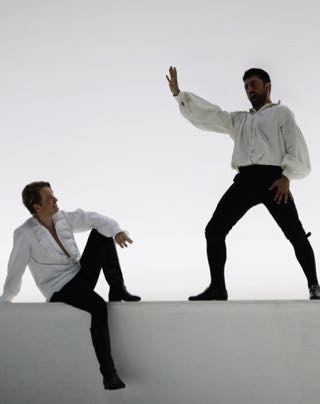
Maxim Mironov as Almaviva, Davide Luciano as Figaro
All photos by Studio Amati Bacciardi, courtesy of the Rossini Opera Festival, Pesaro
Oh no, not another Barber! Well, it is the 150th anniversary of the world’s greatest opera composer so what better way to commemorate the occasion than to program his most famous opera! And hope for the best.
And the best it was, though Canadian born Europe based conductor Yves Abel had some formidable competition for being the star of the show, namely 88 year old Pier Luigi Pizzi who staged it. In turn Signor Pizzi was upstaged by Italian baritone Davide Luciano, Seville’s factotum Figaro. But even he disappeared into the shadows when Russian tenor Maxim Mironov cut loose with his brilliant “Cessa di piu resistere,” that closes the show.
Never has the patter been more cuttingly precise at breakneck speed than when Italian bass baritone Pietro Spagnoli unleashed his “A un doctor della mia sorte” nor has the malicious pleasure of “La calunnia è un venticello” been more indulged than when intoned by Italian bass Michele Pertusi.
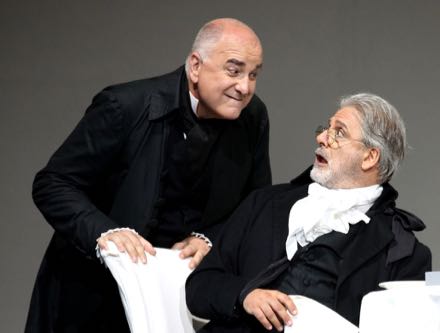
Michele Pertusi as Basilio, Pietro Spagnoli as Bartolo
That Rossini himself became the true star of the show can only be credited to stage director Pizzi who stripped the comedy of any specific scenic context using only a white box, anonymous white architecture, white furniture, a visual technique that thrust his actors and Rossini’s singers into high relief. The octogenarian stage director instilled an energy of personality into this production that effected the comic process — the triumph of youth over age — in monumental terms. It was the all too rare proof that Il barbiere is indeed one of the repertoire’s greatest masterpieces.
The overwhelming atmosphere of the production was that of youth, from Fiorello, sung by Venetian baritone William Corrò, to Almaviva and to Rosina, sung by splendid Japanese mezzo soprano Aya Wakizono, and finally, and even most of all to Figaro who stripped to his culottes, jumped into the fountain and then did a beefcake parade along the catwalk fronting the orchestra pit regaling us with his “Largo al factotum!”
None of this possible, of course, without conductor Abel who propelled Rossini’s numbers onto plateaux of lyricism that bordered on delirium. Of greater accomplishment was perhaps the pacing the maestro imposed on Rossini’s parade of blockbuster numbers, allowing us to savor each of them to the fullest but leaving us resource to sink ourselves into the opera’s two gigantic finales.
There was virtually no comic schtick (sight gags) in Pizzi’s production, the innate charm of each of its virtuoso singers needing no embellishment to create character. Except the music lesson scene which itself is nothing but schtick, and usually annoying. Director Pizzi solved this in simple strokes. There was no piano. Fiorello mimicked a cello for “L’inutil precauzione” conducted by Almaviva disguised as a dwarf. When it was Bartolo’s turn to show how to sing Sig. Spagnoli leapt into falsetto soprano!
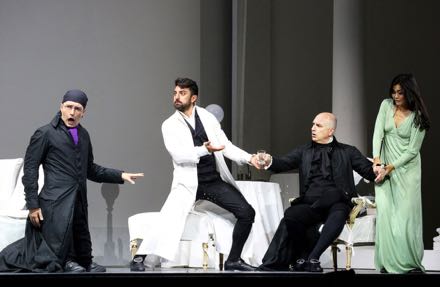
Almaviva disguised as dwarf music teacher [shoes on knees], Figaro, Basilio and Rosina
Note that before the performance I had spotted three little people among the spectators. Hopefully they enjoyed the comedy of such travesty (Almaviva had shoes on his knees) made transparent when Almaviva jumped to his feet from time to time when Bartolo wasn’t looking).
Not to forget that the storm was nothing more than the throes of fever that overtook Rosina when she thought Lindoro was betraying her, reinforcing stage director Pizzi’s firm commitment to comedy of character.
Esteemed Italian character mezzo soprano Elena Zilio sang Berta, sharing the tasks of Ambrogio, charmingly and broadly played by actor Armando de Ceccon, with little more to do that just be there to answer the door and bring in the laundry. Sig.ra Zilio’s “aria di sorbetto” “il vechhiotto cerca moglie” was met with huge applause. Note that in Rossini times sorbet was hawked near the end of a performance where such secondary arias were placed.
Sig. Pizzi directed, designed both sets and costumes, and designed the lighting with his associate Massimo Gasparon. The elegance of the costume design — abstracted formal wear in black and white, with Rosina in various solid colors — well served the elegance of the singing.
In his formative years Pier Luigi Pizzi worked as a designer with Giorgio Strehler and Luca Ronconi, incorporating much of mid-twentieth century Italian avant garde into his theatrical vocabulary. He made his Pesaro Rossini Opera Festival debut in 1982 with Tancredi. During the 1980’s as well he both designed and directed productions at San Francisco Opera, notably Simon Boccanegra, Semiramide and Orlando Furioso (though these credits are not included on Wikipedia). His productions have appeared in all of the world’s major theaters.
The male chorus of the Teatro Ventidio Basso (an historic opera house in Ascoli Piceno, a town halfway between Pesaro and Rome) was the raucous police force. The Orchestra Sinfonica Nazionale Della RAI (Italian Radio/Television) were the polished collaborators of maestro Abel.
Cast and Production
Il Conte d’Almaviva: Marim Mironov; Bartolo: Pietro Spagnoli; Rosina: Aya Wakizono; Figaro: David Luciano; Basilio: Michele Pertusi; Berta: Elena Zilio; Fiorello/Ufficiale: William Corrò. Chorus of the Teatro Ventidio Basso, Orchestra Sinfonica Nazionale della RAI. Conductor: Yves Abel; Regia, Scene e Costumi: Pier Luigi Pizzi; Regista collaboratore e Luci: Massimo Gasparon. Arena Adriatica, Pesaro, August 19, 2018.
The Bassarids in Salzburg

Tanya Ariane Baumgartner as Agave, the king of Thebes mother
holding high his severed head
All photos copyright Ruth Walz, courtesy of the Salzburg Festival
Hans Werner Henze’s fifth opera, The Bassarids (those who wear fox skins) had its world premiere at Salzburg’s Grosses Festspielhaus in 1966. Now, 52 years later Henze’s massive “opera seria” returns, but to the Felsenreitschule —the old riding school made into a theater that hosts the Salzburg Festival’s difficult operas, the Grosses Festspielhaus now dedicated to the grand repertoire.
And difficult Henze’s opera is. There is an heroic orchestra — batteries of brass, batteries of percussion, harps, pianos, guitars, it is after all the destruction of the founding family of one of ancient Greece’s greatest cities in the retelling of the last play of one of Greece’s greatest tragedians, Euripides! Not to mention two tone rows (yes, Henze was a serial composer) that configure the stark world of Pentheus, king of Thebes and the colorful world of Dionysus his challenger.
Euripides’ Bacchae was recast as an opera libretto for Henze by W.H. Auden and Chester Kallman, who provided the libretto for The Rake’s Progress and texts for Benjamin Britten. Thus here as well are the expected discussions, rather fixations on repressed sexual realities.

King Pentheus dressed as a woman, Dionysus plus a bacchanalia spirit (mute role)
Essentially Semele, great grand daughter of Cadmus, founding king of Thebes, was murdered while giving birth to a son who may be the son of Zeus, and therefore a god, or maybe not. Cadmus abdicated naming Semele’s sister Agave’s son Pentheus as the new king. Pentheus has complicated feelings about his mother who is pretty complicated herself. A challenger appears who may be the god Dionysus. Everyone joins his cult. Pentheus disguises himself as a woman to learn about the cult. He is discovered by a band of women led by his mother who tear him to pieces believing that he is a lion. Dionysus removes his mother Semele from her earthly tomb and takes her to Olympus to join him as a god.
With all this on his mind Henze needed far more than his two tone rows, thus he mined musical and operatic traditions to embellish and enrich his musical manifestation of the Auden/Kallman take on the Euripides’ Bacchae. Vocal lines are comprehensible, and there actually is a sort of bel canto. There are occasional, quite beautiful arias within the opera’s symphonic structure. Bach’s St Matthew’s Passion is oft quoted, Mahler like textures and harmonies are discernible, and by musical miracle we even arrive at a momentary, truly magnificent 6/4 chord (second inversion of a triad) during Semele’s assumption!
It is magnificent, complex, highly expressive music that painstakingly delves into the psychological depths of insecure men and women, of obsession, and into the psychologies of mass social phenomena and the resulting human debasement.
But the final scene of the opera is in fact wonderfully liberating, indeed moving as Dionysus leaves Thebes and abandons the cult he has founded. He commands Persephone to open the gates of hell and release his mother that she may triumphantly unite with him upon Olympus.
Mounting Henze’s setting of the Auden/Kallman’s neurotic tale of infanticide in the massive stone world of the old riding school was a wondrous gift to famed Polish stage director Krzysztof Warlikowski. He simply spread it all out across the expanse of the riding school paddock, The a vista crypt and shrine of Semele on the far left, the private bedroom (his neurotic inner life) of King Pentheus on the far right and in between three palace rooms where the founding dynasty of Thebes was destroyed. The massive upper reaches of the riding school galleries became a metaphorical mount Cithaeron.
Henze’s choruses were crucial players in the drama, not spectators, though the chorus did begin the evening as spectators filing into the first two rows of the auditorium as the citizens of Thebes praising their new king. They quickly left and little by little they joined the Dionysian cult as did Thebes founder Cadmus, deftly enacted by venerable bass Willard White who was in good voice.
The palace prophet Tiresias — blind of course — was played by Austrian tenor Nikolai Schukoff who cross-dressed as the fey Calliope of the Intermezzo. Cadmus’ granddaughter Agave was convincingly, even heroically portrayed by Frankfurt Opera’s dramatic mezzo soprano Tanya Ariane Baumgartner. Her weaker sister Autonoe was sung by Berlin’s Komischen Oper’s Vera-Lotte Böcker.

Agave as Venus in Intermezzo, with Adonis, Persephone and Calliope
A more complicated if less defined character was Pentheus’ Captain (of the royal guard) sung by Hungarian bass-baritone Károly Szemerédy who doubled as the Adonis in the Intermezzo in which Dionysus’ magic mirror shows to Pentheus the unbridled sexuality of his mother — a cunningly staged scene by Warlikowski that video-mirrored the Intermezzo in black and white from its enactment far stage left onto a wall far stage right.
Pentheus’ wet nurse Beroe, sung by Dutch mezzo Anna Maria Dur, was another complex character. Hera, Zeus’ wife impersonates Beroe so that she could intimidate Semele into demanding to see her lover (Zeus) thus destroying herself. Yet Beroe expresses blind, uncomplicated maternal love for Pentheus earning our sympathy.
Canadian Opera’s baritone Russell Braun brought unbridled commitment to his portrayal of the weak, sexually repressed King Pentheus, moving from impotent authority to loss of identity, from fulfillment as a woman to honesty as a lost man. Sri Lankan-American tenor Sean Panikkar brought full spectrum to Dionysus, from cunning manipulator to the loving son of the mother he never knew.
Henze’s score is fiendishly difficult, for its singers and for its orchestra. Conductor Kent Nagano marshalled the always impressive forces of the Vienna Philharmonic into a convincing performance, simultaneously chorus master Huw Rhys James conducted (from the pit) the 100 or so voices of the concert choir of the Vienna State Opera in its huge chorus role.
Additional production information
Sets: Christian Schmidt; Costumes: Reinhard von der Thannen; Lights: Stefan Billiger
Grosses Festspielhaus, Salzburg, August 13, 2018.
Pique Dame in Salzburg

Hanna Schwarz as Pique Dame, Brandon Jovanovich as Herman
All photos copyright Ruth Walz, courtesy of the Salzburg Festival
It was emeritus night at the Salzburg Festival with 75 year old maestro Mariss Jansons conducting 77 year old stage director Hans Neuenfels production about Pushkin’s 87 year old countess known as the Pique Dame.
There were ghosts present — Jansons’ teacher Herbert von Karajan who influenced the design of the Grosses Festspielhaus to favor the Vienna Philharmonic, and Neuenfel’s artistic ancestors — Salzburg Festival founder Max Reinhardt and the surrealist poet/sculptor, Max Ernst — who formed Mr. Neuenfels to be an enfant terrible of a more recent German opera world.
No longer of an age to be thought of as enfant terrible Neuenfels nevertheless is true to form. He did create a truly surreal Pique Dame, its action frozen into multiple tableaux, tableaux that oozed the luxe of Czarist Russia, the austerity of death, the naïveté of love, the joy of sunlight, the frustration of waiting, the anxiety of searching, and so on.
Fixating on the specific mood and atmosphere of each number of Pique Dame (it is very much an old style numbers opera) the heavy pathos of Tchaikovsky’s tormented, obsessed lovers is overlooked, pushed aside to paint the moments of the story. We were no longer able to connect a flow of feeling, thus we were left with no sympathy for Hermann or for Liza. We did have a huge sense of their world.

Brandon Jovanovich as Hermann, Eugenia Muraveva as Liza
These atmospheres were gloriously, indeed sumptuously created in Von Karajan’s very present orchestra pit, conductor Jansons urging every possible color from the Vienna Philharmonic, its solo players and its sections creating their unique Vienna tonal world. It was this orchestra beyond compare that riveted us for the multitude of scenes that exposed the soul of the tormented composer Tchaikovsky far more than it involved us in Pushkin’s tale.
Conductor Jansons considers this opera one of the ten finest in the repertory. Though most of us would not agree we surely must appreciate his respect for the piece and for this surely once-in-a-lifetime reading.
The stage setting and costumes were huge in keeping with this orchestral magnitude. Huge gray tufted walls were set upon a black floor laden with conveyor belts used to move fixed battalions of choristers on and off the stage and to allow Hermann to remain stationary while walking, as examples. A proscenium was built into the back wall through which smaller stages were thrust forward for the pastoral performance and as a hospital room the death of the countess. As well the gray surround walls served as a screen for huge projections of storms, city streets and, of course the triumphant face of the pique dame as the production’s final image.
Each chorus number, and there are many, was specifically costumed. There were possibly one hundred choristers, dressed first as fantastically breasted Mother Gooses, keepers of the possibly 50 children chorus who arrived in cages. The choristers became bathers, then donned rain gear when the weather changed, wore party dress for the engagement scene, skeleton costumes, elaborately bustled black dresses, and the men in tuxedos for the final card game.
It was extravagant, overpowering, expensive costuming.
If the elaborate costuming of the choruses illustrated the various exotic tableaux, the principles remained rather plainly and simply dressed in their anguish. Lisa was in simple, contemporary black and white attire, the Pique Dame wore a bizarre short-shirted, pink and green concoction, clothing she shed as she slowly died.
Hermann, the obsessed gambler, masterfully enacted by American tenor Brandon Jovanovich, was from beginning to end a toy soldier in an unbuttoned red uniform. Beautifully sung through the tortured twistings of his obsessive love of Liza and his obsessive quest of the Pique Dame’s three cards (not to discount the oblique, obsessive goals of the production) he was indeed an operatic soldier of impressive magnitude.

The death of Hermann, plus all named male characters
Mr. Jovanovich’s heated performance was in contrast to the distant involvement of Russian soprano Eugenia Muraveva as Liza. Mlle. Muraveva is an excellent singer of elegant presence and great reserve. Both Tchaikovsky’s Liza, and last summer’s Lady Macbeth of Mtsensk (that befell her when Nina Stemme fell ill) are well beyond her histrionic range.
The Countess aka Pique Dame was portrayed by 75 year-old, once mezzo Hanna Schwarz who brought little old lady confusion to this role usually taken by old divas of important presence. Mme. Schwartz delivered her death aria in a thin, dying voice, pathetic rather than moving, a performance well in keeping with the emotional void generated by the Neuenfels production.
The more direct and satisfying performances came from Russian male voiced imports — baritone Igor Golovatenko as Liza’s intended Prince Yeletsky, baritone Vladislav Sulimsky as Count Tomsky, bass Stanislavsky Trofimov as Surin, tenor Pavel Petrov as Chaplitsky, bass Gleb Peryazev as Narumov, and tenor Alexander Kravets as Chekalinski.
Equally impressive were the Russian female voices that completed the cast, Oksana Volkova as Polina, Margarita Nekrasova as the governess, Vasilisa Berzhanskaya as Mascha, and Yulia Suleimanova as Prilepa.
Production information
Sets: Christian Schmidt; Costumes: Reinhard von der Thannen; Lights: Stefan Billiger
Grosses Festspielhaus, Salzburg, August 13, 2018.
Salome in Salzburg

Asmik Grigorian as Salome
Photo copyright Ruth Walz, courtesy of the Salzburg Festival
A Romeo Castellucci production is always news, it is even bigger news just now in Salzburg where Lithuanian soprano Asmik Grigorian has made her debut as the fifteen year-old Salome.
Castellucci creates theater as Richard Strauss creates music. It is a language all its own, though sometimes of concrete reference it is usually an abstract flow of stimuli that create their own reality.
Here Castellucci has made a Salzburg Salome. Starting with the Latin "te saxo loquuator" (what the stones may say to you), a phrase found only in Salzburg where it is inscribed above the entry of the 18th century tunnel connecting old Salzburg with a later Salzburg built beyond its famous mountain.
Castellucci inscribes the phrase on a cloth that covers the massive galleries cut into the cliff behind the old riding school theater where he holds us in silence, save a cricket sounding. Finally the cloth parts to reveal that the galleries have been filled in with stone creating a gigantic cavern. Specific images appear, Salome in a white dress stained by menstrual blood standing on the huge mirrored floor, a displaced disk revealing a black hole.

The dance
Only when we have fully entered into Castellucci’s theater does the Strauss music begin. The players of the Vienna Philharmonic and maestro Franz Welzer-Möst become very present in the Castellucci's theater world — they themselves in fact become the dance that dooms the 15 year-old princess — Salome herself folded, immobile on a pedestal during the dance, a huge square cut stone slowly descending to crush her under its massive weight (sublime choreography by Castellucci collaborator Cindy Van Acker).
Castellucci’s implacable stone world reflects everything except the black voids he creates for the prophet’s aura and for Herod’s doom. There is no color save the occasional lightening flashes of brilliant red or blue and the painted red faces of Herodes, Narraboth, and the black-hatted Jews and the Nazarenes, and the huge gold, rolling wine chalice that links the brass horns of the pit to the stage.
A live black stallion dances a vista in Jochanaan’s cistern to Salome’s orchestrally created sexual fantasy. It is the stallion’s severed head that is then presented to Salome. In the final moments of the opera Salome herself descends into a pit — the final image of Castellucci’s theater is Salome’s head, a deathly silver light illuminating her face.
Like all productions in the Felsenreitschule (the name of the old riding school theater) Castellucci’s Salome is site specific. Thus I have spoiled nothing for you by revealing a few of its more striking images — the production is and will always be unique to these stones of Salzburg and its festival and for all that this may mean.
The sine non qua of the Castellucci production is its protagonist, Lithuanian soprano Asmik Grigorian. Diminutive, lithe, of fresh and beautiful voice to her death and dramatically expansive in her movements this extraordinary artist was as real and vivid a presence in Strauss’ account of an adolescent awakening as was the black stallion that was Jochanaan.

John Daszak as Herod
The prurient world surrounding Salome’s innocence erupted into a frenzy of battling images, during which the salient image was the cleansing of Jochanaan’s blackened body. Conductor Welzer-Möst’s orchestra created a frantic orgy of argument clearly visible in the a vista pit. The physical presence of the Vienna Philharmonic within the confines of the Castellucci theater world engendered a toxicity of enormous and hugely indulgent proportion.
English tenor John Daszak was the stark Herodes, his tormented spirit dominating every moment of Castellucci’s theater. Hungarian bass-baritone Gábor Bretz menacingly rang out his prophecies and admonitions shrouded in blackness. The pleas and imprecations of Italian mezzo soprano Anna Maria Chiuri’s Herodias were largely overlooked in the fracas of Castellucci’s powerfully masculine world, Salome its innocent victim.
Cast and production
Herod: John Daszak: Herodias: Anna Maria Chiuri; Salome: Asmik Grigorian; Jochanaan: Gábor Bretz; Narraboth: Julian Prégardien; Herodias' page: Avery Amereau; Jews/Nazarines/Soldiers: Matthäus Schmidlechner, Mathias Frey, Patrick Vogel, Jörg Schneider, David Steffens, Tilmann Rönnebeck, Paweł Trojak, Neven Crnić, Henning von Schulman, Dashon Burton. The Vienna Philharmonic. Conductor: Franz Welser-Möst; Production (stage direction, sets, costumes and lighting): Romeo Castellucci.
Die Meistersinger at Bayreuth
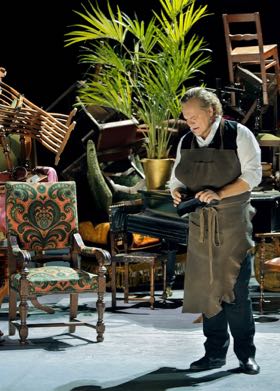
Michael Volle as Hans Sachs
All photos copyright Bayreuther Festspiele / Enrico Nawrath
Famously, controversy is the stuff of Bayreuth, be it artistic, philosophic or political. As well occasionally a Bayreuth production can simply be illuminating, as is the Barrie Kosky production of Wagner’s only comedy, Die Meistersinger.
Though Wagner’s comedy is only comedy in so much as it is the triumph of youth over age unless maybe you find the caricature of the Nürnburg town clerk Beckmesser to be amusing, or maybe you find it a bit amusing that a pretty young German girl is courted by three men, a young man and and old one and a Jew. Fortunately, like all comedy, the situation gets properly resolved — in Bayreuth youth is poised to renew an already perfect world.
Director Barrie Kosky does however take the comedy idea very seriously and creates Meistersinger’s entire first act as schtick. It takes place in Wagner’s Bayreuth home, confusing Wagner with Hans Sachs, Cosima Wagner with Eva, Franz Liszt (Cosima’s father) with Eva’s father Pogner. Wagner and Liszt play a mock piano duet, and later nine medievally dressed men climb out of the piano (how many clowns fit into a VW?). And these gimmicks are just for starters in this deft transposition of St. Catherine’s church into Wagner’s salon.
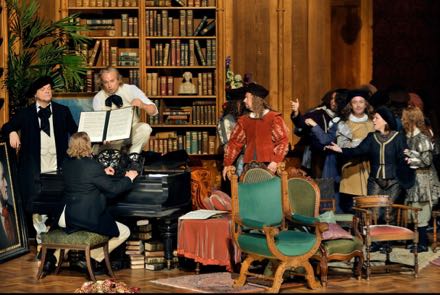
Michael Volle as Wagner, Günther Groissböck as Liszt,
Klaus Florian Voght as Walter with the mastersingers
At the act’s conclusion the Wagner residence dissolves into the apparition of a large, secular, quite empty room (hall), the signal that the fun is over. Thus we have our first suspicion that not only will the first act Wagners-at-home-sitcom become a play superimposed upon a play, but that there will be and even bigger, totally public drama. From hints in the sitcom (Cosima’s Jewish lover, conductor Hermann Levi AKA Beckmesser is humiliated) of course we know what the drama is about.
The Barrie Kosky second act is anti-comedic in that we have no context in which to place the complex Wagner/Hans Sachs story. The Wagner household furniture is piled up on a dark stage and we see little else. The Nürnberg intrigues begin, and things get messed up to the degree that there is a storm (as in Rossini’s Barber) though it is not a bit comedic (funnily enough a clock does run backward). Wagner’s storm is completely musical, an outburst of 56 independent voices! Director Kosky renders the midsummer night riot as a pogram, and indeed for Wagner this ethnic hysteria is not a farfetched musical scenario.
The third act is back to schtick. Director Kosky brings the private and public situations to trial, and we do have a quite specific and certainly witty comedic context — sessions of the Nurnberg Trials. There are personal testimonies that resolve into the Rossini moment when absolutely everything stops, the startled principals are absolutely stunned — thus the glorious private celebration that is Wagner’s sublime quintet.
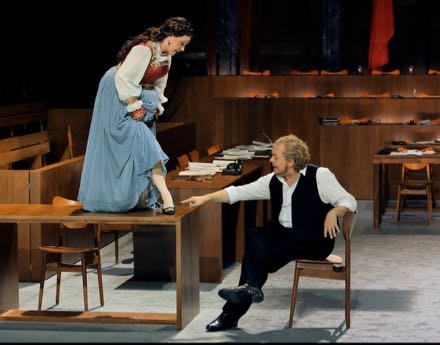
Emily Magee as Eva, Michael Volle as Hans Sachs
And then there are public testimonies that are distantly reminiscent of the music lesson in Rossini’s Barber. Beckmesser is ruthlessly ridiculed.
Finally it becomes the public resolution that we have been waiting for, everything becomes what it must be. And that is a celebration of a music that will endure within director Barrie Kosky’s world, and in our world, no matter what its content may be. A full symphony orchestra magically slips onto the stage. It is Nurnberg’s beloved Hans Sachs or more precisely it is Wagner himself who conducts the opera’s monumental farewell, its magnificent hymn to German art.
Keep in mind that the on-stage symphony orchestra is in addition to the ninety or so players in the Festspielhaus’ invisible pit — an additional reminder that German art as practiced in Bayreuth is indeed magnificent.
For all its comic magnificence this Bayreuth Die Meistersinger was a subdued affair. Conductor Philippe Jordan’s persuasive orchestral well upheld the glories of the Festspielhaus’ famed acoustic but his reading of the mighty score did not command attention. The great moments were musically flaccid (for example the Act II riot, and in fact the Quintet), possibly rendered such by Mr. Kosky’s shocking staging that often dramatically overpowered or sometimes simply flattened these moments. The musical effect was further dampened by the miscast Eva (British soprano Emily Magee) who brought no vocal or dramatic focus to her pivotal scenes within the larger Kosky dramas (and possibly as well by the controversially light voiced Walter).
With this one Anglo-Saxon exception the balance of the cast was German or Austrian and deeply satisfying. The Hans Sachs of Michael Volle is well known, and shown to perfection in this complicated production, as did the Beckmesser of Johannes Martin Kränzle (who took the second to last bow!). Tenor Klaus Florian Voght is an exceptionally light lyric dramatic tenor (jugendlicher heldontenor), an ethereally voiced singer who is evidently appreciated on some Wagnerian stages as Mr. Voght is legacy casting from the 2017 Bayreuth Meistersinger). His thin, boyish, pure-toned voice did not create a convincing vocal Stolzing presence, though he well upheld Mr. Kosky’s character needs. Günther Groissböck well fulfilled his role as Cosima’s bewigged father Lizst and was exceptionally sympathetic as Eva’s father. Tenor Daniel Behle held powerful sway as Sach’s apprentice David, as did Wiebke Lehmkuhl as Eva’s maid Magdalene, both artists assuming more musical presence in Wagner’s thick score than the Eva or Walter.
For the record, the trepidations one may harbor about the storied lack of comfort of the Bayreuth Festspielhaus may be put to rest. The benches are padded, there are backs and you are not crowded. Normally the thrill of simply being in this august temple of Teutonic art will overcome all climatic discomfort (it can be warm). The one-hour intermissions are appreciated because normally after a Bayreuth act you have a lot to chew on before taking on more. Refreshment is, contextually, reasonably priced.
Additional production information:
Chorus and Orchestra of the Bayreuth Festival. Sets: Rebecca Ringst; Costumes: Klaus Bruns; Lighting: Franck Evin; Dramaturgy: Ulrich Lenz. Festspielhaus, Bayreuther Festspiele, Bayreuth, August 12, 2018.<
Lohengrin at Bayreuth
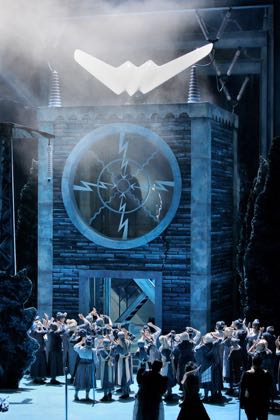
Lohengrin's swan
All photos copyright Bayreuther Festspiele / Enrico Nawrath
Three electrifying moments and the world is forever changed.
Elsa is to be burned at the stake for murdering her brother, the fire is lighted. A cataclysmic electrical display travels across live points on monumental insulators and conducts itself through the town clock upon which a white space ship in the vague shape of a giant moth alights (other times a swan). Elsa’s savior appears in street clothes wearing insulated gloves.
Matched by an orchestral display of appropriate proportion.
He sings but he is not tenor Roberto Alagna who would have brought his unique colors and attitudes to Lohengrin had he not cancelled three days before rehearsals were to begin. There were moments throughout evening when I could hear his voice and sense his persona, matched in so many ways to the lyricism, vulnerability and delicacy of mezzo Waltraud Meier, Wagner’s Ortrud in this production.
Polish tenor Piotr Beczala stepped in to sing his first Lohengrin. His was a spell binding portrayal, heroic in its youthful strength, of unflagging voice in its careful shaping of the subtleties of text, and profoundly moving as the tragic, failed savior of the duchy of Bramant.
In this production created by German visual artists (painters) Neo Rauch and Rosa Loy, and American stage director Yuval Sharon one is not sure how the concept evolved — to wit moths (like people) are attracted to light (enlightenment) and executed (confused) by touching its energy. As unlikely a metaphor as it was, finally, it was a powerful metaphor that took us to Wagner’s philosophical plain and kept us there, director Sharon staging the action in stultifying ceremonial symmetry to achieve solid inviolable confirmation.
The phenomenal energy introduced by Lohengrin burst the bindings holding Elsa to the stake, and this was the same energy that was to have bound her forever to Lohengrin, pulses of electricity rushing along cables into the marriage chamber as he bound her with electrical cord to a giant illuminated insulator.
But Ortrud had come to Elsa in a truly magical garden (mysterious foliage moving every which way) to warn her of the dangers and the insult of accepting what she must not know. Conductor Christian Thielemann convincingly led the two women to an understanding that overcame the mandate imposed on Elsa of blind acceptance of the imposed order. The radical strength imparted by Ortrud overcame Elsa’s blind ties to Lohengrin, and she was heroically able to burst the binding of matrimony in a truly magisterial musical climax.
And in the last scene Ortrud, bound to the stake to die for her participation in Telramund’s pagan, dark world, heroically burst her bindings as well. Stage director Sharon’s world is blatantly politically correct, and always a few clever and significant steps beyond Wagner’s Romantic philosophy. Mr. Sharon simply changed Richard Wagner’s ending — Elsa does not fall dead.
In a final sacrificial act Lohengrin attaches a backpack of pure light to Elsa who, with Ortrud goes forth to found, presumably, a new, enlightened world, leaving behind, presumably, the combative, male centricity of the old order. Wagner’s dream of theater as a religious rite was fully achieved and the audience went wild with its new liberation, with its rebirth into a new, maybe better world — though a world unfortunately left undefined, and certainly unquestioned.
Note that Cosima Wagner (Richard's widow) famously went forth to preserve Wagner’s nationalistic ideals, making Bayreuth a foundation of Nazism. Note that Katerina Wagner today preserves the Wagner legacy and Bayreuth canon, and she preserves its firm national identity (no English to help a significant if small percentage of foreigners). Though Mme. Wagner has embraced electrical rather than gas lighting, and installed the latest stage machinery she has not added supertitles, thus betraying her great grandfather’s greatest theatrical ambition — an immediacy of comprehension.
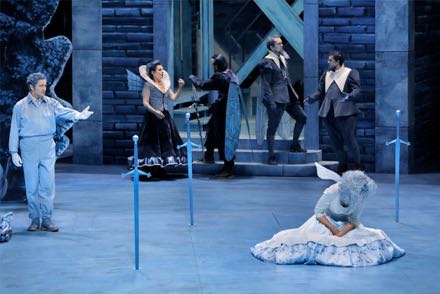
Lohengrin, Ortrud, Telramund, King Heinrich, a herald, Elsa
Painters Rauch and Loy’s world is brilliantly old fashioned in feel, painted drops the primary background. Sophistication abounded in the use of scrims, shadowy moving pieces and color. Architectural pieces and costumes superimposed the Medieval upon the Romantic, layered the industrial and modern, and confused the real with the fantastic, to wit pale, moth colored Elsa (well, until she was electric orange), not to overlook the moth wings, subtly worn by all the principles as if natural attire.
All the magic of Bayreuth’s Festspielhaus was in place — the hidden orchestra of absolute musical authority, the present acoustic that permits casting of artists of intimate intensity like 62 year-old Waltraud Meier as Ortrud whose voice very rarely betrayed its age and always found the full depth of character. The persuasive soprano of Anja Harteros kept Elsa as the focal point of this production, clearly sailing over the ensembles, never losing its inherent sweetness. Polish Tomas’s Konieczny had little to do other than be a force of darkness, Georg Zeppenfeld as King Heinrich was the benign moderator.
Conductor Christian Thielemann miraculously accomplished the required musical persuasion.
Gianni Schicchi in Arezzo (by Oberlin in Italy)
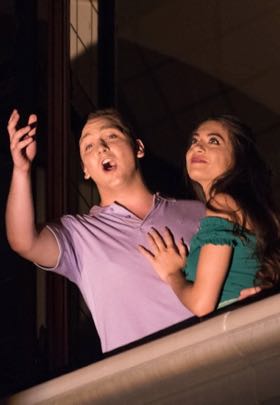
Giuliana Bossa as Lauretta, Ethan Burck as Rinuccio
It’s an all too rare pleasure to see Puccini’s only comedy as a stand alone opera. And more so when it is a careful production that uncovers the all too often overlooked musical and dramatic subtleties that abound in Puccini’s last opera.
Gianni Schicchi (1918), like Verdi’s Falstaff (1893), masterfully parses its dirty trick comedy among many players and many musical forms, though Puccini’s world is much evolved from that of Verdi, to include minstrel, jazz, Orientalism, musical alliteration, dissonance, spoken word, even a couple of old fashioned arias. Conductor Kevin Class did not miss a beat, making the most of every last bit of this stylistic richness, providing ample fodder for stage director Isabel Milenski’s [this critic’s daughter] canny take on Puccini’s comedy.
Even though Puccini’s hero — lifted from Dante’s Inferno — predates Verdi’s Shakespearean Falstaff by a few hundred years Schicchi’s wily, positive intelligence resonates in a modern, exploding world in ways Falstaffian self-indulgence simply cannot. Director Milenski’s Schicchi was 19 year-old [!] tenor Michael Butler who enthralled the audience with non-stop wit every bit as much as he enraged dead Buoso Donati’s relatives with his deceit.
Young Butler had lots competition in the charm department as this Gianni Schicchi was the first of three operas (with La Rondine in the Petrarca Opera House and Ariodante on the steps of the Church of the Assumption) presented gratis to to an enthusiastic public by Oberlin Conservatory’s summer program in Arezzo, Italy. The singers were essentially American undergraduates very much in the process of discovering their voices, finding their stage personae and, coincidently, learning Italian!
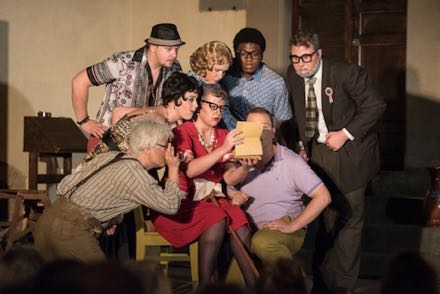
Zita reading Buoso's will to his relatives
To a man these were charming, talented young artists, vocally and dramatically coached in their roles by operatic professionals and meticulously rehearsed in Gianni Schicchi’s formidable ensembles, preparations that made this Gianni Schicchi into opera theater of solid effect.
Lyrically Gianni Schicchi belongs to the young lovers, Rinuccio and Lauretta, who were far closer to Puccini’s prescribed 21 and 18 year-olds than the usual big house lovers. It was a huge pleasure to watch Ethan Burck and Giuliana Bossa as they negotiated Puccini’s lovely lines with concentrated vocal thinking, finding themselves at last in a high window overlooking the courtyard of the Palazzo dei Priori (where we were seated) singing their contentment.
Scenic design credit goes mostly to the long ago architect of this 14th century palazzo who provided a big entry door through which the dying Buoso (prop master Luke D’Alessandro was himself this prop!) emerged onto the door’s porch (now a stage), led by Rinuccio to the bed where he expired to be stuffed (except for an arm) later into the armoire on another wall. Long ago someone had planted a tree to shade the porch into which old (well, maybe 20), furious Aunt Zita climbed, a perch from which she hurled dead Buoso’s pill bottles at Schicchi, and behind which pregnant Nella had a bit of morning sickness.
You get the idea — all of Buoso’s relatives were characters who did their natural thing without forcing comedy. And particularly Schicchi who tore up the stage in his “Si corre dal notaio,” playing to the hilt the smarts of a maximally personable auto mechanic like a hard sell vaudeville artist — Aunt Zita threw her cane at him which he then used to execute Puccini’s strutting and twirling.
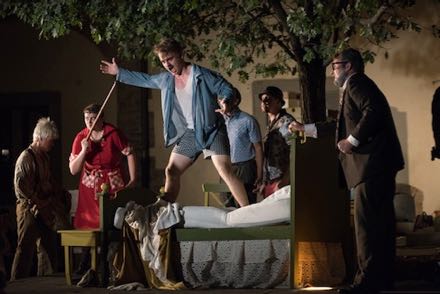
Betto, Zita, Schicchi, Rinuccio, Gherardo, Simone
Not to mention Betto enacted by Korean American Simon Nam who shuffled and shook a spoon to Puccini’s pentatonic Butterfly quotations, and Zita, Nella and La Ciesca who did their best, with Puccini’s help (“Spogliati, bambolino”), to seduce Schicchi, casting suspicion on who might be the actual father of Nella’s expected child.
Conductor Class kept his tempi deliberate, and director Milenski effected highly theatrical stage pictures that camouflaged strategic sight-lines to the conductor, thus the well-known treacheries of the three formidable ensembles were painstakingly overcome — a feat that provided enormous satisfaction not to say relief to all involved — singers and spectators!
Finally Schicchi gave the spoken encomio (what better use for Buoso’s money than to seed the lives of the triumphant young lovers) in perfect Italian, an additional reward to us all thanks to the splendid efforts of Oberlin in Italy.
Cast and production
Gianni Schicchi: Michael Butler; Rinuccio: Ethan Burck; Lauretta: Giuliana Bossa; Zita: Helena Crothers; Nella: Madison Williams; La Ciesca: Emma Webster; Simone: Thomas Petrushka; Betto: Simon Nam; Gherardo: Matteo Adams; Gherardino: Jenna Venturi; Marco: Lukasz Zienturski; Doctor / Notary: Robert Raso; A cobbler: Seth Tack; A dyer: Alex Smith. Orchestra: L'Orchestra AgrimusArte. Conductor: Kevin Glass; Stage Director: Isabel Milenski; Stage Design: Elizabet Puksto; Costume Design: Clara Fath; Lighting Design: Christian Londos. Cortile del Palazzo dei Priori, July 27, 2018.
Mefistofele at the Chorégies d'Orange

Erwin Schrott as Mefistofele [All photos copyright Philippe Gromelle, courtesy of the Chorégies d'Orange]
This is the one where a very personable devil tells God that mankind is so far gone it isn’t worth his time to bother corrupting it further.
It’s the famed librettist Arrigo Boito’s only opera, premiered in 1868 when he was 26 years-old, filled with youthful musical idealism and the then avant-garde ideas flowing down from the north. Though what we have seen just now in Orange’s huge old Roman theater is his 1876 version, much reduced in length. Faust is now a tenor (a flashier voice) and there is the added Act III grand duet “Lontano, lontano” - the too good to pass up opportunity to sentimentally dwell on what Faust and Marguerite’s lives might have been.
Said to have been composed in response to Gounod’s superficial treatment of the famed legend Boito’s opera has nonetheless become a vehicle for the world’s liveliest metteurs en scène to show supercilious wit. To be recalled are a couple of late 1980’s productions — the Genoa production by American director Ken Russell where the religious fervour of nuns becomes the fuel for a spaceship headed to the Walpurgis Night, and the Geneva production by Canadian director Robert Carson with its bared female breasts and exposed male genitalia. More recent was the Jean-Louis Grimpa production in Montpellier where Mefistofele exulted in Grecian beauty from afar, perched among audience on a balcony railing, legs dangling into the void.
Jean-Louis Grimpa, now in charge of the Chorégies d’Orange (as well as Monaco’s Opéra de Monte-Carlo) based his production for Orange’s Théâtre Antique on his Montpellier production, the difference becoming that of scale, the farcical indulgences of Montpellier were sacrificed to the monumentality of Roman architecture. The directorial wit was now expressed in a tongue-in-cheek explosion of staging grandeur. So much spectacle, so little content. And so much fun.

The Walpurgis Nacht, and the faraway earth
The Orange stage is 300 plus feet wide, the height of the back wall is 100 plus feet. The combined choruses of the operas of Monaco, Nice and Avignon swathed in miles of white gossamer-like fabric flowed on, across and off the stage as the heavenly choirs. For the Walpurgis Night this massive chorus wore exaggerated, hugely colorful village fair theater costumes. They cavorted onto and off of the stage and wildly upon and down from several rolling, welded metal staircase ramps (the only constructed scenery) abetted by clowns on very high stilts and more clowns on roller blades.
All this against full back-wall color projections, evoking marvel at the advancement of theatrical projection technology at Orange over the past ten years, from the first black and white moving shadows of a Trovatore way-back-when to the now detailed, almost photographic architectural images. Of spectacular effect was a small platform that hung from the recently added roof now covering the Théâtre Antique’s stage that slowly descended (the platform) while the image of an acropolis slowly arose. The physical sensation of ascent this trick created was truly amazing!
Opera’s stories are told to the Théâtre Antique’s 9000 spectators in bold strokes, without subtlety. The staging in Orange is always evident, principles congregate down stage center where they are both singer and scenery, and where they take advantage of the theater’s amazing and excellent acoustic to sing their arias and duets of which Boito’s Mefistofele offers a plentitude.
As is usual Mefistofele is never far from front and center anyway. Here it was Uraguay bass-baritone Erwin Schrott who managed a non-stop plethora of flashy and triumphant poses for three solid hours, including a beyond-the-pale series of catcall whistles as he collapsed on a walkway just by conductor Nathalie Stutzmann for the final notes of the opera. Mr. Schrott was in fine voice indeed, and well deserves to count Mefistofele among his signature roles (Don Giovanni as example of another).

Faust and Margherita
Monaco born tenor Jean-François Borras was a large scale Faust, boasting sufficient heft and presence of body and voice to persuade even the furthest away spectators of his earnest pursuit of enlightenment and his distress at the plight of poor Margherita. Certainly more at home in the French repertory his Faust missed the Italianate mannerisms that could have made Boito’s naive music into a more convincing vocal display. The same may be said of the Margherita of French mezzo-soprano Béatric Uria-Monzon who was Orange’s spectacular Carmen in 2008 (among many roles at the Chorégies). She delivered the famous “L’altra notte in fondo al mare” in splendid voice though she did not move us with the glorious variation of vocal colors that have made this aria a standard audition piece for Italianate voices.
The Orchestre Philharmonique de Radio France was conducted by Nathalie Stutzmann, a frequent collaborator with Jean-Louis Grimpa at the Opéra de Monte-Carlo. Amazingly, impeccable pit/stage ensemble at Orange is the norm, and this Mefistofele was no exception. The two harps of the orchestra earnestly pursued their angelic duties, the satanic bass drum player gave a virtuoso performance together with the dramas that unfolded on the timpani. Mme. Stutzmann held it all together ably without resolving the question of whether Boito’s youthful attempt at composing opera is great or even good music.
The world awaits a production of Boito’s 1867 La Scala score. Only then may we know if Boito’s opera is the send-up of Goethe’s tale that so amuses stage directors.
Cast and production information:
Mefistofele: Erwin Schrott; Faust: Jean-François Borras; Margherita/Helen: Béatrice Uria-Monzon; Marta: Marie-Ange Todorovitch; Wagner/Nero: Reinaldo Macias; Pantalis: Valentine Lemercier. Orchestre Philharmonique de Radio France. Choruses of the operas of Avignon, Monte-Carlo and Nice, Children’s Choir of the Académie Ranier-III-de-Monaco. Conductor: Nathalie Stutzmann; Stage Director: Jean-Louis Grinda; Scenery: Rudy Sabounghi; Costumes: Buki Shiff; Lighting: Laurent Castaingt; Videos: Julien Soulier. Théâtre Antique, Orange, France, July 9, 2018)
A Choral Triogy at the Aix Festival

Nicolas Simeha as the stone collector [Seven Stones and Dido and Aeneas photos copyright Vincent Pontet
Orfeo & Majnun photo copyright Vincent Beaume, all photos courtesy of the Aix Festival]
What Seven Stones (the amazing accentus / axe 21), and Dido and Aeneas (the splendid Ensemble Pygmalion) and Orfeo & Majnun (the ensemble [too many to count] of eleven local amateur choruses) share, and virtually nothing else, is spectacular use of chorus.
Seven Stones is an Aix Festival commission to the Czech composer Ondrej Adàmek (b. 1979), the Icelandic poet Sjòn — a pen name meaning “sight” (b. 1962), and the Niçois dancer / metteur en scène Éric Oberdorff (thirty-some) that resulted from a 2012 symposium at the Aix Festival’s Académie imagining a or maybe the future for opera.
And voilà, six years later a futuristic opera indeed. It blew us away by sheer audacity, charmed us by sheer audacity and entertained us by sheer audacity. Seven Stones is, need I say, complicated — a libretto, in English, of unfathomable depth based on stones and stoning and the magical number seven passing through nonlinear time from middle Europe through Argentina to Paris and Jerusalem passing by the moon to return finally to middle Europe for a murder then an admonition.

Principals and chorus of Seven Stones
There was no orchestra and no scenery but there were four singers who rarely, very rarely, and only incidentally sang and there was a four part (satb) chorus, Paris’ accentus / axe 21, that in fact never sang a note. These twelve singers associated with Paris’ elite Ensemble Intercontemporain spoke rhythmic text configured as magnificent, complex syllabic, toneless madrigals. These choruses were the major part of the evening’s one hour twenty minute duration.
During his twelve year reign departing Aix Festival general director Bernard Foccroulle (Foc-crewl- lih — did I get that right?) tenaciously and fruitfully explored opera’s most basic tenet — collaboration. Seven Stones well serves as his crowning achievement!
Seven Stones is a musico-dramatic mechanism. the score is not only auditory notation, in effect it also seems to be notated movement that is the staging of its 13 scenes. The singers magnify the colors of their sound world by hitting, rubbing or pounding on abstract constructions, some huge, that serve the story and music and as well as create the spectacle. There were a few instrumentalists (violin, cello, exotic zithers, an electric organ to create quotations of western and eastern music), whose on stage instruments were picked up from time to time by principals and chorus to be used as rhythmic noise sources.
There is of course the central figure of the poem. The stone collector (mineralogist) spoke and stuttered throughout the evening, abetted by three female voices who assumed various guises to confound the stone collector in complex clucks, pops and runs of language, sumptuously notated and executed. Needless to say these performances were as astonishing as the madrigals executed by accentus / axe 21.
Perhaps three, maybe four of the stones might have sufficed. The novelty wore thin.
Dido and Aeneas is Henry Purcell’s 1688 famous operatic tragedy, famed not only for the wrenching suicide of its heroine Dido, but also by the hopelessly bleak lament of the citizens of Carthage in their closing madrigal. Though of monumentally tragic proportion the 50 minute or so duration of Purcell’s opera usually condemns it to share the stage with another short opera, diluting the tragic spell it creates.
The Aix Festival extended the opera’s length, making it a one opera evening however brief (one hour twenty minutes) by adding a prologue to replace the original, long lost Purcell composed prologue. The Festival commissioned French novelist Maylis de Kerangal (b. 1967 in Toulon — her most recent (2016) English translated novel is The Heart: a novel [Réparer les vivants]). Mme. de Kerangal’s Dido and Aeneas prologue imagines Dido arriving in Africa on a ship together with 80 kidnapped girls, prey to Dido’s army of men who will father their children in Carthage.

Actress Rokia Trore with a few of the 80 silent abducted Cyprian girls
Mali born, internationally decorated actress Rokia Trore, founder of the Passerelle Foundation [for the arts] in Bamako, Mali’s capital, delivered the monologue. Slowly traversing the stage left to right she delivered her first-hand, immediate account of the fictional abduction of the girls, the abuses they suffered during their voyage to and the miseries of their lives in Africa. It was spoken in splendrous French, the official language of Mali.
The prologue did indeed offer an oblique perspective on the founding of Carthage back in 146 BC. Carthage, the city (in today’s Tunisia) was destroyed soon after it was founded. This new prologue well serves as a curse upon Dido's city, and more immediately upon her impending marriage to Aeneas.
Said to be a production of the Aix Festival’s Académie, the principal roles of the Purcell tragedy seemed to be taken by apprentice artists, perhaps in appreciation that Dido and Aeneas was written to be performed by students at Mr. Priest’s boarding school for girls back in 1689. In Aix the promising voices of these young participants exemplified the early stages of mastery of their craft. Note that after the first performance (which I attended) the Dido was replaced by a career singer.

Three of the principals with the chorus of the Pygmalion Ensemble
The evening did however attain some tragic grandeur in the voice of the Carthaginians, the 30 singers of the chorus of the Ensemble Pygmalion, and in the rich realization of Purcell’s scanty original score (string quartet plus harpsichord). Of the well endowed instrumentation of Ensemble Pygmalion’s twenty-seven orchestra players, many doubling on additional instruments, the continuo generously consisted of two keyboards, three plucked instruments and three strings.
The Ensemble Pygmalion is resident at the Opéra de Bordeaux, and associated with Paris’ Opéra Comique. It is one of the cultural glories of France. For these performances in Aix the Ensemble Pygmalion was lovingly conducted by well-known Czech early music conductor Václav Lucs, may we assume it was his edition.
The final chorus “With drooping wings” found its wanted sublimity and the audience roared its appreciation.
Orfeo & Majnun is a co-production with Brussel’s Monnaie and Rotterdam’s Stichting operas, a festival in Kraków (Poland), plus entities in Malta and Vienna, and a town in Portugal — an unlikely conglomeration indeed. It is intended as a public event/celebration (no admission charge) having premiered a couple of weeks ago in Brussels.
The opera, really musical theater, was the super-imposition of the Orpheus story and the Persian tale of Majnun and Layla. The common ground of the two stories are laments — Orpheus addresses Charon, the guardian of Hell’s entrance, and Majnun addresses the natural world (animals). But both Eurydice and Layla die anyway. While Majnun falls dead on Layla’s tomb, Orpheus becomes the voice of classical poetic love.
In Aix the single performance occurred in the Cour Mirabeau, the city’s famed grand avenue, of which it took over about half the length. Thousands of chairs were set up, enormous video screens were set up to pass the visual images along the route, and there was the attendant sound amplification (slightly out of sync with the visual images). One can only imagine the security that was in place.

The final moment of the opera, lovers in white, narrator in blue.
Like all productions of the Aix Festival this one too was beautifully and thoroughly produced, thus certainly our security was state of the art — only later did I understand that we had been sitting ducks.
The intent of the project was to illustrate a commonness of European and Middle-Eastern cultures. Certainly this was somewhat achieved even though the philosophic underpinnings of the two tales are strikingly different. However the juxtaposition of musical languages made it glaringly evident that there is irreconcilable difference of sensibility between the rich structures of Western music and the sharp melismatic lines of Eastern music.
The opera boasts three composers, the Palestinian Moneim Adwan who one assumes created the extended Arabic based episodes, the British composer and organist Howard Moody, and the Dutch composer Dick van der Harst. We had no idea who did what, except we assume that one or the other of the European composers will have accommodated the classical Arabic sounds to the basically musical theater sound of the evening.
Of the four fine singers only French baritone Yoann Dubruque as Orfeo stood out. Singing in English (Eurydice and the Narrator both used French, the Persians sang in Arabic) he alone found the direct and easy charm of musical theater.
Western music has traditionally used chorus to express a universality of sentiment. Thus in such an undertaking as this ode to multiculturalism a massive chorus would make its message exponentially more forceful. What seemed to be hundreds of amateur singers offered their voices to the many, not easy choruses that the composers included. These wonderful musicians succeeded with aplomb, singing without score in semi-staged movements.
It was a long one and one half hours.
Cast and production
Seven Stones Maid / Storyteller: Anne-Emmanuelle Davy; Land Lady / Storyteller: Shigeko Hata; Stone Collector: Nicolas Simeha; Stone Collector's Wife: Landy Andriamboavonjy; Chorus: accentus / axe 21. Conductor: Ondřej Adámek; Additional conductor: Léo Warynski; Mise en scème and choreographer: Éric Oberdorff: Scénographie et lumière: Éric Soyer; Costumes: Clémence Pernoud. Théâre du Jeu de Paume, Aix-en-Provence, July 8, 2018.
Dido and Aeneas Dido: Anaïk Morel; Femme de Chypre: Rokia Traoré; Æneas: Tobias Greenhalgh; Belinda: Sophia Burgos; Sorceress / Spirit: Lucile Richardot; Second Woman: Rachel Redmond; First Witch: Fleur Barron; Second Witch: Majdouline Zerari; Sailor: Peter Kirk. Chœur et orchestre: Ensemble Pygmalion. Conductor: Václav Luks; Mise en scène: Vincent Huguet; Décors: Aurélie Maestre; Costumes: Caroline de Vivaise; Lumière: Bertrand Couderc. Théâtre de L/Archevêché, Aix-en-Provence, July 7, 2018.
Orfeo & Majnun Majnun: Loay Srouji; Layla: Nai Tamish Barghouti; Orfeo: Yoann Dubruque; Eurydice: Judith Fa; Narratrice; Sachli Gholamalizad. Orchestre: Ensemble interculturel de l'Orchestre des Jeunes de la Méditerranée; Chef de chœur: Philippe Franceschi avec la participation d’amateurs choeurs; Sinfonietta: Session de l'Orchestre des Jeunes de la Méditerranée. Direction musicale: Bassem Akiki; Mise en scène: Airan Berg and Martina Winkel; Créatures animalières: Roger Titley; Costumes, dramaturgie: Martina Winkel; Lumière: Luc Schaltin; Vidéo: Daan Milius and Martina Winkel; Chorégraphie: Marta Coronado. Cour Mirabeau, Aix-en-Provence, July 8, 2018.
L'Ange de Feu at the Aix Festival
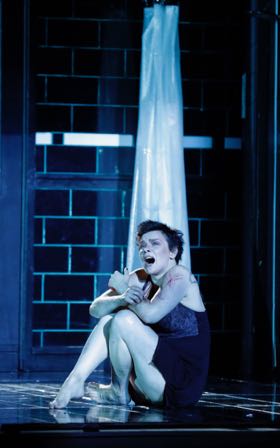
Aušrinė Stundytė as Renata
[All photos by Pascal Victor / Artcompress © courtesy of the Aix Festival]
Prokofiev’s Fiery Angel is rarely performed. This new Aix Festival production to be shared with Warsaw’s Teatr Wielki exemplifies why.
Its primary role, the possessed Renata, is punishing nearly beyond comprehension and its relentless, lurid narrative is difficult to follow, and in fact the vulgarity of its music can be off-putting.
The Fiery Angel is the third of Prokofiev’s seven operas (The Gambler and Love for Three Oranges are the first two), and the last opera he wrote before his return to Russia in 1936. Though begun in 1919 when the composer was 28 years old, and completed only in 1927 it was not premiered until 1955 in Paris and then in Vienna.
There is no doubt that The Fiery Angel is Prokofiev’s most intense dramatic music. It tells the ugly story of a young girl possessed by an angel, though perhaps a devil. She wishes to make physical love with her possessor. Two or so hours and several mis-adventures later she is exorcized (unsuccessfully) in a convent together with other nuns. It is a medieval tale of expressed sexual desire told from an early twentieth century symbolist perspective.
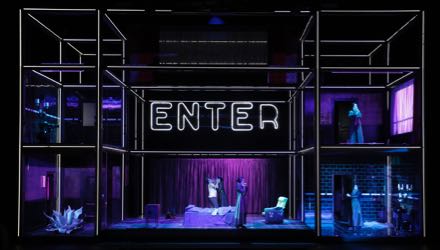
At the beginning there was the hotel room.
The possessed Renata and her would be redeemer, the knight Ruprecht seek and do find the angel of fire incarnate with the help of sorcerers. Finally Renata gives herself sexually to Ruprecht in place of the angel. A short philosophical discussion ensues between Mephistopheles and Dr. Faustus. And, voilà, Renata is condemned to be burned at the stake.
Mariusz Trelinski, artistic director of Teatr Wielki, staged the opera updating the action to what seemed to be rural eastern European surroundings in the communist 1960’s. Ruprecht seemed to be some sort of traveling salesman (if there were such then and there) who happened onto a seedy small town hotel. One recalled the Arthur Miller play Death of a Salesman.
Strangely, though we are in France and there are scenes specifically in medieval Cologne there were English language neon signs placed high in a multi-storied grid that was the stage face. The Cologne scenes were then staged on platforms in its upper reaches, effectively and unfortunately disembowelling Renata and Ruprecht’s voices from the dissonant maelstrom emanating from the pit way below.
Japanese conductor Kazushi Ono urged ever greater volume and bombast from the stalwart Orchestra de Paris, complementing the crassness of the staging. One of the many remarkable moments was in fact the long awaited sexual consummation of Renata and Ruprecht, the couple humping on an upper level, the orchestra turging away way down below while a miniature Ruprecht double attempted to jump rope on the stage floor.
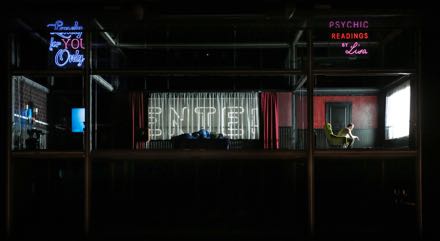
Renata (on left), Ruprecht (on right)
The role of Renata was sung by Aušrinė Stundytė, the Lithuanian soprano who incarnated the brilliant Lady Macbeth of Mtsensk in Lyon. Mme. Stundytė brought similar intensity to the obsessed Renata, but fell victim, understandably, to the obtuse staging demands as well as to the stamina needed to complete the role. She was essentially voiceless for the concluding exorcism.
The American baritone Scott Hendricks was the Ruprecht. This esteemed artist seemed a fish out of water, his fine, Italianate lyric voice not finding an edge or the volume needed to embody this complex, possessed-by-love knight who first attempts to rape Renata, and then in this production is raped by Renata. As well, and more importantly, Mr. Hendricks was placed in the upper reaches of the grid for his big scenes, depriving us of a direct presence, and an immediacy of voice.
Faring better were tenor Andrei Popov as Mephistopheles and bass Krzysztof Baczyk as Faust who both essentially tore up the stage in their stage level scene in the hotel bar. Both artists succeeded in projecting words and sentences that directly tied us to content, however oblique, an attribute sorely lacking in the balance of Mr. Triliński’s production.
Cast and Production
Renata: Aušrinė Stundytė; Ruprecht: Scott Hendricks; La Voyante / La Mère supérieure: Agnieszka Rehlis; Méphistophélès / Agrippa von Nettesheim: Andreï Popov; Faust / L’Inquisiteur: Krzysztof Bączyk; Jakob Glock / Un médecin: Pavlo Tolstoy; Matthieu Wissmann / L'Aubergiste / Un serviteur: Łukasz Goliński; La Patronne de l’auberge: Bernadetta Grabias; Première religieuse: Bożena Bujnicka; Seconde religieuse: Maria Stasiak. Orchestre de Paris, Chorus of the Opera of Warsaw. Conductor: Kazushi Ono; Mise en scène: Mariusz Treliński; Scenery: Boris Kudlička; Costumes: Kaspar Glarner; Lighting: Felice Ross; Vidéo: Bartek Macias; Chorégraphe: Tomasz Wygoda. Grand Théâtre de Provence, Aix-en-Provence, July 5, 2018.
Ariadne auf Naxos at the Aix Festival
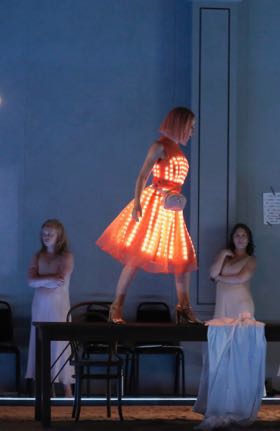
Zerbinetta on Ariadne's table with two of the three sprites
[All photos by Pascal Victor / Artcompress © courtesy of the Aix Festival].
Yes, of course British stage director Katie Mitchell served up Richard Strauss’ uber tragic Ariadne on Naxos at a dinner table. Over the past few years Mme. Mitchell has staged quite a few household tragedies at the Aix Festival, mostly at dinner tables, though some on doorsteps.
Among her Aix projects Mme. Mitchell staged George Benjamin’s Written on Skin with libretto by British playwright Martin Crimp. Mr. Crimp has subsequently served as dramaturg for Mme. Mitchell’s Aix Pelleas et Melisande and now for Ariadne, both productions brilliantly moving to meta-theatrical levels (metatheater is a Martin Crimp coined term). This simply means that it is theater as seen by theater — the original exists as well as how it is seen. Like metaphysics.
Of crucial contribution to the Aix Ariadne was the conducting of German born Marc Albrecht, now chief conductor of the Dutch National Opera. This maestro exploited the chamber music voice of the Strauss score in the expanses of the open air Théâtre de l’Archeveché, the grandness of Strauss’ orchestral introduction to the prologue monumentally minimized, but energized to accommodate the frantic transformation of the host’s (“the richest man in Vienna”) grand parlor into a makeshift theater space (a square of sand with a dinner table).
The maestro pulled out the intricacies of the myriad instrumental solos to create the usual intensity of backstage energy now augmented by the negotiations of merging commedia dell’arte with opera seria. Zerbinetta’s persuasive arguments to the opera seria’s composer seamlessly flowed into a passing moment of private musing by the composer, his fervent ode to music magically absorbed into the behind-the-scenes maelstrom.
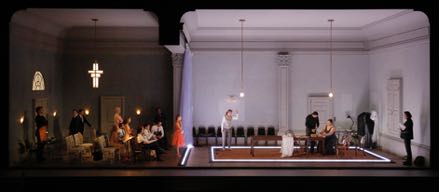
The totality of the Katie Mitchell production
And finally Mo. Albrecht transformed Strauss’ bombastic Ariadne Bacchus duet into an intimate discussion between two lovers accompanied by the exquisitely sweet comments of Dryad, Naiad and Echo, Bacchus taking frequent gulps of water from a plastic water bottle.
As Strauss and Von Hofmannsthal intended it was chamber opera, though now with Mme. Mitchell’s superimposed household on top of it — remember that the original intention was that Strauss’ opera seria was but an ending for Moliere’s Bourgeois Gentilhomme (translated by Von Hofmannstahl). In fact Mme. Mitchell’s household’s cross-dressed host and hostess sometimes interrupted Strauss’s opera with sarcastic comments (spoken) before they too climbed onto the stage to participate in Ariadne’s plight* and Zerbinetta’s solutions.
*Ariadne was pregnant.
Strauss was a very reluctant partner in this second, purely operatic version of the Strauss Von Hafmannstahl play-cum-opera, fearing with grave and indeed quite pertinent concerns a lack of comprehensibility for such a far-out, obliquely sculpted narrative. Katie Mitchell brilliantly brokered this Von Hofmannstahl/Strauss dispute by pulling it all together into one totality. The play within a play, the location and circumstance of the play, the guests at the play, the actors in the play (the commedia dell’arte troupe became transfixed by Ariadne’s outpourings), the exposed backstage psychologies, the opera indeed coalesced into pure metaphysics.
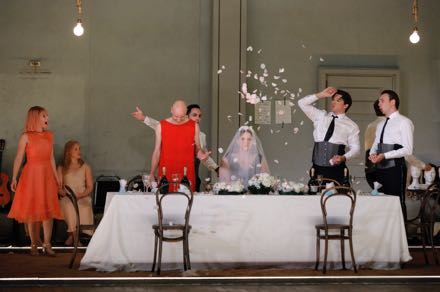
Zerbinetta, the richest man in Vienna, Ariadne, three of the commedia troupe
The Aix Festival is famed for its casting sophistication, and this Ariadne is no exception. Young Norwegian soprano Lise Davidsen let out immense, inhuman howls to welcome us to Ariadne’s solitude on Naxos. She added fine musicianship and vocal finesse in the use of her hugely powerful voice. French soubrette Sabine Devieilhe as Zerbinetta cooly seduced first the composer, and then she lectured Ariadne with splendrous soubrette tone in her lengthy, very lengthy “Großmächtige Prinzessin…So war es mit Pagliazzo.” The aria is punishing in its brilliant, stratospheric tessitura, flawlessly exuded in this Zerbinetta’s atypical soft charm and compassion that fit perfectly into the metaphysics of the production.
American mezzo-soprano Angela Brower as the composer physically conducted her opera though of course she sang not a word after the prologue, her presence in the opera seria adding the concept of creation and pride of creation to Mme. Mitchell’s inexhaustible philosophical complexities. She somehow seamlessly integrated her “Sein wir wieder gut” into the conceptual flow of the prologue, emanating gorgeous silvery tones in her radiant declaration of the powers of music.
Austrian bass baritone Josef Wagner as the Music Master was indeed authoritative in his deftly sung, deft management first of the spoken majordomo (actor Maik Solbach) and then of household’s two sets of performers. He was aided by the household’s very tall Dance Master, cross dressed and made taller by stiletto heels in the person of British tenor Rupert Charlesworth who for all his draggy, swishy flightiness was cooly supportive of the fraught performers in frank, masculine voice.
Like Zerbinetta the comedia dell’arte troupe (Harlequin, Brighella, Scaramuccia and Truffaldino) had costumes that lighted up (ah, what riches LED lights have brought to opera), in this case the exaggerated cumberbunds of their matching formal wear (black pants, white shirts) lighted up to make the flashiness of their comedic performances apparent, and in stark contrast to their weighty, maybe drab operatic counterparts.
Dryad, Naiad and Echo were physically matched to be sprites of nature, and vocally matched to be the sweetly voiced handmaidens of nature and its eternal renewal. Bacchus was sung by American heldon tenor Eric Cutter who served and re-served in stentorian voice (lubricated by gulps of water) the cake-like boxes of starry lights to Ariadne’s table throughout her death scene.
This Ariadne auf Naxos is an Aix Festival co-production with Barcelona, Paris, Helsinki, Copenhagen and Luxembourg. Be advised, it is a production worth crossing continents, even oceans to see.
Cast and Production
Primadonna / Ariadne: Lise Davidsen; Der Tenor / Bacchus: Eric Cutler; Zerbinetta: Sabine Devieilhe; Der Komponist: Angela Brower; Harlekin: Huw Montague Rendall; Brighella: Jonathan Abernethy; Scaramuccio: Emilio Pons; Truffaldin: David Shipley; Najade: Beate Mordal; Dryade: Andrea Hill; Echo: Elena Galitskaya; Ein Musiklehrer: Josef Wagner; Ein Tanzmeister: Rupert Charlesworth; Ein Offizier: Petter Moen; Ein Perückenmacher: Jean-Gabriel Saint Martin; Der Haushofmeister: Maik Solbach; Ein Lakei: Sava Vemić; L'Homme le plus riche de Vienne: Paul Herwig; Sa Femme: Julia Wieninger. Orchestre de Paris. Conductor: Marc Albrecht; Mise en scène: Katie Mitchell; Dramaturge: Martin Crimp; Set Design: Chloe Lamford; Costumes: Sarah Blenkinsop; Lighting: James Farncombe; Responsable des mouvements: Joseph W. Alford. Théâtre de l”Archevêché, Aix-en-Provence, July 4, 2018.
Don Carlos in Lyon
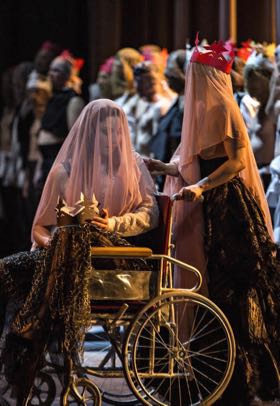
Eboli (in wheelchair) and Elisabeth at masquerade
All photos copyright Jean-Louis Hernandez, courtesy of Opéra de Lyon
Metteur en scène Christophe Honoré placed his 2016 Aix Festival Cosi fan tutte in Ethiopia. Unfortunately his current Lyon Don Carlos enjoys no such equivalent poetic intuition.
Mr. Honoré has reduced his Lyon Don Carlos to some sort of obscure theater metaphor. Thus basic scenic accoutrements and machines of an empty stage are the environments wherein the complexities of Phillip II’s filicide, uxoricide and amicicide unfold.
For the Fontainebleau forest there were some theatrical drapes and a dense, very dense fog of choking theatrical fog and not very much theatrical light. For Saint-Just there was another plane of theatrical drape and not much light, but there was a stage floor trap open to somewhere below. The masquerade was an orgy, theatrical drapes moving back and forth, hide and seek, peeking at couplings (sexual) certainly not that public during the Spanish Inquisition.
For the auto-da-fe the stage became an old raw wood theater, the Spanish court, the Flemish supplicants, and the Madrid populace stuffed into a side wall of boxes, the heretics (four total) were twitching architectural detail. Phillip II’s bedroom was a variation of the raw wood theater structure whose side boxes served to hint at cloister for the Grand Inquisitor. The stage was an empty black box for Rodrigo’s death in Carlos’ cell.
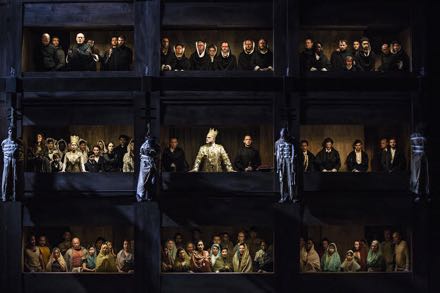
The Auto-da-fé
Back in Saint-Just the floor trap was again open to allow the entrance of incarnate Carlo V ashes in the form of a sort of walking cherub with a lighted breast plate. There was a scenic coup de theatre to let us know something had happened (what?) when a panel of drapes fell to the floor revealing a huge, seated blue madonna.
The evening was divided into two two-hour segments. At first we sat patiently during the lengthy minutes it took to cobble, and re-cobble together these set changes, and then impatiently in disbelief at such conceptual, indeed abusive ineptitude.
The edition was cobbled together as well. Among other machinations a part of the ballet was restored. Given that Ferrando had showered before his tryst with Fiordiligi back in Aix we knew a water feature would come. Voilà! The four soon to be immolated heretics fought and frolicked under an inexplicable shower of water as the ballet music chugged on. These four dancers appeared a final time laid out in Phillip II’s study during his famous soliloquy.
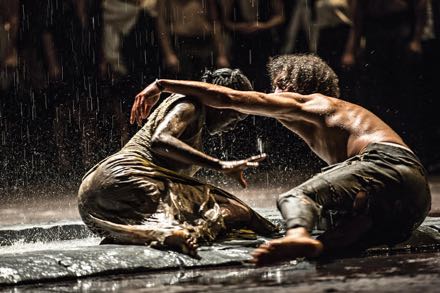
Two of the four heretics in the shower
Mr. Honoré embellished his concept by confining Princess Eboli to a wheel chair. French mezzo Eve-Maud Hubeaux is a lyric mezzo whose presence is non-threatening even without a broken leg. Her Eboli was of an engaging comic energy. French baritone Stéphane Degout is a quite lyric baritone as well, conferring a youthful naïveté on Rodrigue (Posa) that precluded a poetic gravitas we might expect from the opera’s one sympathetic personage. The easy energy of these two performers made them audience favorites.
Russian tenor Sergei Romanovsky carved a plausible Don Carlos, his light lyric voice responding to this character’s presumed epilepsy, though his swoon before Elisabeth found none of its magic. But this Don Carlos could not plausibly challenge his father. British soprano Sally Matthews has a significant wobble in her low and medium register evoking a maternal rather than romantic presence. She did find some convincing phrasing in her high voice that made her "Toi qui suis la néant" (Tu che la vanita) one of the few dramatic successes of the evening.
Italian bass Michele Pertusi as well captured some of the sublimity of phrasing in Phillip II’s "Elle ne m'aime pas" (Ella giammai m'amò) though the dignity of this scene dissolved into a dry anger that permeated his character start to finish. Italian bass Roberto Scandiuzzi was a warm voiced, bland Grand Inquisitor, though the night before he had created a dynamic Banquo in Macbeth.
With the conceptual, directorial and casting malaise of the production it was difficult to access the contribution of the pit to the evening. The Opéra de Lyon orchestra put forth some beautiful sounds, notably in the strings. Conductor Daniele Rustioni did indeed support the few successful moments of the evening with stylistic precision.
It was a long, very long, too long evening in Lyon.
Cast and Production
Philippe II: Michele Pertusi; Don Carlos: Sergey Romanovsky; Rodrigue, marquis de Posa: Stéphane Degout; Le Grand Inquisiteur: Roberto Scandiuzzi; Un Moine: Patrick Bolleire; Elisabeth de Valois: Sally Matthews; La Princesse Eboli: Eve-Maud Hubeaux; Thibault, page d’Elisabeth: Jeanne Mendoche; Une Voix d'en haut: Caroline Jestaedt; Le Comte de Lerme: Yannick Berne; Un Héraut royal: Didier Roussel; Députés flamands:Dominique Beneforti, Charles Saillofest, Antoine Saint-Espes, Paolo Stupenengo, Denis Boirayon, Thibault Gerentet. Orchestre, Chœurs et Studio de l'Opéra de Lyon. Conductor: Daniele Rustioni; Mise en scène: Christophe Honoré; Décors: Alban Ho Van; Costumes: Pascaline Chavanne; Lumières: Dominique Bruguière; Chorégraphie: Ashley Wright. Opéra de Lyon, March 16, 2018.
Macbeth in Lyon
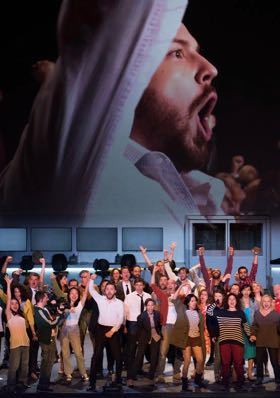
Arseny Yakovlev as Macduff (live projection) and Occupy Wall St. demonstrators
All photos copyright Stofleth, courtesy of Opéra de Lyon
A revival of the Opéra de Lyon’s 2012 Occupy Wall St. production of Verdi’s 1865 Macbeth, transforming naive commentary into strange irony, some high art included.
It’s a hard stretch of imagination indeed to connect the dynastic intrigue of Verdi’s opera (and this is Shakespeare’s play) with money hungry stock trading witches. Nonetheless the high tech trading room provided a rich backdrop of arbitrary decor — binary numbers flashing on countless monitors, the myriad screens morphing into interpretive pop television images from time to time, the entire back wall of the white stage box becoming a gigantic TV screen of surveillance camera images of the opera’s murders, its apparitions, and the TV reportage of Occupy Wall St.
All this was simply the counterpoint of passionate pursuit of riches to an intense Freudian drama playing out center stage, Lady Macbeth nurturing the ambitions of her husband Macbeth with her idea of a realpolitik — the simple elimination of competing parents and their progeny. These acts evolved into the couple’s shared moral and physical sterility that precluded all possibility of creating their own succession.
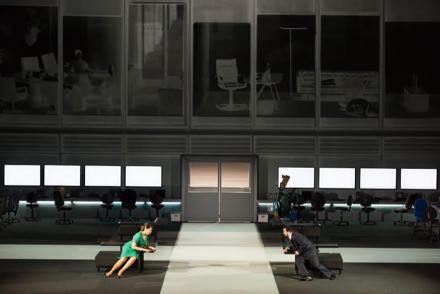
Lady Macbeth and Macbeth, above is negative projection of soon-to-be-murdered Duncan's rooms
Stage director Ivo van Hove defied Verdi’s wishes for a Lady Macbeth of ugly voice and overt madness by creating a full breasted, nurturing Lady Macbeth of powerful, even beautiful voice to match her fully confident if morally hesitant and certainly beautifully voiced husband. Mr. Van Hove further defied Verdi (and Shakespeare) by ultimately joining husband and wife into one tortured being, Macbeth shadowing and suffering with Lady Macbeth in her final moments of torture. His ultimate spousal compassion was his strangulation of Lady Macbeth.
This was not the blood and thunder Verdi of political action, it was a Verdi of bel canto, two tortured beings singing themselves into a complicity of mutual understanding that was to become their destruction. It was the stuff of high tragedy.
Conductor Daniele Rustioni found the precise balance between beautiful singing and stinging feeling countered from time to time with Verdi’s interwoven compassionate flute and oboe solos. Mo. Rustioni worked unrelentingly with Azerbaidjan baritone Elchin Azizov, a fine singer and a gifted actor, and Italian soprano Susanna Branchini, a physically and musically elegant singer to find and musically achieve this latent, and very real human tragedy.
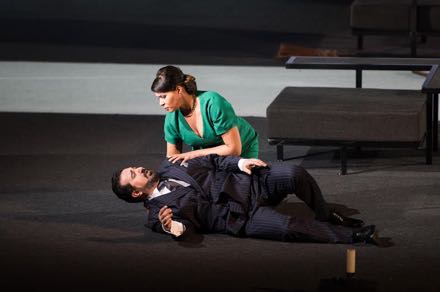
Macbeth and Lady Macbeth
Director van Hove wittily introduced a silent, observant black janitress who cleaned up the messes left on stage — the trader/witches’ printouts, Lady Macbeth’s bloody rags, the thrown chairs — and generally replaced the grim emotional residue with a stoic calm. She was a pointed, sarcastic comment on big money.
Director van Hove’s chorus scenes were masterfully configured, the chorus of female witches spread around the edges of the huge white box stage, its disembodied sound coming together in occasional center stage groupings. Of particular effect was the staging of the chorus of Scottish refuges, here something like later day East Coast flower children, who emerged in solo movements to animate individual suffering.
The opera’s triumphal chorus was a Occupy Wall Street camp bacchanal of live TV coverage including an gigantic cameo of beautifully sung lines by Macduff, Russian Arseny Yakovlev. There were splendid takes of cocky young Malcolm, the new king, sure to soon become, together with the balance of the Occupy Wall Street demonstrators, as greedy as Mr. and Mrs. Macbeth.
And such inevitable domestic tragedies to begin anew. Maybe Mr. Van Hove did not have this resolution in mind when he created this production in the aftermath of the 2008 financial markets crisis and the 2011 demonstrations. But his fine production has discovered unexpected new resonance.It was a splendid evening of beautifully produced opera.
Cast and Production
Macbeth: Elchin Azizov: Lady Macbeth: Susanna Branchini; Banco: Roberto Scandiuzzi; Macduff: Arseny Yakovlev; Médecin: Patrick Bolleire; Malcolm: Louis Zaitoun. Chorus and orchestra of the Opéra de Lyon. Conductor: Daniele Rustioni: Mise en scène: Ivo van Hove; Décors et lumières: Jan Versweyveld; Costumes: Wojciech Dziedzic; Vidéo: Tal Yarden. Opéra de Lyon, March 15, 2018.
Il barbiere di Siviglia in Marseille
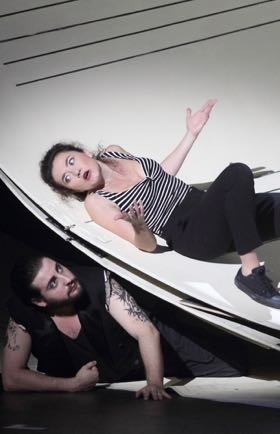
Florian Sempey as Figaro, Stephanie d'Oustrac as Rosina
All photos copyright Christian Dresse, courtesy of Opéra de Marseille
Any Laurent Pelly production is news, any role undertaken by soprano Stephanie d’Oustrac is news. Here’s the news from Marseille.
Rossini’s grand old (1816) comedy took the stage just now in Marseille’s fine, old (1787) opera house in the form of a Laurent Pelly production.
Pelly’s black and white production premiered this past December at Paris’ Théâtre des Champs Elysees. France’s most read newspaper Le Monde dubbed it a Barber in “demi-deuil” (half-mourning) and somehow dug up hints of tragedy in the storm — a bewildered Rosina rushed across a blank dark stage, dead leaves flying. Laurent Pelly’s conceit was in fact black ink on white paper, huge sheets of blank musical score paper on which Figaro tried to write out Lindoro’s “Se il mio nome bramate” (If you wish to know my name). In due time, however, for its moment “L’Inutile precauzione,” as backdrop, was fully notated (wittily it was not with the actual tune).
It was a complex conceit, the singers filling in, virtually, the notes missing on the scenery, or maybe the old warhorse having been performed so many times that Mr. Pelly found its story irrelevant — thus Il barbiere di Siviglia is only music, or maybe Mr. Pelly’s was saying that Il barbiere is music, though we already know this. Music was indeed a useless precaution in this scheme of things Barberiana.
Or something.
To be generous the five black lines of the musical staff did serve to imprison Rosina who appeared behind them when a square opened on a white page wall creating her balcony.
Mr. Pelly deployed his choruses and ensembles in geometric patterns, dissolving movement into abstracted, repeated motions (like music notation) reinforcing the music score conceit (the chorus mimed unison violins for Lindoro’s “Ecco ridente in cielo,” then stormed in as police brandishing folding metal music stands. These events were just the tip of the iceberg — there are lots of duets, trios, quartets and quintets, and one more chorus — gentlemen in regimented concert formation, sheets of music on their folding metal stands. It was a masterwork of stage choreography.
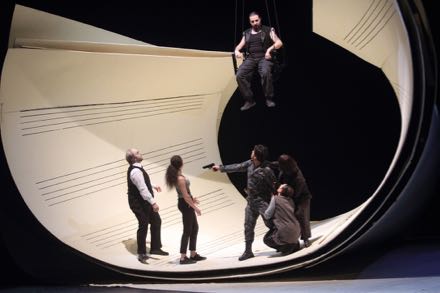
The drunken soldier, Figaro in swing
It was a long evening at the Marseille Opéra, a very long evening. [One of the most charming evenings I have ever passed in a theater was Laurent Pelly’s La Périchole (Stephanie d’Oustrac) at the Marseille Opéra back in 2002.]
Conductor Roberto Rizzi Brignoli was determined to make Rossini’s comic masterpiece into something it is not — Mozart, with touches of Cilea. The Barber’s overture was a caricature of this oft concert-performed masterpiece, this maestro insisting on determined, very determined tempos and very shaped phrases. The opening oboe solo was so extended that you could feel the player’s face turning red. Missing from the entire evening was the joy of music making, the joy of singing and the release of musical spirit when a vocal line explodes into fioratura.
The only carry over from the Paris cast was to have been the Figaro of Florian Sempey, but the diseases of the season claimed veteran baritone Carlos Chausson’s Bartolo at the very last minute, thus Spaniard Pablo Ruiz [the opera singer, not the pop singer of the same name] from the Paris cast jumped in.
It is surely possible to say that young baritone Florian Sempey will be (probably is) the reigning Figaro of our day. Less a look-alike of an imagined young Rossini now than in his Pesaro Figaro in 2015 he once again succeeded in bringing perfect Rossinian spirit to this comic hero. Mr. Sempey has facile, graceful movement on stage, and facile command of Rossini’s vocal requirements, singing in strongly focused, beautiful tone. Of infectious energy Mr. Sempey's Figaro in this production had no easily apparent context, thus there was no dramatic focus and this rendered his fine performance somewhat overbearing.
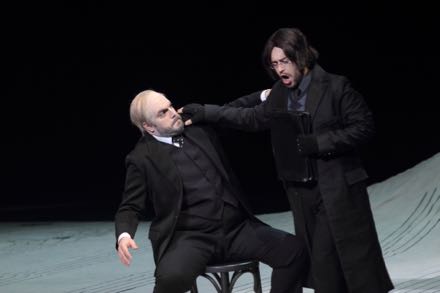
Bartolo and Basilio
There can be no argument that Stephanie d’Oustrac can create fascinating character, witness her recent successes as Carmen in wildly different productions. Certainly her Rosina in this production is a masterpiece of character — a sort of “valley girl” or whatever the French equivalent is. La d’Oustrac’s Rosina is more than anything else fun, and she is not a bit frightened by the prospect of marrying Bartolo. Her “una voce poco fa” was so inflected with personality that you forgot it was being sung. Although her performance was vocally secure and virtuoso indeed, I did miss a purely sung Rossini Rosina.
With the powerhouse conducting, the overwhelming staging conceit, and the surpassing performances of Mme. d’Oustrac and Mr. Sempey the balance of the cast struggled to make impression. Lindoro was ably if softly sung by French tenor Philippe Talbot, Spanish baritone Pablo Ruiz was an able, persuasive Bartolo, Young Italian bass Mirco Palazzi was Basilio, paired in appearance with Lindoro, a subtle casting touch. Annunziata Vestri was a lively, big voiced Berta and did make an impression. Fiorello was well presented by local Marseille singer Mikhaël Piccone.
Cast and production information:
Rosina: Stéphanie d’Oustrac; Berta: Annunziata Vestri; Comte Almaviva: Philippe Talbot; Figaro: Florian Sempey; Bartolo: Pablo Ruiz; Basilio: Mirco Palazzi; Fiorello: Mikhaël Piccone; Un Ufficiale: Michel Vaissiere; Ambroggio: Jean-Luc Epitalon. Orchestre et Chœur de l’Opéra de Marseille. Conductor: Roberto Rizzi Brignoli; Mise en scène, décors, costumes: Laurent Pelly; Lighting: Joël Adam. Opéra de Marseille, February 9, 2018
Die Walküre in Toulouse
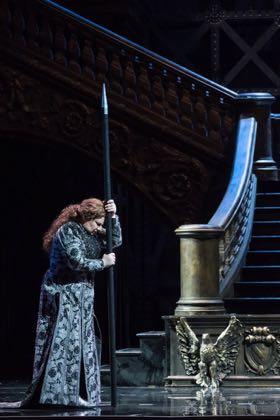
Anna Smirnova as Brünnhilde
This and following photo copyright David Herrero, third photo copyright Frederic Maligne
All photos courtesy of the Théâtre du Capitole
The Nicolas Joel 1999 production of Die Walküre seen just now in Toulouse well upholds the Airbus city’s fame as Bayreuth-su-Garonne (the river that passes through this quite beautiful, rich city).
The Joel production, here revived by stage director Sandra Pocceschi (a Castellucci assistant), approached masterpiece status, exploiting the intimacies and the unique acoustic of the Théâtre du Capitole, enjoying the splendors of its excellent orchestra, and profiting from an essentially perfect cast.
It is a rare pleasure to address an isolated Walküre in this recent (10 or so years) avalanche of entire Rings worldwide. Die Walküre is the one of the Ring’s operas that easily stands alone as a human document without need to be absorbed into larger 19th century philosophical concepts.
The Joel staging, in collaboration with Giorgio Strehler’s designers Ezio Frigerio (scenery) and Franca Squarciapino (costumes) eschews concept (no California gold rush for example), instead it explores a theatrical language (style) to expound the multiple crises of Wotan, the deeply human feelings of Brunnhilde, the forbidden love of Sieglinde and Siegmund, and the outrage of Fricka and Hunding.
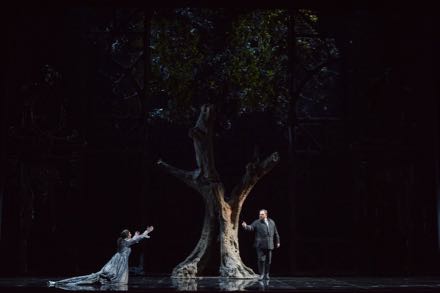
Sieglinde and Siegmund
The language is of the utmost simplicity. The set is a changing montage of ever present imperial architectural elements in front of a huge steel superstructure, though there is the sword-bearing abstracted tree trunk in the beginning. Costuming is in rich garments of basically medieval cut in grays and blacks and pastel hues.
Wagner imagined his music drama with its orchestra as the primary voice. The Théâtre du Capitole’s pit is very present, both visually and acoustically, its forte’s and then triple forte’s roar without impeding clear projection of voice from the stage. The intimate comments of Wagner’s much used bass clarinet, oboe and bassoon are no less present in their isolated purity.
Wagner’s poem flowed from the stage, its words never obfuscated, only enriched by orchestral colors. Wagner’s actors were sculpturally placed for their extended monologues, their extended stylized postures (a head hung for example) illustrated the emotions flowing from the orchestra. Gestures were broad, and when they occurred they were quite pointed — like the gazes of recognition between Siegmund and Sieglinde, or Wotan’s slapping of balustrades in his frustration or anger.
The dancing of the flames that surrounded Brünnhilde then burst (one giant flash of real flame, then smoke and lights) into a magnificent force of conflagration that the father Wotan knew would protect his daughter. The Joel staging defined pure music drama, as the Théâtre du Capitole’s orchestra traced the evolution of emotions of human love that made this nearly 6 hour Die Walküre finally into a uniquely enjoyable Wagnerian experience.
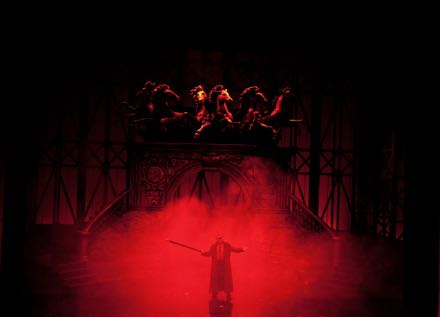
Wotan
And we leave the story at that.
Russian mezzo soprano Anna Smirnova made her dramatic soprano debut as this Brünnhilde. Her voice is of extraordinary power, and of a richness that amplified the surpassing humanity of Wotan’s favorite daughter. The youth of her voice was perfect for the innocence of the Walküre Brünnhilde (she is 35 years old), and her voice retained its youthful bloom to the last, intense moments of her final encounter with her father. Note that as a mezzo she will sing Eboli in L.A. Opera’s upcoming Don Carlo.
Polish bass-baritone Tomasz Konieczny brought unusually sharp vocal edge to Wotan, a god in utmost agony — he dictated the death of his son, and faced the rebellion of his most loved daughter. Konieczny was an actor in Poland before he became a singer. His Wotan was of intense concentration, his troubled postures added force to his defeat by his wife Fricka, his berating of the Valkyries was wearied and sharply apprehensive. Note that he sings Wotan in the Vienna State Opera’s upcoming Ring.
Strauss specialist, 50 years-old German soprano Daniela Sindram made her role debut as Sieglinde. She possesses a purity of voice that added pathos to her adultery and incest and her impending maternity, and impeccable technique that revealed the anguish of her attachment to her brother and lover. Likewise in his role debut as Siegmund, German tenor Michael König exposed a purity of youthful helden tenor sound that made his remembrances of his earthly father vivid, and made his declaration to Brünnhilde of his love for Sieglinde persuasive.
Russian bass Dimitry Ivashchenko was a menacing, beautifully sung Hunding. German mezzo Elena Zhidkova made Fricka appropriately shrill and rigid. The Valkyries were a noisy lot, wandering around a Valhalla courtyard amidst the piles of fallen heroes in bloody underclothes that they unceremoniously (bizarrely) dragged around like dead meat.
This Die Walküre began and ended in the pit. German conductor Claus Peter Flor, long associated with Toulouse, oversaw this Wagnerian masterpiece with musical clarity and Wagnerian insight, magnifying its humanity in his precisely dramatic reading of the score. The Théâtre du Capitole orchestra responded with utmost concentration, swelling to magnificent climaxes, joyfully popping the flames in its overture and again at its finale.
Cast and production information:
Brünnhilde; Anna Smirnova; Siegmund: Michael König; Wotan: Tomasz Konieczny; Sieglinde: Daniela Sindram; Fricka: Elena Zhidkova; Hunding: Dimitry Ivashchenko; Gerhilde: Marie-Laure Garnier; Ortlinde: Oksana Sekerina; Waltraute: Pilar Vázquez; Schwertleite: Daryl Freedman; Helmwige: Sonja Mühleck: Siegrune: Szilvia Vörös; Grimgerde: Karin Lovelius; Rossweisse: Ekaterina Egorova. Orchestra of the Théâtre du Capitole. Conductor: Claus Peter Flor; Mise en scène: Nicolas Joel mise en scène (by Sandra Pocceschi); Scenery: Ezio Frigerio; Costumes: Franca Squarciapino; Lighting: Vinicio Cheli. Théâtre du Capitole, Toulouse, France, February 6, 2018).
Guillaume Tell in Palermo
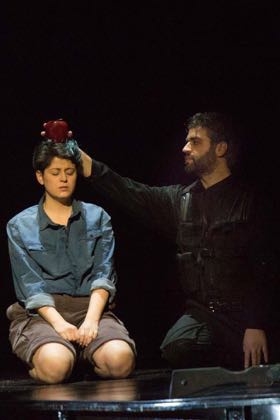
Anna Maria Sarra as Jemmy, Matteo Mezzaro as Rodolphe
This and next photo copyright Rosellina Garbo, third photo copyright Franco Lannini,
all photos courtesy of Teatro Massimo
This was the infamous production that was booed to extinction at Covent Garden. Palermo’s Teatro Massimo now owns the production.
The Palermitani, evidently less offended by abject sexual violence, tolerated the production’s humiliation and rape of a young woman without remark (having tacitly accepted as well Hunding’s gang rape of Sieglinde in last year’s Ring). Not that Damiano Micheletto’s William Tell production was not resolutely booed at this opening night of the Teatro Massimo’s one-hundred-twenty-first season. It was indeed.
It was a relaxed, festive evening at the Teatro Massimo, a red carpet runner ushering the very well-dressed audience past two magnificently uniformed guards at the entrance, shining swords at their sides. Never mind the heavy police presence in the piazza in anticipation of a demonstration (unrealized) against such extravagance.
At the hour the performance was to begin an announcement was made delaying the beginning by one-half hour due to a strike of some sort. No one minded as it was a very social evening, the animated conversations would have been hard to interrupt anyway.
Guillaume Tell, Rossini’s French style grand opera can be a very long evening (five hours plus in a recent Rossini Opera Festival production). In Palermo just now it was reduced to a bit over four hours, the act one marriage ballets were sacrificed, plus other less prominent sections.
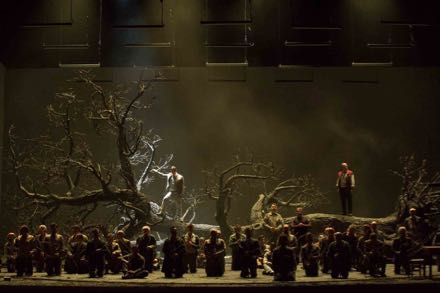
Dmitry Korchak as Arnold (in white light), Roberto Frontali as William Tell (in red vest)
The Michieletto production reduced Rossini’s spectacle to bare bones — an illustrated comic book story (projected from time to time) was its cornice from which a surrogate William Tell emerged to cement William Tell’s patriotic resolve at crucial moments. Rossini’s quite specifically human, and complicated storytelling was transformed in Palermo into a ceremonial hymn to liberty, told in three bold strokes, Gesler’s thugs tore out the tree of peasant life (Gesler is the tyrant villain). The tree lay dead on the stage until William Tell eradicated Gesler. A new tree was planted as the Swiss peasants celebrated their emancipation from tyranny.
The effect of the production, and it was considerable, was exponentially increased by the expansive conducting of Teatro Massimo’s music director Gabriele Ferro. His tempos were indeed deliberate, elaborating the ceremonial tone of the production, the flights of lyricism were reduced to the beautiful sounds of the overture’s flute solo and to the splendidly voiced fisherman’s song that opens the first act.
After this it was all business. The chorus of Swiss peasants was grimly seated at regimented tables to grimly celebrate love, marriage and the harvest. William Tell got right to work liberating them through his heroic resolve, abetted by the heroic courage of his son Jemmy and the stoicism of his wife Hedwige. The murdered Melcthal’s son Arnold came to his senses and swore to avenge his father (though William Tell actually did all the work), not without the help of the Hapsburg princess Mathilda whom he loved.
Done.
The chorus and the principals then let Rossini’s final hymn to liberty soar, and it was spine tingling. The gigantic dead tree magically lifted (grand opera is famous for spectacular scenic effects, and this was just that) to allow a young boy to pass under with a sapling that he planted down stage center.
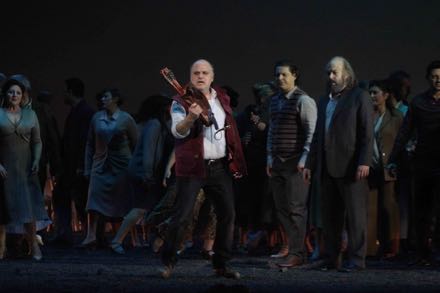
Roberto Frontali as William Tell
The Micheletto production was given vibrant life by an excellent cast whose voices and personae seconded its conceptual intentions. Baritone Roberto Frontali (San Francisco Opera’s recent Scarpia and L.A. Opera’s recent Falstaff) brought sharp edge to William Tell, no longer Rossini’s father figure he was far more a warrior. Soprano Anna Maria Sarra as William Tell’s son Jemmy was not diminutive, rather she was full-sized both vocally and morally, a warrior who mimed a child's movement.
Arnold, rendered impotent by love was sung by Russian tenor Dmitry Korchak in fine French and fine Rossini style. He was in love with Mathilde, the Hapsburg princess sung by Tbilisi (Georgia) born Nino Machaidze, a soprano of ample voice and great charm who negotiated her bit of fioritura with ease and to good effect.
William Tell’s stolid friend Walter Furst, sung by bass Marco Spotti, remained in the shadows, helping when called upon. Albanian mezzo Enkelejda Shkoza made Tell’s wife Hedwige a strong, purposeful presence supporting her husband and son, and a strong, purposeful voice in the upper registers of Rossini’s large ensembles, in Palermo executed with requisite magnificence.
The villain Gesler was delivered in high caricature by bass Luca Tittoto, underscoring the Italianate nature of this French evening (after all we were in Palermo!). Tenor Matteo Mezzaro, Gesler’s lieutenant Rodolphe, managed infectious charm in his nefarious duties.
The splendid first act’s fisherman’s song was sung by Sicilian tenor Enea Scala for the opening night performance only. He will sing Arnold in the final two of this eight performance run — the dynamic will be greatly changed. As the fisherman he and Enkelejda Shkoza were the only carryovers from the Covent Garden cast.
The orchestra and chorus of the Teatro Massimo seccured the solid artistic level of the evening, proving again that this Palermo theater is among the finest in Italy.
strong>Cast and Production
Guillaume Tell: Roberto Frontali; Arnold: Dmitry Korchak; Walter Furst: Marco Spotti; Melcthal: Emanuele Cordaro; Jemmy: Anna Maria Sarra; Gesler: Luca Tittoto; Rodolphe: Matteo Mezzaro; Ruodi: Enea Scala; Leuthold: Paolo Orecchia; Mathilde: Nino Machaidze; Hedwige: Enkelejda Shkoza; Un chasseur: Cosimo Diano. Chorus and Orchestra of the Teatro Massimo. Conductor: Gabriele Ferro; Metteur en scène: Damiano Michieletto; Scene designer: Paolo Fantin; Costumes: Carla Teti; Lighting: Alessandro Carletti. Teatro Massimo, Palermo, January 23, 2018.
I masnadieri in Rome
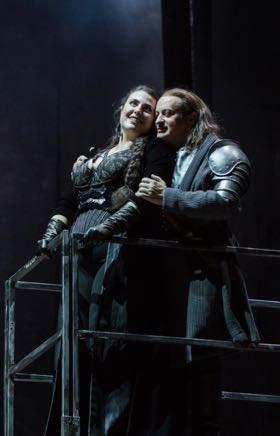
Roberta Mantegna as Amalia, Carlo Secco as Carlo
All photos copyright Yasuko Kageyama courtesy of Teatro dell'Opera di Roma
AKA I masnadieri, rare early Verdi, though not as rare as Alzira. In 1847 London’s Her Majesty’s Theatre commissioned the newly famous Verdi to write this opera for the London debut of Swedish soprano Jenny Lind.
And to this day “Tu del mio Carlo al seno” and its cabaletta remain a showpiece for sopranos, not to mention the “Parea mi che sorto da lauto convito” that is a blockbuster showpiece for baritones. There is even a greater amount of splendid music for tenor, starting with the opera’s initial scene “O mio castel paterno” that creates the situation that will result in the brutal murder of the soprano.
Just now in Rome the tenor Carlo, yearning for his childhood home, was sequestered up on some sort of rolling scaffold on the side of the stage for this first scene (and most of the opera), but upon learning that his father has disinherited him he vowed to remain in a band of robbers who plunder the countryside (and in this production brutally rape women). The robbers rose magically on one of Teatro Costanzi’s famous full stage elevators and he agreed to become their leader.
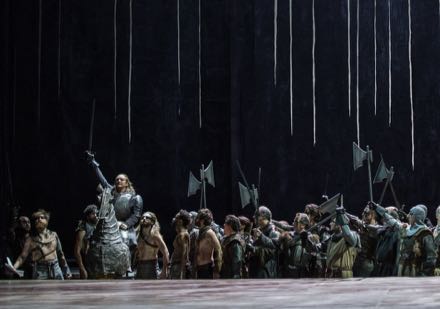
Carlo (Stefano Secco) becoming leader of Verdi's bandits
Meanwhile we learn that the baritone had deceived the tenor. The tenor had not been disinherited after all, he could in fact have renounced his dissolute life and returned home. The problem now becomes the tenor’s sworn loyalty to his band of robbers, not to mention that the soprano from his former upright life loves him. Unfortunately the conniving baritone wants to marry her. So there was a lot to sing about.
The metteur en scène of this new production was popular 57 year-old Italian actor and voiceover artist (for dubbing films) Massimo Popolizio. Mr. Popolizio made his directorial debut only last year with Author Miller’s 1968 play The Price. Mr. Popolizio is said to have based his staging of The Bandits on the popular U.S. TV series Game of Thrones. Maybe this explains the several scenes of gratuitous gang rape. Unlike the well developed threads of Game of Thrones, Mr. Popolizio left Verdi’s admittedly worst libretto without a discernible story line. We will never know from Mr. Popolizio why Carlo (the tenor) murdered Amalia (the soprano) just after their ardent declaration of love.
It was an an evening about singing, not about theater. After overcoming quite deserved opening night nerves the mostly Italian cast sang stylishly. Unfortunately tenor Stefano Secco (San Francisco’s 2014 Pinkerton) as Schiller’s questionable hero Carlo did not deliver the opening scene with sufficient pizazz to impress the audience which, despite his intense and eloquent (though small scale) delivery of the third act, awarded him vociferous boos at the final bows.
Twenty-nine year old ingenue diva Roberta Mantegna, a recent graduate of Rome Opera’s new young artist program, negotiated Amalia’s treacherous outpourings with knowing aplomb, belying the fact that this was her debut in a major role on a major stage. Additional maturity of voice will add effect to her Amalia.
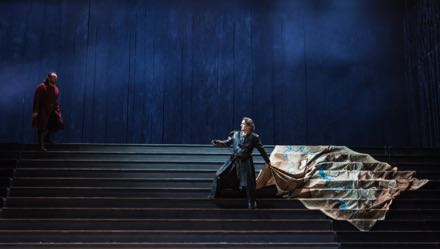
Francesco (Artur Ruciński) beginning “Parea mi che sorto da lauto convito”
Polish baritone Artur Ruciński, San Francisco Opera’s recent Germont, gave an impressive account of the repentant Francesco’s big scene, his fine diction finding its intimacy rather than its bravura. The role of Massimiliano, Carlo and Francesco’s feeble father, was competently delivered by ubiquitous bass Ricardo Zanellato.
Conductor Roberto Abbado exhibited little affection for early Verdi, and had no patience for attempting ensemble in the extended scenes with the male chorus.
Cast and production
Massimiliano: Riccardo Zanellato; Carlo: Stefano Secco; Francesco: Artur Ruciński; Amalia: Roberta Mantegna; Arminio: Saverio Fiore; Moser: Dario Russo; Rolla: Pietro Picone. Orchestra and Chorus of the Teatro dell’opera di Roma. Conductor: Roberto Abbado; Metteur en scène: Maurizio Popolizio; Set designer: Sergio Tramonti; Costumres: Silvia Aymonino; Lighting: Robert Venturi. Video: Luca Brinchi and Daniele Spanò. Teatro Costanzi. Rome, January 21, 2018
Le Cercle de Craie in Lyon
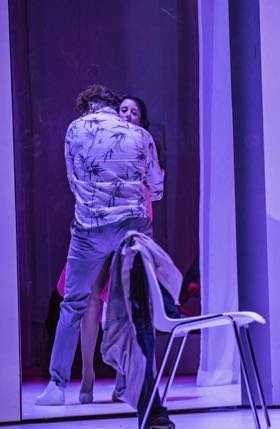
Prince Pao and Haitang falling in love
All photos copyright Jean Louis Fernandez courtesy of the Opéra de Lyon
Not the 14th century Chinese play nor its 1832 French translation, but a 1931 operatic re-creation by Alexander Zemlinsky of a 1925 German translation by “Klabund,” staged just now in Lyon by French stage director Richard Brunel.
Der Kreiderkreis or The Chalk Circle or Le Circle de Craie in French (1931) is the seventh of Zemlinsky’s eight operas (A Florentine Tragedy [1916] is the fifth, The Dwarf [1921] is the sixth, the unfinished Le Roi Candaule is the eighth). This Lyon production is the French premiere of The Chalk Circle.
Zemlinski’s The Chalk Circle is realized in masterful musical strokes, the late Romanticism and its destruction that surrounded Zemlinsky is fully assimilated into a finished style that floats faultlessly from the grotesque to the sublime, through cruelty and hopelessness to generosity and redemption. The.exotic tones of the ancient Orient and the new American world plus extended tracts in the actual spoken language finished the sophisticated soundscape of this tumultuous German political era. It was a unique music that mesmerized the opening night audience.
Director Richard Brunel found this sound world in ephemeral white images that merely suggested architecture. He dressed his actors in colors and periods that spoke to and of the wealth, power and corruption of the early twentieth century and to our current moment and to these early moments of the Chinese twenty-first century as well. He dissolved morality play abstractions into very specific and intense human scenes incorporating a large number of silent actors and even a live horse. The horse was white of course, and as the white snowflakes of the full stage snowstorm it too purified the heroine Haitang in her impossible plight.
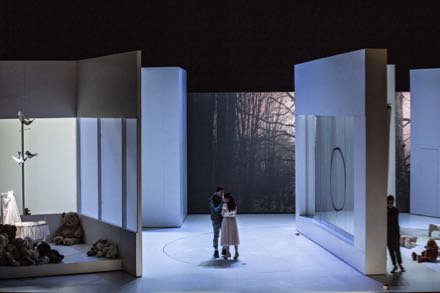
Ma’s number one wife Yu-Pei overhears Haitong’s reunion with her brother Ling,
and hatches her plot to frame Haitang for infidelity.
The story is simple. A maiden sold into sex slavery is saved first by a villain she then purifies by giving him an heir. Accused of killing this husband by his number one wife she is again saved, now by the emperor of China himself who discerns her purity when she refuses to inflict violence on her child by wrenching it from a circle drawn by chalk. Among the splendidly staged scenes was her initial house of joy encounter with the young noble who later became emperor. It made startling effect indeed as circles of white light moved and bounced in pleasure and innocence.
Director Brunel knows however that such purity and innocence is doomed. He is not duped by the happy morality of the Chinese play. Brunel’s heroine we learn in the split second before final blackout has only imagined this happy ending. This extended delirious love duet with the emperor was but a flash in the moments before she is executed by the forces of an unjust world.
It was a production of purely human dimension executed in exquisite theatrical taste.
The cast, primarily Germanic language singers, was perfection, physically and vocally finding the depths of purity and depravity in the humanity of the characters of this ancient morality play. Conductor Lothar Koenigs created a vibrant presence for Zemlinsky’s score.
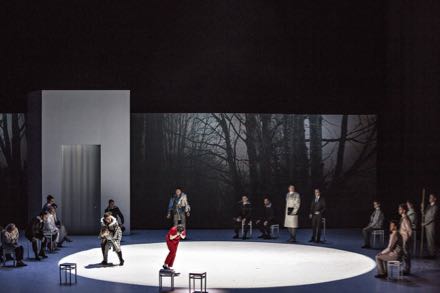
Haitang (in red) refuses to subject her child to the violence of a physical struggle.
The emperor in light tan coat looks on.
Soprano Ilse Eerens beautifully exploited every nuance of emotion felt by Haitang, convincingly traversing Zemlinsky’s quick shifts through fear, resolve, tenderness and ecstasy. Her first love, Prince Pao, the young noble later emperor sung by Stephan Rügamer, was of stentorian tone, her brother Tschang-Ling, sung by baritone Lauri Vasar was, as Haitang, a voice of sweetness and human understanding. Haitang’s husband Ma, a tax collector, sung by bass Martin Winkler was rough and raspy. His divorce lawyer Tchao, sung by baritone Zachary Altman matched the menacing warmth of his lover mezzo soprano Nicola Beller Carbone who as Ma’s number one wife was the opera’s villain. As the judge, Tchou-Tchou, at the murder trail character tenor Stefan Kurt gave terrifying presence to the corruption of power as character singer Paul Kaufman created the shocking depravity of German cabaret as the Chinese house of joy.
The French production team was metteur en scène Richard Brunel; set designer Anouk Dell’Aiera; costumer Benjamin Moreau; lighting designer Christian Pinaud and video by Fabienne Gras.
Opéra Nouvel, Lyon, January 20, 2018